
Admin
-
Posts
7,477 -
Joined
-
Last visited
Content Type
Profiles
Forums
Events
Store
Gallery
Community Map
Posts posted by Admin
-
-
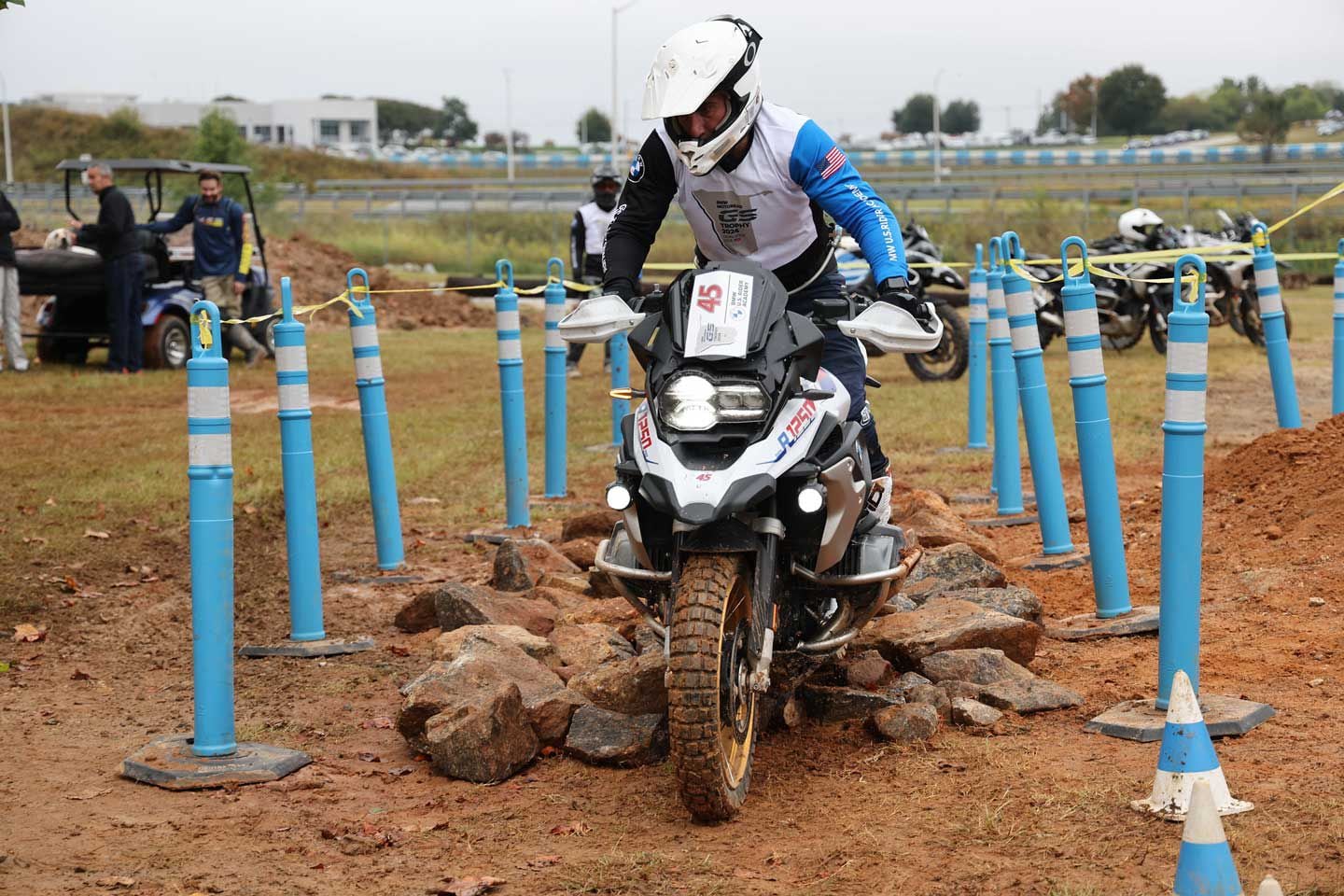
Daniel Heggarty navigates the rocky section of the “Australian Terror” at the US Qualifiers of the BMW International GS Trophy. (James Holbrook/)I’m sitting at the starting line of the Australian Terror, my final challenge in two days of competition. There’s about 6 feet between my front wheel and a wall-like hill of South Carolina mud. It’s maybe only 10 feet tall, but steep. I’m riding a BMW R 1250 GS, a high-priced touring bike that most people don’t dare ride on anything rougher than a gravel driveway. There are those who say a 550-pound motorcycle with 136 hp has no place off-road. My mud-covered knobby tires say otherwise.
The hill rears up like a tidal wave in front of me. At its summit, which is no broader than the wheelbase of the bike, the course makes a hard right down a rutted slope, and then turns 180 degrees left into a field of boulders, before finally exiting through a tight, slippery turn that’s been chewed up and spit out by 70 other competitors. “Put the rest of it out of your mind,” I tell myself. “Make it to the top first.” The judges give me the go-ahead. I bounce on the seat to quell the nervous tension and calm my beating heart. Everything goes silent. I get on the pegs, apply just a bit of throttle, and I’m airborne before I can take a breath. My front wheel lofts in the air: higher and higher, until the sky is obscured by the bike’s front end. Out of the corner of my eye I can read “Trophy” written in big letters down its front beak.
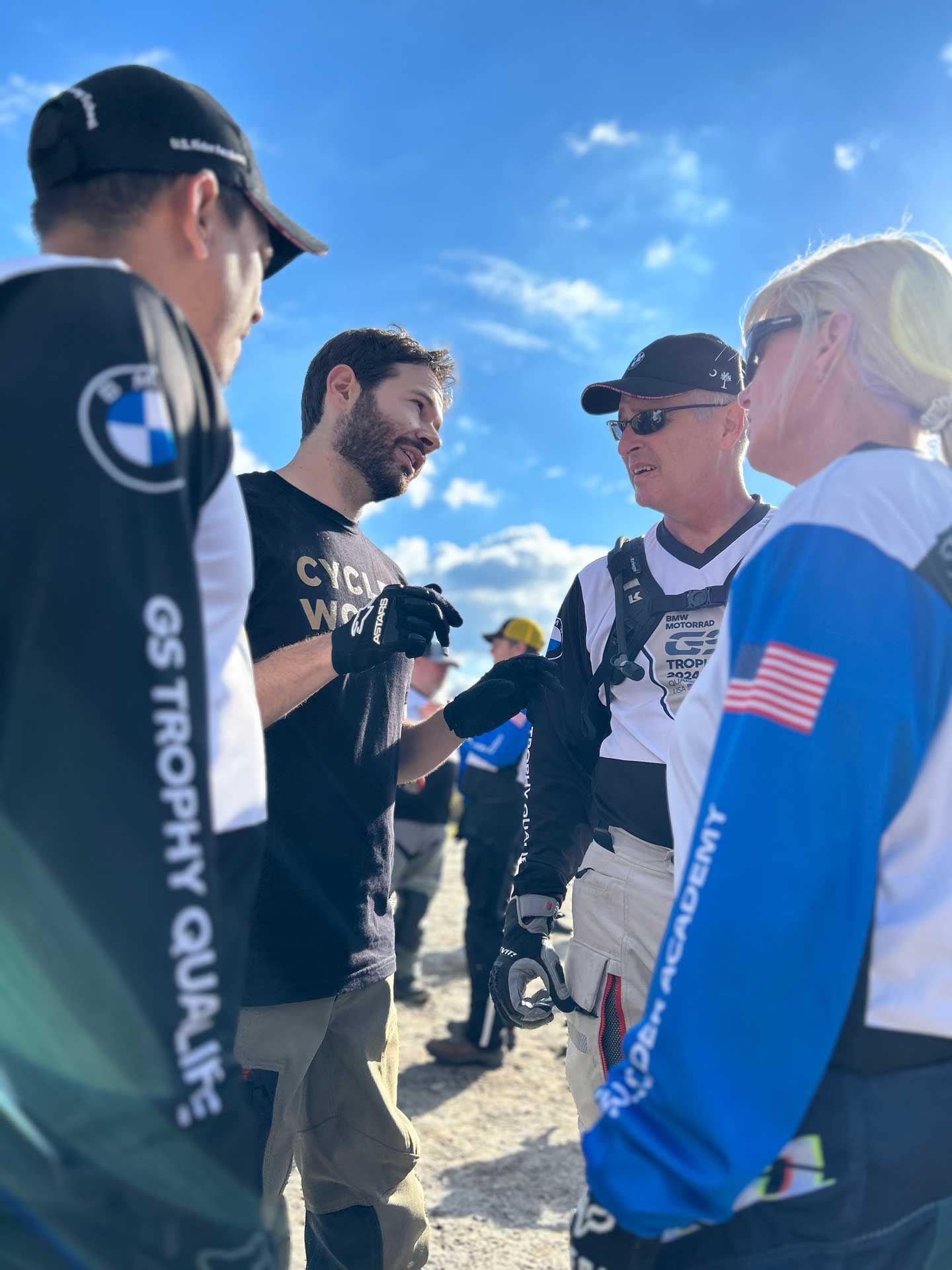
The author discusses strategy during a team exercise on the first day of competition. (BMW Mottorad USA/)Afterward, my teammate, Daniel Heggarty, grabbed me by my heavily padded shoulders. “Time stood still,” he said. “You got so much hang time, I had time to look at you, look at the judges, then back at our teammates, and your wheel was still in the air! So epic.”
Back down to earth, I breathed a sigh of relief. I just completed the final challenge of the BMW International GS Trophy Qualifying, my first-ever two-wheeled competition.
Seventy-two hours earlier, I rode the GS 775 miles in a single day from my home in upstate New York to the BMW Performance Center in Spartanburg, South Carolina, to join 59 men and 12 women competing for a chance to represent Team USA in the 2024 Trophy Final in Namibia. While the Trophy Final will receive all the publicity, tantalizing adventure-dreamers with images of wild places and wide-open spaces, the qualifying event is arguably the true heart of the GS Trophy.
To earn a place in the finals, “qualifying” is what three men and two women will ultimately do, but it’s not what the event is. To more fully express the nature of the thing, perhaps it should be called the Trophy Nationals. It’s not merely a gateway to something bigger; it’s a marquee event. It’s the event competitors circle on their calendars two years in advance. For months, the anticipation keeps them up at night. They bleed vacation days to train for it. They miss family weddings to make it. They risk damage to their bikes, to their egos, and to their bodies. They treat it like it’s, well, the Nationals.
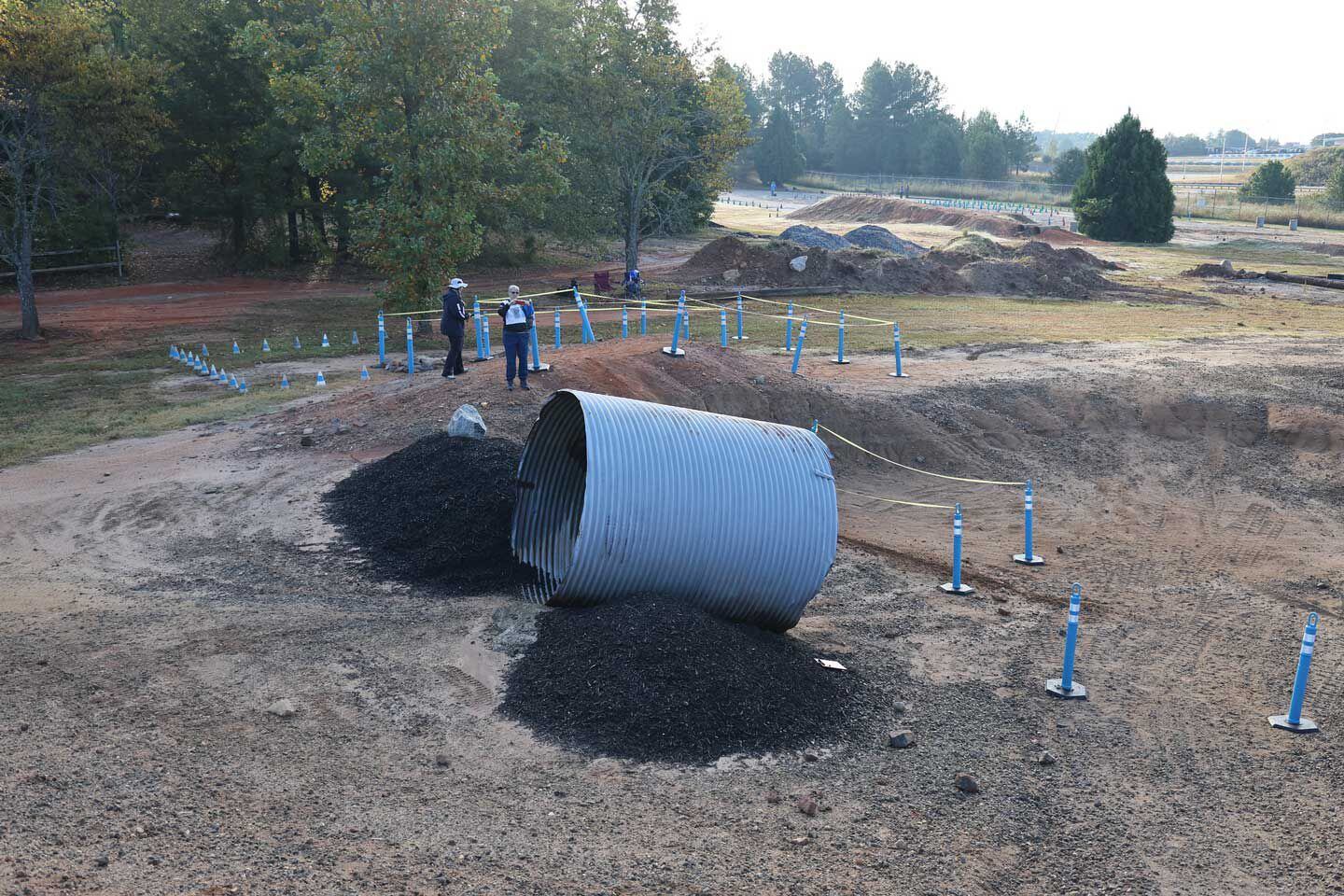
The BMW Performance Center hosted Qualifying. It’s a playground for adventure riders. (James Holbrook/)My own journey began two months ago, when I trained with Ben Phaup, the top finisher at the previous Qualifier. Two months wasn’t enough time to make me a contender for Team USA, but it was enough time to still be transformative.
When I arrived at check-in for the beginning of the competition, I was greeted by Heggarty, one of a dozen competitors who I’d met at the GS Trophy Prep course three weeks before. Quick-witted with a disarming smile and a class-clown attitude, he became a fast friend, so any jitters I had quickly vanished.
Soon, we met up with other prep course classmates: Melis Heerens, who works in industrial real estate investment in Hoboken, New Jersey, and his childhood best friend Ted DuPuis, an engineer at Garmin; Craig Johnson, owner of Wild Ass Seats; and Darren Wells, a retired motor officer, who I’d first met four years ago at a racetrack school at New Jersey Motorsports Park.
The Trophy Final is a team competition, so to encourage the team-player mindset, organizers divided the field into teams (we were still scored individually). To our surprise, Heggarty, Heerens, and I were put together, along with Chris Bronstorp, a brawny, steely-eyed Swede, who to everyone’s amusement was a doppelganger for BMW brand ambassador Shawn Thomas. We were Team Bravo.
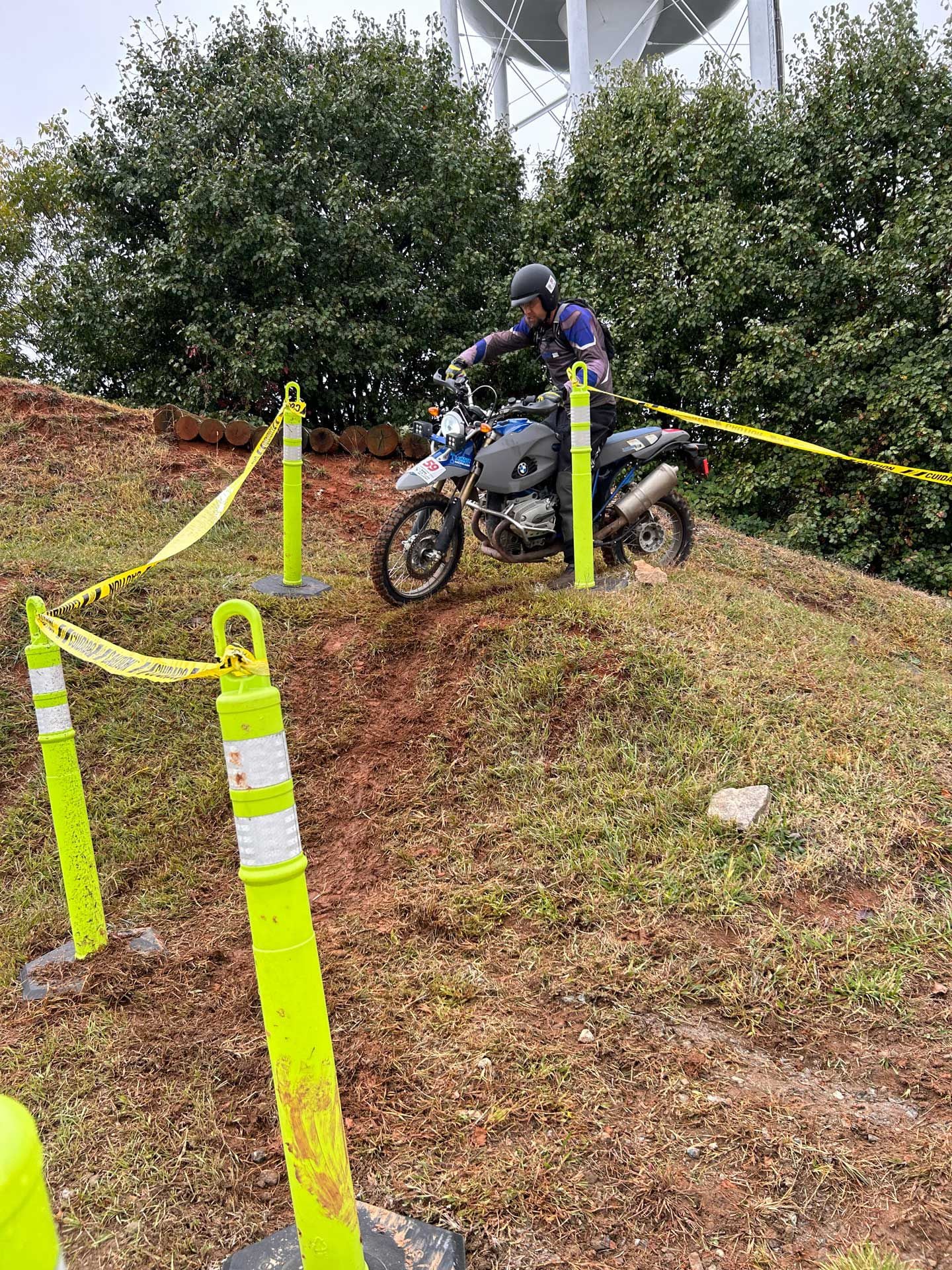
All BMW owners are eligible to compete on a GS of any engine capacity, excluding models older than the R 1100 GS. The current R 1250 GS was the most common model, but this competitor’s BMW HP2 Enduro stole the show. (James Holbrook/)Over the course of two days, we tackled 20 different courses set up throughout the BMW Performance Center property. From on-road cone courses to steep hills, log crossings, staircases, and sand pits, the challenges covered every kind of natural and man-made terrain. The Trophy’s spiritual roots may be in the rally world, but these days its wheels revolve around the slippery logs and rock gardens of a trials course. OK, the challenges aren’t exactly Hard Enduro-level, but the GS isn’t exactly a 230-pound 300cc two-stroke either.
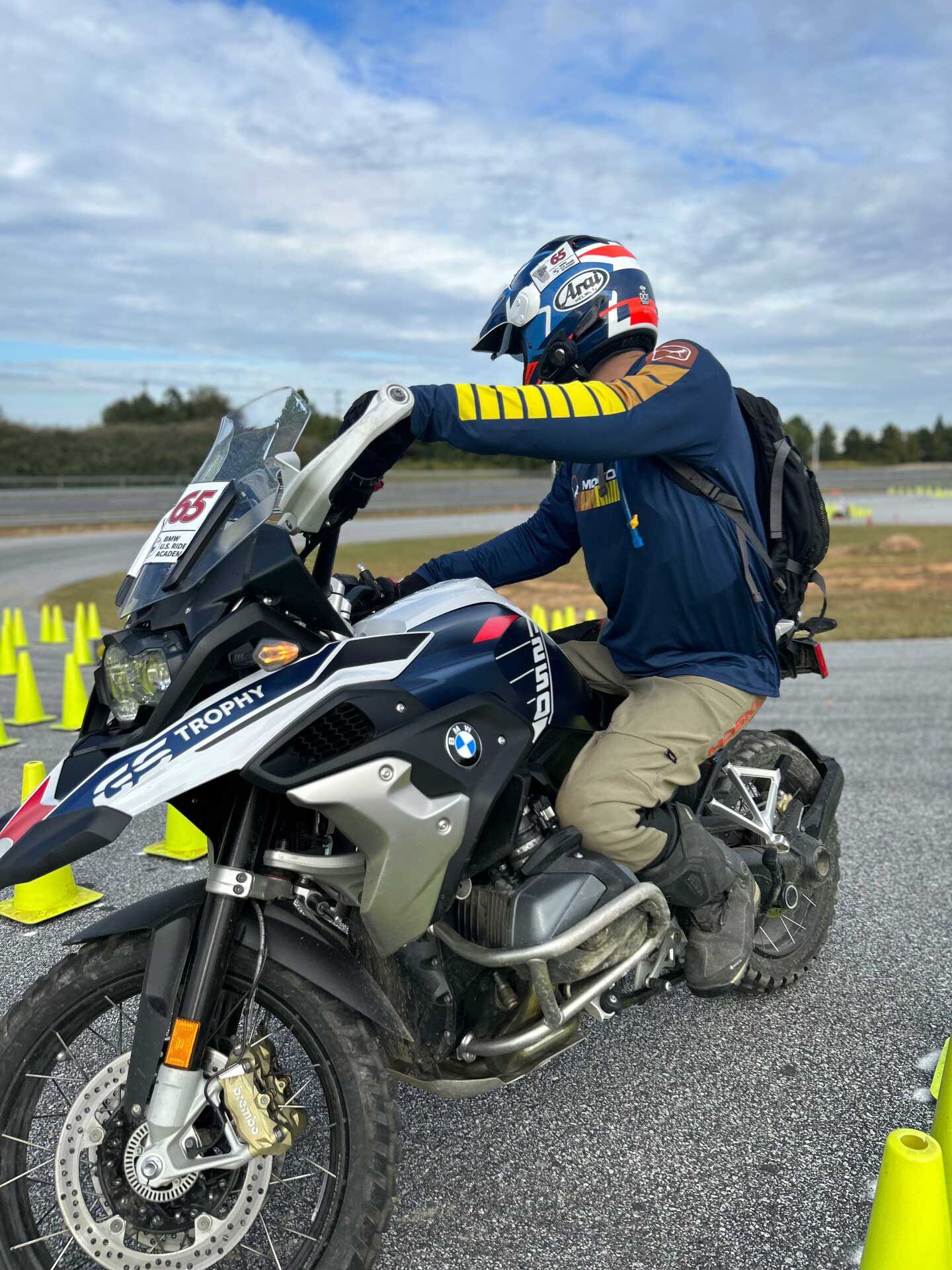
The author begins to round a corner in the “GS Garage,” which in this year’s Qualifying was on an off-cambered paved course. (BMW Motorrad USA/)To begin, my team headed to our first challenge, a police rodeo-style cone course.
“You start with 10 points, just like on every course,” the course judge told us. “You lose one point for dabbing, three points for hitting a cone, six for dropping the bike, and if you go off course, that’s an automatic disqualification.”
The three of us who attended the prep course faced similar challenges during our time and were brimming with confidence. Bronstorp looked at the course with a gaze that could intimidate a horde of charging vikings. We were going to crush this.
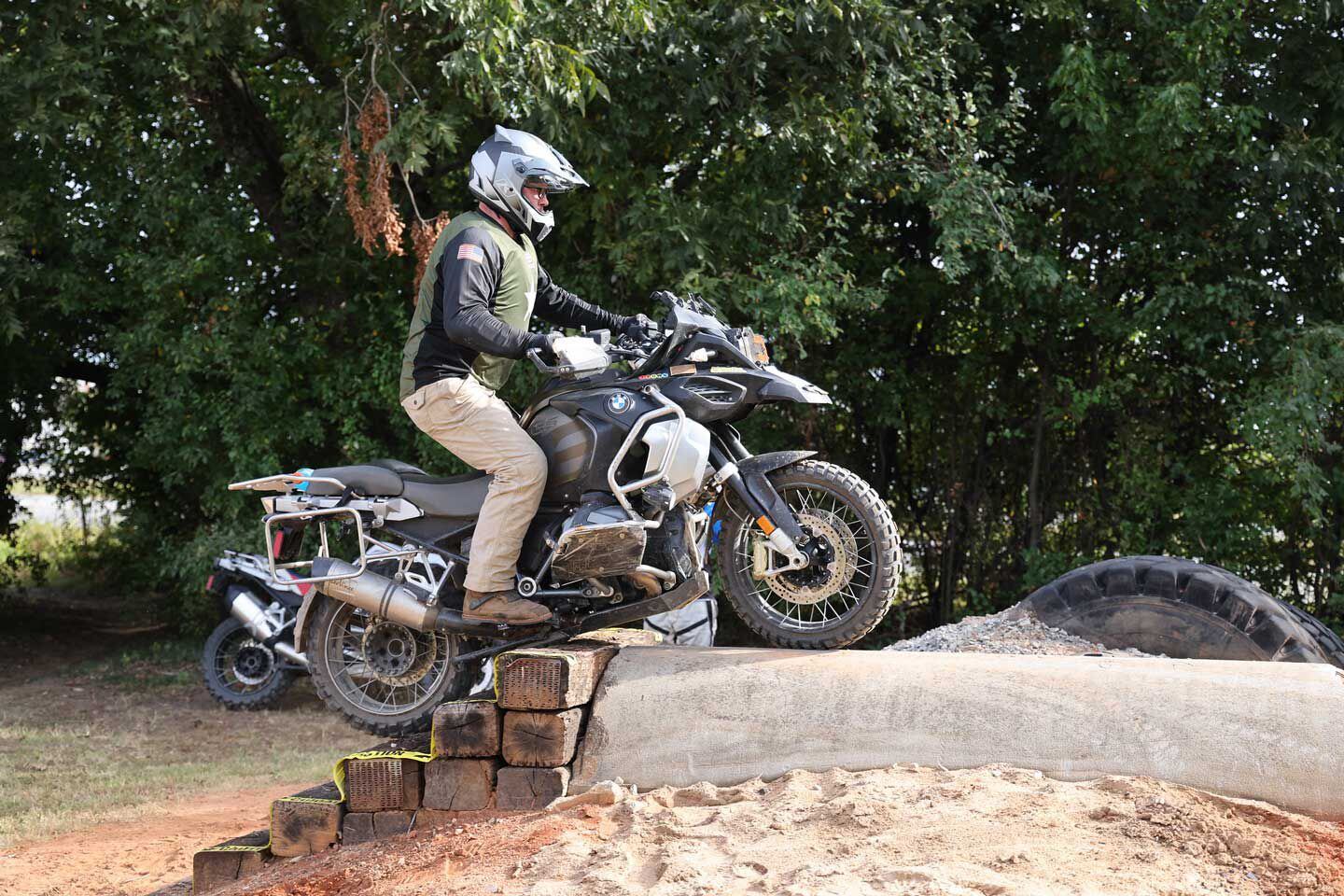
Jay Humphrey, another competitor who attended the final Trophy Prep course, rides up a flight of stairs and across a concrete culvert. (James Holbrook/)Instead, we all struggled. Above the sound of the GS’ engine, I could almost hear the scritch-scratch-scritch-scratch of the judge’s pen as it flew across his clipboard, swiftly docking me points for every error. It’d be a surprise if any of us finished with a single point.
“Just forget about it,” Bronstorp said to encourage us. “Full focus on the next challenge.”
“I took my mirrors off for a reason: I don’t look behind me,” Heggarty joked, bringing some levity to the situation.
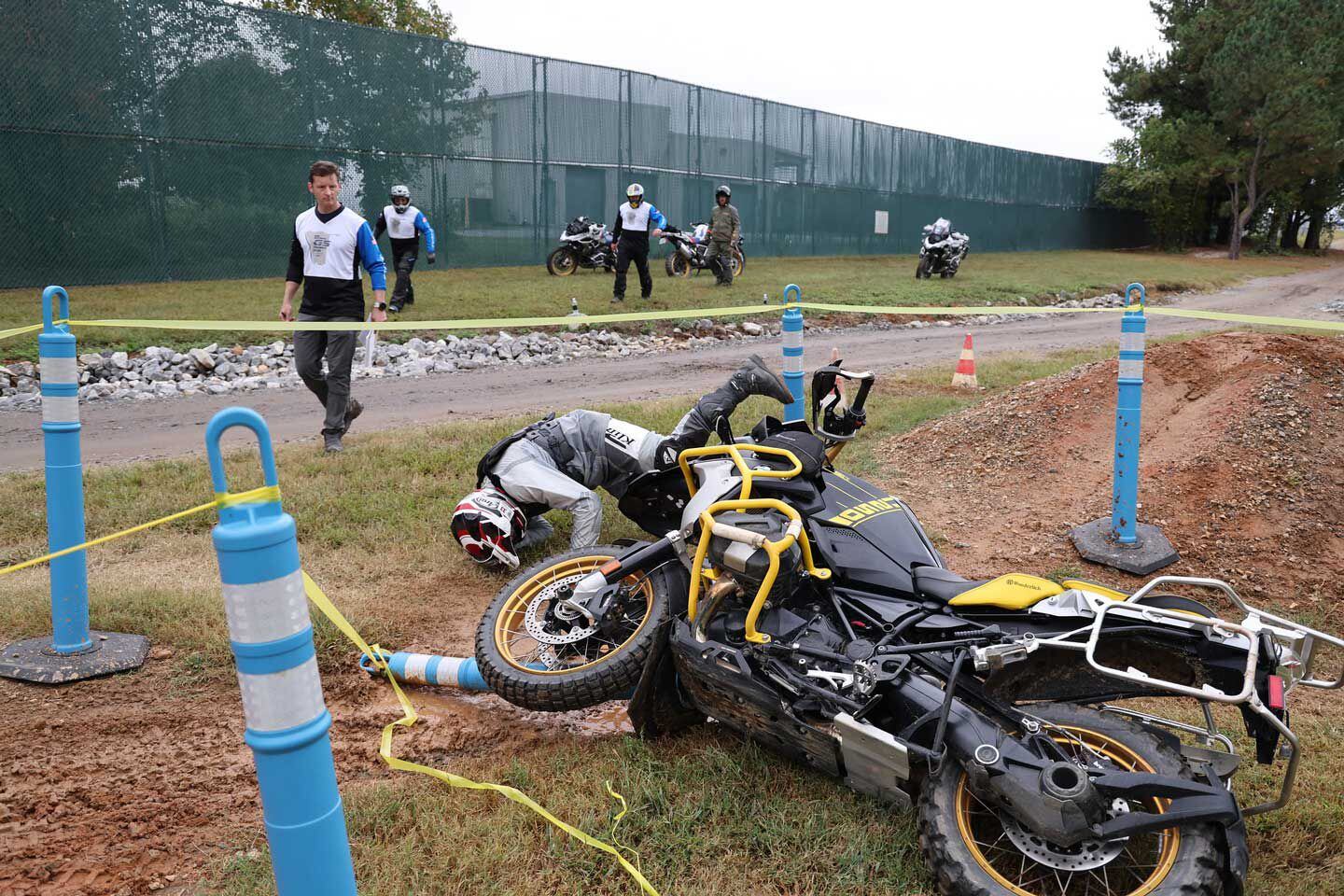
A dropped GS is a common sight at Qualifying. (James Holbrook/)On to the next challenges. At “Everest,” a steep hill climb starting in a field of scree, the competitor ahead of us was still stranded halfway up the hill when we got there, affording us a moment to catch our breath while the course judges extracted his bike. Then, at “Spider Mountain,” we heard the loud crack of a cylinder head cover puncturing on a rock, and the groans of the fallen rider tumbling down the hill in a stream of spilled oil.
The nature of the competition had revealed itself.
After completing nine or ten challenges, my team sat down for lunch at the event tent and caught up with a number of other competitors. We were all having an absolute blast, but none of us were doing as well as we’d hoped. One can practice a skill a thousand times but when you mess up during qualifying, that’s it. There are no second chances.
“It’s fun because it’s a mental challenge,” Heggarty said. “You don’t get to warm up in a lot of life. You kind of just have to go for it sometimes.”
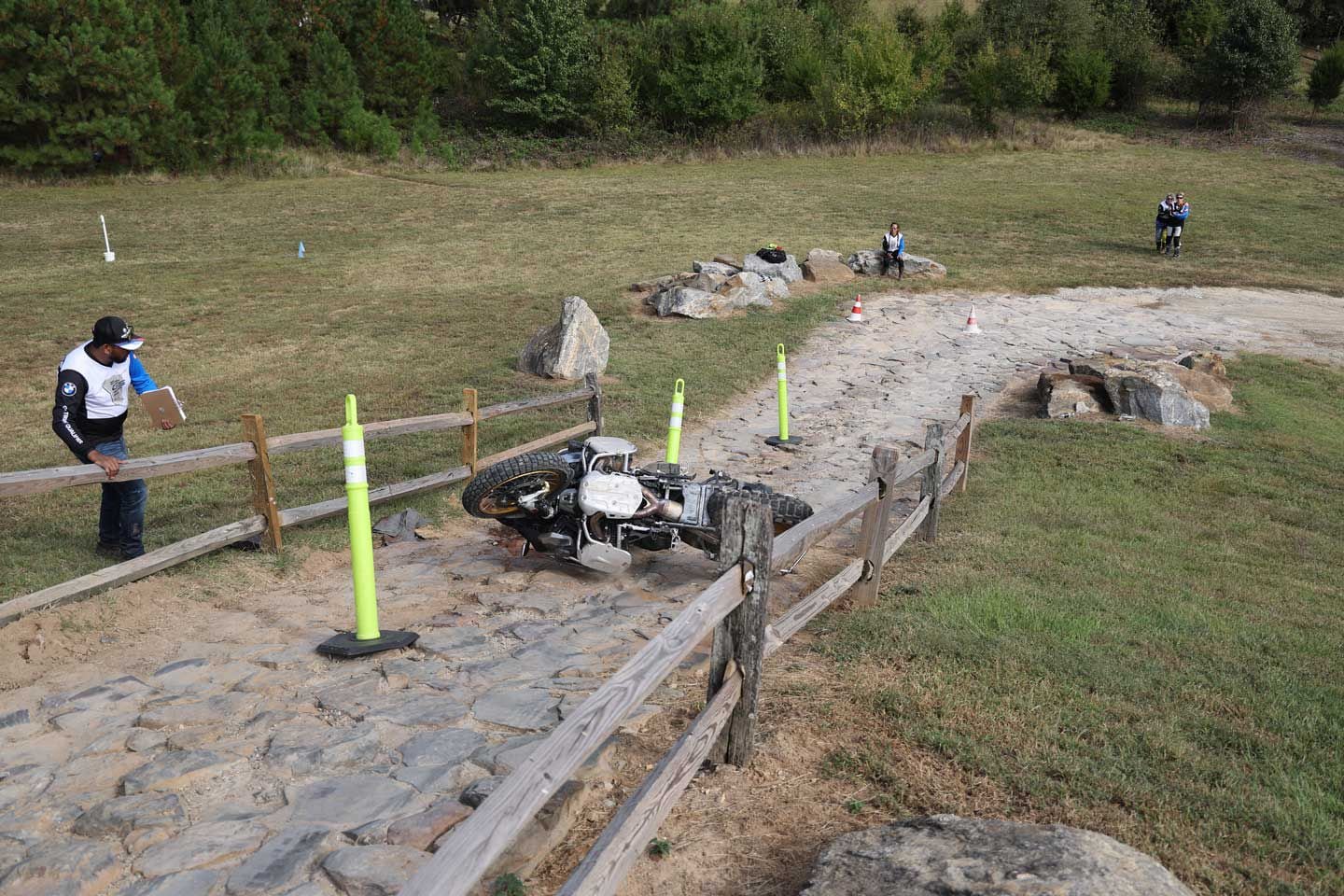
An inverted GS obscures its fallen rider. The hill is tricky enough to climb on its own, but when the objective is to weave between the cones on the way up, it gets especially difficult. Competitors nicknamed this challenge “Heartbreak Ridge.” (James Holbrook/)Melissa Ragsdale, a first-time competitor from Knoxville, Tennessee, added: “There’s a difference between being able to do something and mastering it. Mastering it means you can do it on demand. Being able to do it means maybe after 𝑥-number of times you get it once.”
“Things that seem like they’re easy to just do in your backyard, all of a sudden become that much harder,” said Ellen Gines, who operates Into the Horizon ADV Motorcycle Tours and Rentals with her husband, Lance, in Boise, Idaho. “For me, I practiced the GS Garage in my backyard with eight cones. And you come here and you go into the garage and there’s a whole line of cones with barriers between them. It’s not any different than what you practiced at home, but it looks different. And there’s a bunch of people watching you.”
Qualifying courses are designed to challenge even the best riders. They can threaten your self-belief. They can tear you down—even if you’ve worked hard on building your skills.
“We all have to work hard to get here,” Ragsdale said. “When I was here in June [for a Trophy Prep Course], I couldn’t do a 16-foot circle. That was June! It took me a month to figure that out on my own. No one was going to be able to teach me that. I had to go out into a field and throw the bike down, and throw the bike down, and throw the bike down, and watch the video of myself. I videotaped myself. I have a half a terabyte of video of myself.”
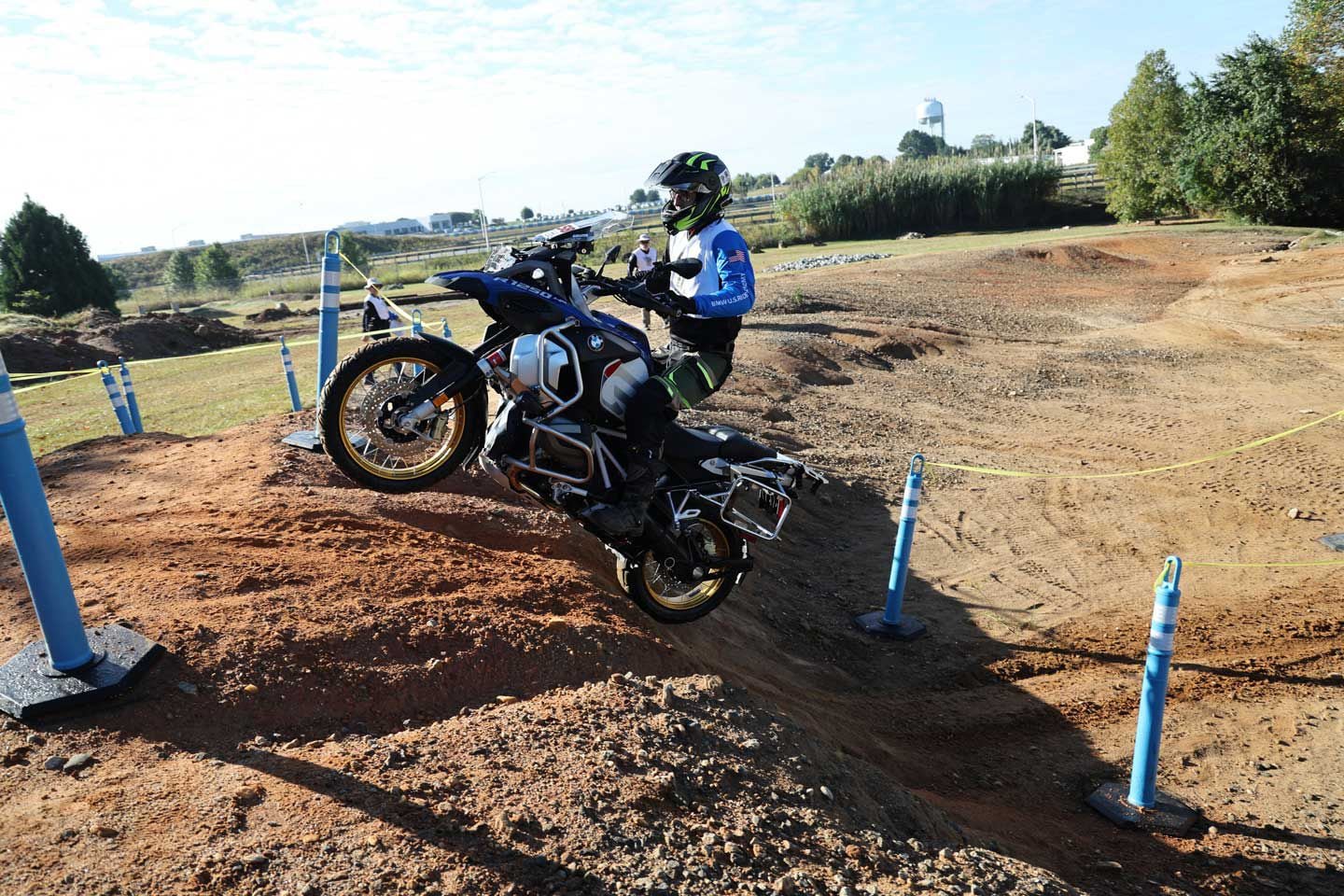
A competitor summiting the hill of the Australian Terror. (James Holbrook/)As we all grappled with our performances and commiserated over Gatorade and sandwiches, Dene Dawson, another first-time competitor, offered an observation: “I look at it like the Olympics,” he said. “You get to the finals of the 100-meter dash and you come in last, which means you’re still in the top 10 fastest people in the world.”
Dawson isn’t suggesting that competitors are elite athletes or the fastest riders in the country. His point is that out of thousands of GS owners, there were only 72 of them taking part in US Qualifying. From a numbers standpoint, it gives them a special distinction. Other than a couple outliers in their 20s, the average age of riders had to be around 50 years old, which makes Qualifying a pretty accurate representation of the GS demographic. While the GS Trophy may be a competition for the everyman, not everyone is willing to do it.
Competitors take a lot of pride in being willing to test the limits of their motorcycle’s capabilities. The GS is designed to be ridden off-road, but because it’s such a capable, versatile streetbike, most riders keep it on the pavement and never find out what they’re missing. In truth, you’ve got to be a bit mad to drop $25,000 on a motorcycle and then be willing to drop the thing off-road with regularity.
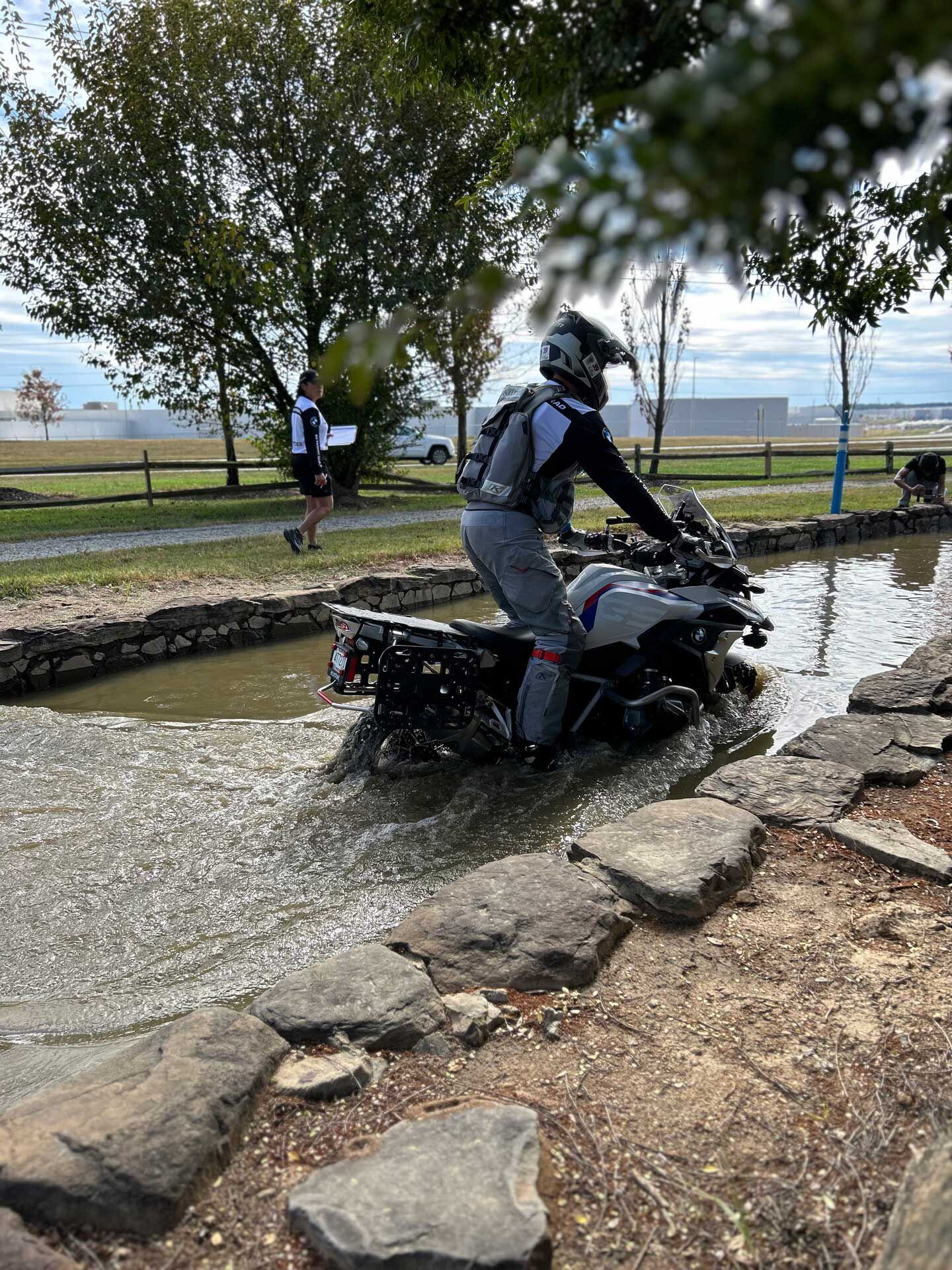
A competitor weaves between cones in the water. (James Holbrook/)Only two days earlier, I spent 15 hours in the saddle on my way down from New York—not something I would have wanted to do on a motorcycle that wasn’t such a well-appointed tourer. But all it took to transform the GS into a plus-sized dirt bike was to remove the mirrors and luggage, rotate the bars upward, and let some air out of the tires. That’s it. After riding it almost exclusively in dirt and gravel for the past months, I’d say not taking it off-road would feel like a waste.
As Heerens joked: “A ship in the bay is safe, but that’s not what it’s made for.”
“I don’t want to sound like a brochure,” Heggarty added, “but the GS spirit is when the bike goes from being a jewel to a tool. Dirt bike racers get a new bike every season because they use it as a tool to hone their skills. We’re all into the GS because it’s a tool for us. How far can I go with this? What can I do with this?”
The GS is transformed as the way it’s used is transformed. In the process, the rider goes through a similar metamorphosis. I’ve been riding motorcycles for 27 years. In all that time, I’ve done it solely for the love of it. When I began to train for Qualifying, my riding became colored by an objective and tinged with an air of urgency. When I swung my leg over the motorcycle, it wasn’t just for fun; I rode in search of my more skillful future self. The process of disciplined training—of struggle and self-doubt, of pushing through and overcoming—flipped a switch in my brain. It gave me ambition.
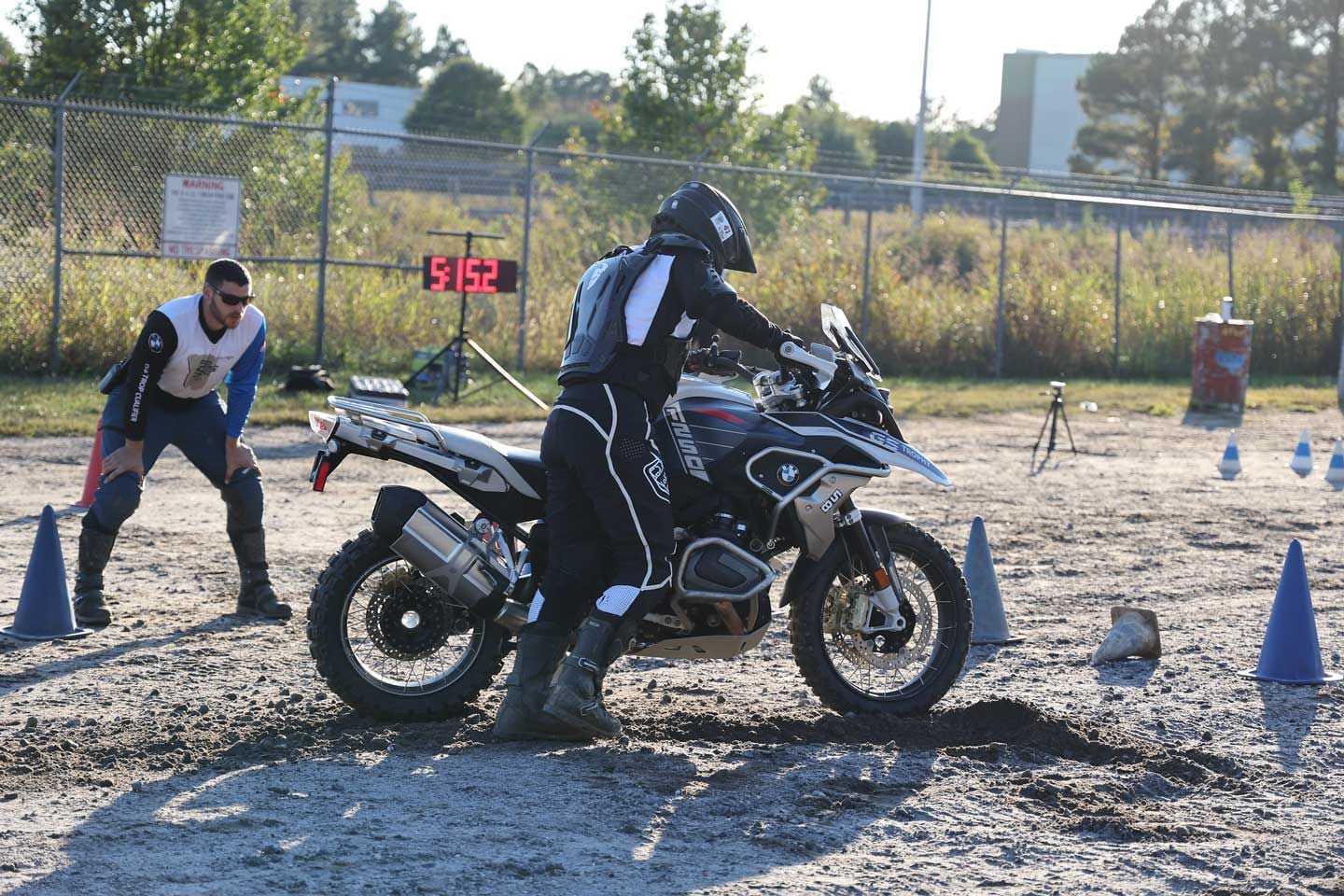
Even the very best riders struggled at Qualifying. Here, Kirk Graydon, the top-placed men’s finisher, struggles during the final. Graydon made the most challenging courses look easy, but even he didn’t get everything right all the time. There’s hope for all of us. Ben Phaup, the previous Qualifying’s winner, acts as a course judge. (James Holbrook/)“For me, it’s a confidence builder,” Gines said. “I’m not a superconfident person, but doing this, I’m like: ‘I can do this.’ We ride almost every weekend with a group of 12 to 20 guys, and 80 percent are on GSs. Not one of them is here. But I am. These guys are so good and I can hang with them. This is the thing that I found that challenges me and keeps me interested…and interesting. This bike outweighs me by 400-something pounds and people ask me ‘what happens when you drop it?’ I say, ‘I pick it up!’”
Gines’ soft-spoken personality belies her fierce determination. This was her third Qualifying. “Last time, I didn’t perform as well as I expected to,” she said. “I came in second in the West Coast qualifier, which wasn’t good enough to put me through to the finals. I focused so much on the negatives and it took me a couple months until I was like, ‘I was the second finalist on the West Coast!’ That’s huge. How many people even have the guts to come out and do this?”
If Cycle World Executive Editor Justin Dawes hadn’t signed me up for this, I would never even have considered doing it. I’m not competitive by nature. I’m preoccupied by my young family. Training for and competing in Qualifying doesn’t fit in with the rest of my life. But Qualifying is so much more than a competition. As I discovered, the very reasons preventing me from doing it were the very reasons I had to do it. I wasn’t alone in that.
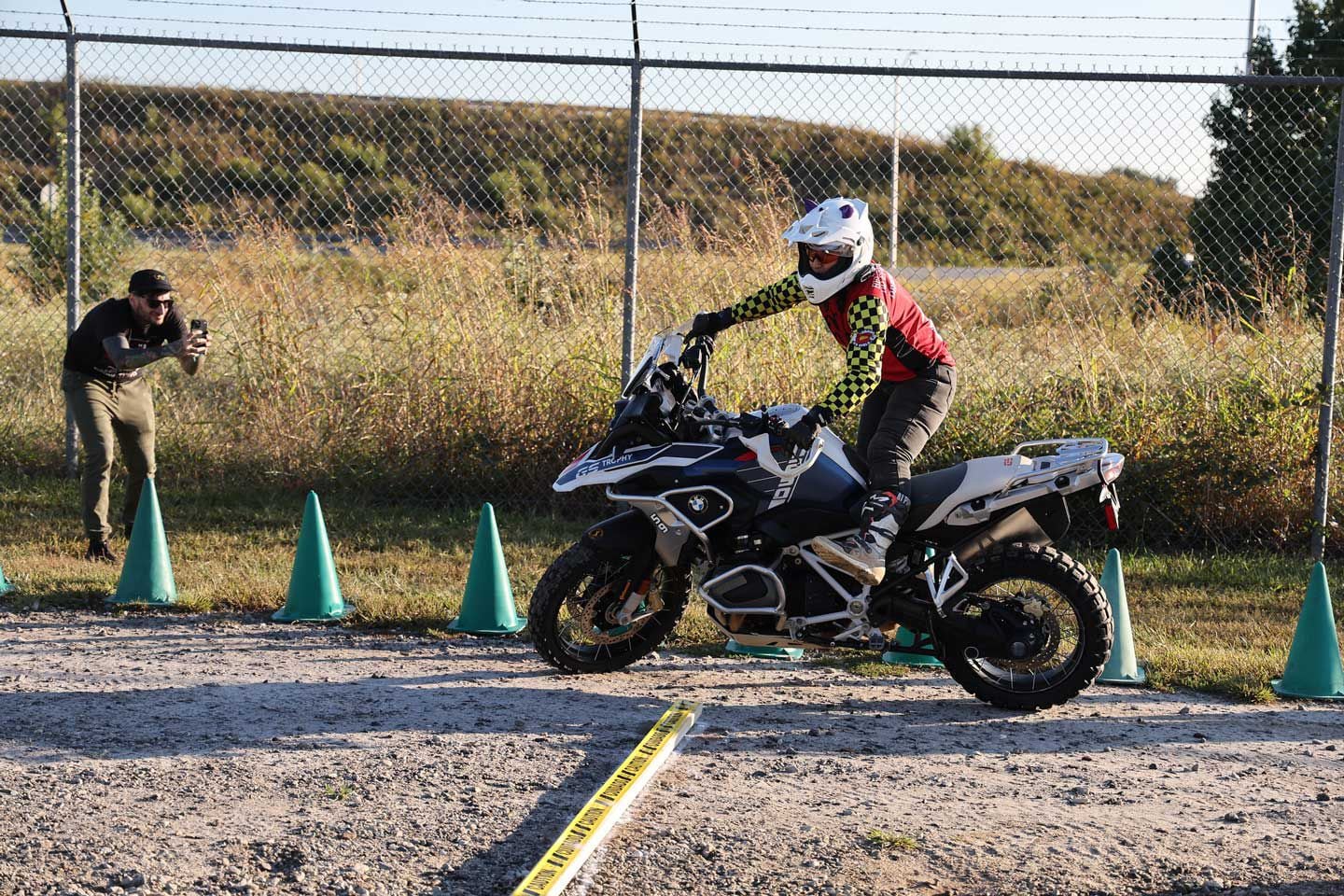
Jess Hofherr, the second-place finisher on the women’s team during the finals. Lighter-weight riders make the GS work for them using extreme-looking body position. (James Holbrook/)“It taught me that it’s OK to fail,” said John Boyd, another competitor who I met at the Trophy Prep course.
The 54-year-old from Kentucky competed after being prodded by his son, who noticed that his dad had lost his competitive spirit. Boyd’s fear of failure was standing in the way of putting himself out there. “I’m not a prideful person,” he said, “but I’m a prideful person when it comes to failure. Midday yesterday, I just thought, ‘I’m done.’ I hit rock bottom. It hit me: This is why I’m here. Now, I feel like I’m unleashed. That demon was slayed here. I’m ready to go do hare scrambles when I get home. Like, watch me crash.”
Halfway through day two, it was time for the semi-final round. The field of 60 men was whittled down to just 16; the field of women down to six. While I didn’t make the semi-finals, I was elated for my new friends who did: Heggarty, Wells, Johnson, and Gines. Heggarty and Wells then advanced to the finals. In the end, Heggarty, Team Bravo’s own, rode with his signature flair, milking the experience for all it was worth. Wells ultimately finished fourth; just one spot shy of making the finals.
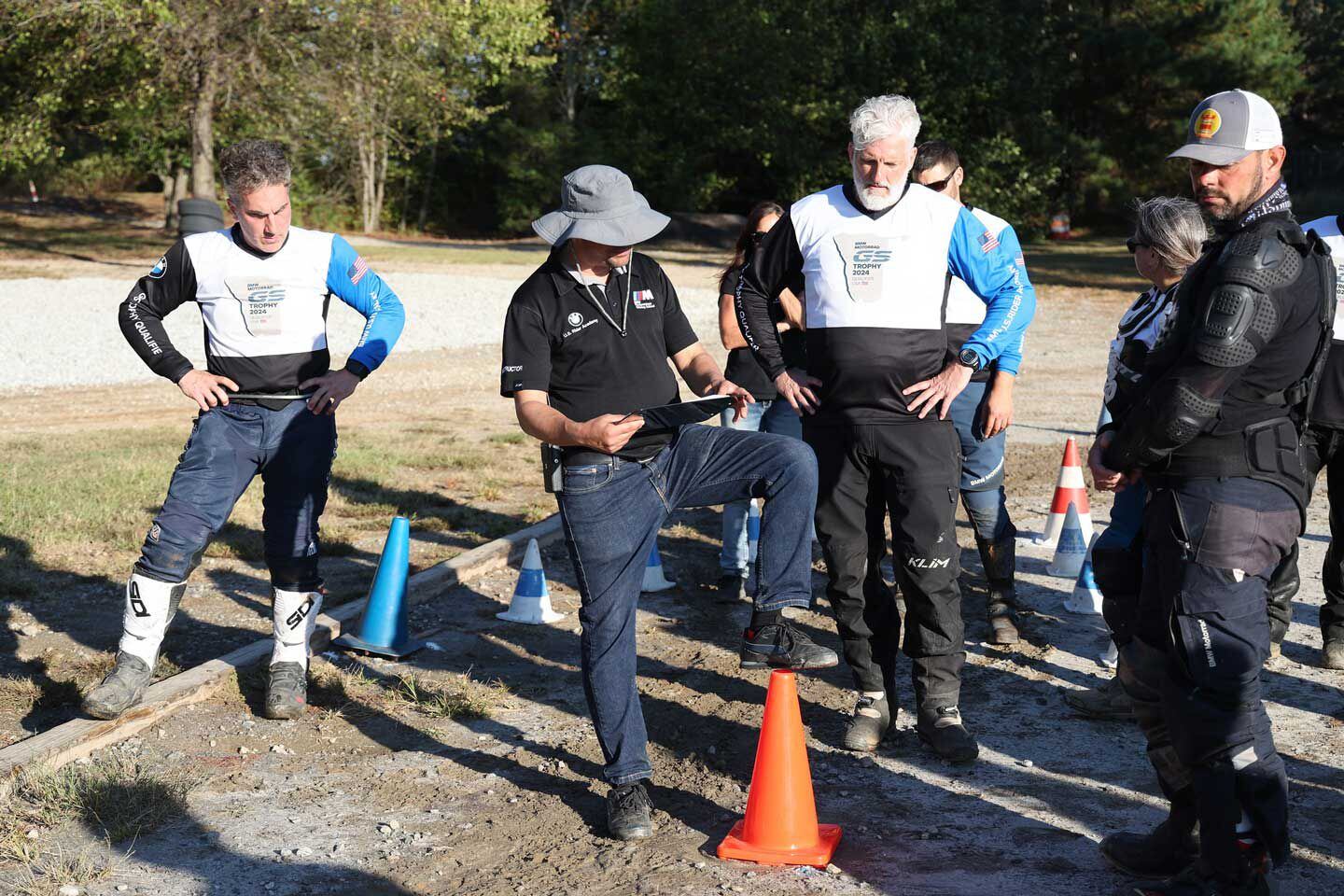
Ricardo Rodriguez, lead instructor at the Performance Center, walks finalists through the course. For this portion of the final, riders must execute a trials stop, rest their foot on the cone, and remain motionless for three seconds. (James Holbrook/)At the end of the event, over a catered surf-and-turf dinner, I caught up with Jocelin Snow, the First Lady of Adventure Riding. Snow, who competed in the 2018 GS Trophy in Mongolia, put it all into perspective.
“The Qualifier isn’t necessarily about the endgame,” she said. “You’re going to come here and meet a lot of new people and make new friends. You’re going to find out what you’re made of. You’re going to dig deep. You’re going to find your grit. I didn’t see one rider—even the best of the best here—who didn’t struggle. You’ll find out: Are you a quitter? Are you a fighter? Are you resilient? I’m finding as I’m talking to people that they’re having individual triumphs. They’re proud of themselves because they gave it their all.”
I make it to the top of the hill. My team is still cheering and clapping. “That was spectacular, Seth,” I hear Ricardo Rodriguez, lead instructor at the Performance Center, say. I go through the rest of the course. I don’t make it look easy. But I do it. Me—the uncompetitive too-busy-dad with a thousand reasons not to. I shake my head in disbelief. “I shouldn’t even be here,” I tell myself. But my mud-covered knobby tires say otherwise.
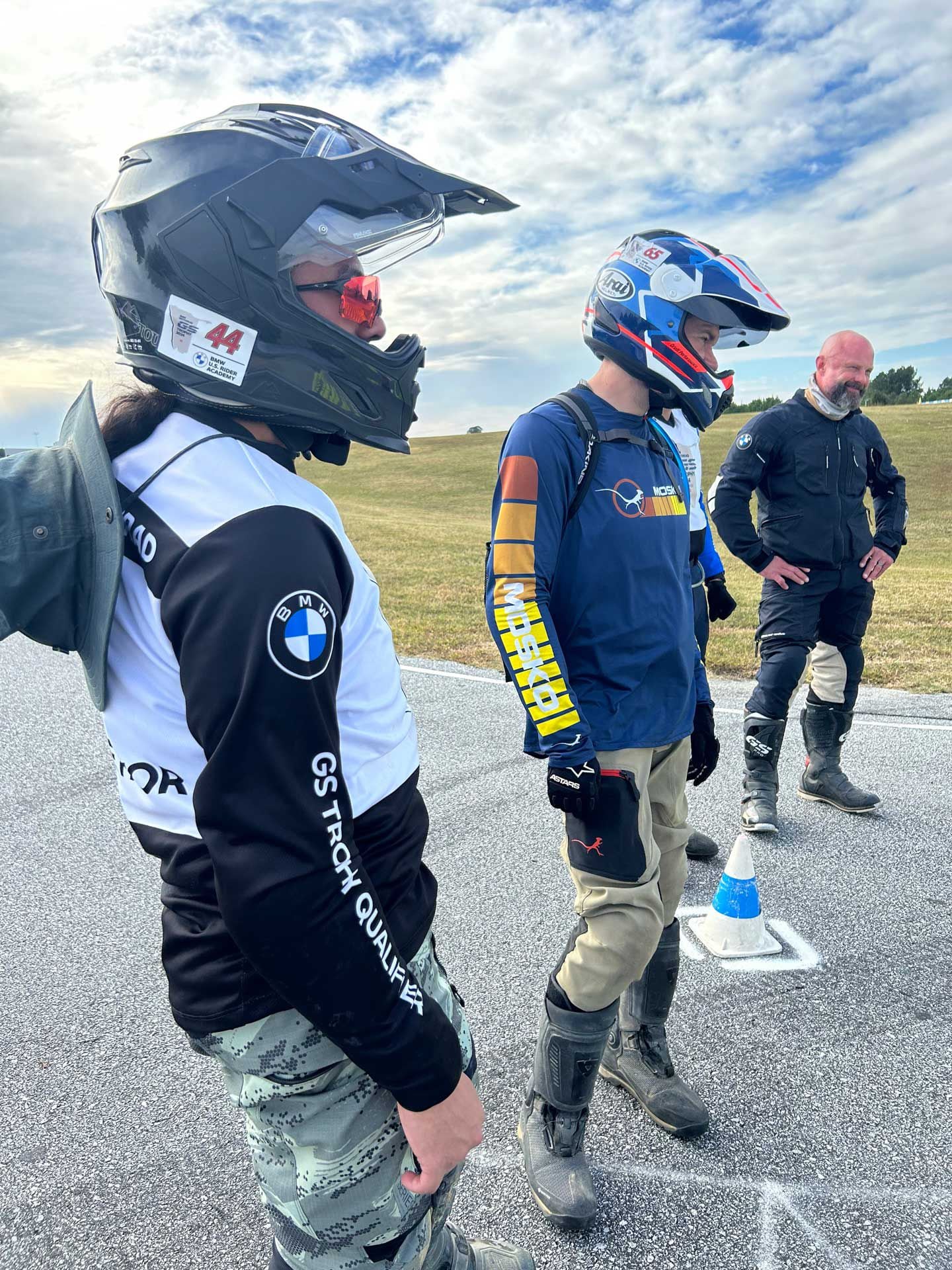
Melis Heerens, the author, and Chris Bronstorp listen to a course judge explain an on-road cone course challenge. (BMW Motorrad USA /) -
Barebones adventurers will surely love these bikes’ stripped down design.
-
The ZT 703 F and ZT 703 RR feature Zontes’ all-new 699cc three-cylinder engine.
-
 1
1
-
-
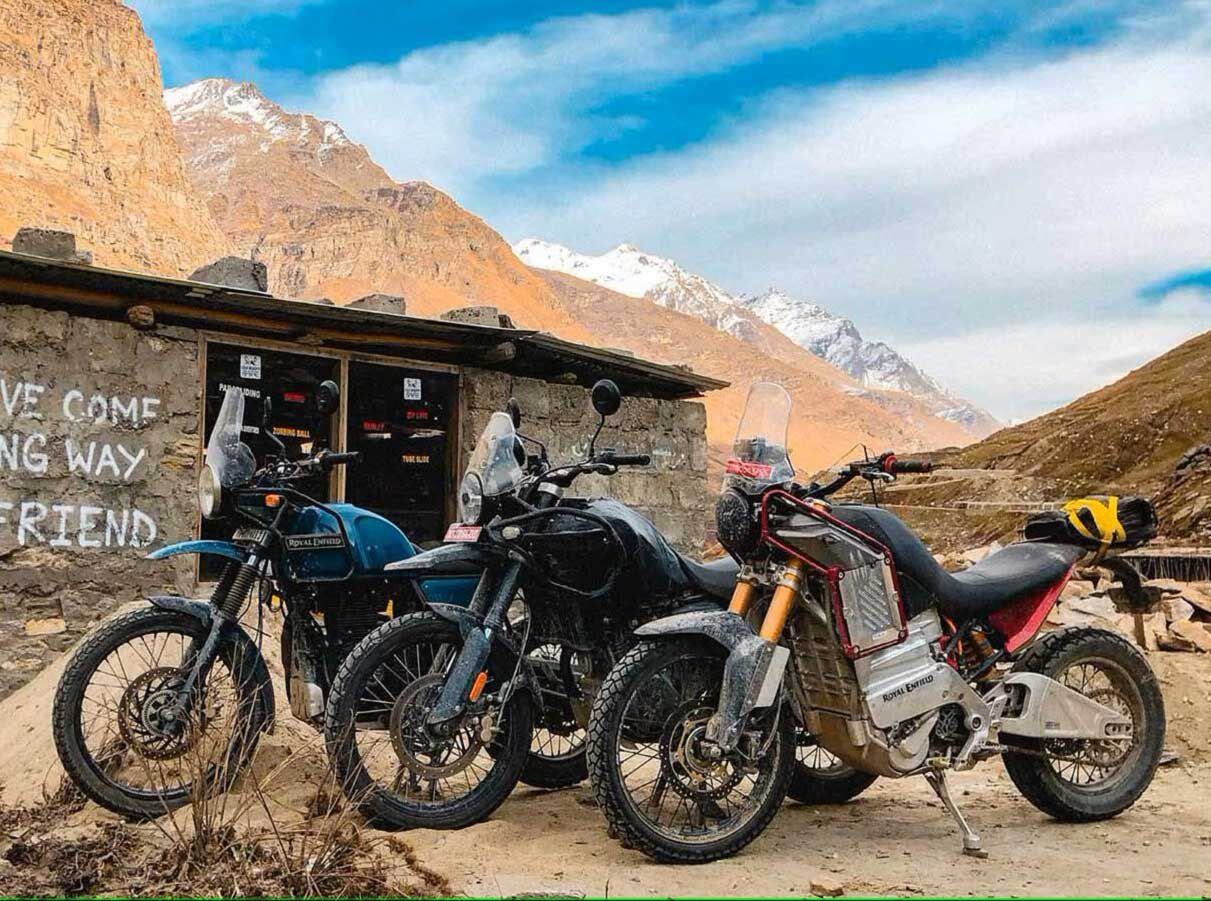
To everyone’s surprise, Royal Enfield pulled the covers off a prototype electric bike at EICMA. It’s the one in the forefront. (Royal Enfield/)Battery-powered bikes have been touted as the Next Big Thing in mainstream motorcycling for, like, ever, and we’ve seen many promising takes go down in flames over the years. But longtime players like Zero and now LiveWire (previously a model within Harley-Davidson’s range) have shown that the market has legs and so realistic choices for motorcyclists who want a battery-operated rig are only increasing.
This year’s EICMA show in Milan reinforced the point, and here are the five standout electric machines that caught our attention.
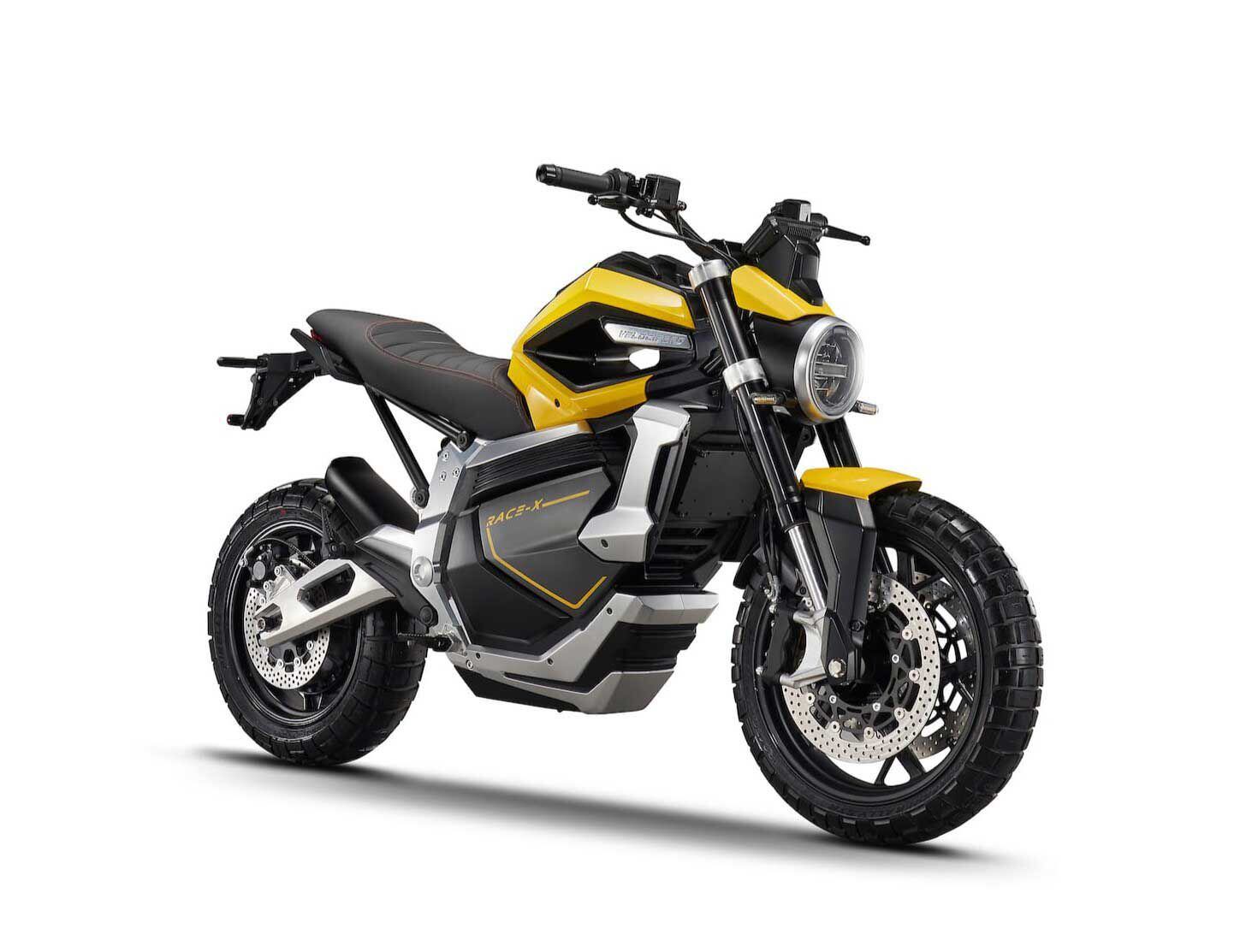
The Race-X electric scrambler from Velocifero also broke cover at EICMA this year, and is slated for production in 2024. (Suzuki /)2024 Velocifero Race-X
Making its global debut at this year’s EICMA was Velocifero’s Race-X, a scrambler-styled design that looks to lift the fairly young Italian brand onto a bigger stage. The company already produces several smaller models, all electric, but the Race-X is the most powerful yet, packing a 7,000-watt motor paired with a 6.48kWh lithium battery pack good for a charge time of 2.5 hours using either a 110- or 240-volt outlet or public AC charging stations. Still, you’ll see a top speed of only 75 mph, though the company also claims a peak torque of 162 lb.-ft., and range is said to be over 100 miles on a single charge. Riders can tap into four riding modes: P, Eco, Sport, and Sport+, and the chassis includes an inverted fork up front with a single shock absorber working on an aluminum swingarm. The Race-X is set to hit production in May 2024, with bikes being built in China.
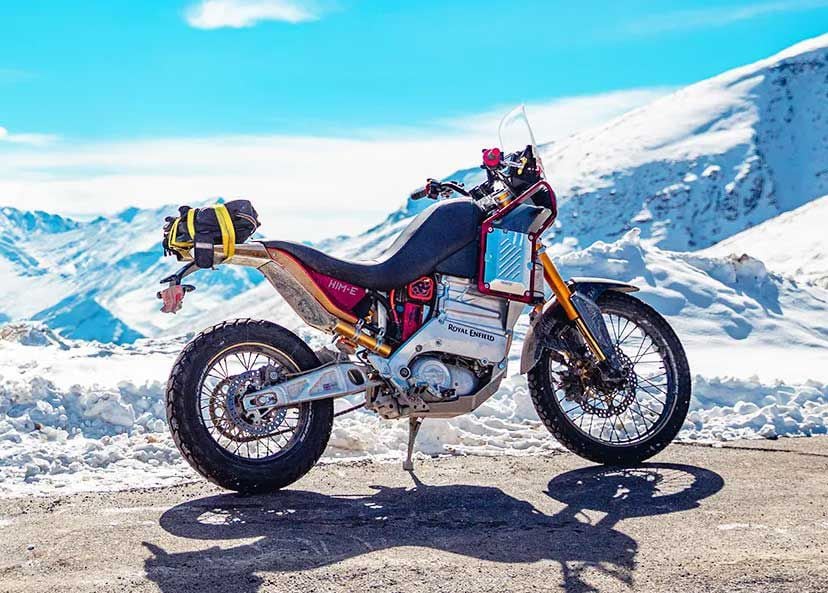
Royal Enfield’s Him-E is just a running “test bed” for now, but it shows the brand is serious about an electrified future. (Royal Enfield/)Royal Enfield Electric Himalayan
A brand-new liquid-cooled motor and a battery-powered prototype, all in the space of a few months? Say what you will about Royal Enfield’s seemingly throwback product line but these last two moves by the brand show a clear desire to break out of the retro box it has long occupied. The Electric Himalayan prototype revealed at EICMA is being billed as a “test bed” for exploring RE’s possible battery-powered future, but the fact that it’s a runner at all is impressive enough given the sort of punishing environments the base model is designed for. We know that on the Him-E, Enfield used ideas like a structural battery box to also serve as the chassis and organic fiber for the bodywork, but details like performance, battery capacity, and range remain shrouded. We’re still impressed that Enfield’s first-ever electric is this far along in the development phase, and it shows a serious push into the EV segment.
Just one question: Do they have charging stations in the Himalayas? Well, B. Govindarajan, Royal Enfield CEO, says: “This motorcycle is only just a part of a much bigger sustainable ecosystem of exploration and adventure that we are working on in the Himalayas. From green charging pit stops to our responsible travel initiative, from creating self-sustaining communities to collaboration with UNESCO to preserve the intangible cultural heritage of the Himalayan region, there are a lot of initiatives we are passionately driving.”
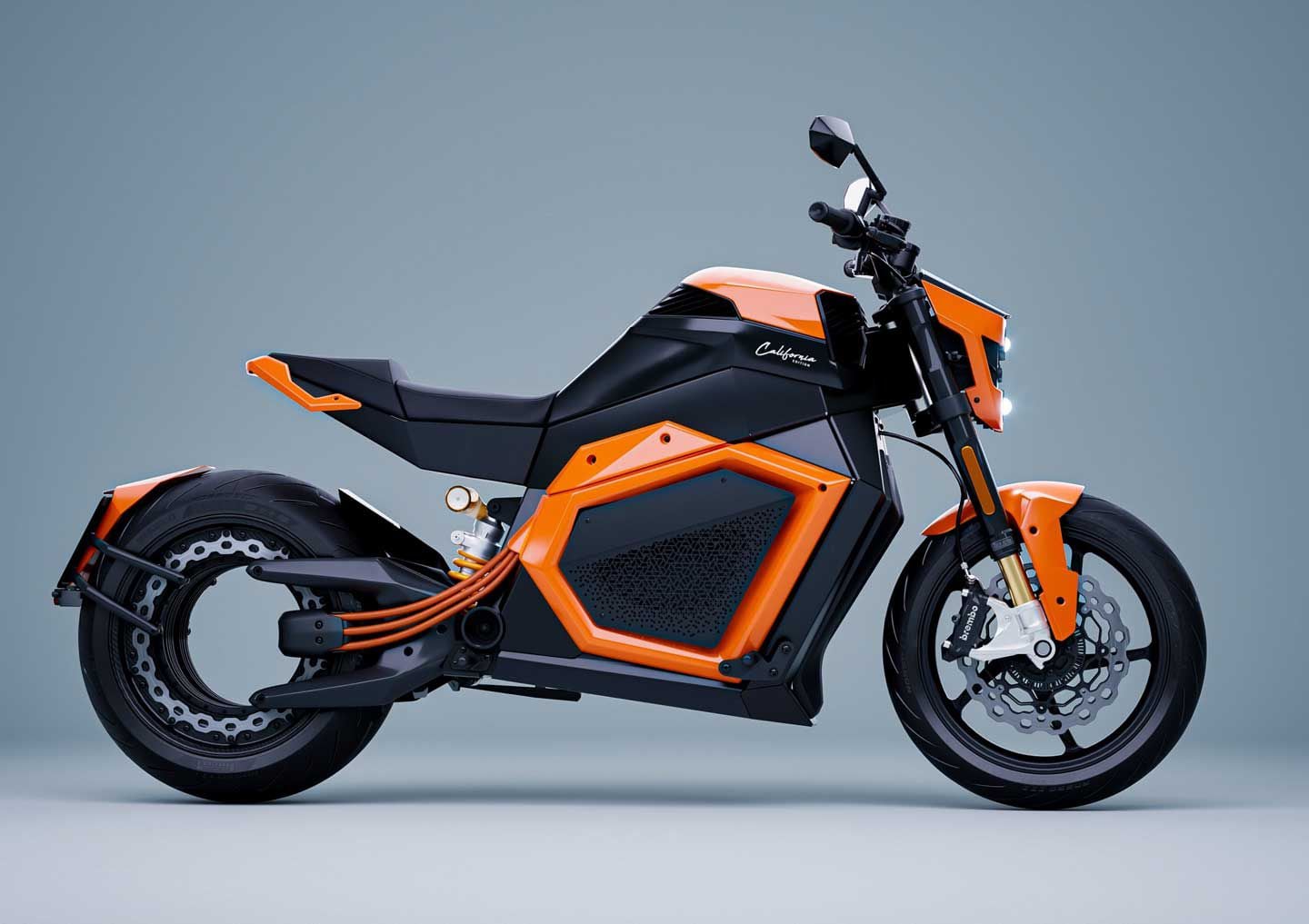
Verge recently released a special TS Pro California Edition version in its TS series. The brand says it will begin shipping bikes by the middle of 2024. (Verge Motorcycles/)2024 Verge TS
From the crazy, hubless drive system in the rear wheel to the solid, blocked-out engine bay and a plethora of plastic, there’s nothing remotely familiar about the concept-looking Verge TS, re-revealed at EICMA (again) this year. Specs include a 107 hp motor—housed in the rear wheel rim—that also claims an astounding 737 lb.-ft. of torque. Range isn’t bad either, with Verge claiming 155 miles in mixed use for the standard TS. Don’t look for bargains here, though; the base-model Verge TS starts at $26,900; the middle-child TS Pro retails for $29,900; while the top-of-the-line TS Ultra is a whopping $44,900—but gets 233 miles on a charge. Verge is already taking preorders for US buyers, and bikes are expected to be shipped by the middle of next year.
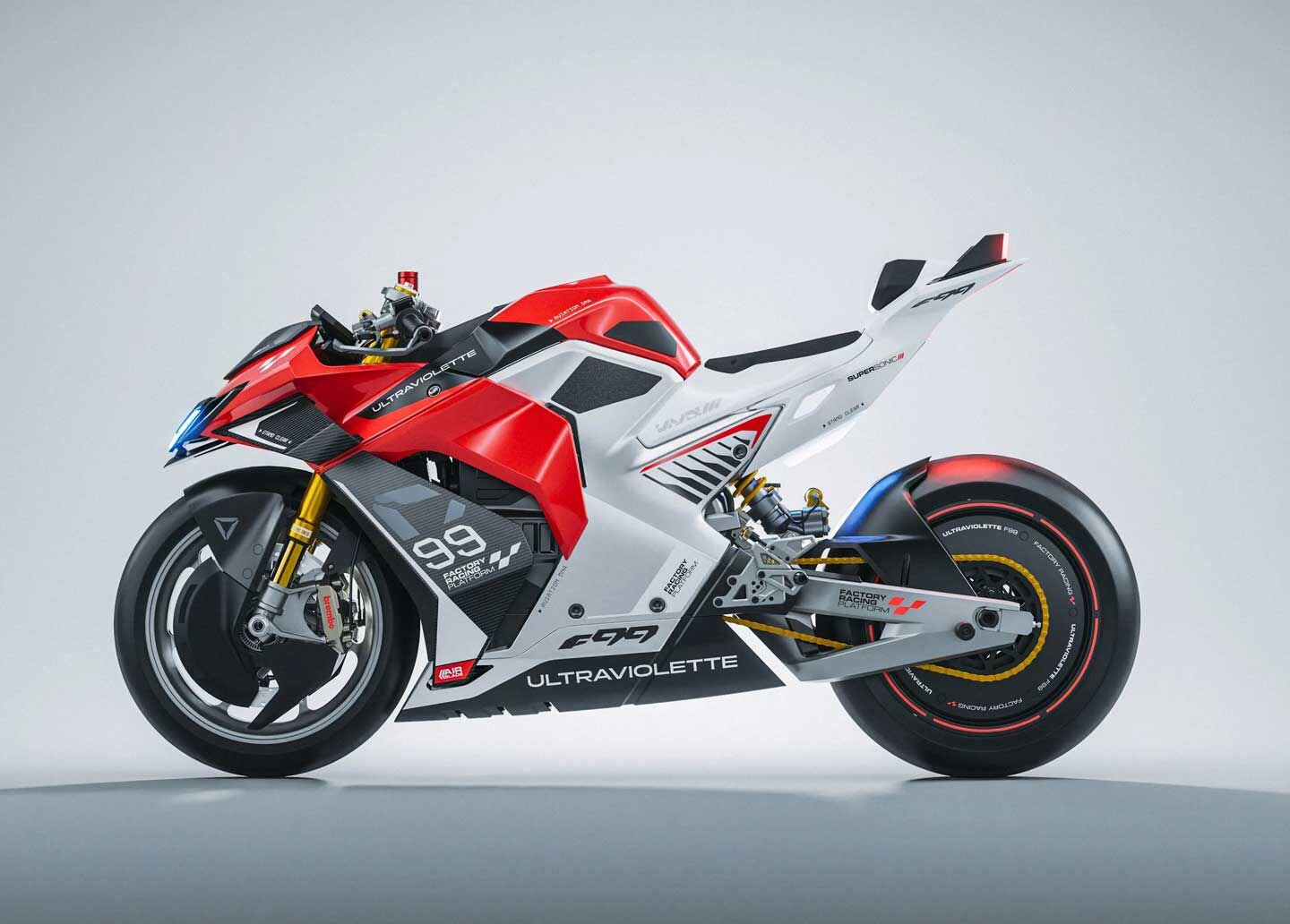
Once it’s officially launched in 2025, Ultraviolette’s F99 electric superbike will be the fastest two-wheeler made in India, says the company. (Ultraviolette/)2025 Ultraviolette F99
Ever hear of Ultraviolette? Us neither, until this year’s EICMA show where the brand unveiled its new F99 electric superbike. The Indian brand currently has just one other model, the F77, but it’s looking to grab headlines with this “factory racing concept” that’s expected to launch globally in 2025. For a so-called superbike, the F99′s specs are somewhat middling, with the machine generating a claimed 120 hp, a top speed of 165 mph, and 0–60 time of three seconds from the liquid-cooled electric motor. Energica’s Ego+ model, for one, tops all those numbers, but we’ll give Ultraviolette credit for the F99′s impressive design, which includes active aerodynamics with winglets, a steel hybrid frame with an aluminum swingarm, and all-carbon fiber body. Although it was presented at EICMA as a track-only project, Ultraviolette says that once the F99 is launched it will be the fastest two-wheeler to come out of India.
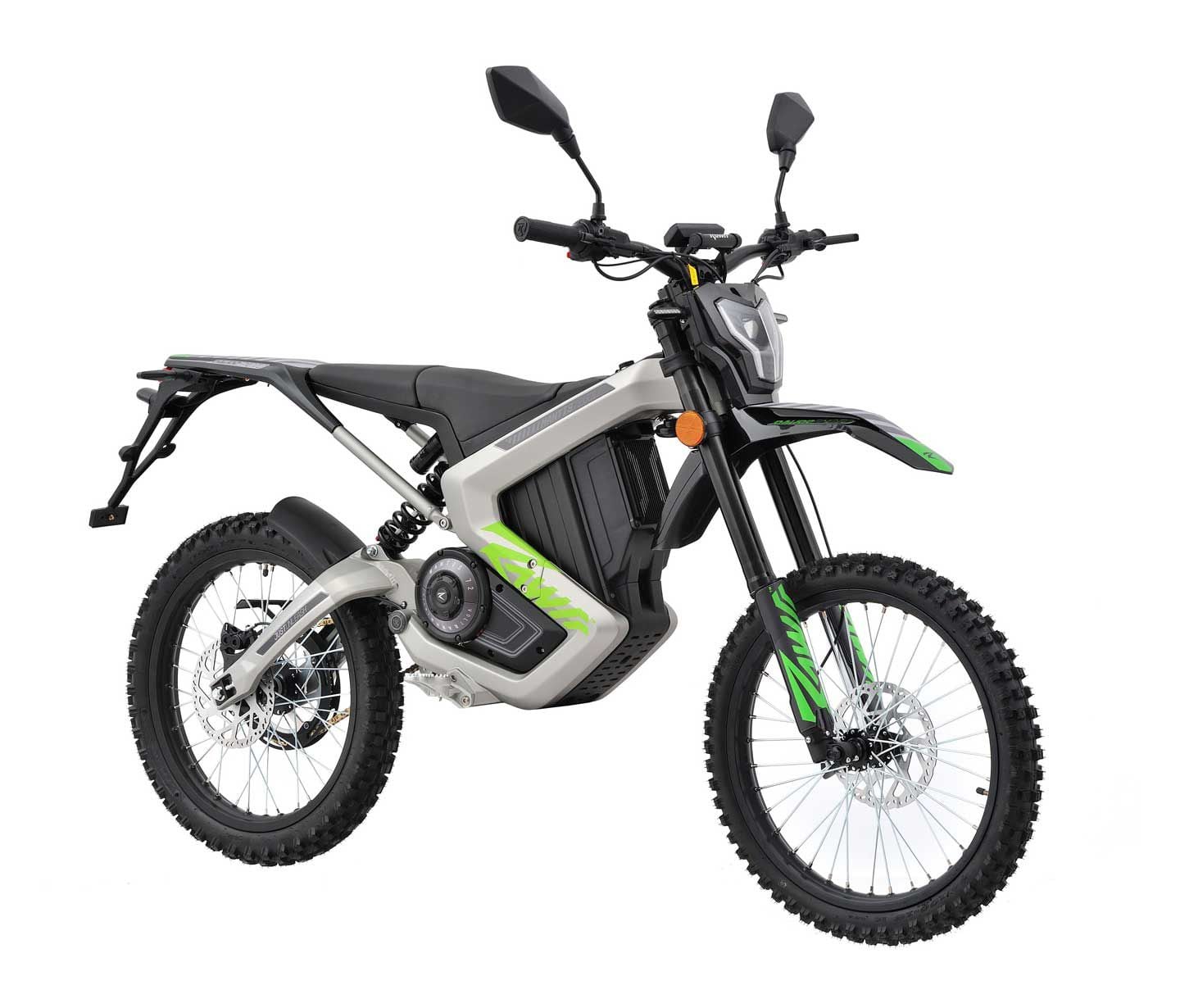
Is it an e-bike or an e-moto? Rawrr’s new Mantis S blurs the already wavy lines even more, but it’s officially street-legal, officer. (Rawrr/)2024 Rawrr Mantis S
Meanwhile, US-based Rawrr eMoto unveiled its new 2024 72-Volt Rawrr Mantis S, what it’s calling the first street-legal, lightweight e-moto. That’s a tall claim, and it’s sure to generate even more debate in the already-heated bicycle versus motorcycle cage match being fought in the streets as we speak. The street-legal status of the Mantis S gives legitimacy to a segment of electrics that found itself in no-man’s land due to not being a “real” motorcycle; even with a motor, many of these are not officially street-legal.
The Mantis S borrows heavily from the motorcycle world with its suspension and transmission components, meets on-road requirements in the US and Canada, and is fully DOT and ECE compliant—which Rawrr says is a first. So that means it belongs where other motorized vehicles tread (and with its 50 mph top speed, definitely not a bike path next to your 80-year-old Schwinn-riding grandma). The company is taking preorders for the alloy-framed, 35-amp, swappable battery-powered model now and bikes are expected to be in stock by mid-2024.
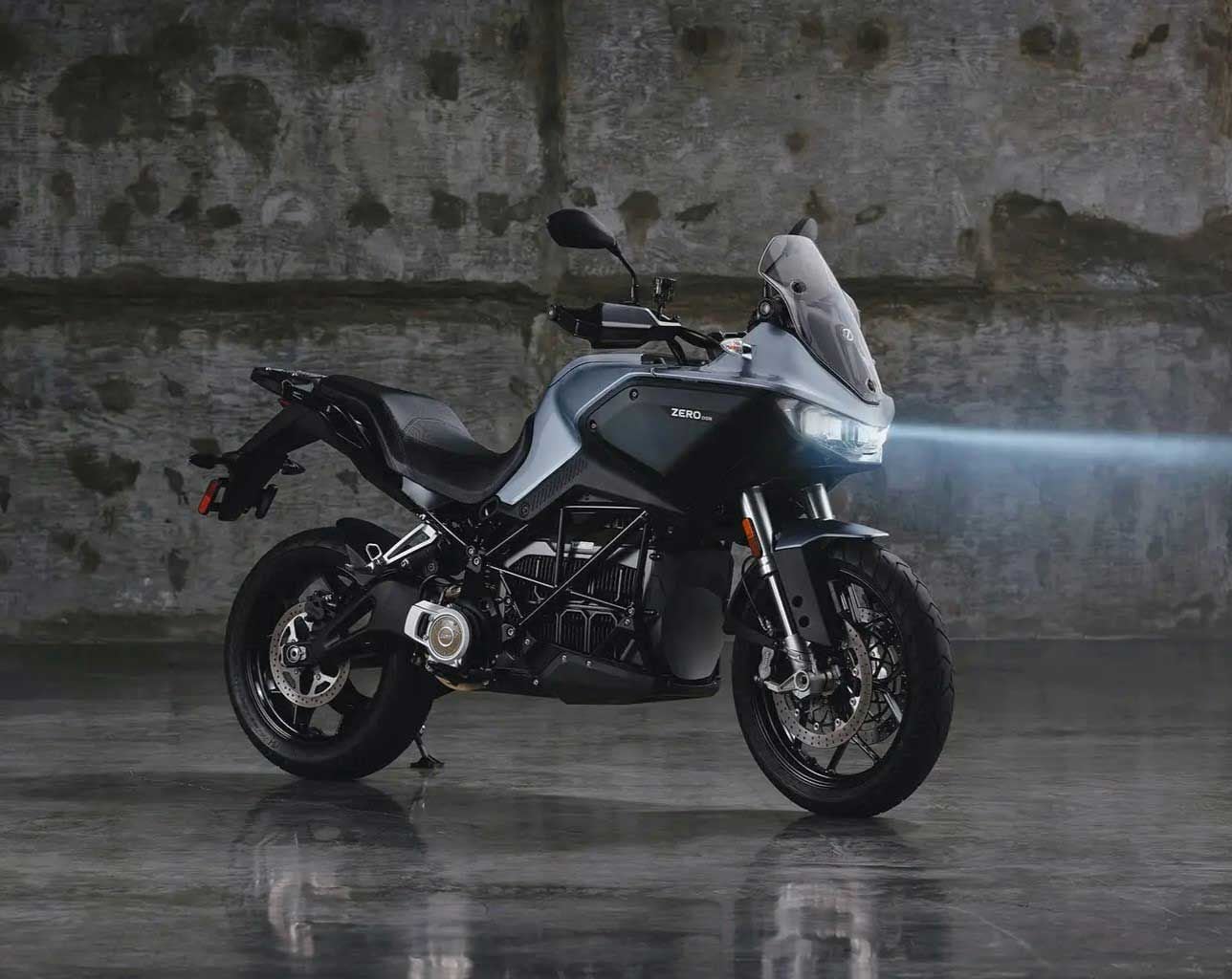
Zero overhauled several of its bikes this year, including the DSR, which it introduced as a new model rather than an update. (Zero Motorcycles/)2024 Zero DSR
Zero jumped into the new-bike reveal party at EICMA with an overhauled DSR model it’s calling new, rather than updated. That’s all good since it’s quite a departure from the more stripped-down vibe of the older bike, and the attractive new bodywork does add weight to the “new model” designation. New styling is the clear difference on the 2024 DSR with the new, large upper fairing with tall windscreen closely following the design language of the DSR/X. It’s not just better looking, but the 2024 DSR also gets a more robust, reinforced chassis, uprated Gates carbon belt drive, and a higher-capacity battery pack. The brand-new 15.6kWh unit has a claimed 155-mile city range and 100-mile mixed city/highway range; top speed is a claimed 104 mph from the new Z-Force 75-10 motor, which puts out a claimed 80 hp and 144 lb.-ft. of torque.
-
 1
1
-
-
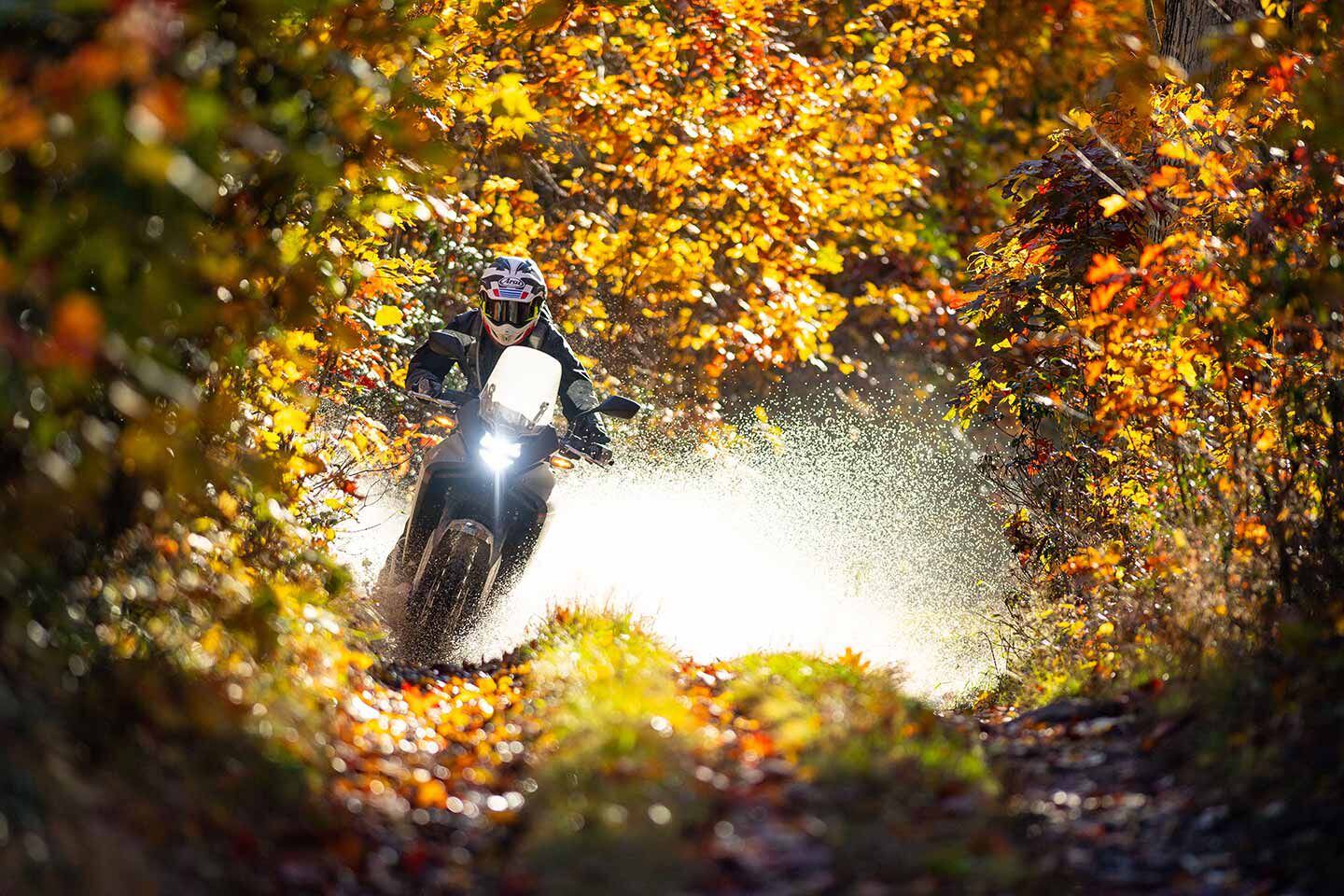
The Transalp’s agile chassis allows it to change lines off-road with minimal input. (Honda/)After 34 years, Honda’s original middleweight adventure bike returns to the US. Unveiled at EICMA in 2022, the all-new Honda Transalp features a 755cc parallel twin with a 270-degree crank. The original Honda Transalp utilized a 583cc V-twin and was only imported to the US for two years (1989–1990), but saw much more success through multiple iterations in Europe from 1986 to 2008. Cycle World described the 1989 bike as “a superb do-it-all motorcycle, a perfect choice for the rider who likes diversity in his riding.” Cycle labeled it as “comfortable, versatile, utilitarian, and stylish.” So why was the Honda Transalp unsuccessful in the US? Was it too far ahead of its time?
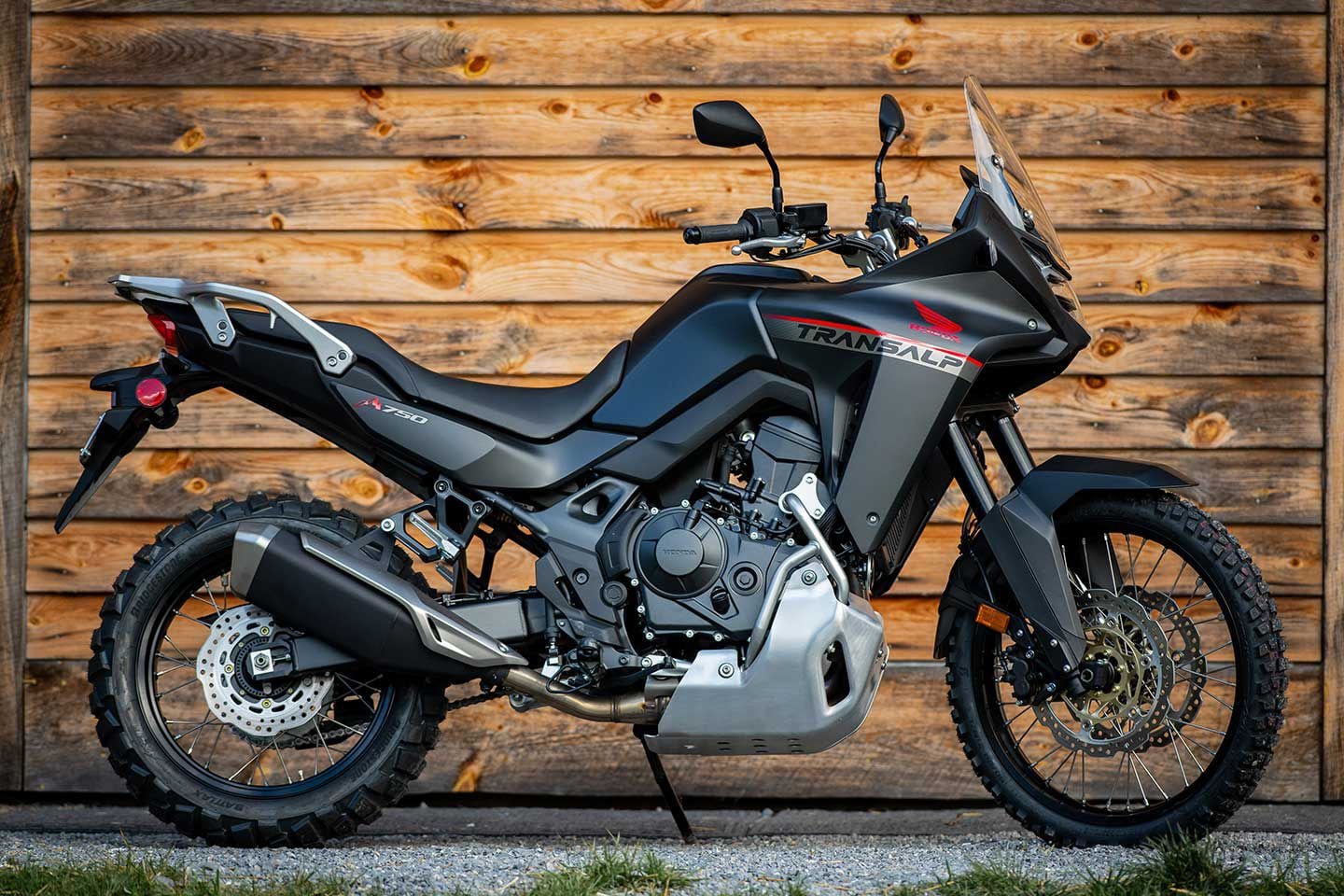
The 2024 Honda Transalp ($9,999) with aftermarket Bridgestone Battlax Adventure Trail AT41 tires. (Honda/)Today, adventure bikes are some of the most popular motorcycles in America. The middleweight ADV segment (700cc to 1,000cc) has quadrupled since 2018. These bikes are desirable because of their utility, performance, and all-road capabilities. Recognizing a gap in its ADV lineup between the CB500X and Africa Twin, Honda has reintroduced the Transalp as an all-new model for the US in 2024. But this time, the US market fully embraces adventure bikes. Now, the time is ripe for the Transalp to be successful.
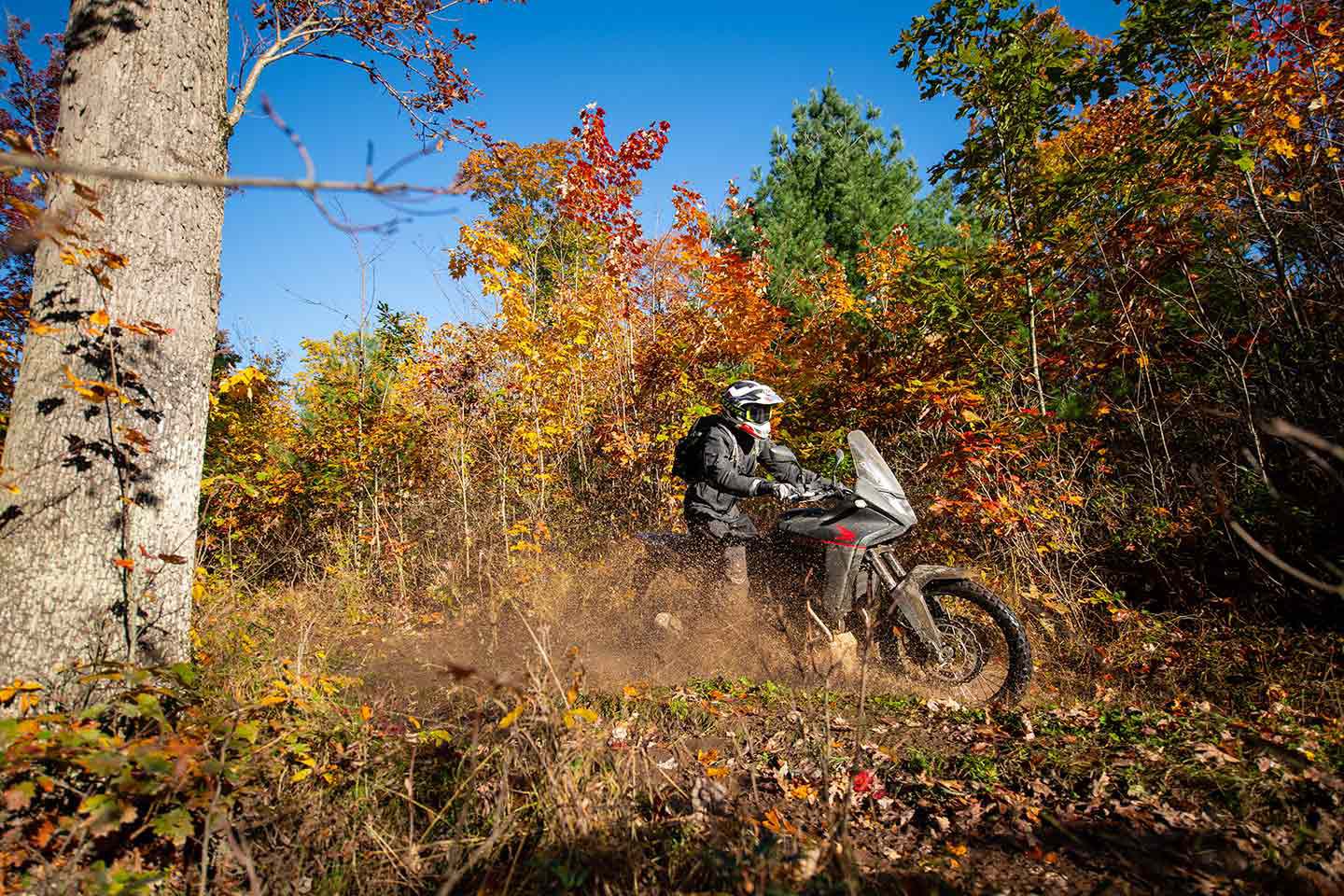
Honda is planning for the Transalp to make a big splash in the US market. (Honda/)Honda has positioned the Transalp as a 50/50 adventure bike. So its off-road capabilities are not designed to keep up with more extreme ADVs such as the KTM 890 Adventure R. Instead, the $9,999 2024 Honda Transalp is intended to serve as an all-arounder, a bike equally capable on and off pavement. Big Red stresses the importance of the Transalp’s touring performance, but also fitted it with essential off-road features such as spoked wheels (21-inch front, 18-inch rear), long-travel suspension, and switchable traction control. On paper, the Transalp is intended to be a jack of all trades whether it’s traveling down a gravel road, carving up a twisty backroad, or commuting to work.
2024 Honda Transalp Engine
Like nearly every other bike in the class, the Honda Transalp utilizes a parallel-twin engine. The 755cc Unicam motor features four valves per cylinder, utilizes a 270-degree crank, has 87.0 x 63.5mm bore and stroke dimensions, a 11.0:1 compression ratio, and uses Honda’s patented Vortex flow intake ducts designed to create a more uniform distribution of air through the airbox and into the 46mm throttle bodies. A slipper/assist clutch provides a good feel with minimal effort, limiting finger fatigue when modulating the lever off-road.
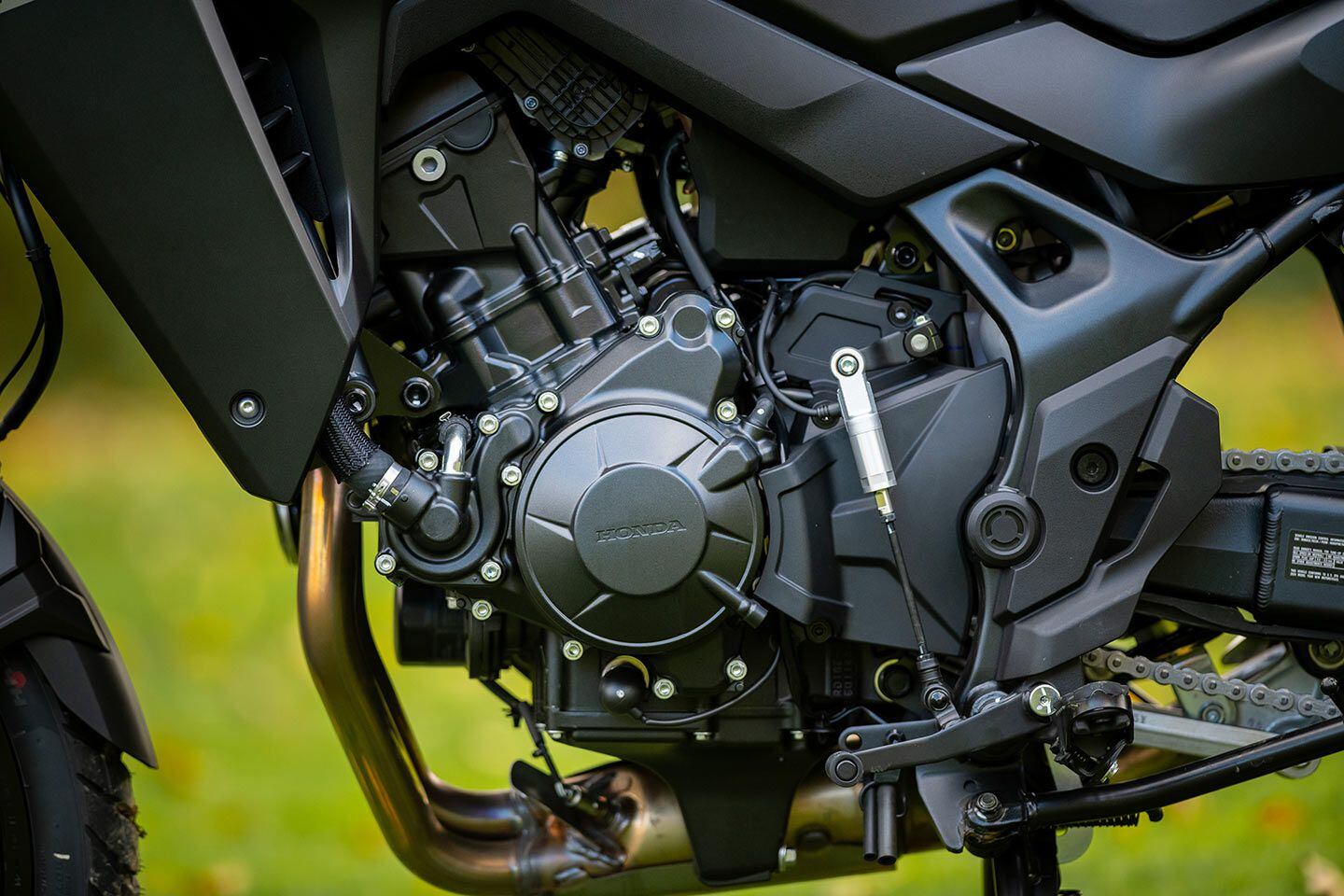
Honda’s 755cc parallel twin with a 270-degree crank and an up-and-down quickshifter. (Honda/)Honda claims the US model produces 83 hp at 8,500 rpm, making it competitive in the class against Suzuki’s V-Strom 800DE (CW measured 72.2 rear-wheel horsepower), Yamaha’s Ténéré 700 (CW measured 61.7 rwhp), and Aprilia’s Tuareg 660 (CW measured 69.9 rwhp). Honda gave the Transalp a short stroke for top-end performance, but the midrange is still plenty strong. The parallel-twin engine really comes to life after 4,000 rpm, and as the engine pushes past 6,000 rpm the delivery ramps up with a surge of power all the way up to its 10,000-rpm redline.
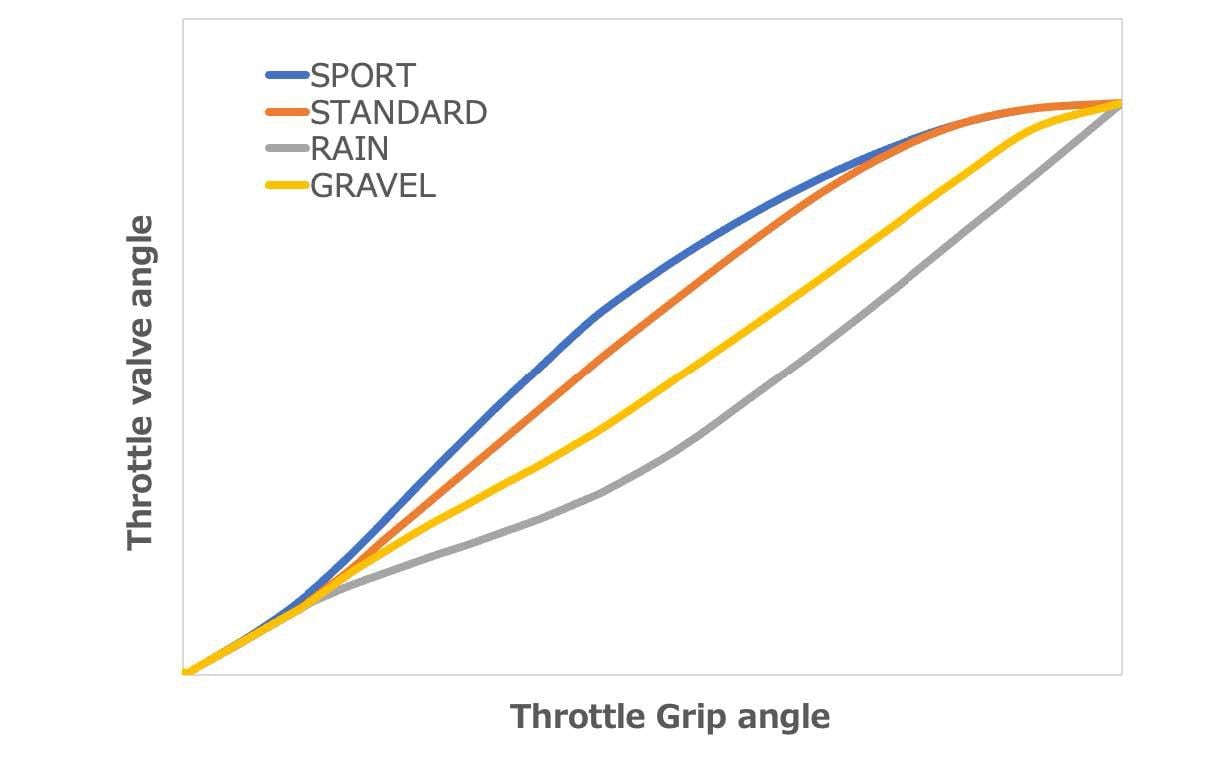
Power curve chart for each ride mode. (Honda/)On the trail, a soft bottom-end allows the rear tire to maintain traction in slippery conditions. Crack the throttle open more and the Transalp drives hard out of corners while still maintaining predictable traction. Its linear power delivery allows the rider to initiate a slide and confidently carry it through gravel corners before wringing the motor out and grabbing the next gear. A set of aftermarket Bridgestone Battlax Adventure Trail AT41 tires (Metzeler Karoo Street tires come stock) assisted in the Transalp’s exceptional grip in the dirt. On the pavement, the engine’s performance was just as good. The soft roll-on power is smooth and predictable midcorner and the strong midrange and top-end pulls quickly as the tach climbs through the rev range. At highway speeds, the parallel twin smoothly cruises north of 70 mph without any buzzing or vibration.
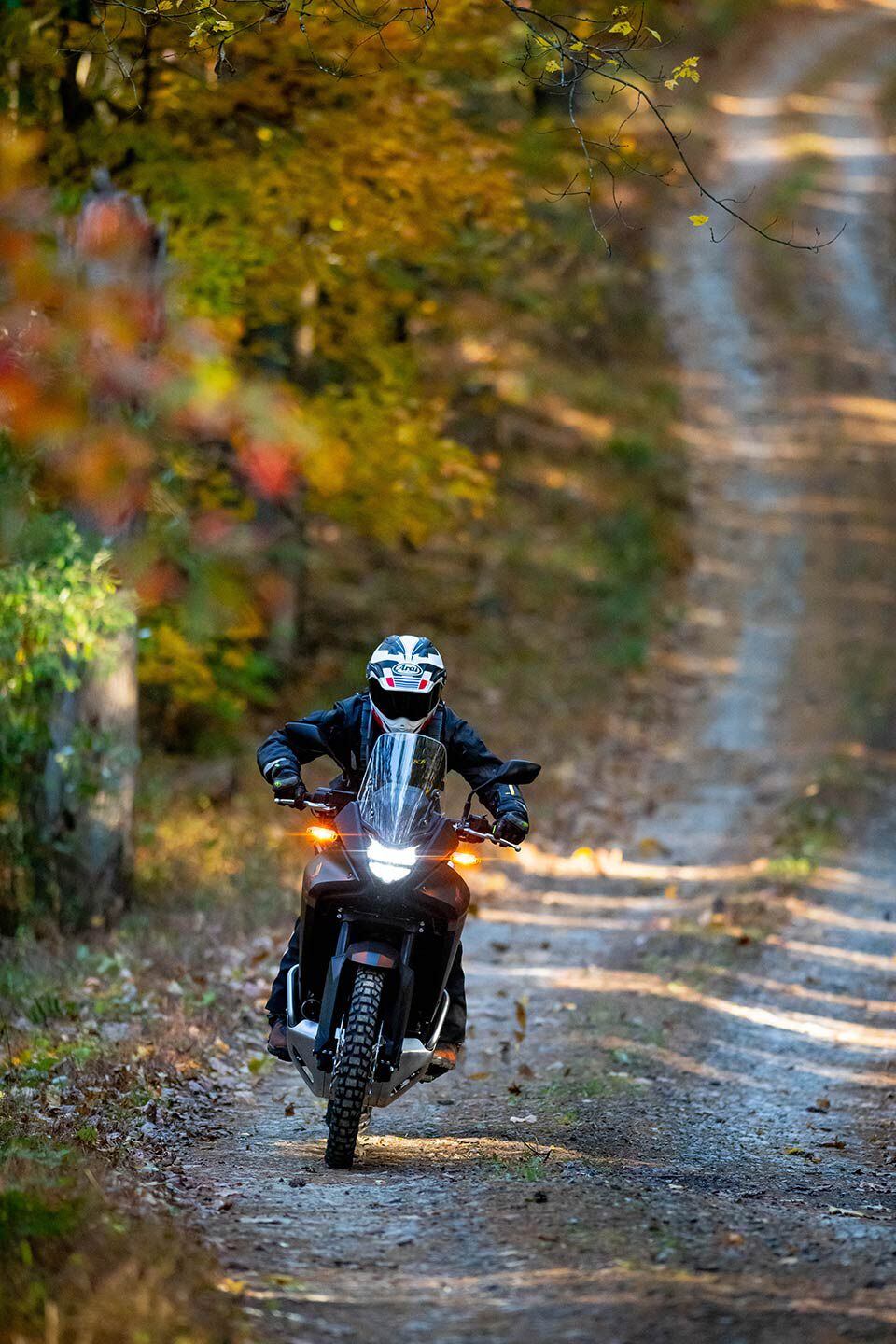
The Transalp is a gravel road weapon. (Honda/)2024 Honda Transalp Chassis and Suspension
Honda’s aim was to make the Transalp feel light and agile while still maintaining strong chassis rigidity. A steel diamond frame with 2.6mm downtubes and plated engine hangers are designed to improve stability and feel while reducing weight. The Pro-Link rear suspension has a low-mounted and beefy preload-adjustable Showa shock with 7.5 inches of travel. The 43mm preload-adjustable Showa SFF-CA inverted fork provides 7.9 inches of travel, with compression damping housed in the left stanchion and the rebound circuit in the right.
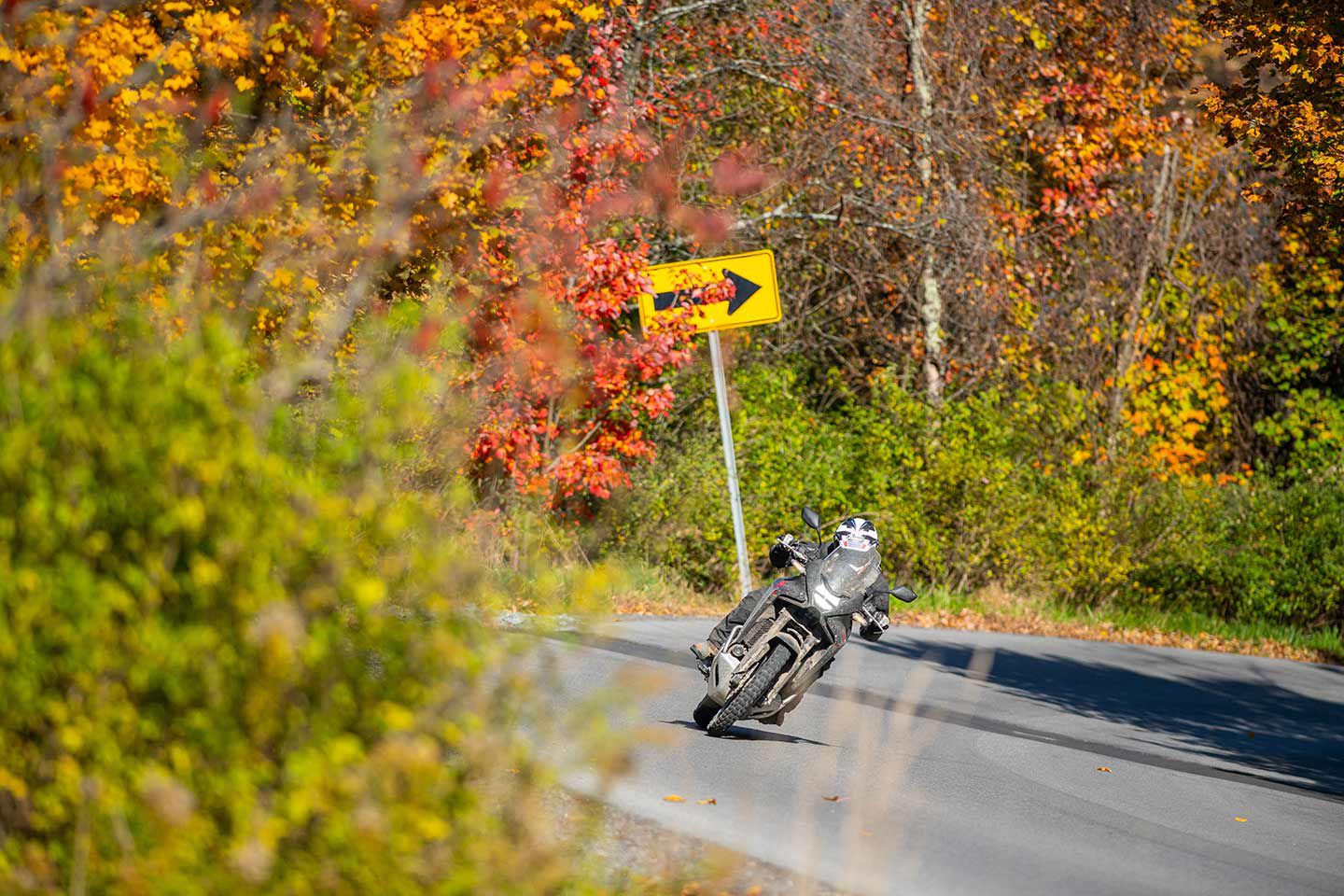
Even on knobby ADV tires it is possible to drag footpegs on backroads. (Honda/)Off-road, the suspension is soft and supple in the initial part of the stroke, absorbing bumps and gravel comfortably while managing to keep both wheels in contact with the ground. On twisty pavement, the components worked equally as well. Entering corners, the front end compresses just enough to apply extra pressure into the front tire without sacrificing ride height or diving too far into the stroke under braking. Under hard acceleration, the bike will squat just a little, allowing the rear tire to hook up. On the chunky ADV tires, the additional grip generated from the suspension eliminated the need for traction control on all dirt surfaces.
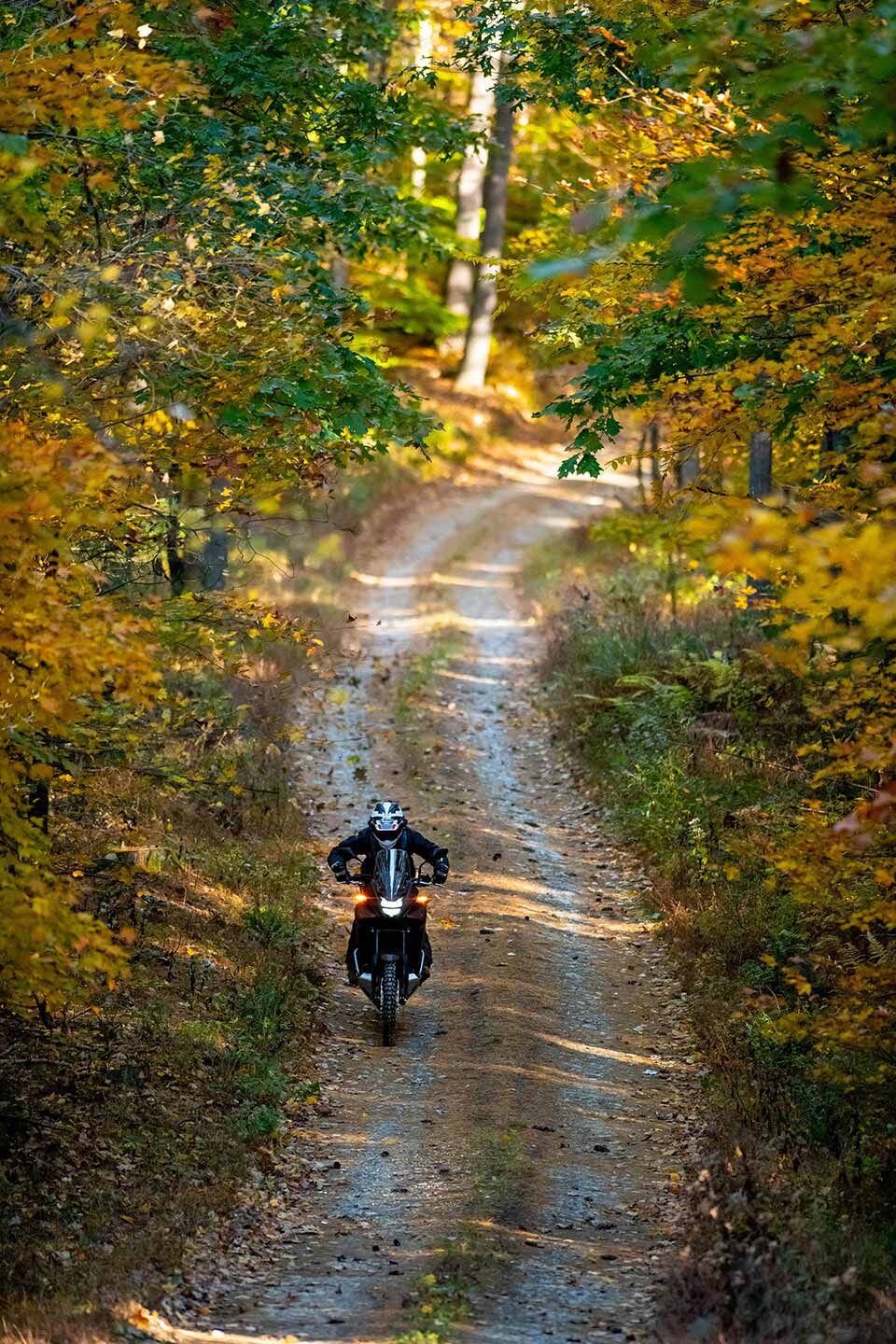
Our ride on the PA Wilds BDR-X offered amazing views in late October. (Honda/)Conquering chunky rock sections is possible, but in technical terrain the Transalp is not particularly comfortable. This Honda will certainly get you through just about anything any other adventure bike will, but the suspension damping is harsh and jarring when tackling the terrain too fast. Unlike its competitors, the Transalp does not offer damping adjustments.
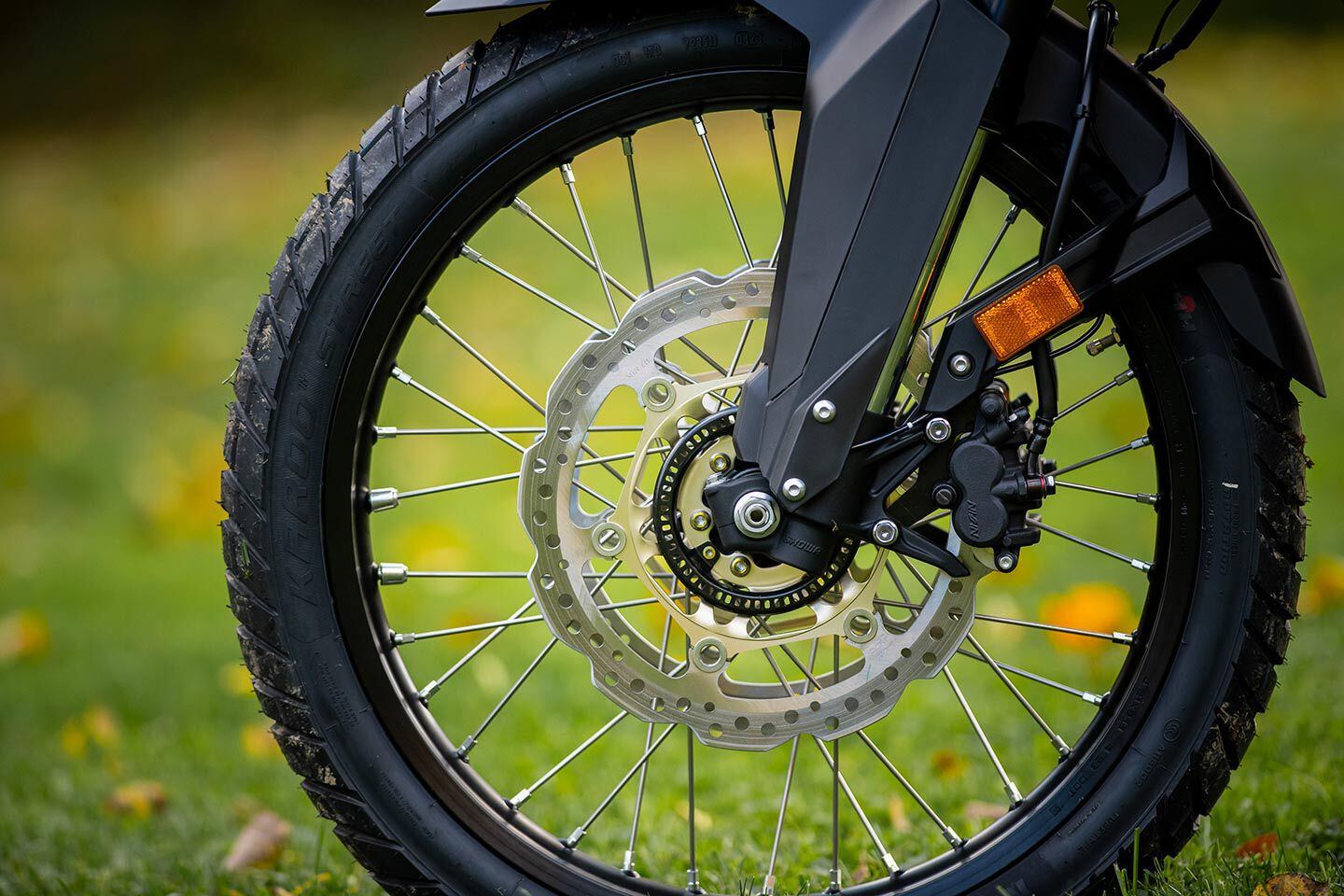
Dual 310mm discs with dual-piston calipers have a strong initial bite. (Honda/)A pair of 310mm disc brakes with dual-piston calipers slows the front wheel. A 256mm disc and single-piston caliper handles the rear. Both offer a strong initial bite with progressive stopping power. Feel at the front lever is direct and the ABS system is not intrusive. Through the 5-inch color TFT display, riders can activate off-road ABS which will account for limited traction conditions and prevent the system from kicking in too easily. Rear ABS can be fully deactivated allowing the rear wheel to completely lock up. Front-wheel ABS cannot be turned off. In most off-road situations, the ABS intervention is completely unnoticeable at the front wheel. Only when dragging the front brake as you go down slippery rock ledges does the ABS activate with a small kick to the lever.
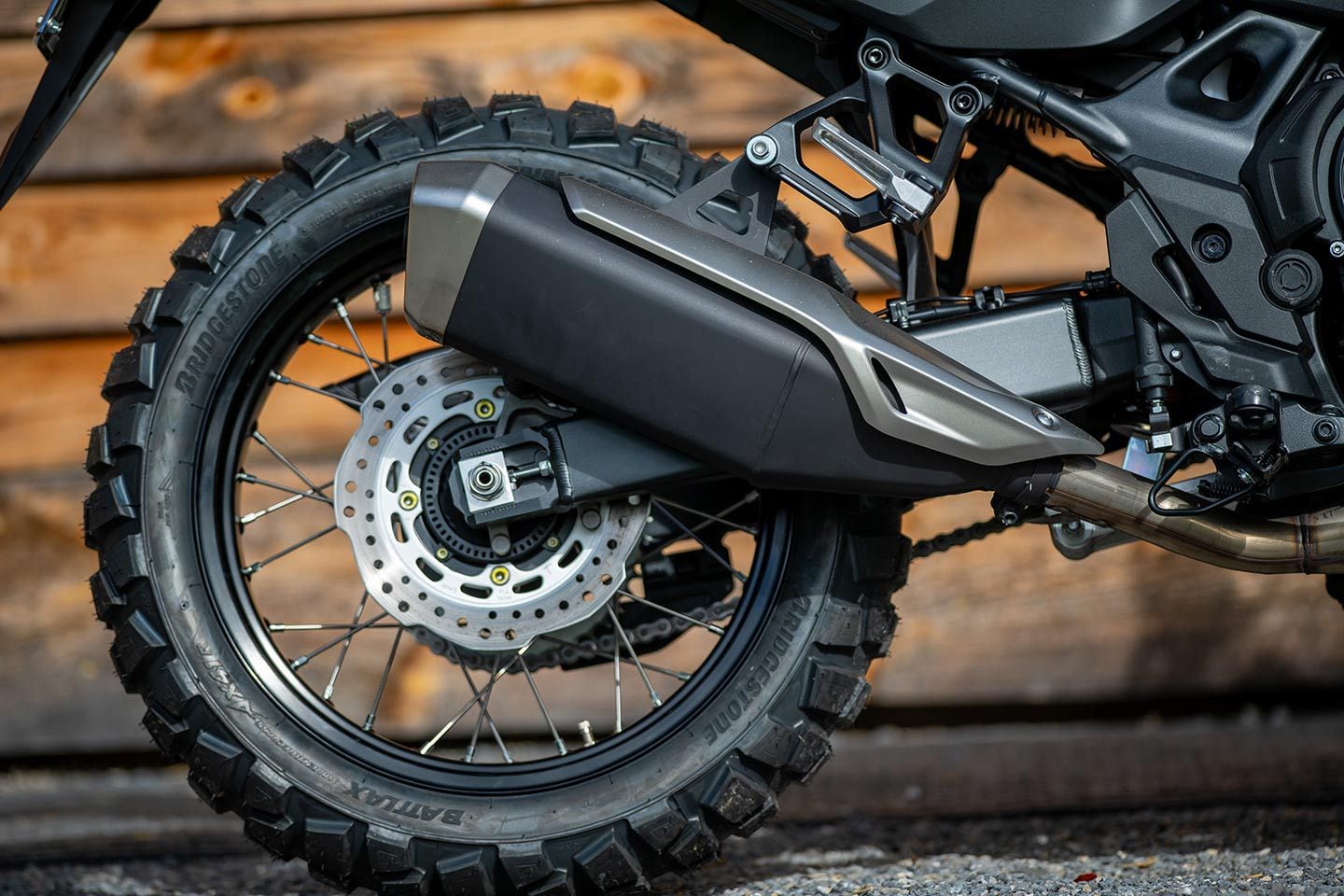
The rear brake utilizes a single 256mm disc with a single-piston caliper. (Honda/)Falling in between the Yamaha Ténéré 700 (62.8-inch wheelbase) and the Aprilia Tuareg 660 (60.0-inch wheelbase), the Honda Transalp’s 61.5-inch wheelbase is not out of the ordinary in the class. For reference, the Suzuki V-Strom 800DE has a 61.8-inch wheelbase. These dimensions are only slightly longer than a CRF450R dual-sport (58.3-inch wheelbase), giving the Honda Transalp agile steering off-road while still maintaining high-speed stability on road. The Transalp’s 27-degree rake and 4.4-inch trail are nearly identical to its 450 motocross sibling, producing familiar off-road handling characteristics.

The tall handlebar and slim midsection put riders in an aggressive position when standing up. (Honda/)With a claimed curb weight of 459 pounds, the Honda Transalp aligns with its most logical competitors. For reference, on the Cycle World scales, the 2022 Aprilia Tuareg 660 weighed 459 pounds, the 2023 Yamaha Ténéré 457 pounds, and the 2023 Suzuki V-Strom 800DE 507 pounds. Considering the Honda has the second largest engine of the bunch (Suzuki has the largest at 776cc) its claimed wet weight is impressive. It also has the lowest seat height in its class along with the V-Strom 800DE at 33.7 inches. Honda also offers a lower accessory seat dropping the seat height to 32.6 inches.
2024 Honda Transalp Electronics
As with any modern adventure bike, the electronics package is a huge point of emphasis. But not all middleweight ADVs come with a tunable electronics suite. Yamaha’s Ténéré 700 has been a popular mount in the class since its introduction despite offering no electronics aids besides switchable ABS. As the segment has evolved, the appetite for selectable ride modes, adjustable traction control, switchable ABS, tunable engine-braking, and the addition of a quickshifter has increased. The 2024 Honda Transalp has all of these features.
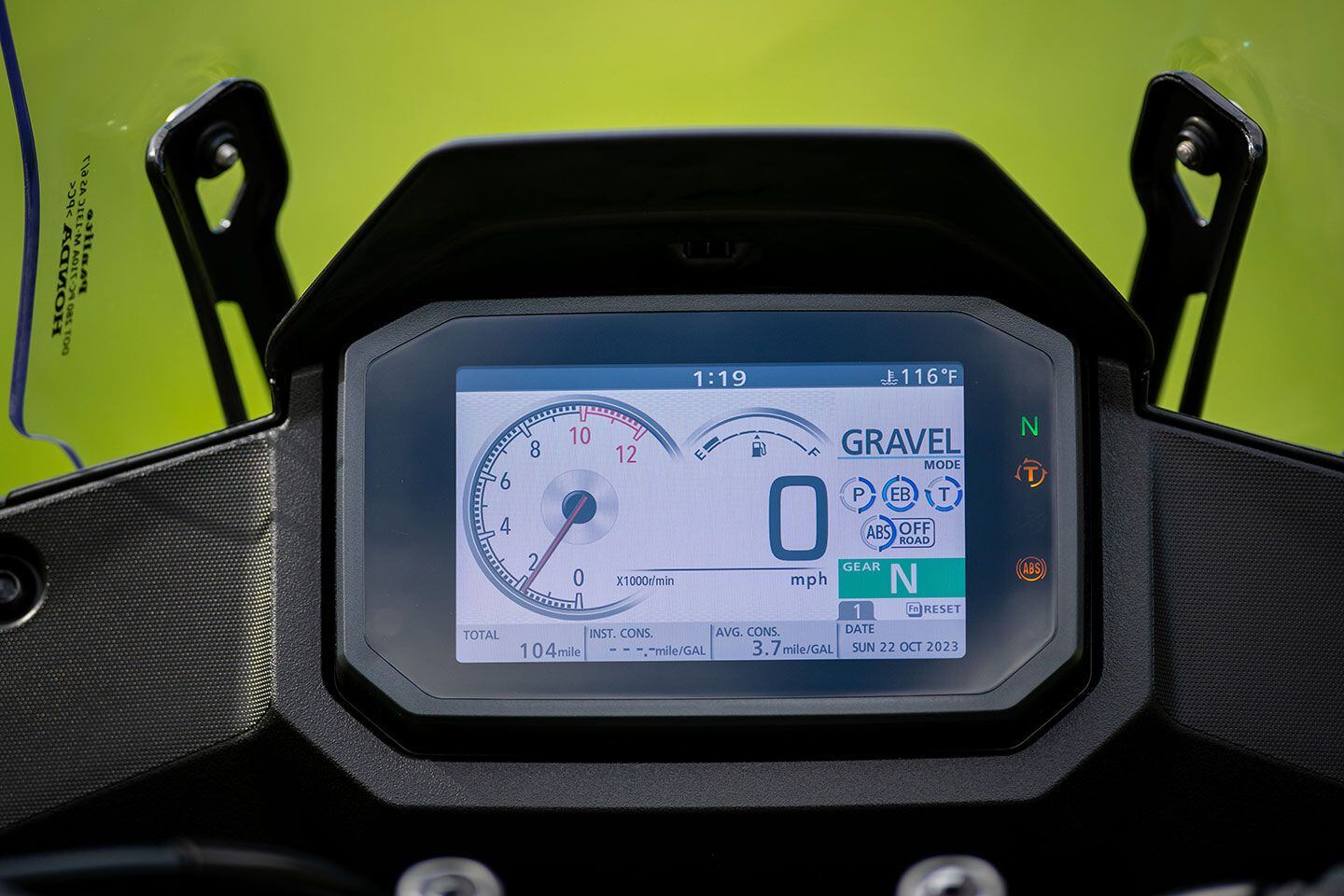
The 5-inch TFT display is refined and easy to read. Riders have the choice of four layout options. (Honda/)Riders have the option of four preset ride modes (Standard, Sport, Gravel, Rain) and a fully customizable User mode. The preset ride modes are nonadjustable, but in User mode, the rider can dial in four levels of power delivery; five levels of HSTC (traction control) as well as completely disable traction control; three levels of engine-braking; and choose between three different ABS settings (On Road, Off Road, and Off Road with rear ABS completely disabled). A majority of my time was spent in User mode with full power, HSTC turned off, and the lowest level of engine-braking. It’s an easy engine to meter, but it’s also nice to have options when needed. With the ability to change the parameters, the Honda Transalp can be tamed down or spruced up depending on the rider’s preference.
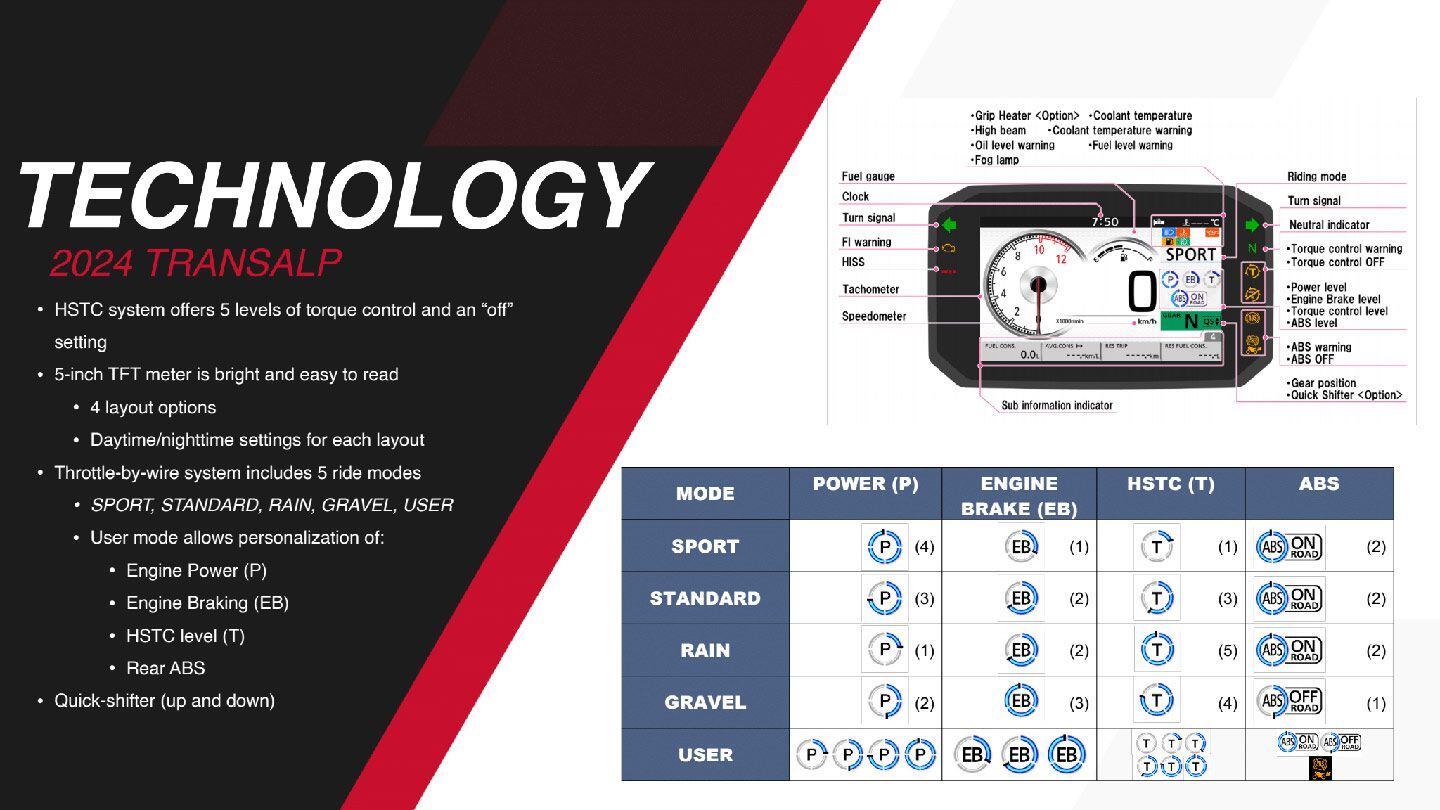
The 2024 Honda Transalp’s electronics are easy to navigate and adjust. (Honda/)Traction control disabled with full power allows the Transalp to break loose, slide, and lift the front wheel. Gravel mode has the HSTC level at 4 (one less than the most restrictive) and was too intrusive. Sliding through corners or driving up a loose uphill will quickly activate traction control and cut power to the rear wheel. Less experienced riders will appreciate the additional safety of Gravel mode, but anyone wanting to ride aggressively in the dirt will opt for a custom setting in User mode.
On the pavement, Sport mode provides full power for quick get-up-and-go, but with HSTC on (level 1) wheelies are not possible due to the integrated wheelie control. If lifting the front wheel from one corner to the next is in your playbook, opt back to User mode. Standard and Rain mode have noticeably mellower power delivery than Sport mode, but every mode provides the same top-end power.
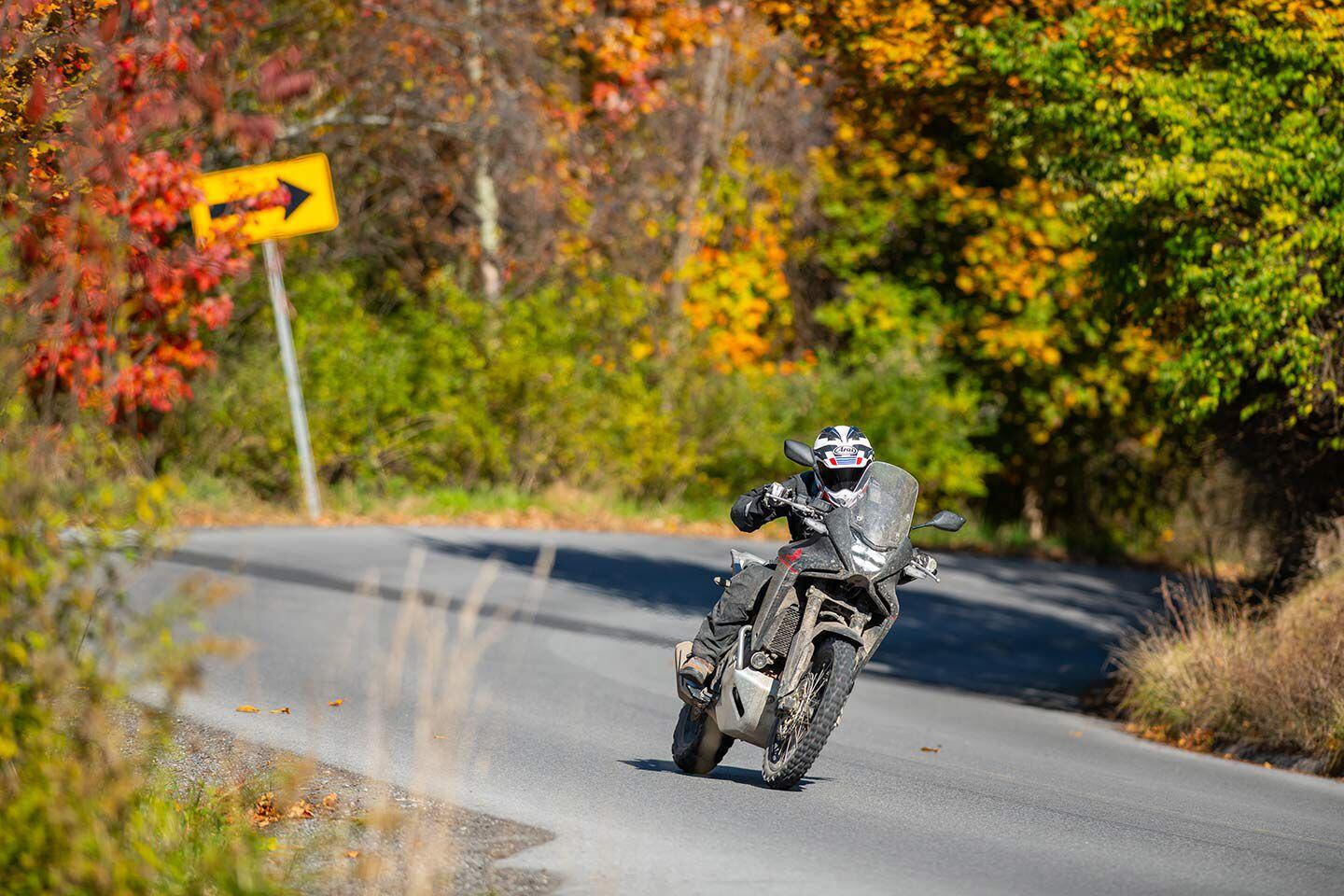
In full GP mode with the quickshifter turned on. (Honda/)An up-and-down quickshifter comes standard on the 2024 Transalp. Grabbing the next gear at full throttle happens seamlessly and adds to the bike’s ease of use. Whether you’re fully pinned exiting a corner or shedding speed for an obstacle, selecting the correct gear is as easy as kicking the shifter. The only thing missing from this middleweight adventure bike is factory-fitted cruise control. And unlike the Africa Twin, switching modes or adjusting settings in User mode is easy and intuitive. But note, if you cycle the key, HSTC and ABS will automatically come back on in User mode, meanwhile every other adjustment stays the same.
2024 Honda Transalp Ergonomics
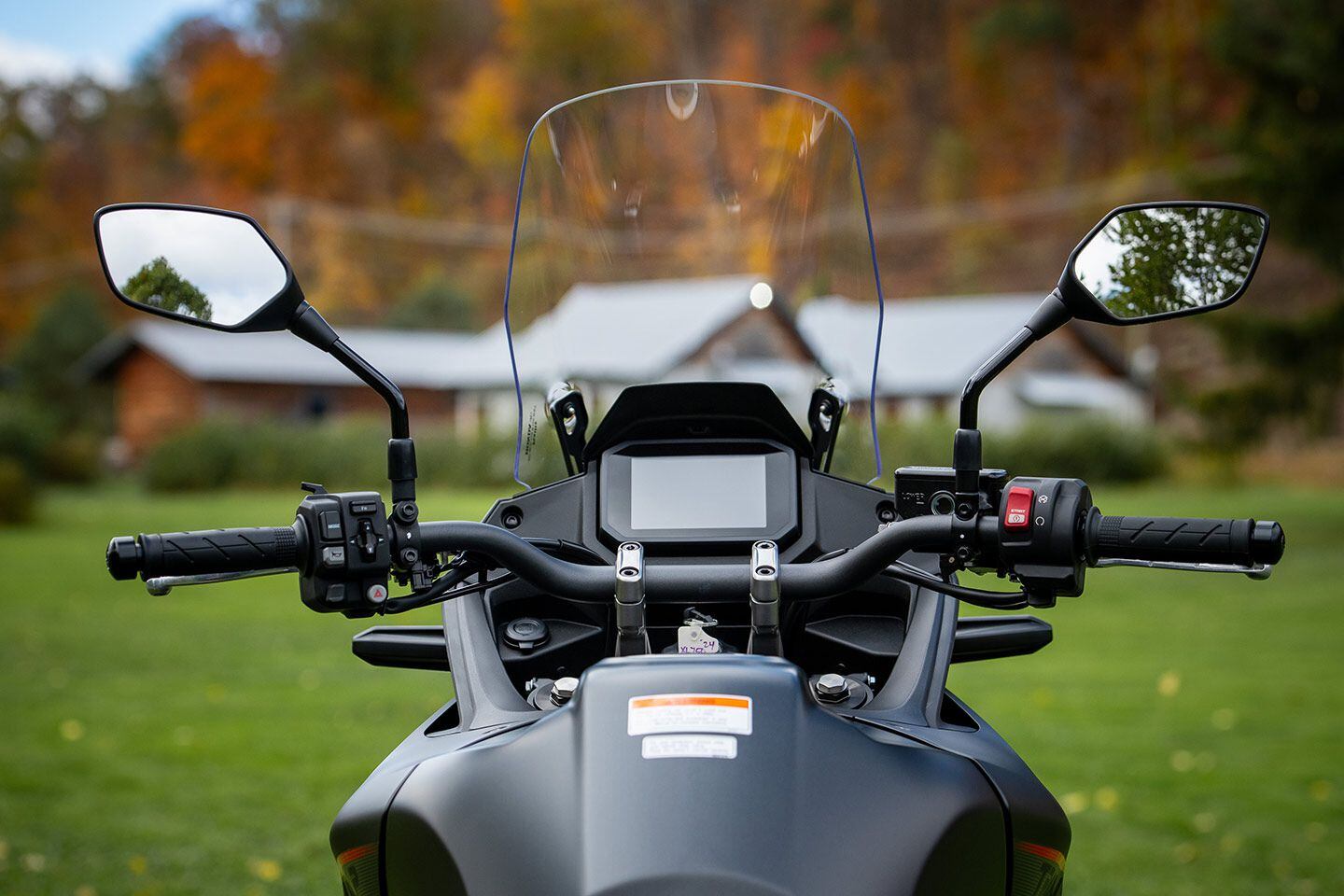
A view from the cockpit. (Honda/)Honda’s Transalp offers a very neutral riding position with a tall, wide handlebar and plenty of wind protection. From the cockpit, the Transalp has a “sit in the bike” feel. The seat height (33.7) is low enough for most riders to reach the ground comfortably and the tall handlebar is positioned perfectly for standing up. At 5-foot-8, I never found my legs to be cramped, the reach to the handlebar put my arms in a 90-degree bend, and I did not experience any buffeting from the windscreen.
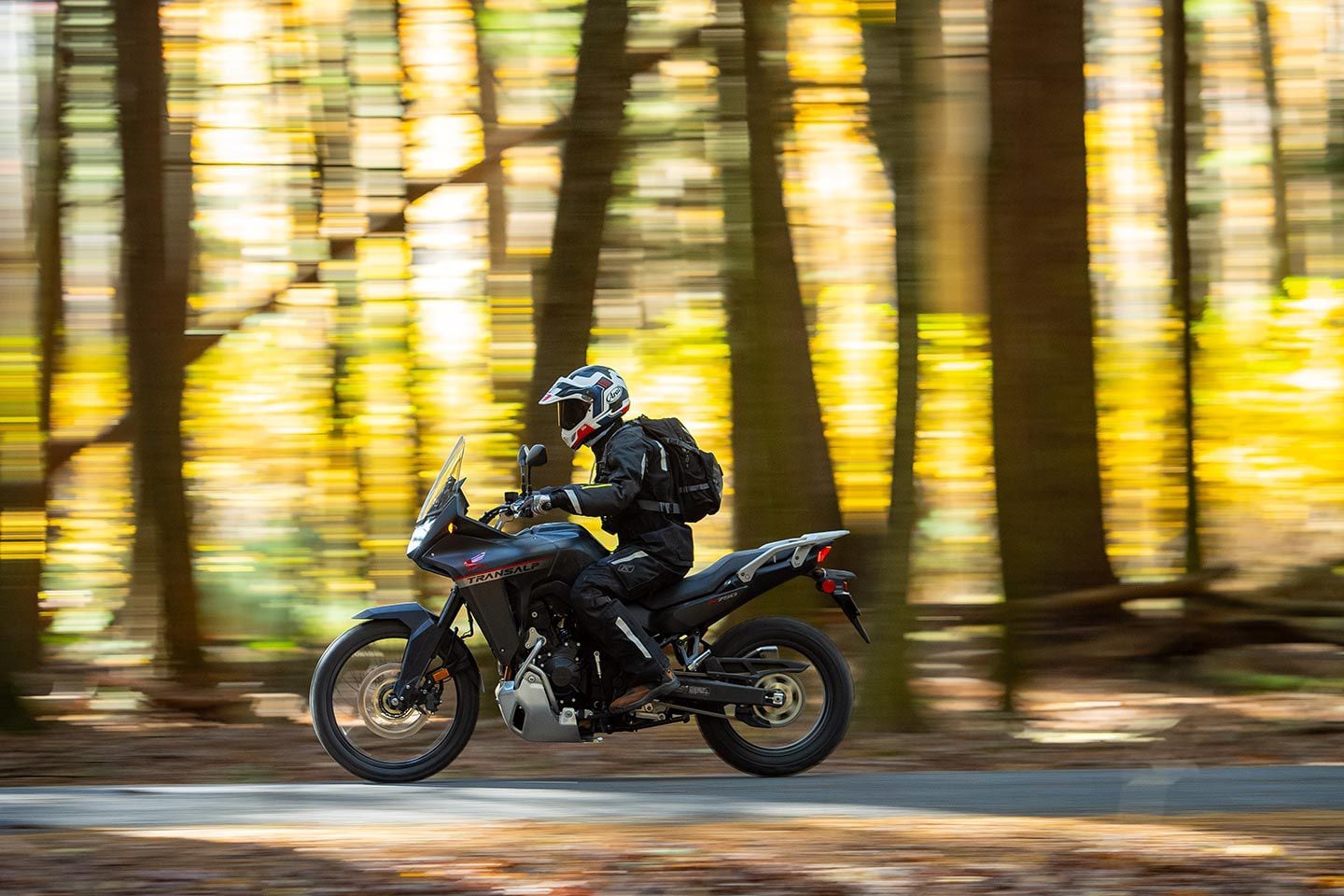
Neutral ergonomics and well-designed wind protection make the Transalp comfortable all day. (Honda/)The Honda Transalp’s neutral riding position and excellent wind protection make for a great touring package. Our test unit was fitted with the Honda Accessories heated grips, further increasing comfort levels on long stretches of pavement. To make the 2024 Transalp a serious long-distance tourer, cruise control is a must. Unfortunately, Honda does not offer any solutions in its accessories catalog.
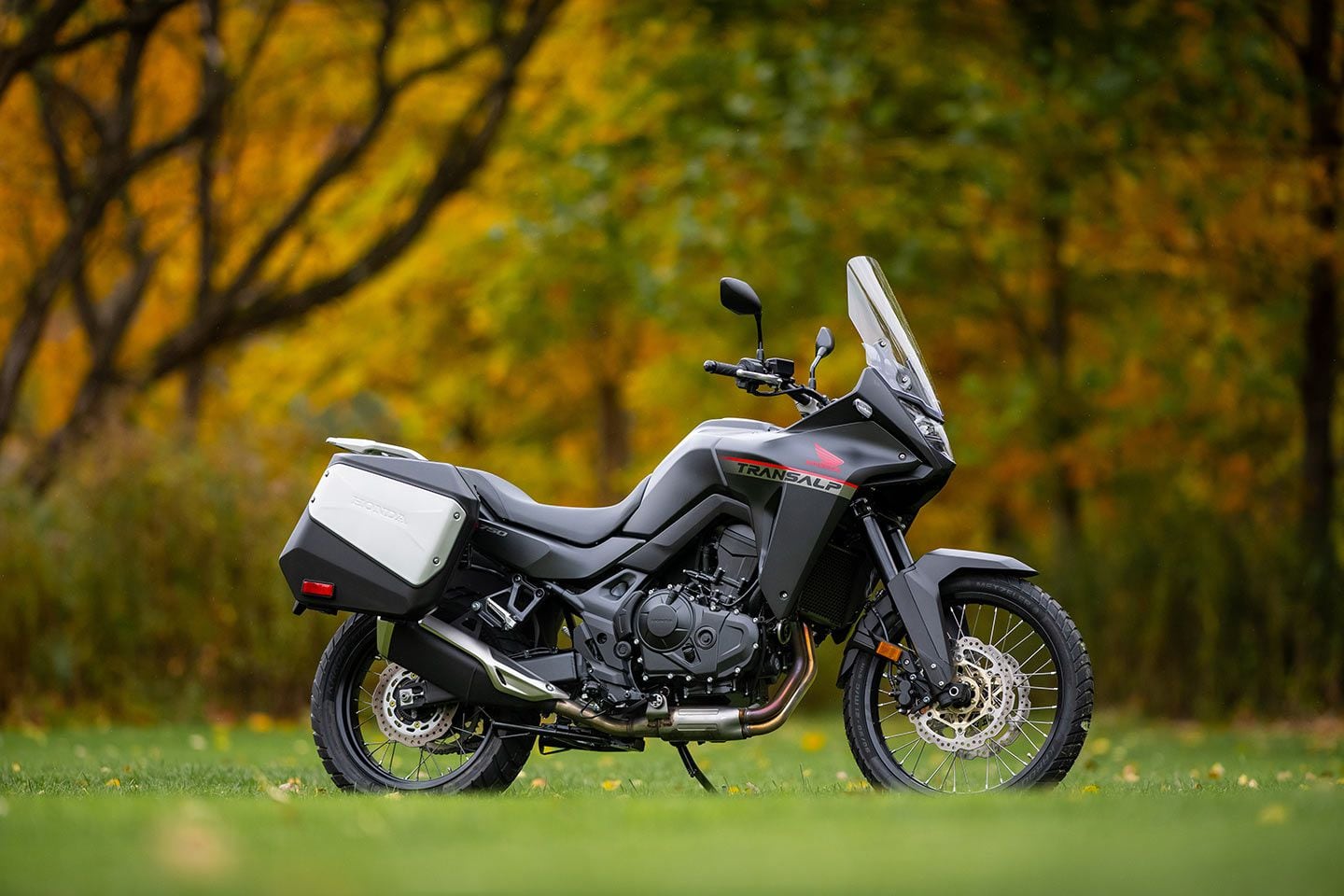
The 2024 Honda Transalp fitted with factory accessories. (Honda/)2024 Honda Transalp Accessories
The 2024 Honda Transalp is available in four variants: Adventure, Touring, Comfort, and City, as well as the base model. This allows customers and dealers to choose the Transalp with the features that fit their needs. All of Honda’s accessories are compatible with the standard Transalp including, heated grips, pannier cases, radiator grille, upper fairing guard, engine guard, skid plate, hand guards, enduro footpegs, tank bag, 12-volt accessory socket, windscreen and fairing deflectors, passenger footpegs, tall windscreen, centerstand, top case, and a low seat.
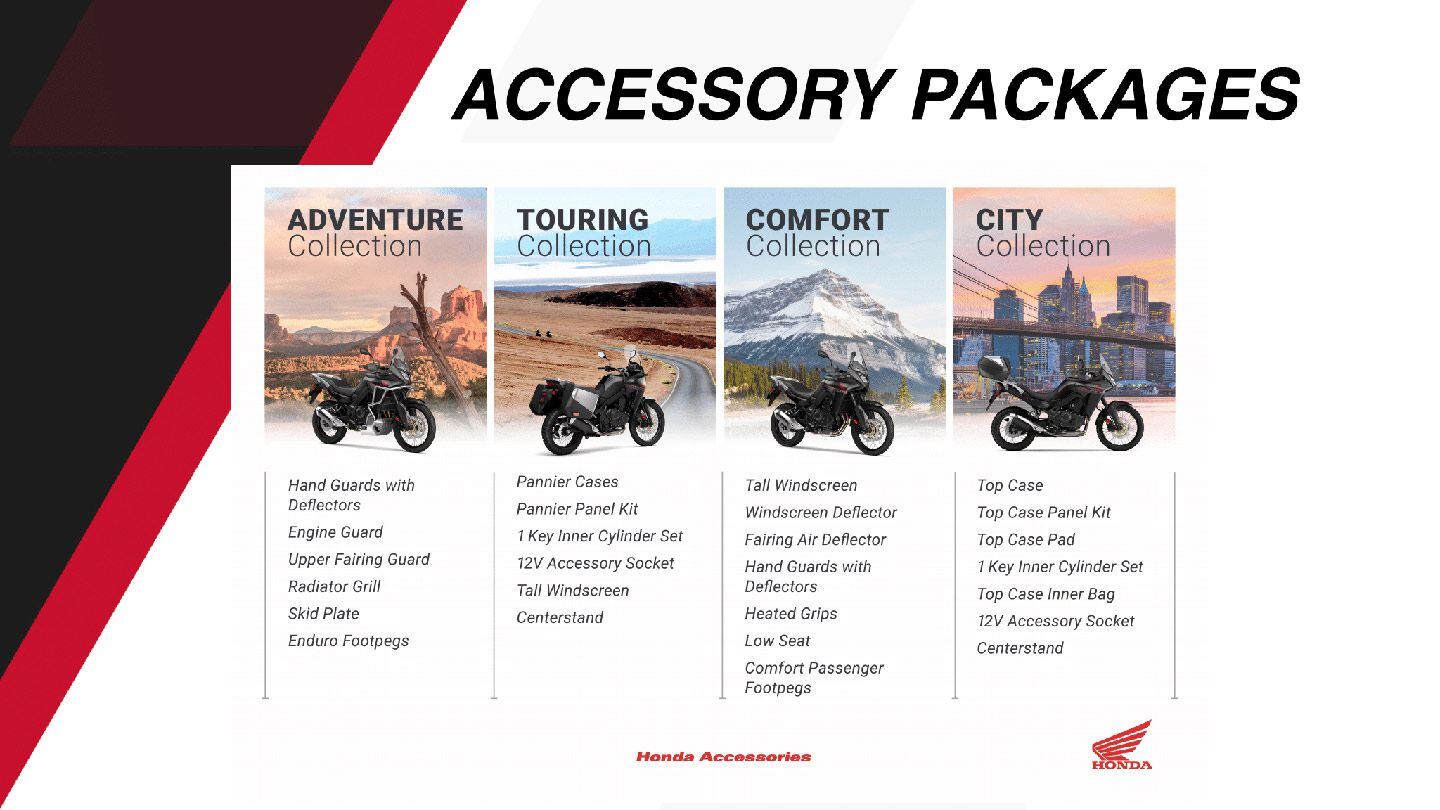
The 2024 Honda Transalp is available in four accessory packages. (Honda/)Conclusion
Bringing back a name that became a cult classic long after its removal from sales floors, Honda designed the Transalp to be a jack of all trades. Striking a balance between off-road performance and on-road comfort, the 2024 Honda Transalp is an accessible, well-rounded middleweight ADV. A smooth, yet exciting engine, comfortable ergonomics, balanced suspension, and adjustable electronics make it capable in almost any condition. It may not be the best at one particular thing, but the all-new machine will do everything well. For $9,999, the Transalp offers premium fit and finish, the promise of Ride Red reliability, all-road performance, and adjustable electronics. But are these features enough to keep the Transalp in the US for good? Absolutely; the 2024 Honda Transalp offers nearly everything an adventure rider needs at an accessible price.
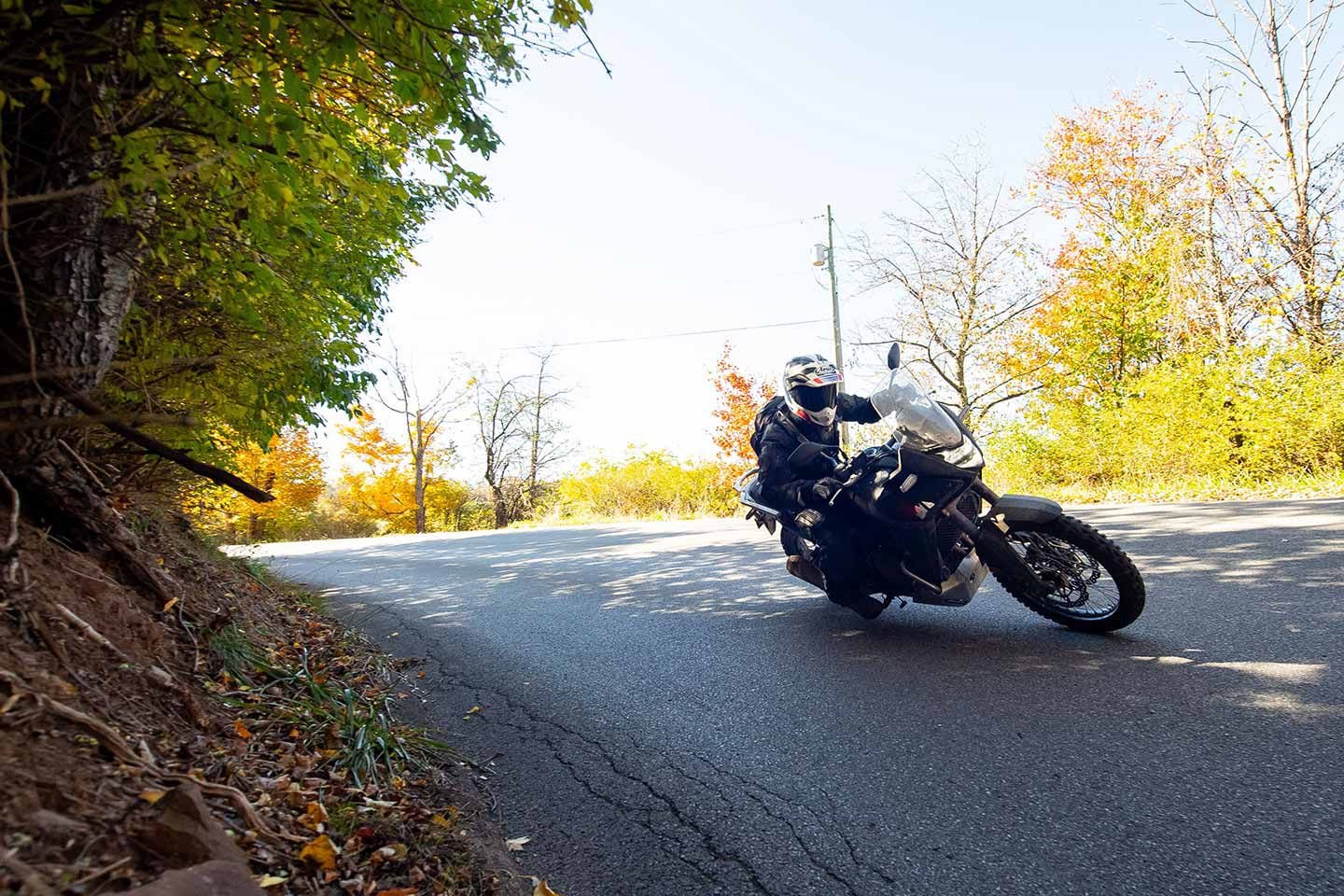
When the roads get twisty, the Transalp is a great sport-tourer. (Honda/)2024 Honda Transalp Specs
MSRP: $9,999 Engine: SOHC Unicam, liquid-cooled, four-stroke parallel-twin; 4 valves/cyl. Displacement: 755cc Bore x Stroke: 87.0 x 63.5mm Compression Ratio: 11.0:1 Transmission/Drive: Manual 6-speed/chain Claimed Horsepower: 83 hp @ 8,500 rpm Claimed Torque: 55 lb.-ft. @ 9,500 rpm Fuel System: PGM-FI w/ 46mm throttle bodies Clutch: Wet, multiplate Engine Management/Ignition: Full transistorized Frame: Lightweight steel diamond Front Suspension: 43mm Showa SFF-CA telescopic inverted fork, spring-preload adjustable; 7.9 in. travel Rear Suspension: Pro-Link system w/ single Showa remote-reservoir shock, preload adjustable; 7.5 in. travel Front Brake: Hydraulic 2-piston calipers, dual 310mm wave discs w/ ABS Rear Brake: Hydraulic 1-piston caliper, 256mm wave disc w/ ABS Wheels, Front/Rear: 21 in./18 in. Tires, Front/Rear: Bridgestone Battlax Adventure Trail ATT41 (as tested); 90/90-21 / 150/70-18 Rake/Trail: 27.0°/4.4 in. Wheelbase: 61.5 in. Ground Clearance: 8.3 in. Seat Height: 33.7 in. Tank Capacity: 4.5 gal. Claimed Curb Weight: 459 lb. Availability: Now Contact: powersports.honda.com Gearbox
Helmet: Arai XD4
Jacket: Klim Badlands Pro
Pants: Klim Badlands Pro
Gloves: Klim Badlands GTX Long Glove
Boots: Alpinestars Corozal Adventure Drystar Oiled Leather
Backpack: Klim Arsenal 15
-
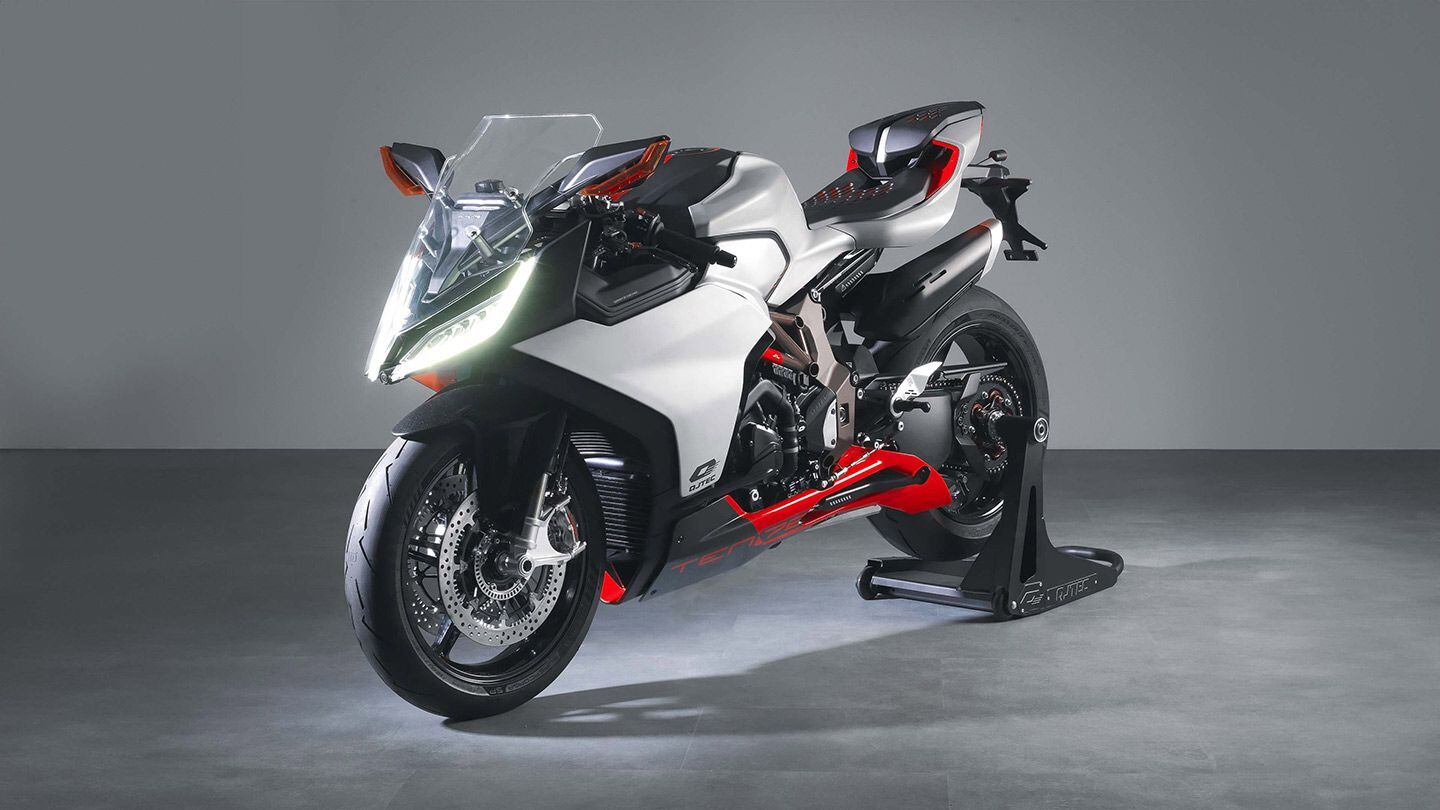
China’s latest superbike prototype is QJMotor’s SRK1000RC Ten78 (QJMotor/)QJMotor is among the companies vying to become the first Chinese brand to offer a truly modern superbike and it’s taken a step closer to that goal with the SRK1000RC Ten78—a near-production concept unveiled at Milan’s EICMA show.
The Italian unveiling is fitting as the Ten78′s heritage is as much Italian as Chinese, perhaps even more so, as it packs MV Agusta’s old-generation 1,078cc engine—hence the Ten78 name—in an MV-like part-steel, part-aluminum chassis with a single-sided swingarm.
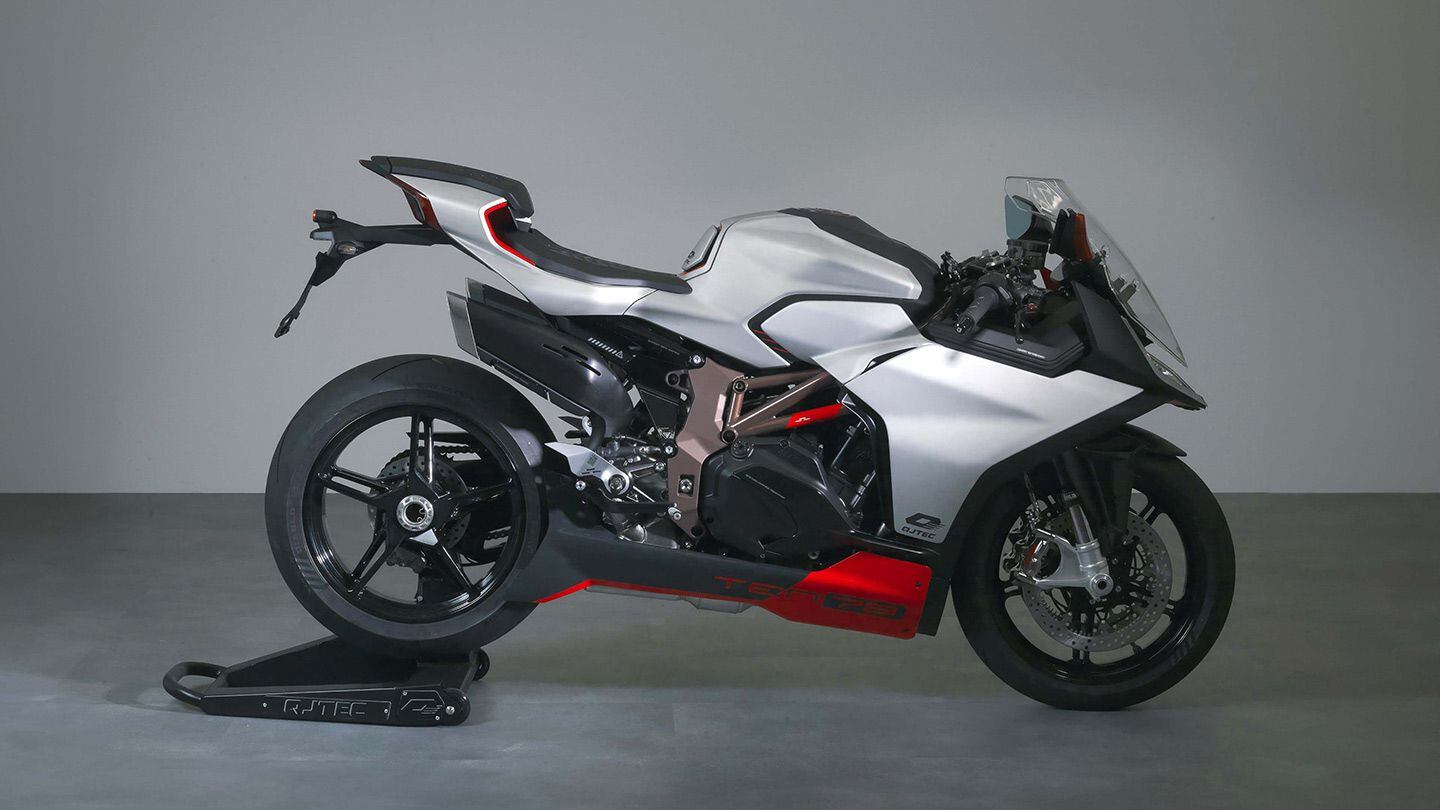
The SRK1000RC Ten78 prototype uses exhausts that are neither under the seat or side mounted. (QJMotor/)Even the styling—which is sure to be a conversation piece even if it’s not universally loved—comes from Italy. It’s the work of C Creative, a design studio set up by former MV Agusta design director Adrian Morton, a British prodigy of Massimo Tamburini. His résumé also includes the Benelli Tornado Tre and TNT 1130, as well as recent MVs including the F3, Turismo Veloce, Brutale 1000, Superveloce 800, and Rush 1000.
With the Ten78, Morton’s team has clearly opted for a design that distances itself from the MV Agusta elements underneath, notably with the unusual frontal shapes focused on a pair of headlights that jut forward beneath a transparent screen that makes up most of the front bodywork. It might not be conventionally pretty, but it’s a design that helps address the common complaints of Chinese companies lacking innovation or originality in their styling.
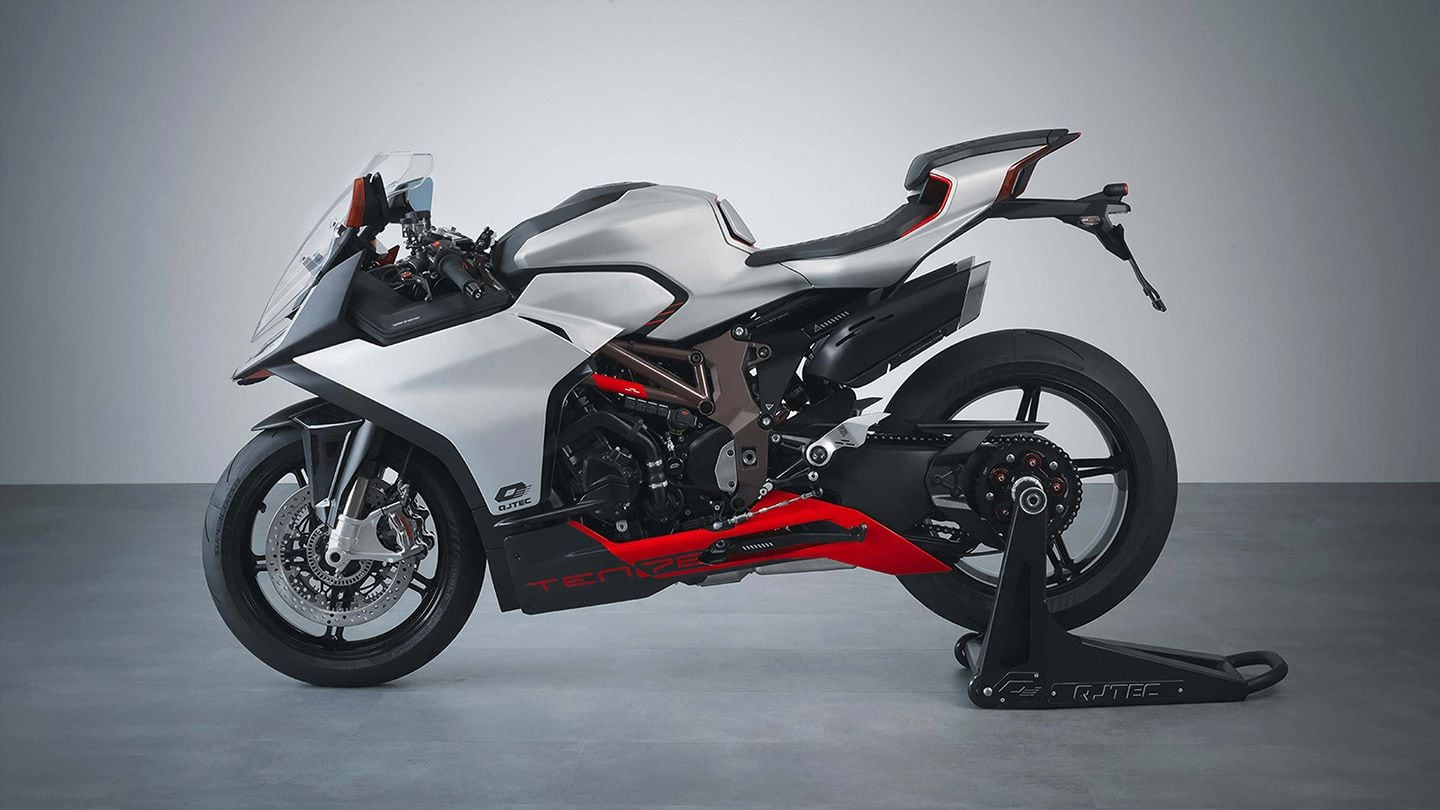
Left-side view of the SRK1000RC Ten78. (QJMotor/)Further back, things get more conventional, though the side panels that cut back into the fuel tank and the long bellypan that extends around the leading edge of the rear tire are departures from the superbike norm. The same applies to the two mid-level exhausts, which are neither “underseat” nor side-mounted, instead hanging somewhere between those two positions.
Mechanically, the bike centers on MV Agusta’s old 1,078cc inline-four engine, the final evolution of the original F4 motor before it was replaced by the all-new 998cc four used in the current Brutale 1000. In the QJMotor model, the engine is tuned for a restrained 144 hp—far less than it managed in its ultimate form for MV Agusta, and an interesting clue to the bike’s production future. After all, if this was just a concept, never to progress to showrooms, why not claim a much higher power figure?
The number QJMotor has settled on is a realistic figure for an older four-cylinder superbike engine that’s been retuned to meet modern emissions standards. Just look at the Fireblade-derived four in the Honda CB1000R, for example, or the GSX-R1000-based unit in the Suzuki GSX-S1000, which both achieve similar power figures in the 140-to-150 hp range.
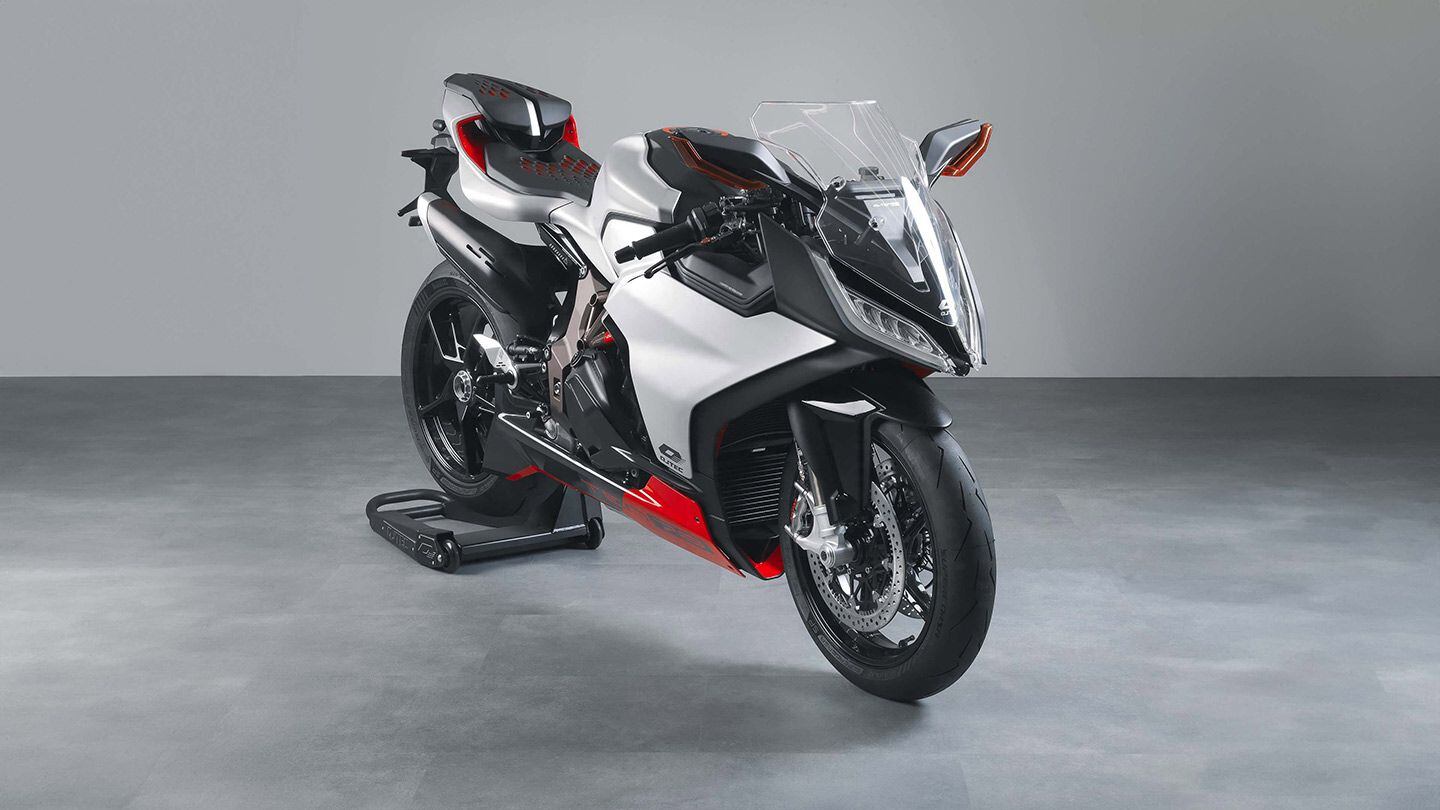
The prototype currently uses Öhlins suspension, but will likely run Marzocchi if it goes to production, as QJMoto has a partnership with that Italian brand. (QJMotor/)That engine sits in a frame that looks very much like an MV Agusta unit but is, in fact, purpose-made for the Ten78. The same applies to the single-sided swingarm. Both are different to the parts used on the QJMotor SRK900RR, which we’ve seen before but also appeared at EICMA, and is built around a less powerful 128 hp, 921cc version of the same, old-generation MV Agusta four-cylinder engine mounted in a chassis that also appears to come directly from the Italian company, wrapped in more conventional superbike styling than the Ten78′s futuristic design.
For the rest of the running gear the Ten78 opts for the superbike staples of Öhlins suspension and Brembo brakes, though should the bike reach production it’s likely that Marzocchi suspension will be used, since QJMotor and Marzocchi are already manufacturing partners.
Technical details of the Ten78 include a 56.1-inch wheelbase and 17-inch wheels with 120/70 rubber at the front and a wide 190-section rear. Weight comes in at 437 pounds including a full tank of fuel. There’s no definitive timescale on when the prototype is likely to spawn a production derivative, but the fact it made its debut in Europe rather than China is a clear indication that QJMotor has global intentions for the machine and the brand going forward.
-
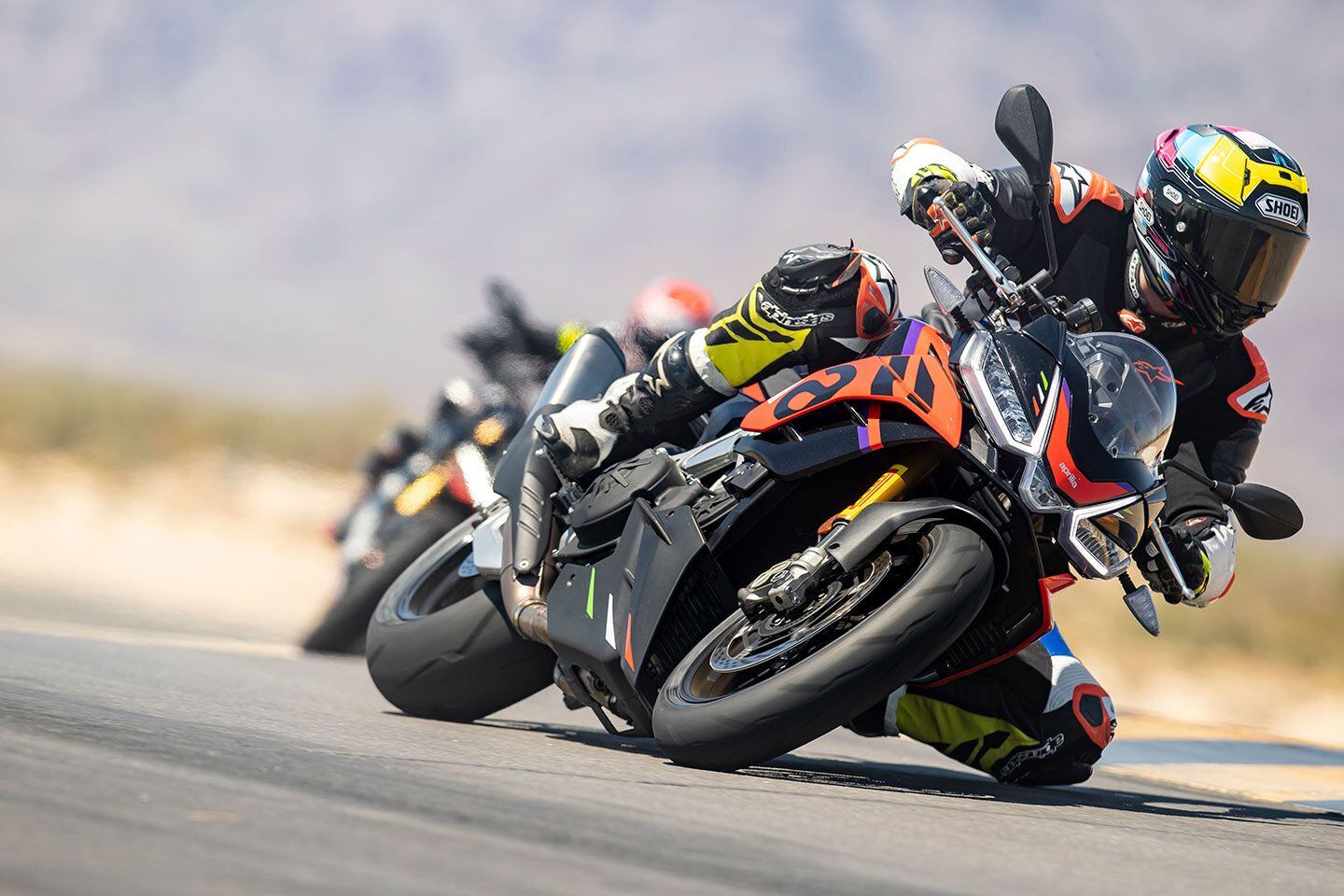
Pirelli’s new Diablo Supercorsa SP - V4 provided amazing performance over two days of testing, both on the track at a 110-degree day at Chuckwalla Valley Raceway and then on the street two days later. (Jeff Allen/)The promise of high-performance sportbike tires is that they can provide excellent performance for all conditions when riding on public roads, and then be able to slay asphalt within the confines of a racetrack at a trackday. There are a lot of tires on the market that make that claim, some do it better than others, but our recent experience with Pirelli’s Diablo Supercorsa SP - V4 proves that the Italian company delivers on that promise.
Like so much of motorcycling, tire technology is advancing at a ridiculous pace. And to be honest, it had to. The ever-rising performance of sportbikes in particular has meant that tire companies have had to keep pace, or even stay ahead of the horsepower race.
According to Pirelli’s motorcycle product manager Silvio Frare, “The gap between the hypersport bikes that you can buy and racebikes has become much closer over the years. In some cases there is only a 40-to-50 horsepower difference between the two. It’s way closer than what it was in the past, and yet the motorcycle manufacturers keep making more and more powerful motorcycles. We are very close to the 1 horsepower per kilogram level.”
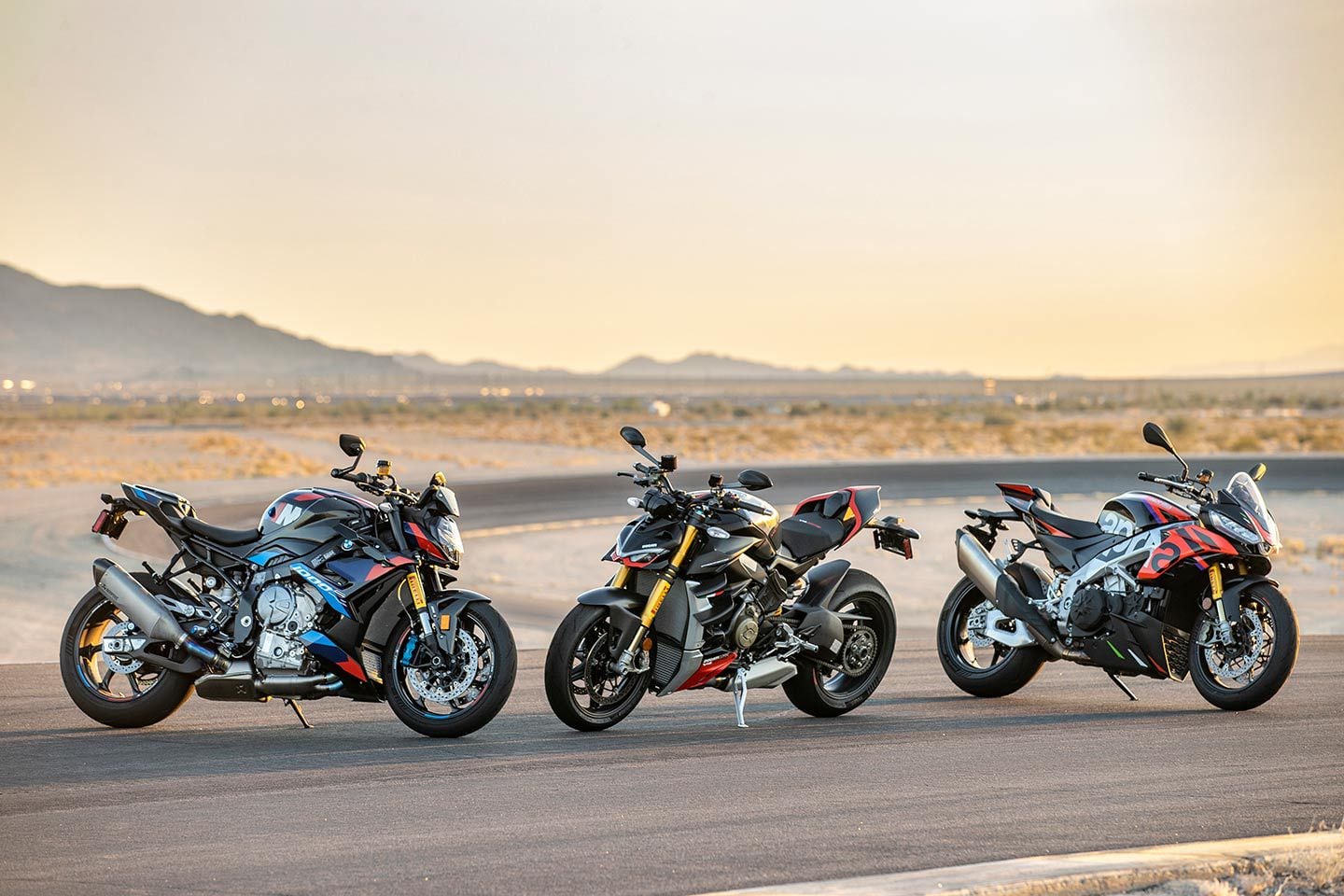
Chuckwalla Valley Raceway in June is about as challenging a test for tires as there is. (Jeff Allen/)In Part 2 of our recent 2023 Hyper-naked Comparison, two of the bikes tested produced amazing levels of power, including the winning 173-hp Ducati Streetfighter V4 SP2 and the 185-hp BMW M 1000 R. That’s rear-wheel power measured on the Cycle World dyno, not manufacturer’s claimed crankshaft power.
Due to time constraints, our testing on the racetrack would take place prior to the bulk of our street testing, and have to be conducted on the same set of tires for each bike. The potential problem was that the track portion was in late June at Chuckwalla Valley Raceway outside of Palm Springs, California, with ambient air temperatures hovering around 110 degrees in the middle of the day. Could the tires possibly survive such a torture test and still be roadworthy?
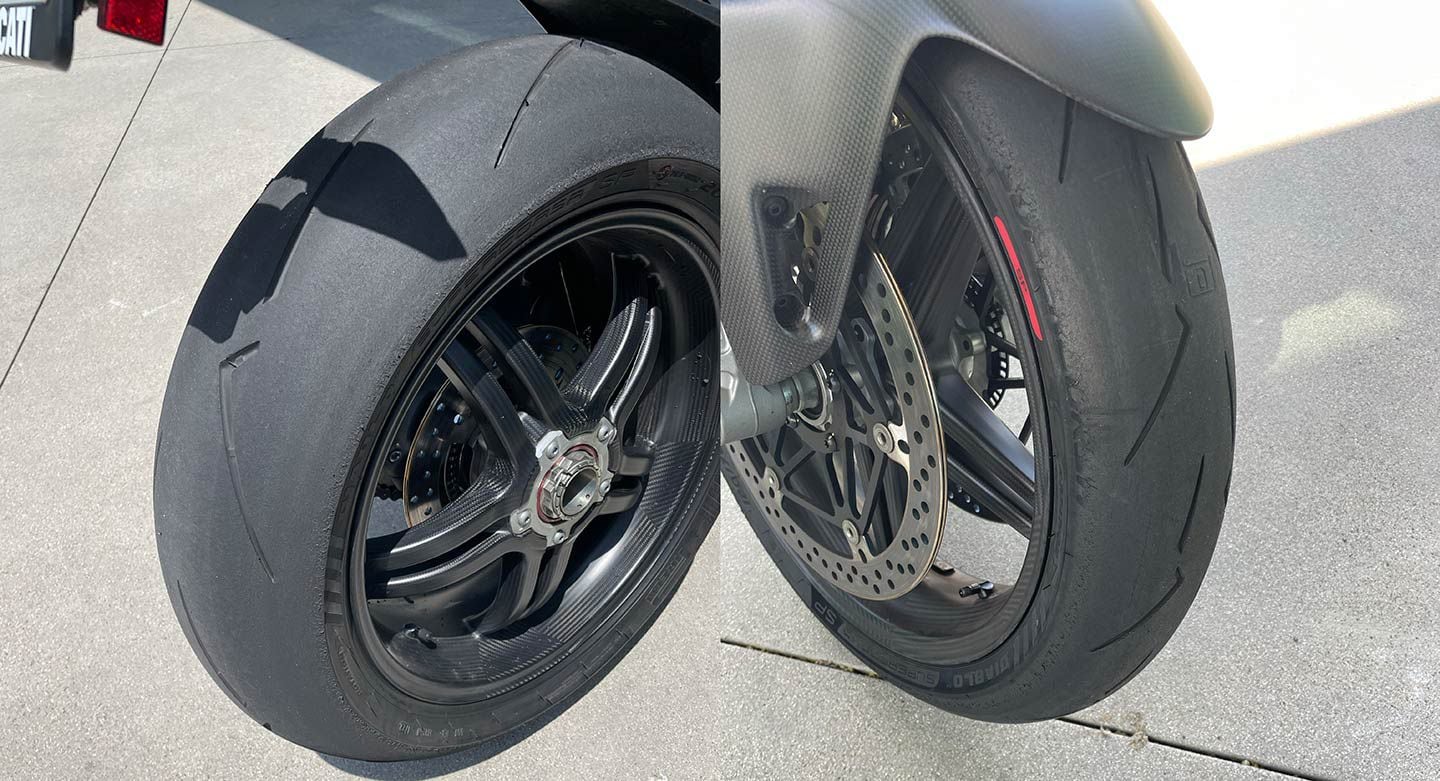
At the end of our day at Chuckwalla Valley Raceway, the Supercorsa SP - V4s on the 173-hp Ducati Streetfighter V4 SP2 looked amazingly good. (Blake Conner/)Our testing at Chuckwalla included three riders lapping all day for impressions and photos, and then going for some quick laps at the end of the day. On the track we ran Pirelli’s recommended hot tire pressures of 33 psi front and 30 psi rear, and checked them throughout the day to make sure they were accurate. According to Frare, one of the design goals, in part because it’s a street tire, is that “with the SC3 compound on the shoulders you do not need tire warmers at the track.”
From our perspective, performance was very impressive, offering that promised quick warmup, very neutral and predictable handling characteristics, and consistent grip throughout the day. Due to timing at the track we had to wait until the very end of the day before letting Bradley Adams loose to rip off some quick timed laps. The Supercorsa SP - V4s weren’t bothered by this in the least, providing excellent performance even after a ton of laps earlier in the day.
When we wrapped up our riding, we estimated that each motorcycle did a minimum of 45 laps between the three of us. So we were shocked at how good all three sets of V4s looked when we concluded the track test. An interesting side note is that Chuckwalla is pretty abrasive on knee sliders, with Adams smoking through them in short order, so our curiosity was raised as to how the tires survived with minimal signs of graining on the surface, looking as if they not only had more than enough life left for the street, but could have easily tackled another day at the track. Remember, we’re talking about bikes making in excess of 170 hp at the rear wheel.
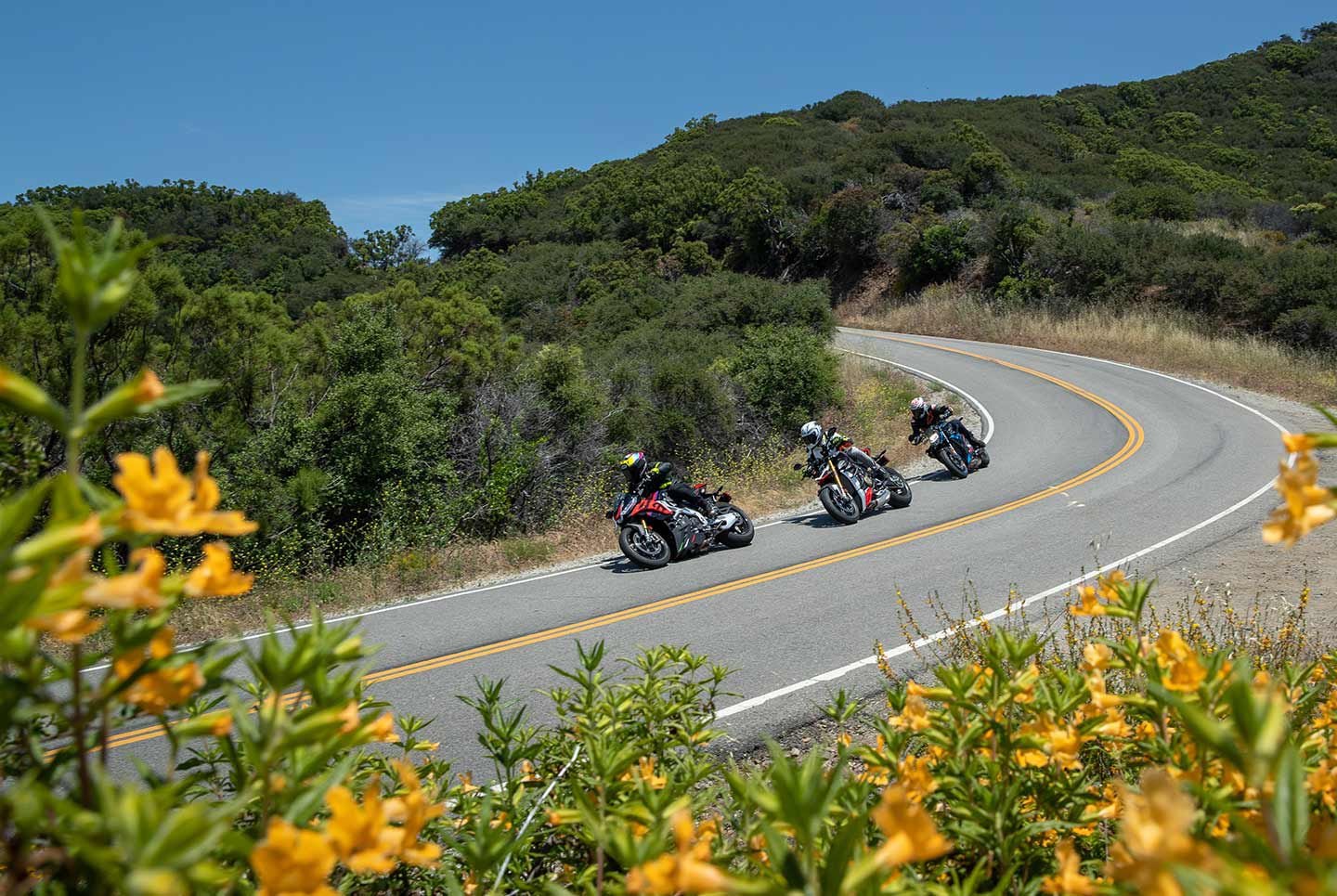
Due to timing restraints, we needed to conduct our street testing after our trackday; the Pirellis did not disappoint and provided excellent performance with the tire pressures adjusted to the recommended pressures suggested by the respective OEs. (Kevin Wing/)For our street ride two days later we used the tire pressures recommended by the motorcycle manufacturers for their respective machines. For example, BMW recommends cold pressures of 36.3 psi front and 42.1 psi rear for the M 1000 R. In the canyons of Malibu, California, the tires again performed flawlessly, offering excellent grip throughout our day of testing. Steering remained neutral and predictable with no real change compared to the stock tires that all three machines were delivered with. After all of the heat cycling and laps from the track day, the V4s didn’t show any signs of reduced performance.
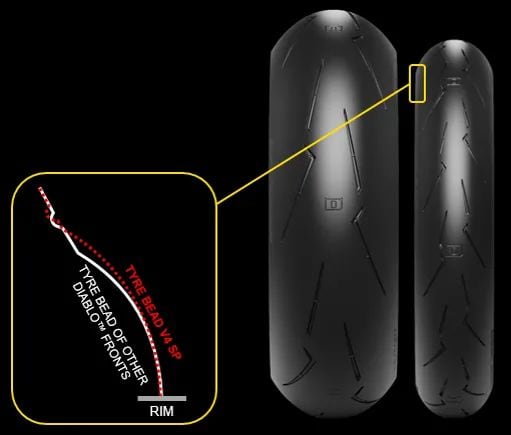
This illustration shows how the SP - V4 differs from other Supercorsas in Pirelli’s range. (Pirelli/)A look at the tire’s structure reveals it’s based on a profile derived from Pirelli’s World Superbike tires and uses the same materials as the Diablo Superbike slicks, but the construction is optimized for the improved stability necessary on road. “For the V4 we’ve had to blend our SC and road technology,” Frare said. “For example, to be able to use road pressures on the road and use racetrack pressures on the track. For this reason specifically, the SP and SC bead structures are quite different, because the SP has been designed with both of the specificities in mind. It’s a reinforced sidewall that can perform equally well at road pressures and racetrack pressures.
“The SP versions must be compliant with EU, DOT, and other regulations,” Frare added. “But the starting point is from the SC racing range, then we use all of our expertise from our road applications and make the best-performing street tire we can make.”
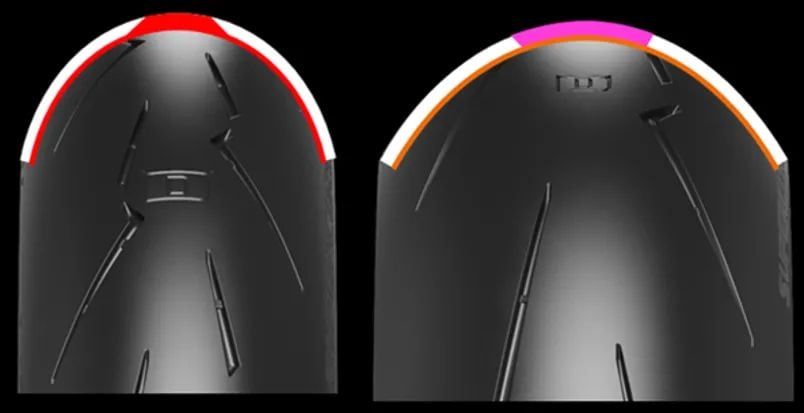
Pirelli’s Supercorsa SP - V4 uses dual compounds front and rear, but the rear has a dedicated base layer. (Pirelli/)Both the front and rear tires are dual-compound but have different construction. The front has what Pirelli calls a Dual-Compound Cap and Base Layout, with the center tread designed for high-speed stability and braking stress, while the base layer offers thermal stability. On the shoulders is the Racing SC3 compound. The rear has a dual-compound construction that has a dedicated base layer for better thermal stability. The Racing SC3 compound is employed on the shoulders with a harder and more durable compound used down the center.
It is this structure that helps give the SP - V4 its durability. It provides the tire with the ability to manage heat, which is ultimately the enemy of tire life. “The ability of the compounds to withstand abrasion has improved a lot in recent years,” Frare said. “A big factor is our ability to optimize the shape of the tire’s profile. With modern bikes’ lean angles reaching 55, 58, 60 degrees, if you can finely tune the amount of rubber that is on the road when you are at maximum throttle, the more trust the rider will have in grip, but also the tire will provide more durability.”
“Racing is a tool of development and we use the information gained to build the tires for the road that will provide the customer with the most satisfaction,” added Salvo Pennisi, head of moto and cycling testing. “With such powerful production motorcycles, the development of compounds and construction for racing and the road have been developed in parallel.”
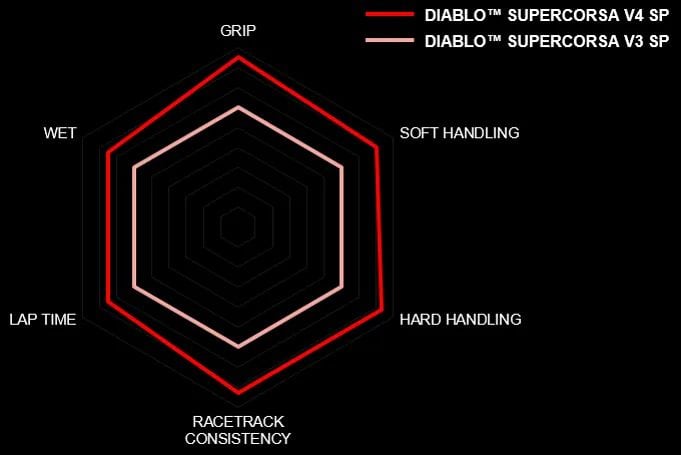
If you believe the marketing-speak, the SP - V4 is better in every regard compared to its predecessor. (Pirelli/)Every tire manufacturer out there delivers a load of marketing-speak to convince us that its product is the best. But it’s really refreshing when the actual performance of the product handily exceeds the expectation. In the case of Pirelli’s Diablo Supercorsa SP - V4, we ended up not only very impressed by their durability, but the grip proved to be excellent and consistent both on track and on the road. We also felt that the tires complemented the handling characteristics of the bikes we were testing and enabled us to get the best possible performance out of each machine.
The fact that the tires also saved us the hassle of having to switch all the machines back to their original OE tires for street testing was simply the icing on the cake. The Diablo Supercorsa SP - V4 is ultimately everything that Pirelli promises and more, a tire fully capable of serving double duty as a high-performance street and trackday tire.
Available Sizes
Pirelli Diablo Supercorsa SP - V4
- 110/70-17 (front)
- 120/70-17 (front)
- 140/17-17 (rear)
- 150/60-17 (rear)
- 180/55-17 (rear)
- 180/60-17 (rear)
- 190/50-17 (rear)
- 190/55-17 (rear)
- 200/55-17 (rear)
- 200/60-17 (rear)
-

The 2024 Ducati Hypermotard 698 Mono was just named the Most Beautiful Bike at EICMA 2023, but we still can’t wait to get it dirty. (Ducati/)The debuts have been unwrapped, the concepts have been unveiled, and the updates announced, and now EICMA 2023, the world’s largest motorcycle show, is in the books. After stressing on the thin crowds of last year’s pandemic-plagued event, it was heartening to see hundreds of thousands of visitors pack the 2023 show in Milan, and the new hardware on display wasn’t too shabby either, with everything from a 200-plus horsepower MotoGP-derived superbike to a single-cylinder supermoto on steroids to keep us drooling in anticipation. It’s now time for another year of testing the new beasts, but there are five we’re especially keen to throw a leg over and see if they live up to the pre-release hype. It’s probably no surprise that Ducati, Honda, and KTM all made the cut here, but of course, five models are just a drop in the bucket, so be sure to tell us your pick in the comments.
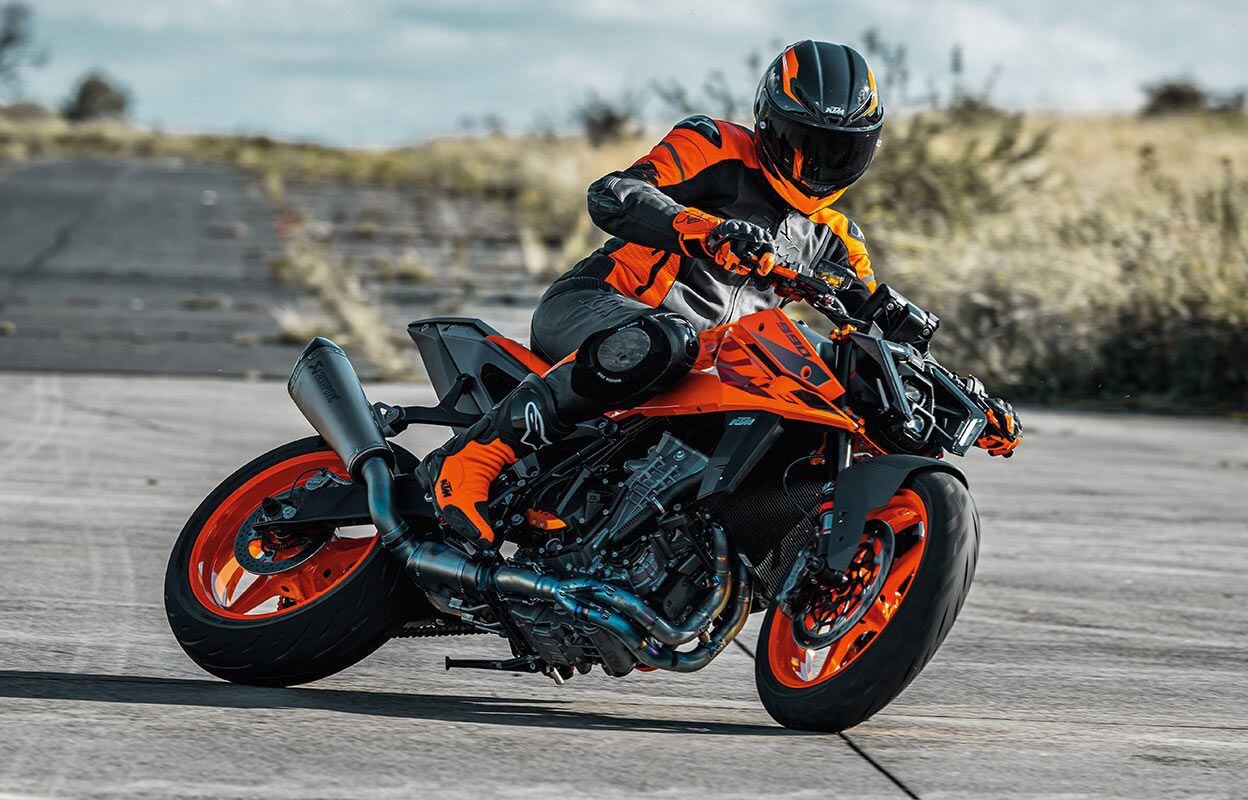
Pay no attention to the weird new alien fascia; KTM’s new 990 Duke promises to be a real hoot in the wheelie department. (KTM/)In the wake of the 890 Duke R’s bona fide success, we shouldn’t be too shocked to see KTM roll out a new 990 Duke from the shadows. Dubbed the “Super Sniper,” the naked bike formally known as the 2024 990 Duke comes ready to party with a reworked 947cc twin-cylinder LC8c engine packed into a new frame, with the same robust, adjustable WP Apex suspension and updated electronics package we’re used to seeing from KTM. That engine puts out a claimed 123 hp and 76 lb.-ft. of torque, which is only a bit more than the 890, but the new chassis and lightweight aluminum subframe promise improved agility and even sharper handling. And with KTM claiming this is “the lightest, sharpest, most performance focused mid-class naked possible,” why wouldn’t we want to jump on? Even if that new insectoid-like face isn’t exactly our cup of tea…
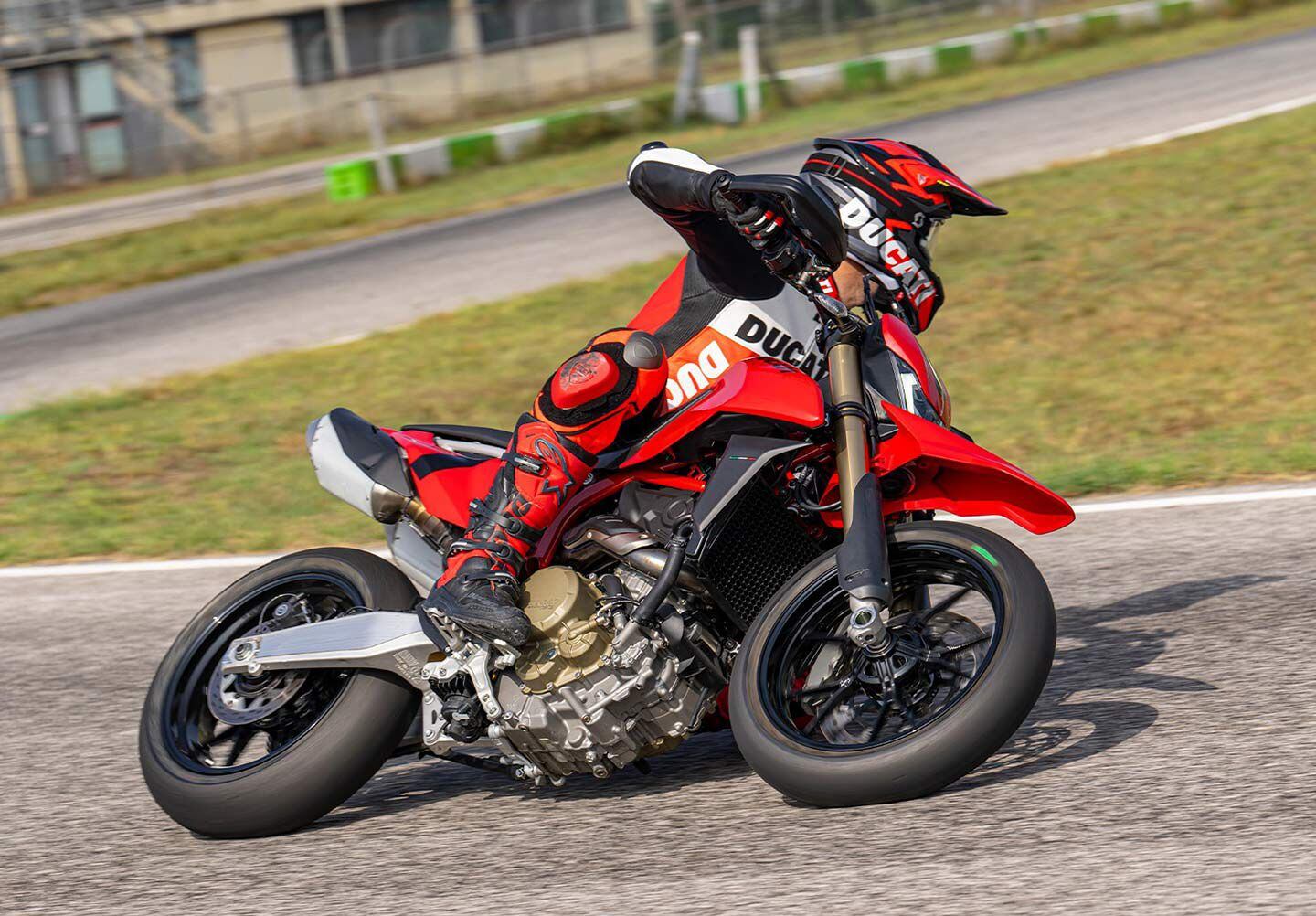
A supermoto on steroids (and Botox): meet the new 2024 Ducati Hypermotard 698. (Ducati/)It’s not for nothing that Ducati’s Hypermotard 698 Mono RVE was voted Most Beautiful Motorcycle at EICMA 2023, a verdict handed down last week by the show-going public. Ducati may have surprised a lot of us with the single-cylinder format on the new 698 but the all-new Superquadro engine (see Kevin Cameron’s take here), derived from the 1299 Panigale V2 and doling out a healthy 77 hp, should be no slouch. That’s on a 340-pound machine too, so it’ll feel all kinds of punchy, we’re thinking. The lovely, spindly style flows motardlike through five-spoke wheels and a high front fender, with a wide handlebar, flat seat, and upswept exhausts to carry the theme. There’s a standard and RVE version available; sign us up for the latter. Can’t wait to ride this one.
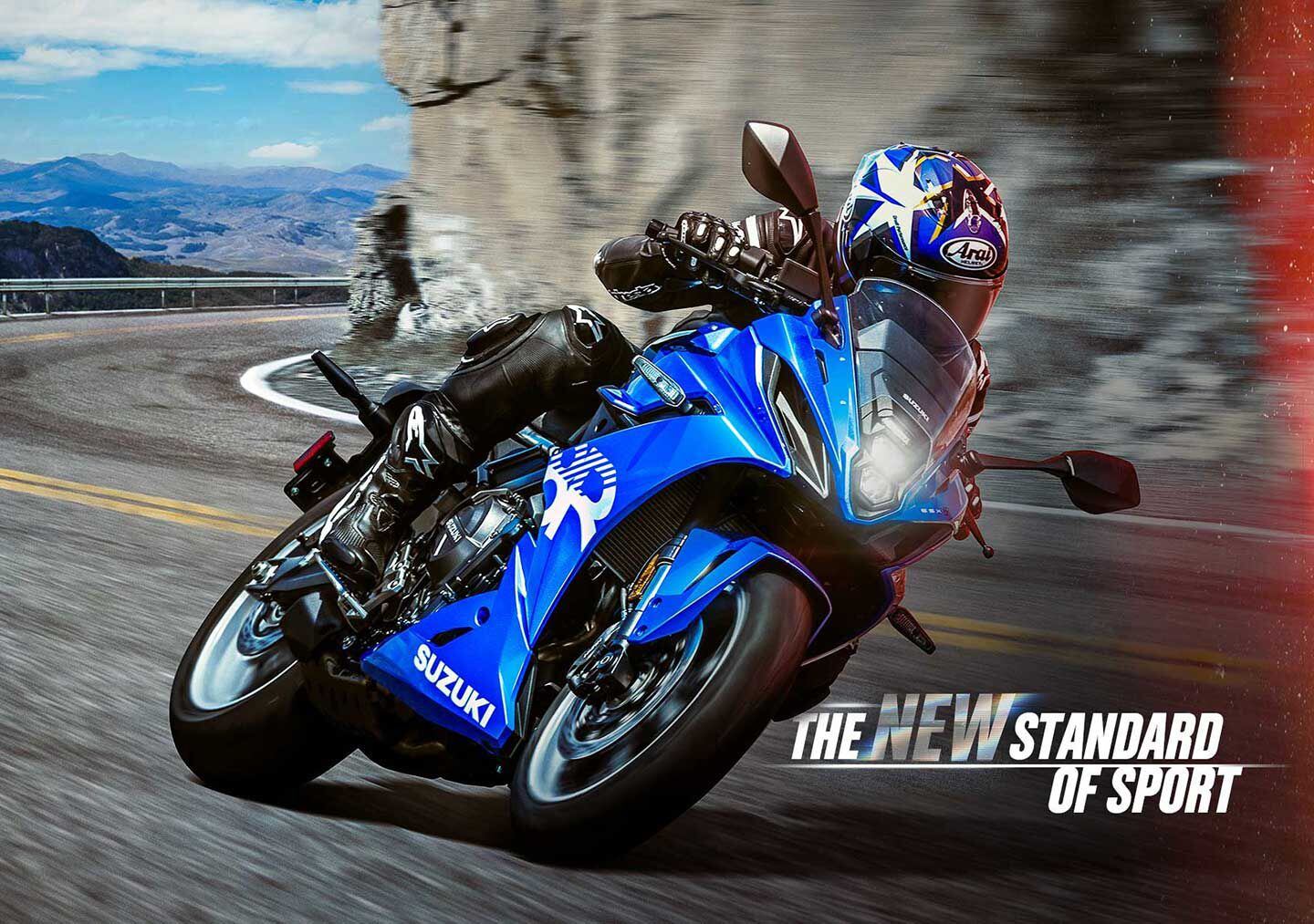
The new Suzuki GSX-8R promises all-around affordability in a sporting middleweight package. (Suzuki/)Hot on the heels of Suzuki’s new GSX-8S comes the sportier, fully faired version of that naked machine, officially unveiled at EICMA in Milan as a 2024 model. The GSX-8R
carries over many of the same components seen on the 8S, but in a sportier, fully faired package that adds improved suspension components and a revised riding position. Suzuki’s new-gen 776cc parallel-twin engine is unchanged here (retaining the same 81 hp), but the 8R’s streamlined fairing, forged aluminum handlebars, and upside-down Showa SFF-BP fork should give it a pronounced handling boost over its brother, with more tucked-in ergonomics to boot. On the other hand you get the same ride-by-wire system with three riding modes, three-level adjustable and switchable traction control, and a two-way quickshifter as the 8S, so it’s not an earthshaking change. Still, we can’t wait for a three-way throwdown with the Honda CBR650R and the Yamaha R7.
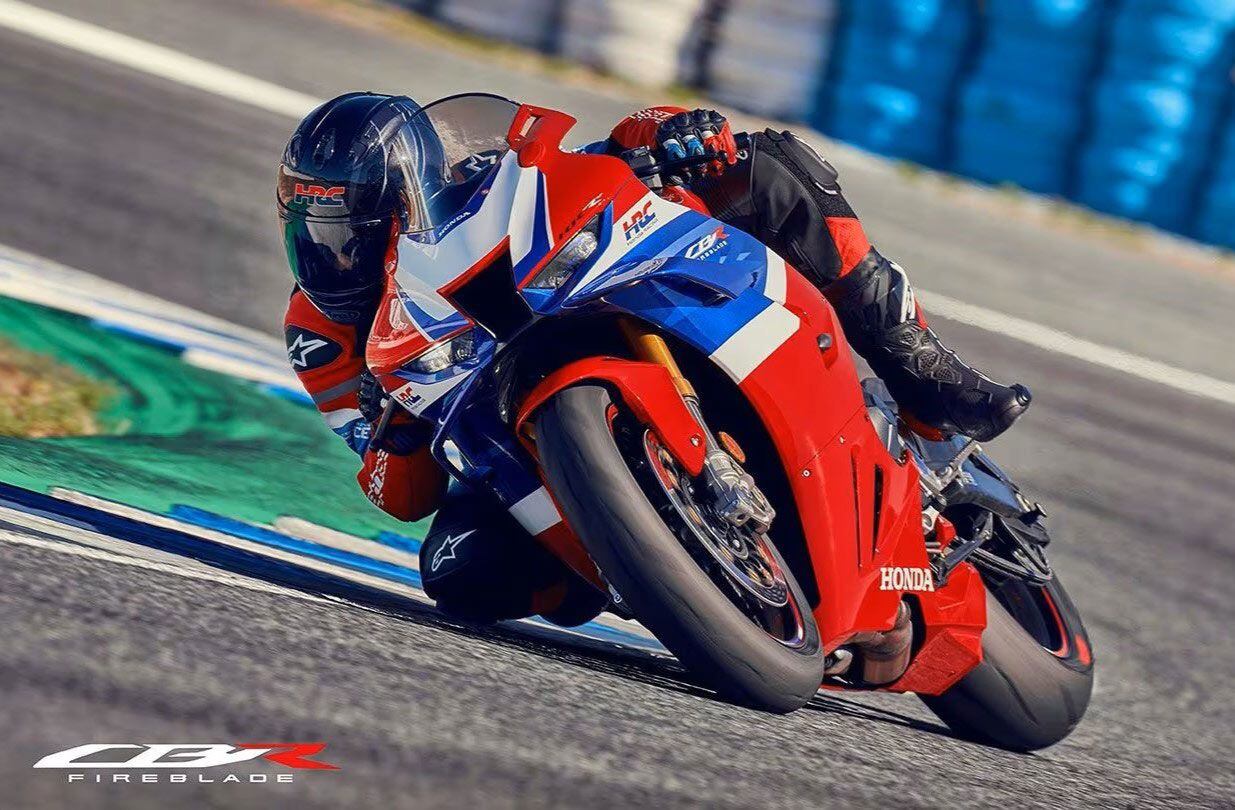
Honda’s MotoGP-derived flagship ups the ante with improvements to the chassis, suspension, and brakes, and a still astounding 215 hp in 2024. (Honda/)2024 Honda CBR1000RR-R
As expected, Honda unveiled a slightly improved 2024 CBR1000RR-R SP at EICMA last week, and though peak power is unchanged, both the engine and the chassis received a host of improvements derived from the brand’s RC213V MotoGP machine. That makes for what Honda says is the most powerful CBR yet, with “unprecedented levels of track-focused performance.” We’re talking a peak of 215 hp at 14,500 rpm and peak torque of 83.3 lb.-ft, at 12,500 rpm thanks to a new cylinder head with increased compression, all said to result in midrange performance boost improvements and improved throttle response.
The SP version of the CBR1000RR-R Fireblade is the first bike in the world to use the new, third-generation Öhlins Smart Electronic 43mm NPX USD fork, and Honda promises better corner acceleration thanks to revisions in the frame, electronics, and aerodynamic wings. Make all the pirate jokes you want, we’re still stoked to do some laps on the newest ‘Blade.
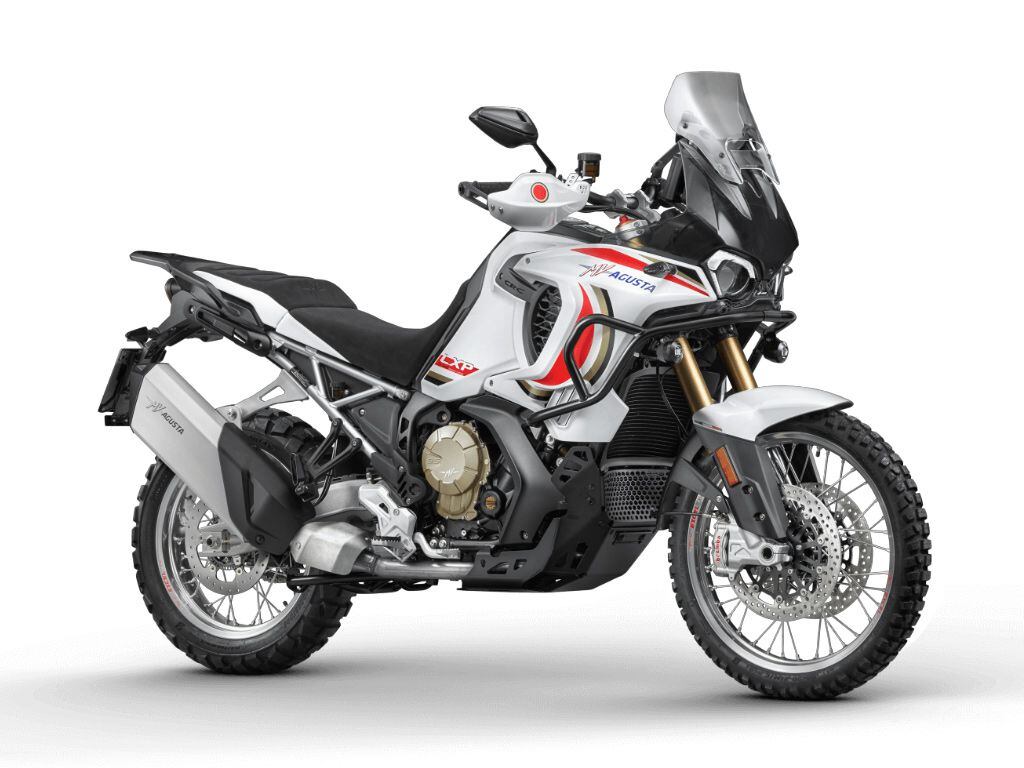
MV’s first all-new model in years, and first full-size ADV comes in the form of the 2024 MV Agusta LXP Orioli. (MV Agusta/)2024 MV Agusta LXP Orioli
A luxury ADV machine? We’re certainly not going to say no to a plusher, improved off-road experience, which it looks like the new 2024 MV Agusta LXP Orioli is supposed to provide. That is, if we ever get the chance to; MV says the production run for its first full-size ADV is limited to just 500 units—so let’s hope.
Paying homage to the Dakar-winning Cagivas helmed by Ed Orioli in the 1990s, the LXP brings a nice menu of goodies to the adventure bike segment, with a new high-revving 931cc triple-cylinder mill good for a supposed 124 hp, a titanium Termignoni exhaust, tubeless spoked wheels, large aluminum side cases, and a six-axis IMU which supports cornering ABS, plus 8.2 inches of travel at both ends. Luxury or not, the LXP looks the business—and we sure hope to find out.
-
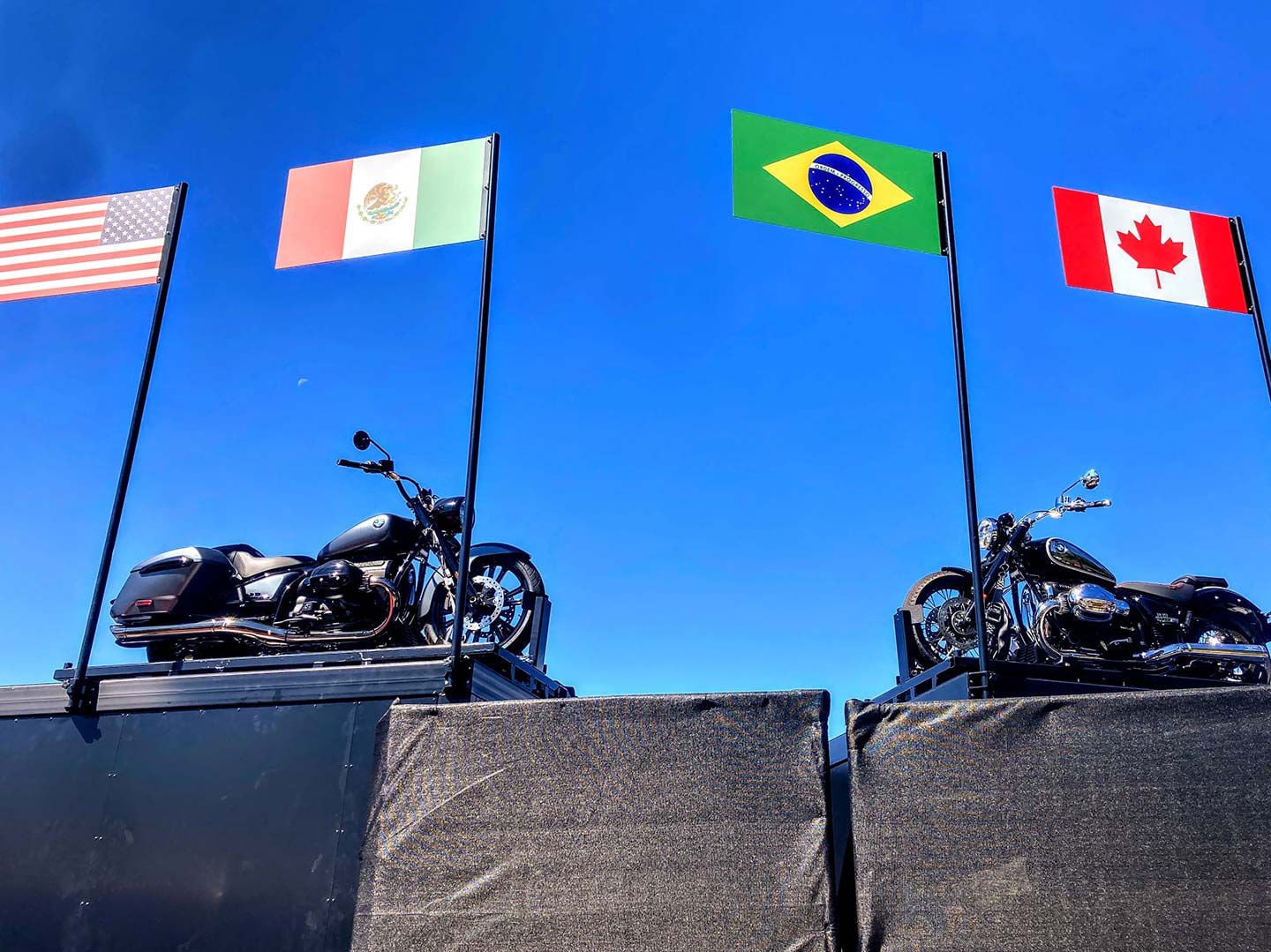
A BMW R 18 Roctane and R 18 100 Years edition watch over the BMW Motorrad Days Fun Zone at Barber Motorsports Park. (Anders T. Carlson/)Every once in a while, corporate Kool-Aid and vintage wine are one and the same. The list of motorcycle manufacturers with 100 contiguous years of production under their belt is a short one. BMW Motorrad’s 100 year anniversary is a big deal. To reflect this, BMW Motorrad Days landed on American shores for the first time, appropriately enough at the Barber Vintage Festival in Leeds, Alabama.
Barber is basically Disney World, the Louvre, and the Masters rolled into one for the moto-obsessed. Certain memes suggest Barber is the hoity-toity version of AMA’s Vintage Motorcycle Days at Mid-Ohio. Maybe. While mud burnouts are discouraged at Mr. Barber’s facilities, there’s a museum that doubles as the last thing motorcycle enthusiasts dream of before they die. Filled with more than 1,600 examples (over 900 on display) of nearly every production motorcycle ever built, it might be the best motorcycle museum on earth. If you worship at the altar of Castrol and Eggshell helmets, it’s a pilgrimage you should make.
Similarly, BMW Motorrad Days is a pilgrimage of sorts for Beemer lovers. Their centenary means looking back as much as looking ahead. The 1923 BMW R 32 was an expression of Max Friz’ engineering prowess and forward thinking. Exactly 100 years later, two new models sum up BMW’s future. One represents 43 years of engineering and marketing success. The other represents year three of an unsettled bet. The unveiling of the brand-new R 1300 GS was the main draw, the hotly anticipated next-gen expression of BMW’s Gelände Sport super adventure bike. The second was the reveal of BMW’s newest R 18 cruiser variant, the Roctane. One model sums up everything BMW has done right for almost half its existence. The other is still fighting for market share and loyal owners.
Related: BMW Shows 100th Anniversary R nineT and R 18 Models for 2023
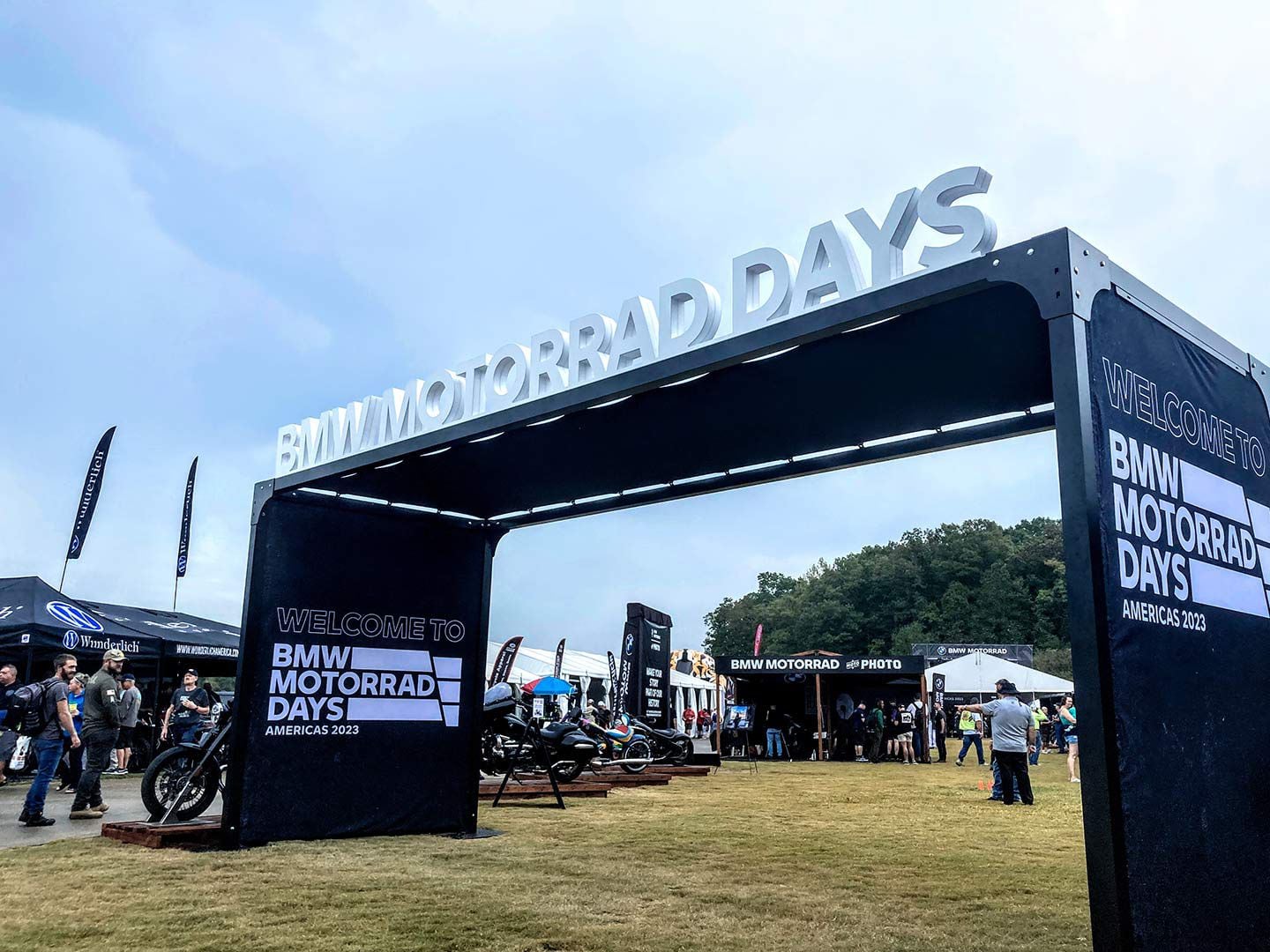
When you’re the official presenter of Barber Vintage Festival, you get the biggest spot in the Fun Zone (Anders T. Carlson/)Sure, the R 1300 GS is big news, but 2024 R 18 Roctane might be the more interesting story. While the GS is master of its own game, the Roctane is the acolyte in someone else’s; American Cruiser 101. After three years, BMW is doubling down. Forsaking conspicuous tech and unrelenting practicality, the Roctane is all cruiser. True, the 1997–2004 R1200C was BMW’s first foray into cruisers. But German funkiness, Telelever front suspensions, and fold-up backrests brought lukewarm results. The Roctane is all in on the American cruiser ideal, nomenclature and everything. What do you run in that? “Roctane,” indeed.
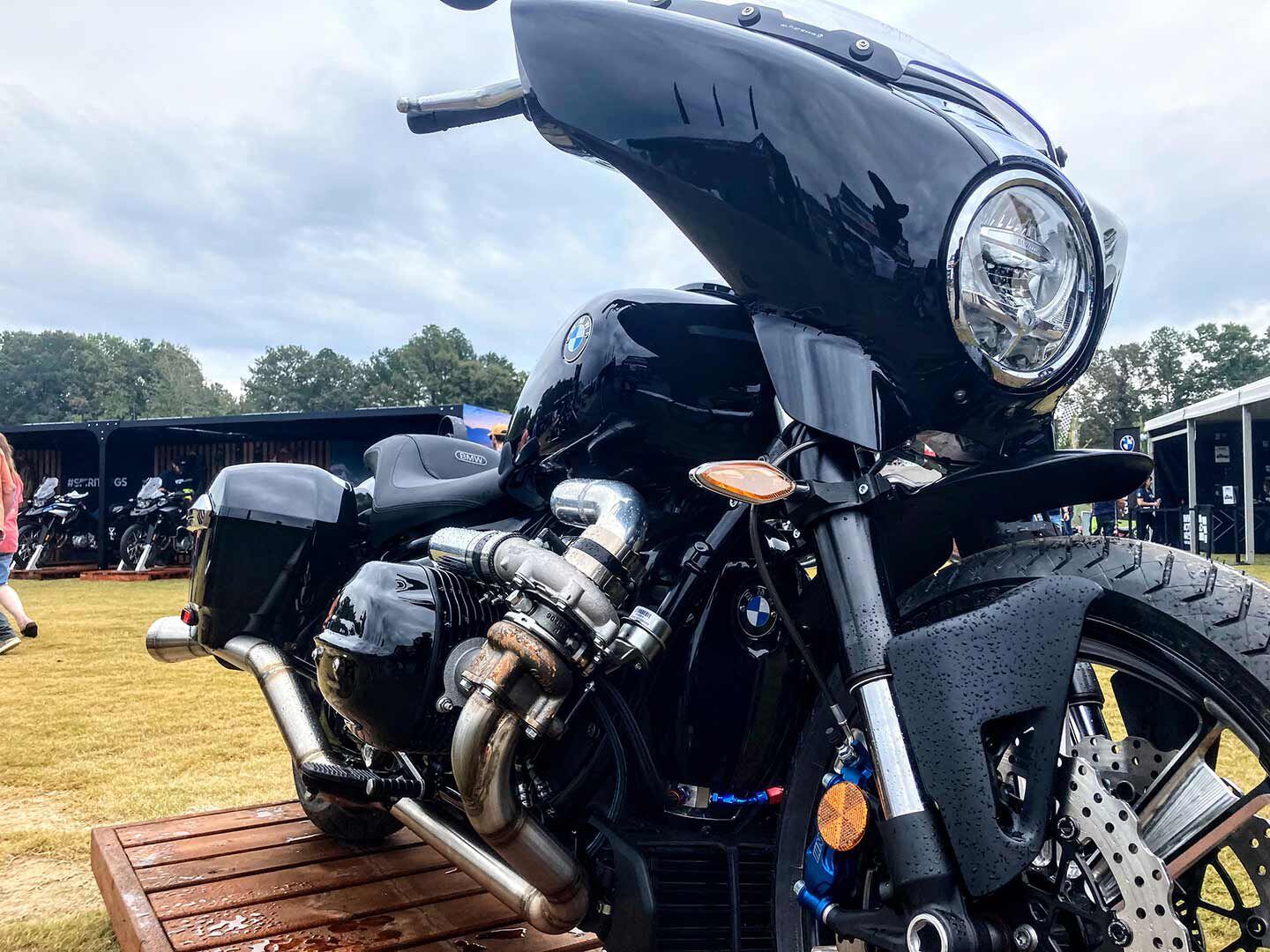
BMW made the R 18 the belle of the ball, despite the hotly anticipated R 1300 GS unveiling. Custom R 18 B with twin Garrett turbos on display. (Anders T. Carlson/)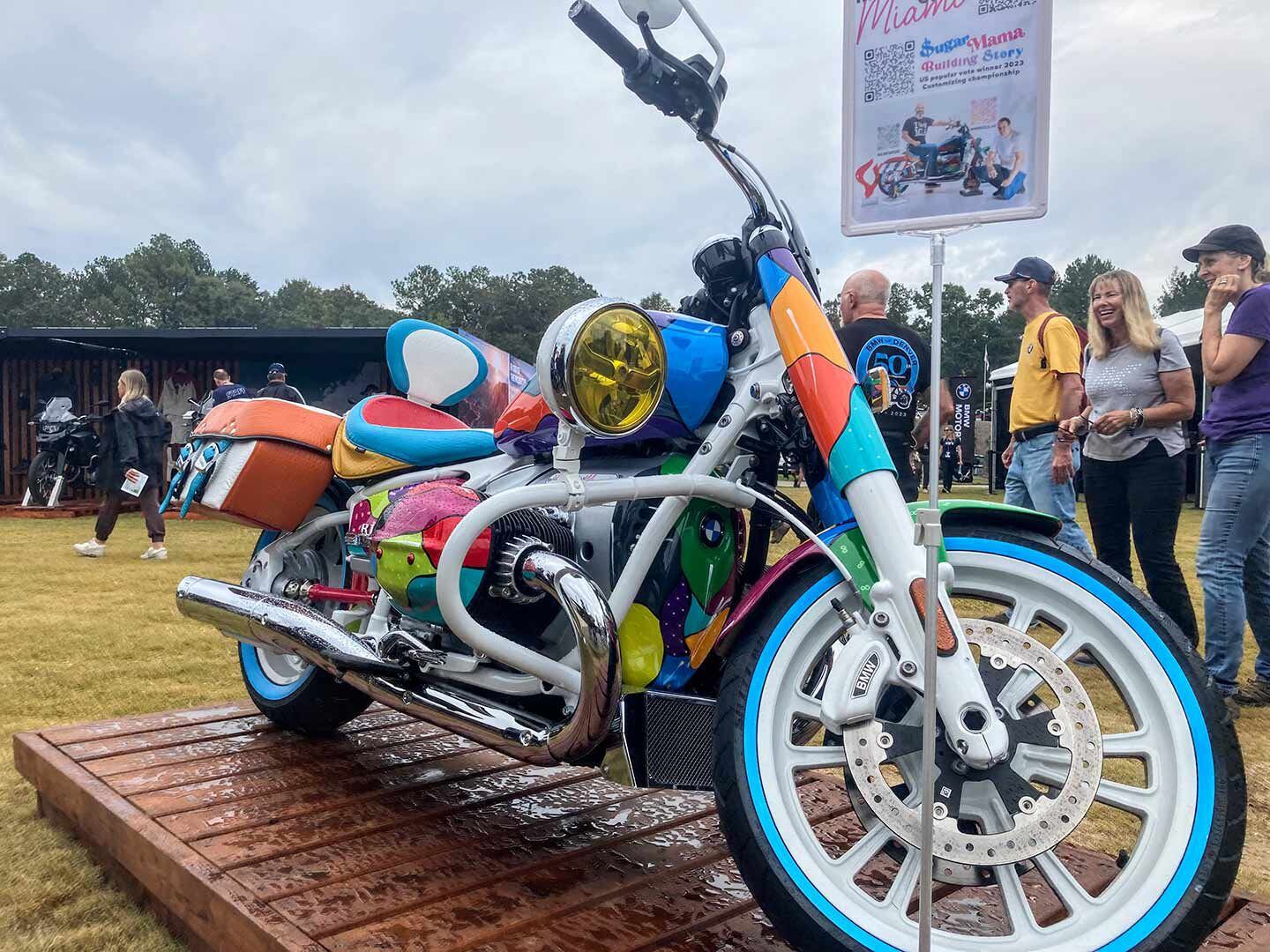
Several builders bought Der Funke to the R 18, like “Sugar Mama,” by Motorcycles of Miami. (Anders T. Carlson/)The BMW Motorrad Days Fun Zone (official title, by the way) featured a large stage and sound system for the unveiling of the R 1300 GS, drop cloth and everything. Occupying the biggest space in the Henderson Auctions Fan Zone (another official title), adventure scenery and bike stands stood empty before the reveal, adding to the anticipation. While BMW’s hospitality is top-notch and befitting the importance of the GS, it’s largely unnecessary. The GS is already a slam dunk, touchdown, and home run all rolled into one. If the main stage had a dunk tank, Randy Johnson would be warming up his left arm.
Then there’s the R 18. The new R 18 Roctane is BMW’s latest iteration of its cruiser concept. It made sure we noticed. A total of thirteen R 18 models were on display, including two positioned high atop a structure next to the main stage. Three custom R 18 design exercises graced the main entrance, with about six serving as showroom models. Saturday’s bike show brought out a few more. There might have been more than thirteen, actually.
As the official “presenter” of the 2024 Barber Vintage Motorcycle Festival, BMW made sure the Fun Zone was the biggest party around. And unlike Triumph, who were exiled to the hard-to-find “Isle of Triumph” by turns 13 and 14, the Fun Zone saw heavy foot traffic, situated between two “Walls of Death,” gear vendors, and food trucks.
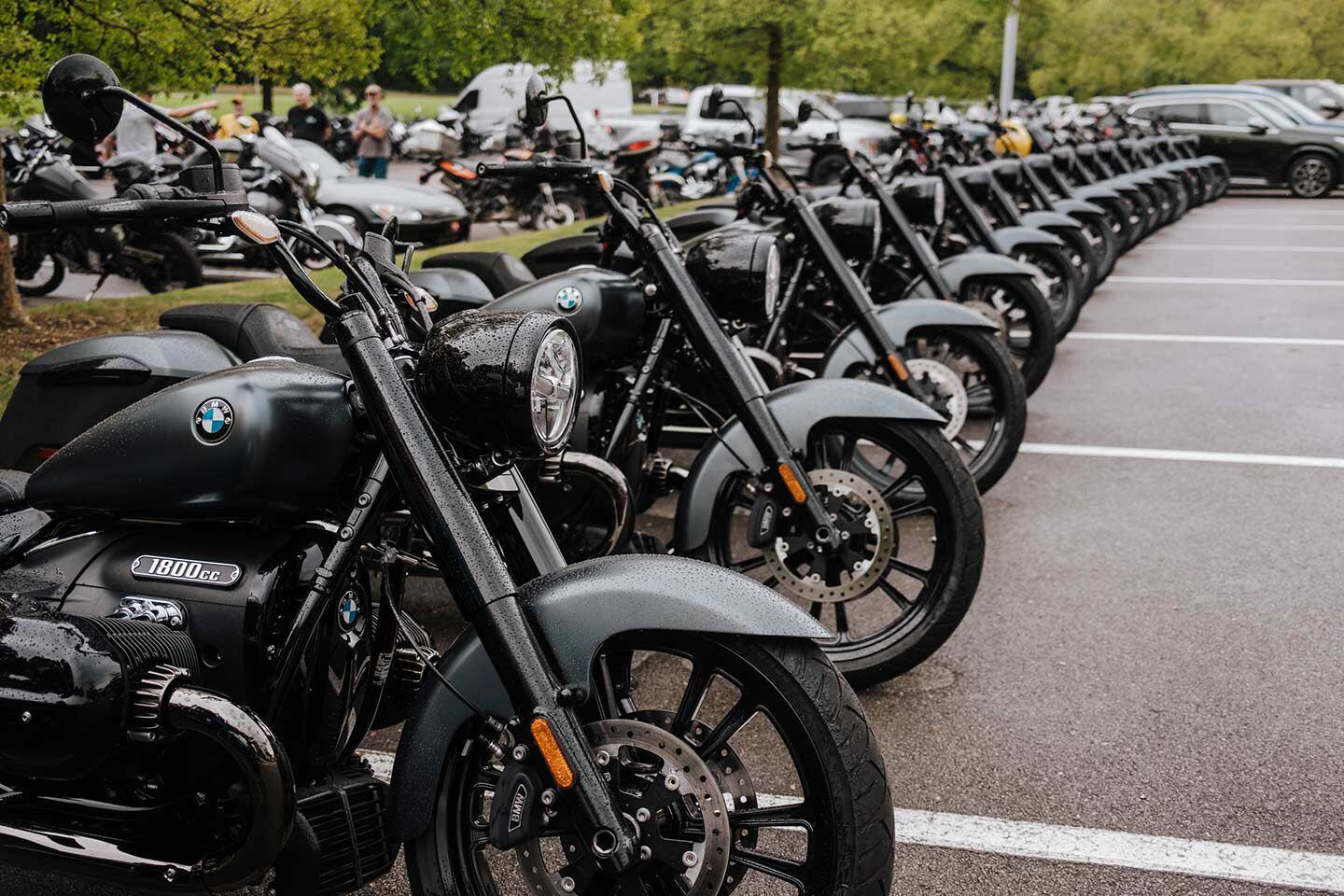
All fifteen R 18 Roctanes made available to the press. Fun fact: BMW meticulously straightened and arranged our bikes thusly every time we parked them. (BMW/)BMW’s charm offensive involved a fleet of 15 identical Gray Metallic Matte R 18 Roctanes provided for the motley crew of journalists, influencers, and other industry notables. We get not one, but two photo shoots as we ride the Roctane though bucolic Birmingham neighborhoods. And when we park, a BMW minder perfectly straightens and aligns the bikes. This makes sense. Sportbike and ADV-minded journalists don’t ride well in formation, but the fleet looks nicely menacing when lined up. As a day cruiser, it’s not meant for multistate travel or prolonged two-up travel. Half its job is just looking great at low speeds or when parked in notable locales. It’s nailing this part of the assignment. What about the other part?
How’s the R 18 doing and how does the Roctane fit in? Here’s Oleg Satanovsky, communications manager at BMW North America.
“After two years, the R 18 family is maturing quite well, and sales have been steadily increasing. Continued feedback from buyers (and non-buyers) ensures the bikes are being developed based on riders’ desires, as seen in the 2024 R 18 Roctane.”
Spoken like a true communications manager. Conversely, there’s BMW Motorcycle Owners of America magazine editor Wes Fleming’s take. Like Satanovsky, Fleming’s allegiance is clear. But his job is critiquing what he loves. How does he think it’s going with the R 18?
“(From what I’ve heard) sales are not what the dealers hoped they would be. But Corporate is overjoyed at how widely the bike has been accepted by, for lack of a better term, influencers.”
Who does he think the R 18 and Roctane are aimed at?
“They’re going after folks who haven’t developed a rabid brand loyalty. Most of the R 18 owners I know are first-time BMW owners.”
Despite their differing takes, both might agree there’s some runway as far as an untapped market for the R 18. It’s about getting new butts in BMW seats and letting riders experience it themselves.
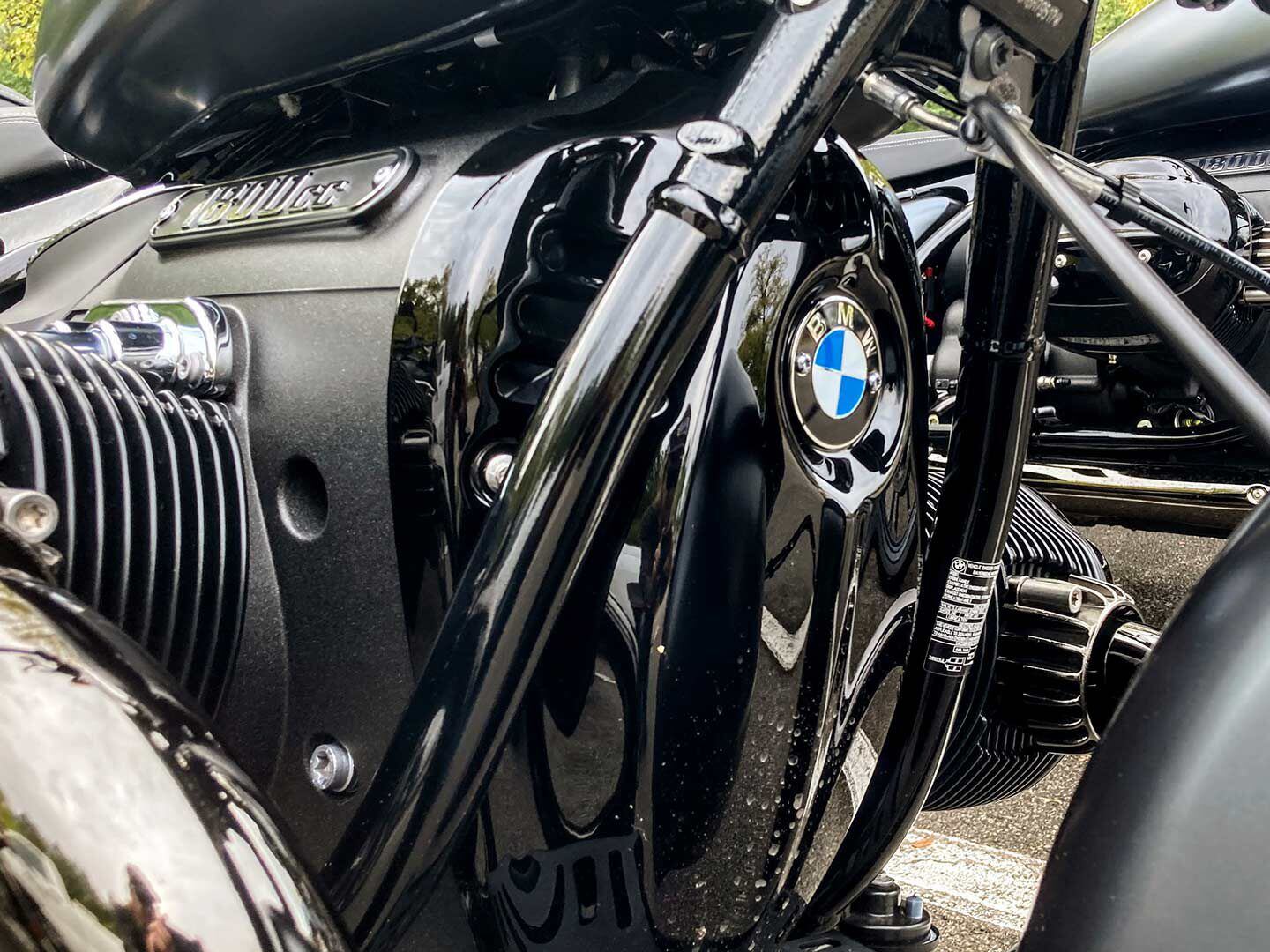
The R 18 Roctane’s blacked-out 1,802cc air-and-oil-cooled boxer engine wears a badge in place of a heart on its ample sleeve. (Anders T. Carlson/)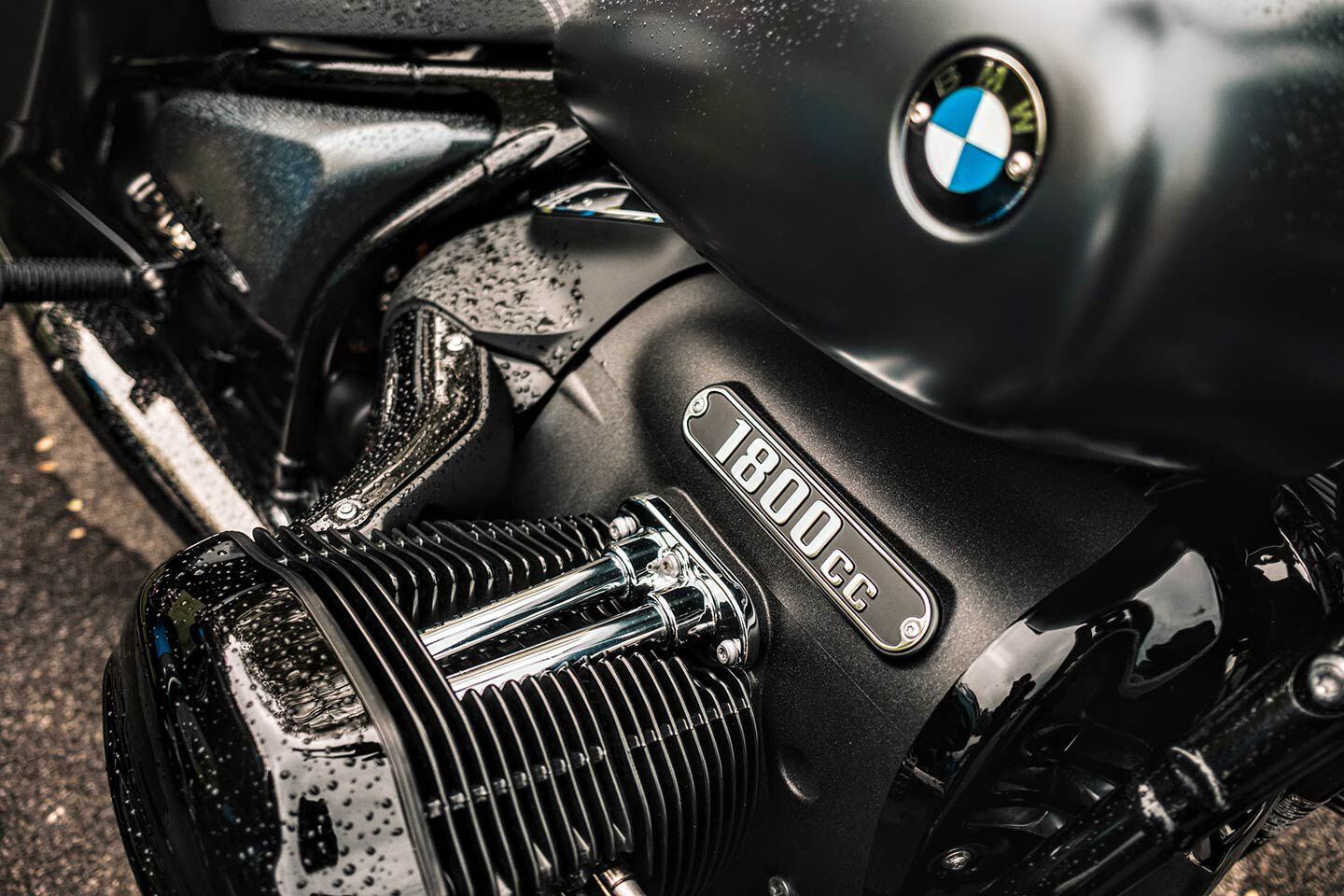
Twin pushrods bring both BMW heritage and classic American cruiser chops to the BMW R 18. (BMW/)The Beauty of Barber
The perpetual traffic jam that is Barber ensures Roctanes get parked at the museum. Seems a perfect opportunity to trot out the electric BMW CE 04 or CE 02, just saying. Barber veterans usually bring their finest pitbikes for maximum convenience and fun. But shuttles are everywhere, which works nicely for those enjoying adult beverages and not manning handlebars. And with the right combination of wristbands and lanyards, pit lane is required viewing to see hundreds of vintage motorcycles ready to race within the confines of the AHRMA rule book and Barber’s 16 turns.
Saturday’s parade lap featured Reg Pridmore’s 1976 AMA Superbike championship-winning BMW R90S, piloted by Eric Giestl, son of Butler & Smith engineer Udo Giestl, who built it. Fred Jacobs, BMW’s in-house historian, mentioned the R90S almost didn’t make it out, owing to rear wheel and transmission issues. If you’re going to have issues with a vintage unobtanium bike, best to happen at Barber. It just ain’t a vintage race weekend without last-minute engineering heroics.
All this fun gets bookended by 25-mile sprints to the track and back at the end of each day on the Roctane. What’s it like? To start, the Roctane starts up like a dog after a bath, sitting on a tractor which is also being started. The 1,802cc, air-and-oil-cooled opposed-twin mill has the character of classic boxer engines—and then some. It’s not the R 1250 RT or K 1600 B. You’ll get plenty of smooth, torquey power once you’re underway. But for now, enjoy Teutonic thunder warming up.
Just kidding; nobody warms bikes up anymore. But take a sec to look around and see if anyone’s impressed by your Roctane. With an approximately 38-inch-wide engine weighing 242 pounds and driving 825 pounds of curb weight, they should be. It develops 91 hp at 4,750 rpm, putting 116 lb.-ft. of torque at 3,000 rpm to the ground. Specifically, about 110 lb.-ft. of torque is available from 2,000–4,000 rpm.
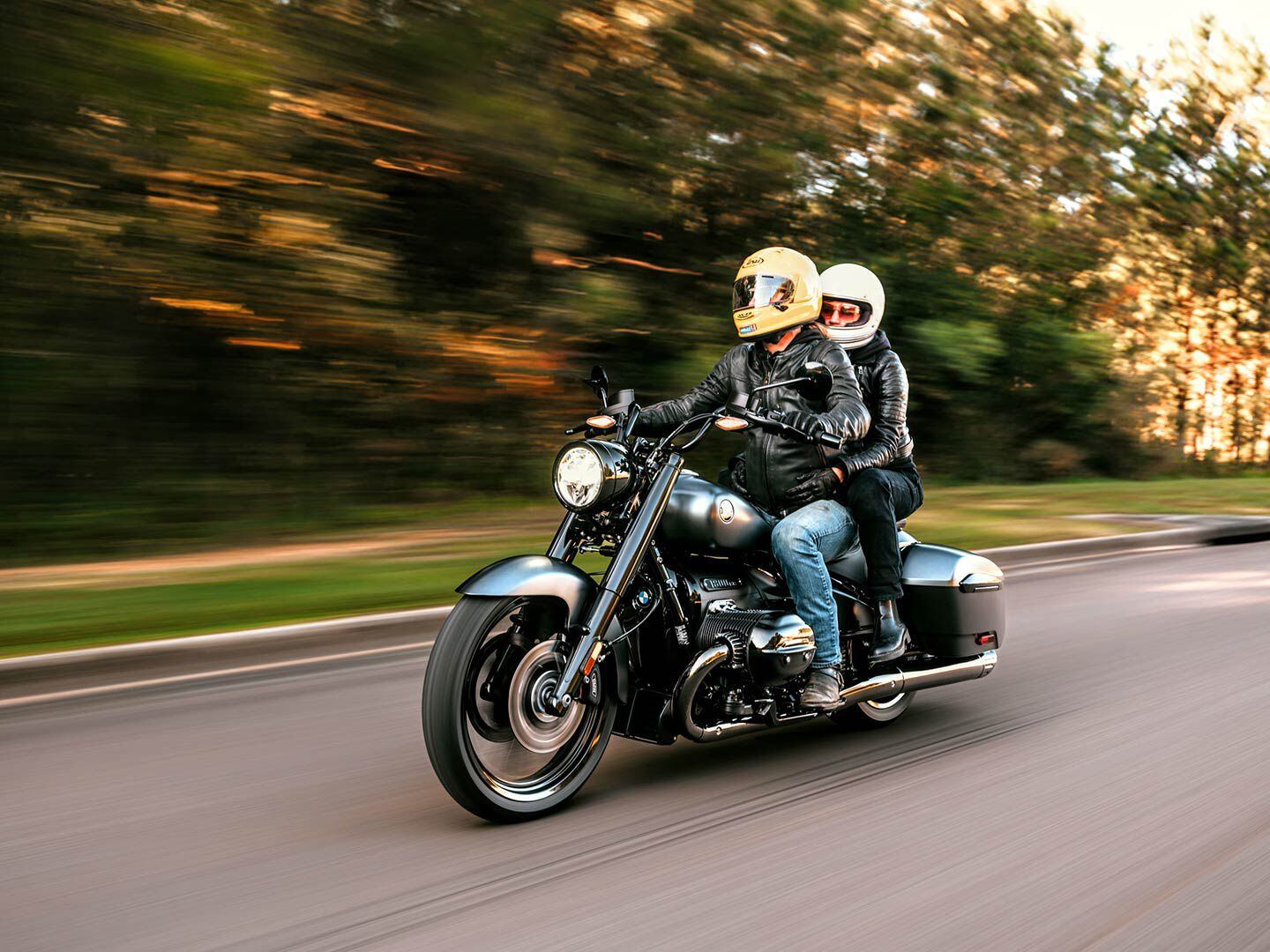
Riding two-up on the Roctane was more pleasant than expected. Despite the small passenger seat, it held up over two days of light touring. (BMW/)Life Aboard the Roctane
Numbers tell half the story. A low (but wide) center of gravity means it’s a handful to get off the sidestand. But once underway, the wide bar and mid-controls give a confident feel and control over the bike’s heft. A signature rock to the left follows every blip of the throttle. It’s a nice change from V-twin vibration, which can travel in every direction known to physics. Counterbalancers appeared on boxer engines in 2004, but the R 18 does without.
Spirited flogging of the Roctane above 4,000 rpm was a bit underwhelming, despite Rock mode. Automatic Stability Control, Integrated ABS, Torque Control Assist, and Dynamic Brake Control are your constant guardian angels, regardless of ride mode. You’ll likely leave it in Rock mode for months at a time, though.
Regardless, vibration lessens as the 67.7-inch wheelbase builds momentum. A previous Cycle World review found unpleasant vibrations from 2,800 to 3,500 rpm on the R 18 B. To this reviewer, the Roctane seemed smooth enough, with the prerequisite light buzz of a cruiser. Did a higher bar and/or weights tame things? Or maybe the seat? The Roctane’s seat is slightly narrower with more padding than the R 18 B’s. The Roctane’s slightly longer wheelbase (67.7 inches versus 66.6 inches) and longer rake and trail (34.7 degrees, 7.3 inches versus 27.3 degrees, 7.2 inches) likely make no difference. BMW tweaking or just different rider notes? Schedule a test ride and decide for yourself.
A tall first gear means stoplight holeshots take practice. But otherwise the constant-mesh six-speed gearbox is nicely spaced, with a higher and flatter powerband pulling nicely into the 4K rpm range. The heel-toe shifter isn’t there for looks. It’s impossible to upshift using the toe, making the heel end mandatory for upshifting. Like forward controls? You’re out of luck. But crashbar leg rests are an official BMW Motorrad option, allowing you to recline as you ride. In this category, that stuff matters.
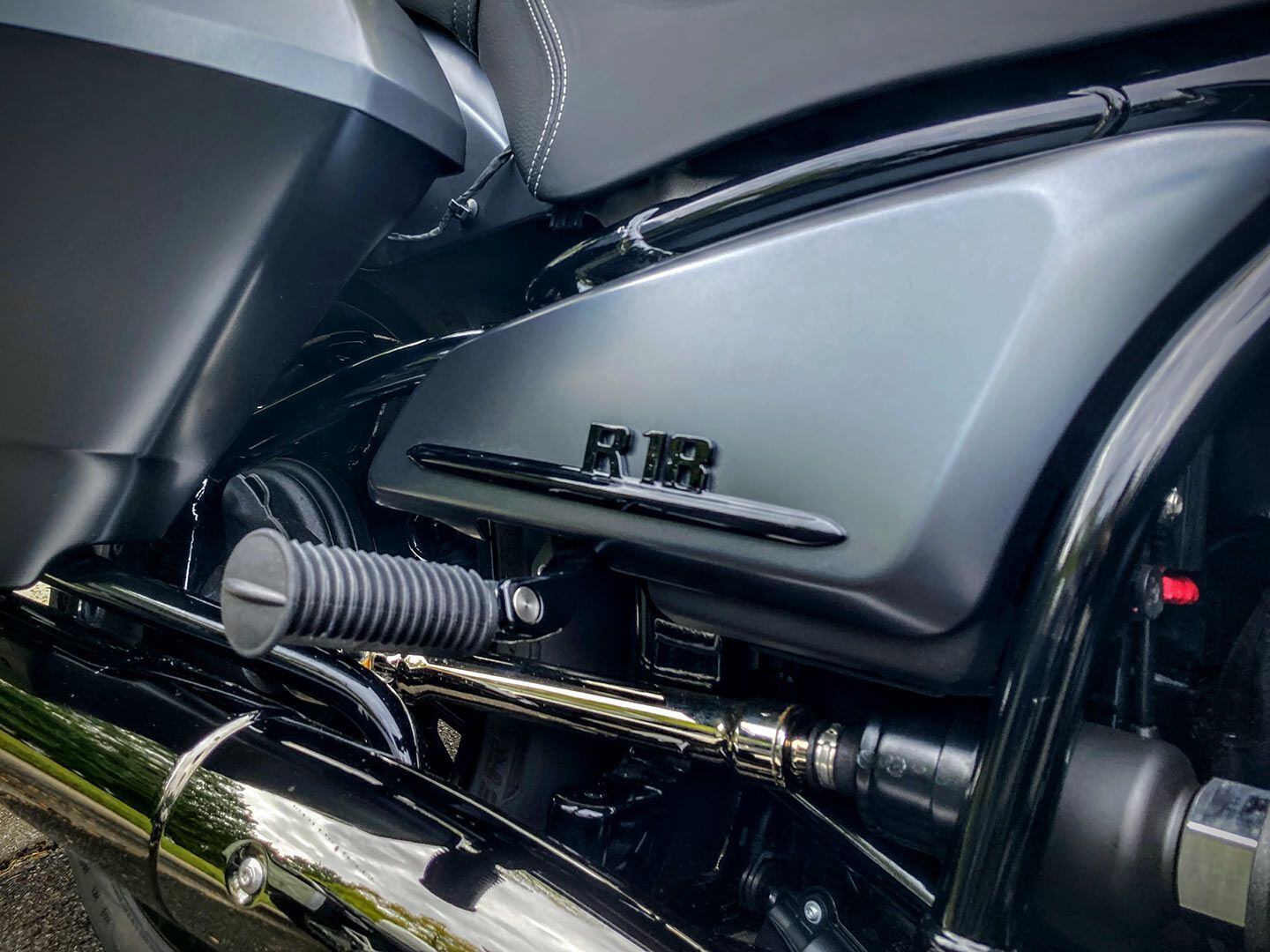
The exposed driveshaft of the R 18, along with basic accommodations for passenger feet. (Anders T. Carlson/)Handling the Heaviness
Riding two-up is pleasant, believe it or not. Passengers were surprised by how comfortable the small pillion seat was, even on extended rides. But no grab rail or backrest meant there are limits. Conveniently, the exhaust note allows passenger complaints to be clearly heard above 90 mph. But overall, the seat overachieves. With that low center of gravity, passenger weight is felt more when stopped or at low speeds. Mid-controls and the boxer engine mean passenger legs and feet aren’t far from each other at times.
The headlight-mounted instrument cluster is spartan, with an analog speedometer and about 3 square inches of LCD screen showing ride modes, gear indicator, and trip computer details. Fiddle with the mode button and the engine rpm shows up in place of trip details. There’s little to distract you from the sights and sounds of riding. How does the Roctane sound? There’s a pleasant twin pitter-patter well into the rpm range.
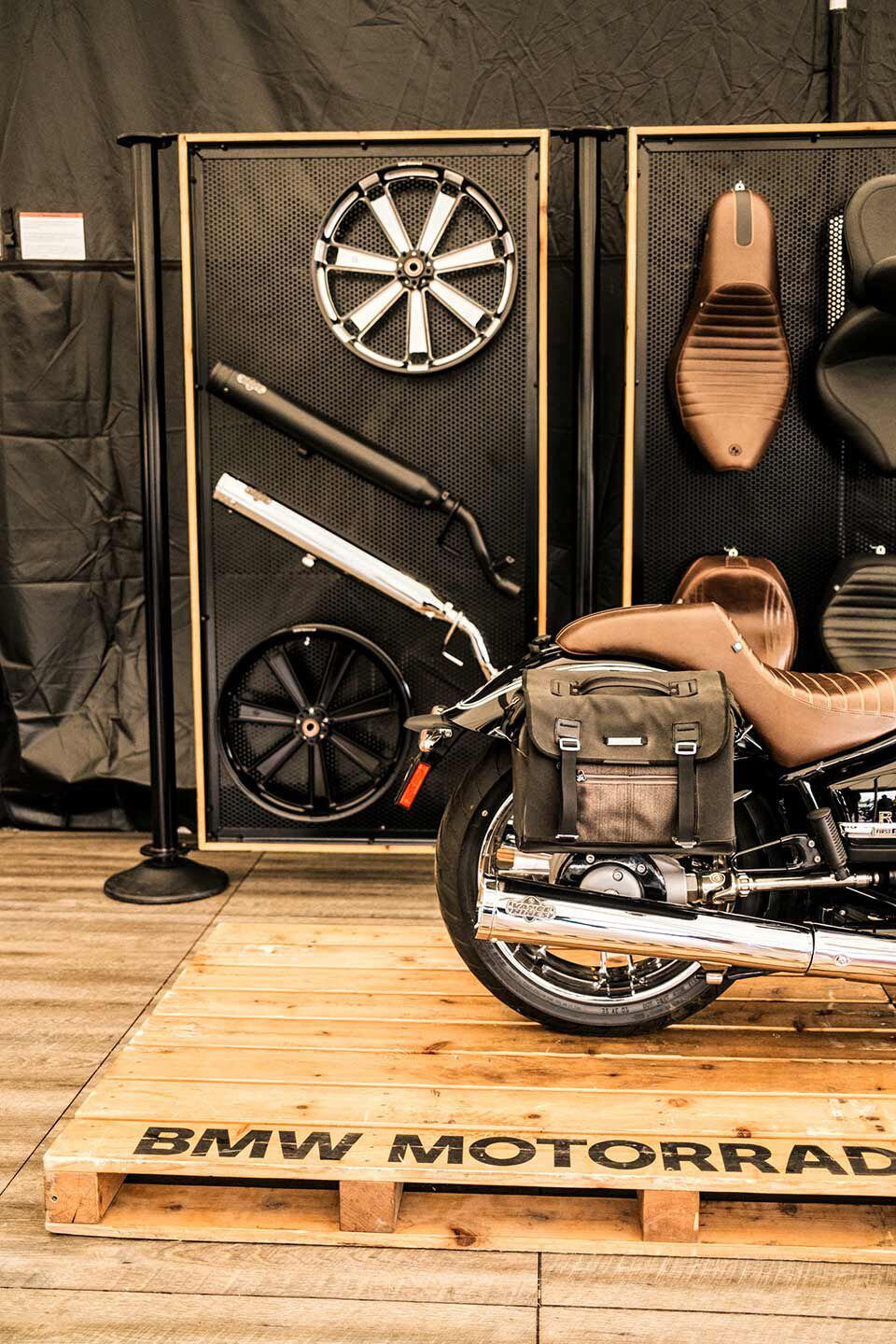
Like the R nineT, the R 18 is meant to be customized. Vance & Hines pipes along with seat options on display at the BMW Motorrad Days Fun Zone. (BMW/)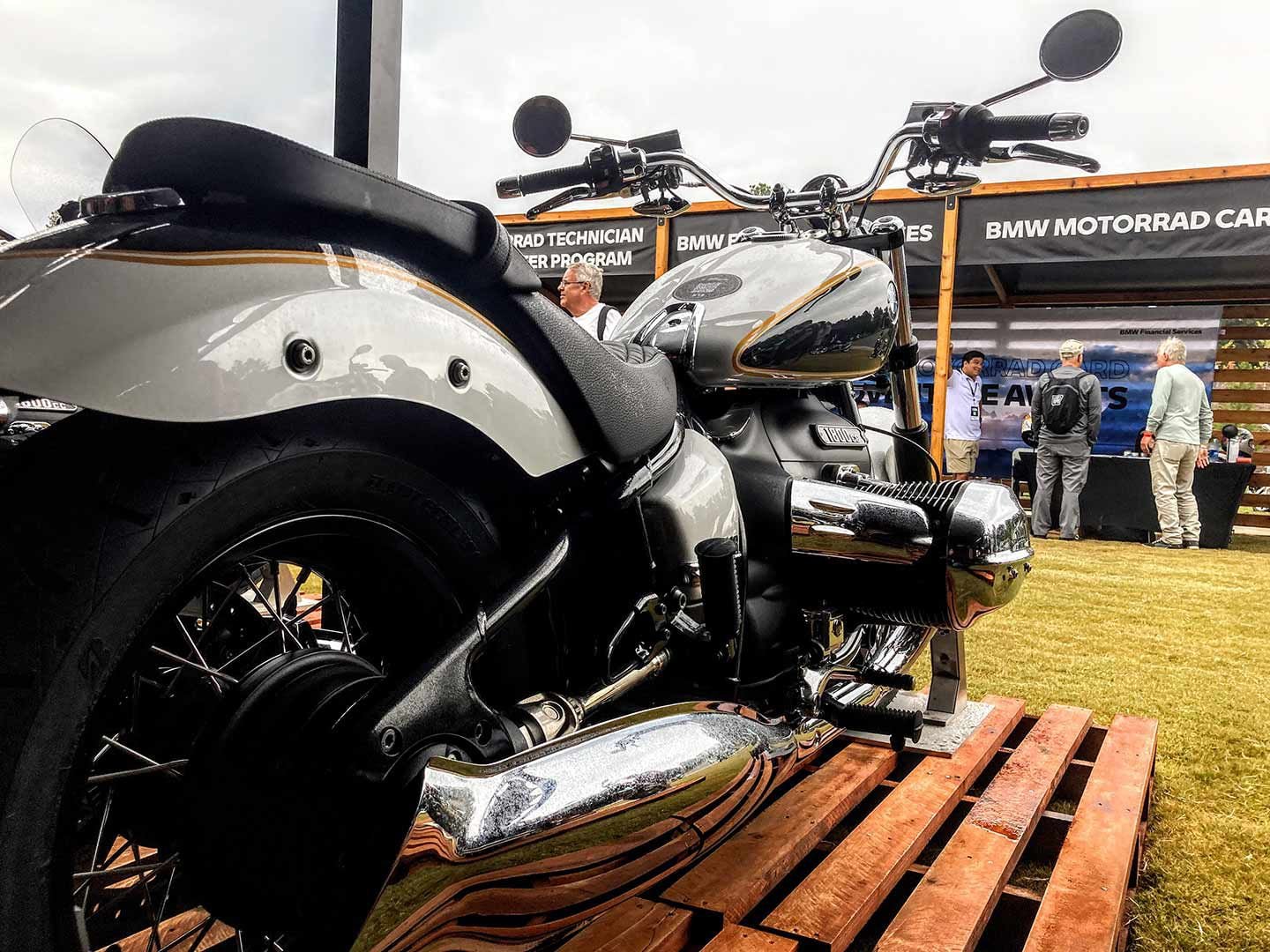
A 2023 BMW R 18 with Option 719 Metallic White Metallic paint, starting at $17,285 MSRP. (Anders T. Carlson/)The 49mm front fork can’t be adjusted, while the rear single shock is preload-adjustable. Past complaints about stiffness have been addressed. The Roctane still has just 3.5 inches of rear suspension travel, but the damping is superb. It’s taut, but soaks up bumps much better by all accounts. A 21-inch front wheel (with the same 18-inch rear) means slower handling at low speeds, but the greater unsprung weight gives good stability as the speedometer climbs. Speaking of which, the Roctane is more flickable at speed than any bike its size has a right to be. It defies expectations, but not physics. The massive cylinders do most of the work, just glance left or right and tip the bar ever so slightly. It’s slightly addictive.
Ultimately, BMW’s gamble comes down to what it considers “success.” Ending up a collectible oddity in 20 years’ time isn’t good enough. But selling over 20,000 R 18s in two and a half years might be a good enough opening gambit. But skeptics abound. Predictions are just sport. Eventually we’ll find out, one way or the other.
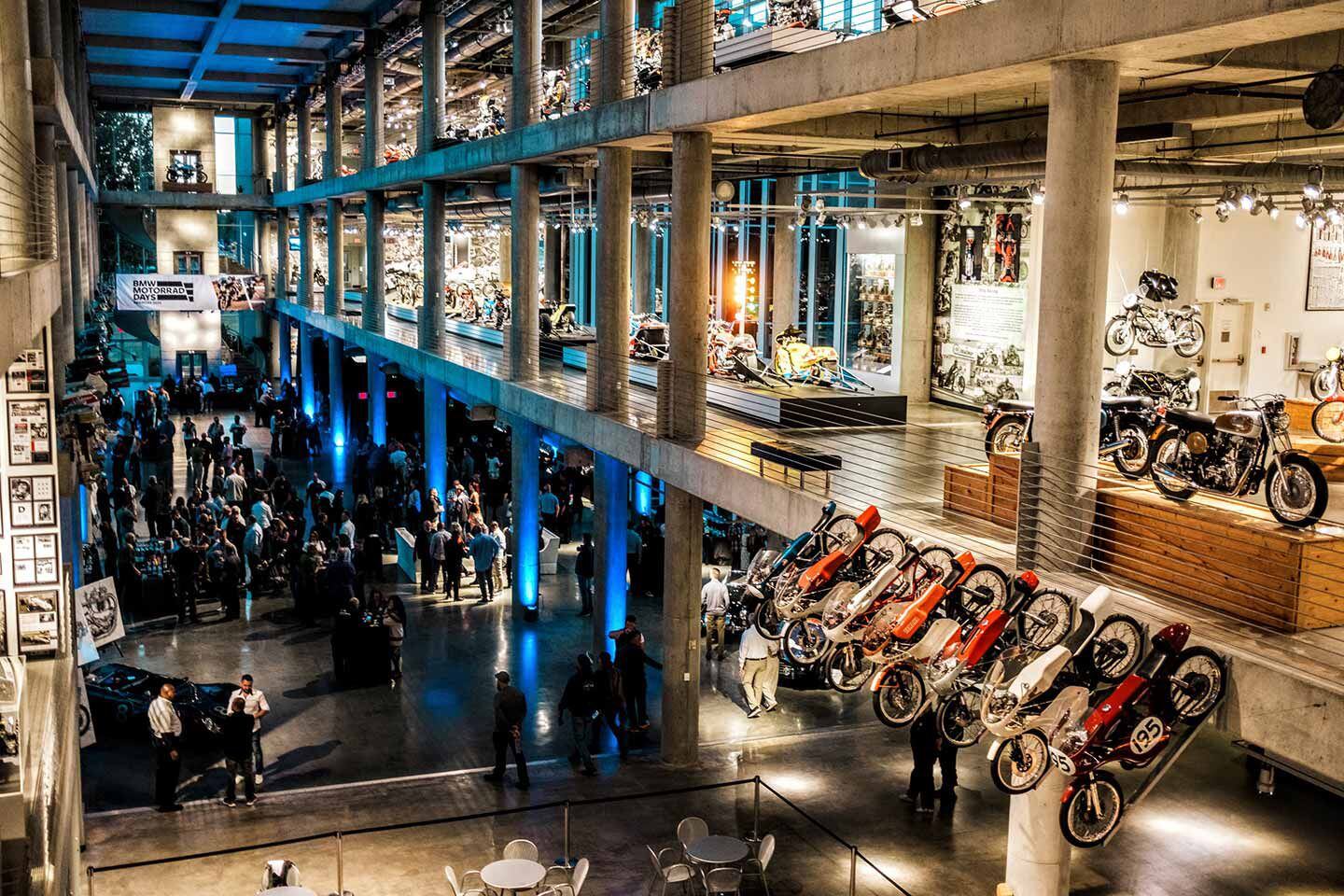
An actual night at the museum, with food and everything. Dinner hosted by BMW Motorrad Days at the Barber Motorsports Museum. (BMW/)Barber and What It All Means
The weekend is like drinking through a firehose. All five senses are constantly bombarded by things both pleasant and challenging. Unburned hydrocarbons bark through gleaming chrome that vibrates and hums. What involved the sense of taste? The Castrol sputtering from hundreds of two-strokes. Sometimes it’s Klotz, which seems slightly sweeter. You could plaster California cancer warnings everywhere and it would still be marvelous.
Speaking of “taste,” Barber’s also an orgy of marketing dollars and sponsor money. BMW’s multi-thousand-dollar custom-made displays sat yards away from vinyl banners, shoestring budgets, and small-business hopefuls. Swap meet stalls get funded by pass-the-jar gas donations, plus occasional sales. Food and drink are expensive, not surprising. Entrepreneurial hustling is the order of the day. But crass it isn’t. More money brings more people, which grows the thing we love, whether sport or hobby. Our passions may be the spark, but only cash money buys fuel.
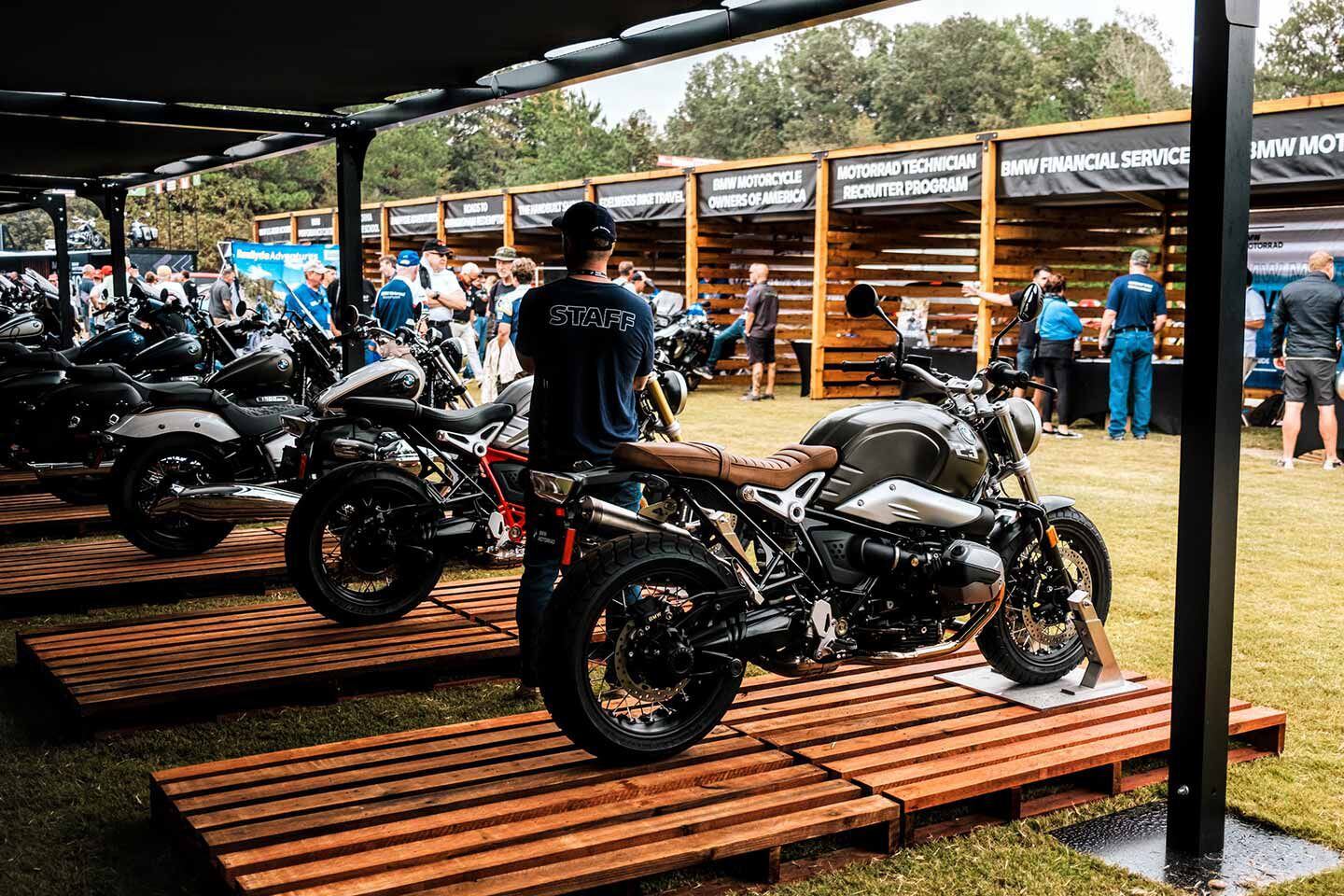
While visitors drank beer and enjoyed food, a team of hardworking staff stayed true to the Motorrad Days’ mission: touching hearts, minds, and pocketbooks. (BMW/)BMW Motorrad’s largesse is an investment. And bringing Motorrad Days to the US clearly aligns with its R 18 hopes and ambitions. The American cruiser market is the next beachhead. Capture hearts and minds, and American wallets will follow. Of course R 18s and Roctanes were everywhere and on everything. Not much point in being subtle about these things.
The 80,000 plus spectators continued the trend of growth for Barber. Every year brings expansion and improvements. I only just noticed them. I’m usually the one nervous-sweating and sleep-deprived in the pits next to a vintage “racebike.” One year I didn’t leave the pits at all, thanks to a magneto issue. It’s fun but grueling and costly. Unless someone rich starts handing out prize money, vintage motorcycle racing will always be a money pit. Best to forget the thousands of dollars spent in search of amateur race glory. So, congrats to BMW and anyone who reaps an eventual reward from their investment at Barber.
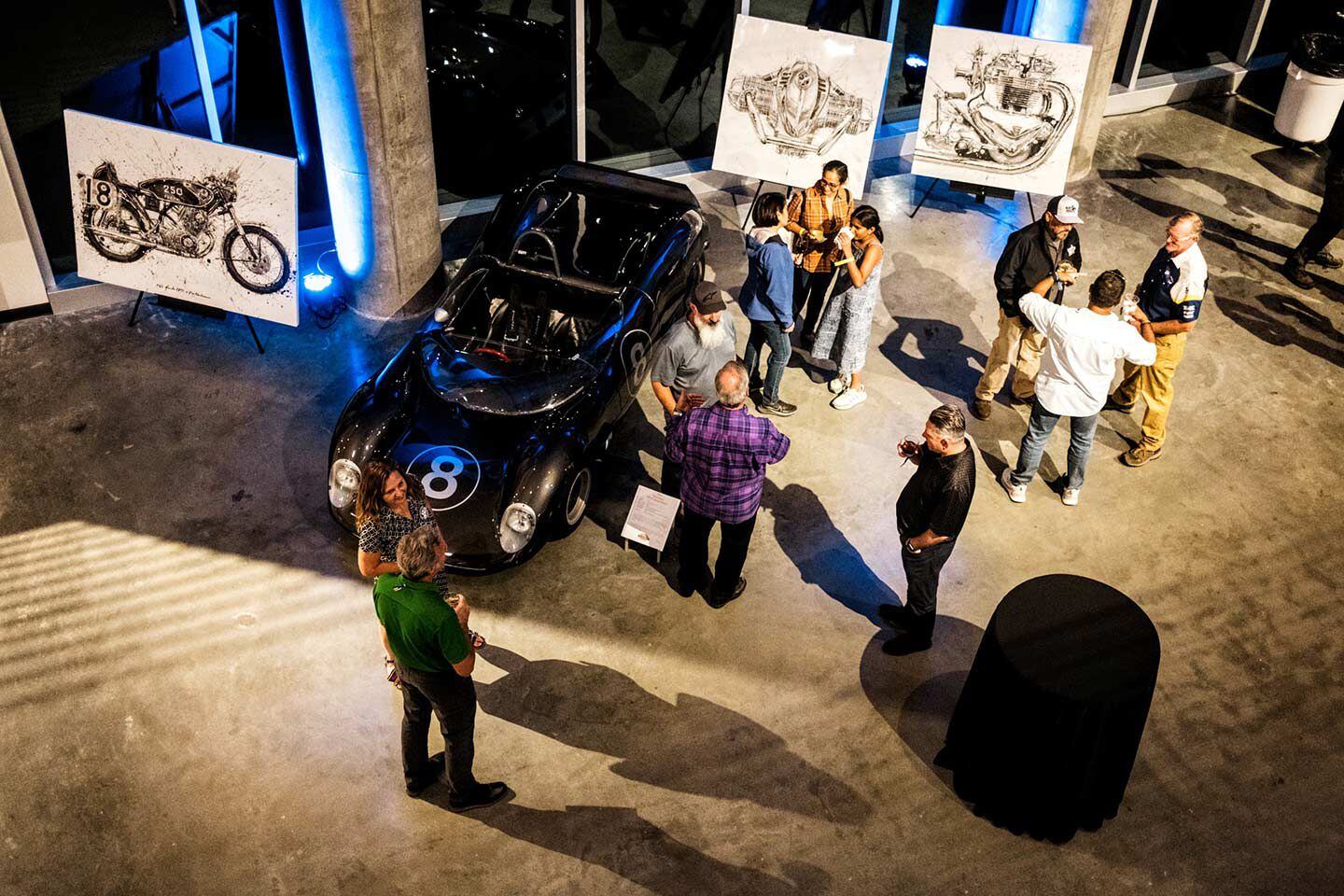
An aerial view of important motorcycle people doing important motorcycle people things. BMW Motorrad Days dinner at the Barber Motorsports Museum. (BMW/)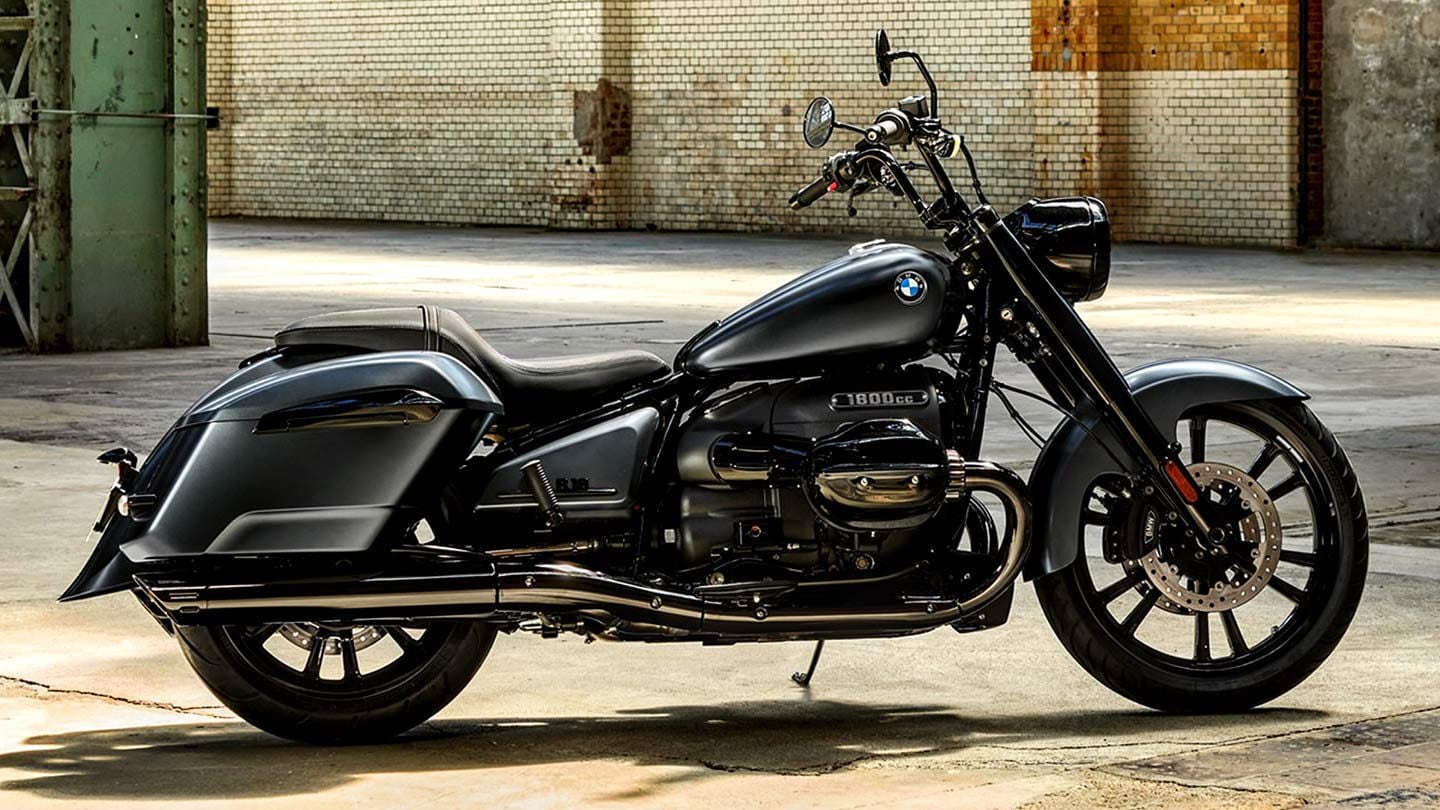
Despite having only eight BMW badges or BMW nameplates on it, the R 18 Roctane belongs in the American cruiser convo. (BMW/)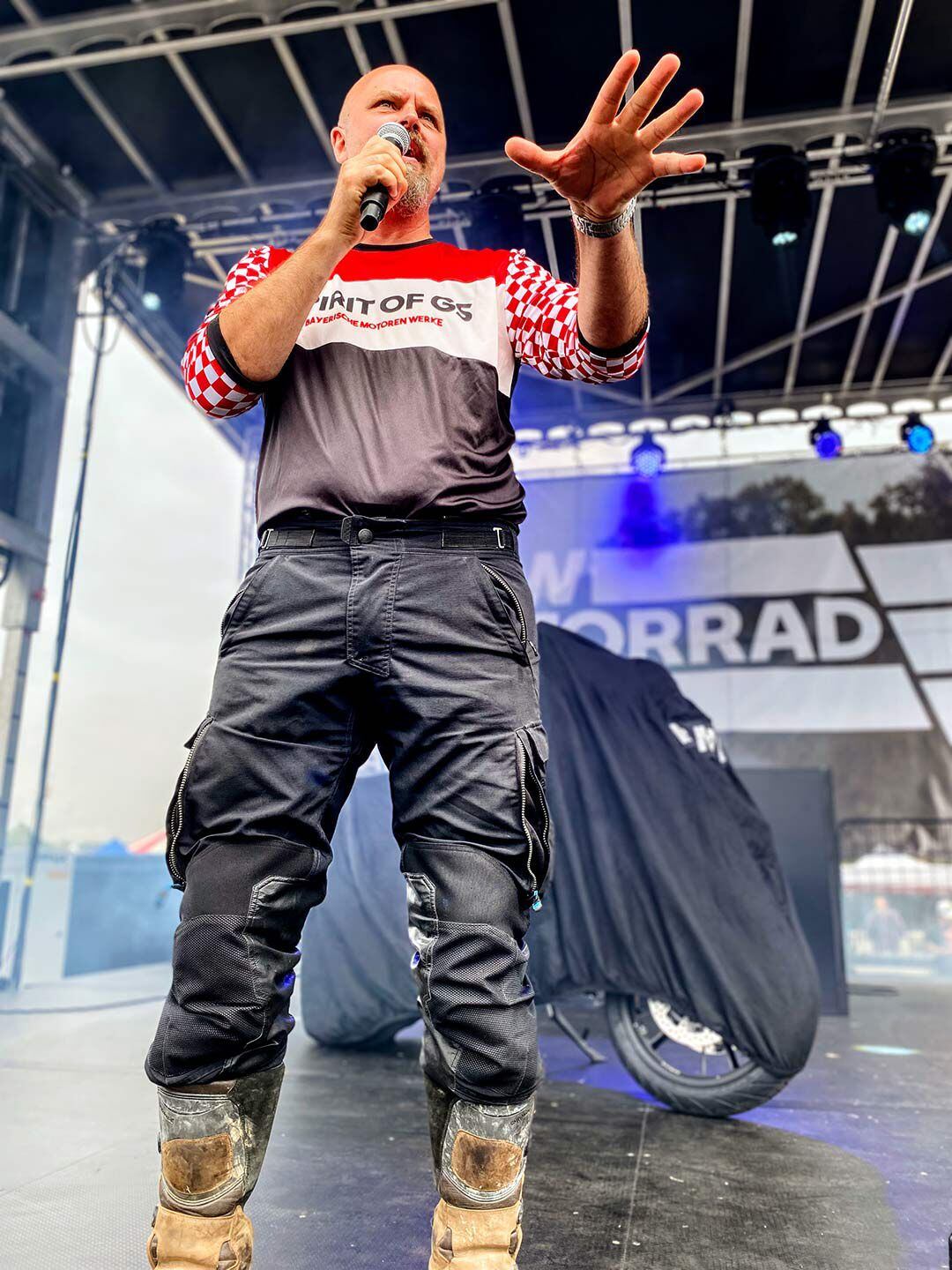
The unveiling of the BMW R 1300 GS, shown here before the unveiling. (Nicole Everhart/)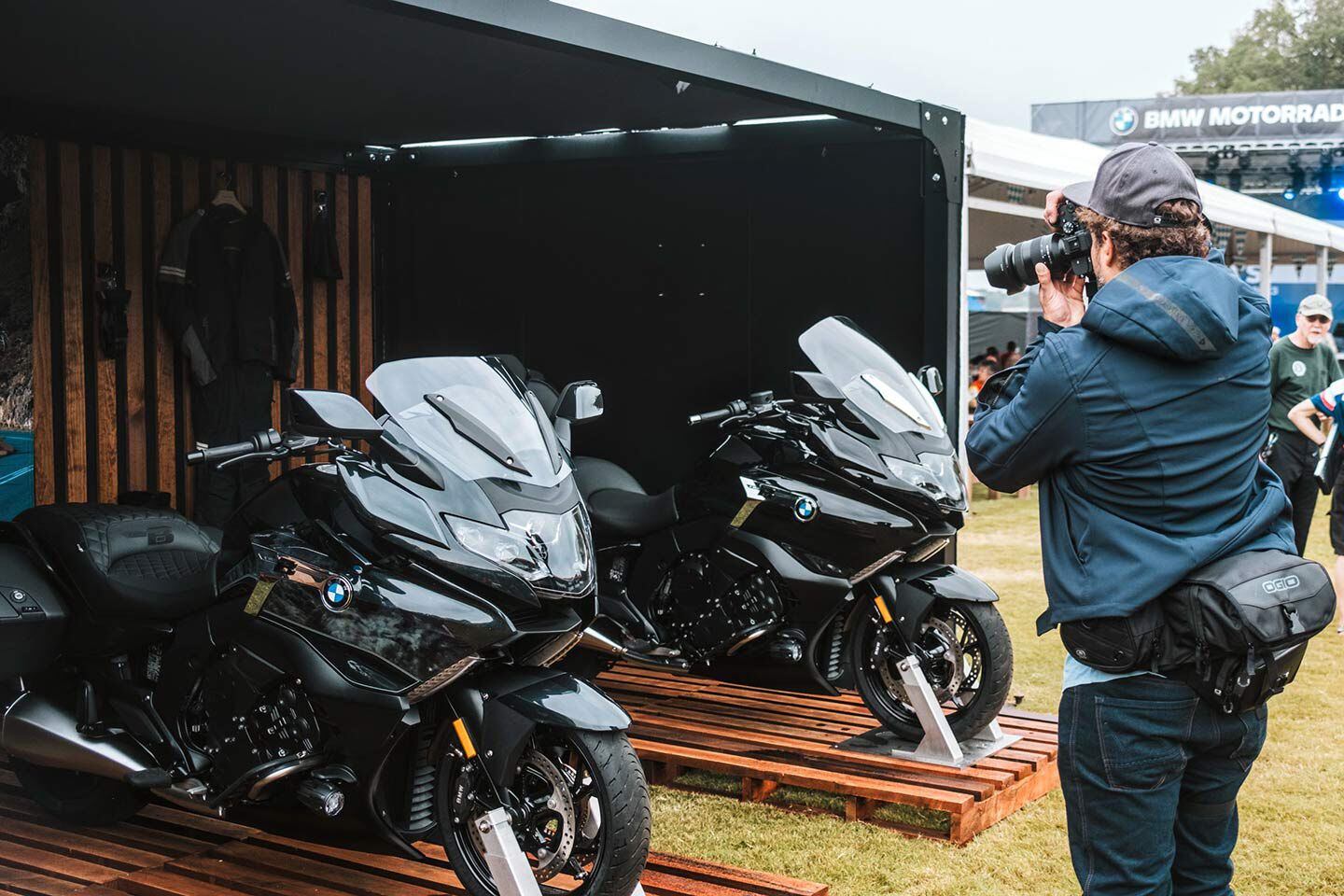
One of the hardest-working men in motorcycle journalism, Adam Waheed shoots content for sister publication <i>Motorcyclist</i>. (Anders T. Carlson/)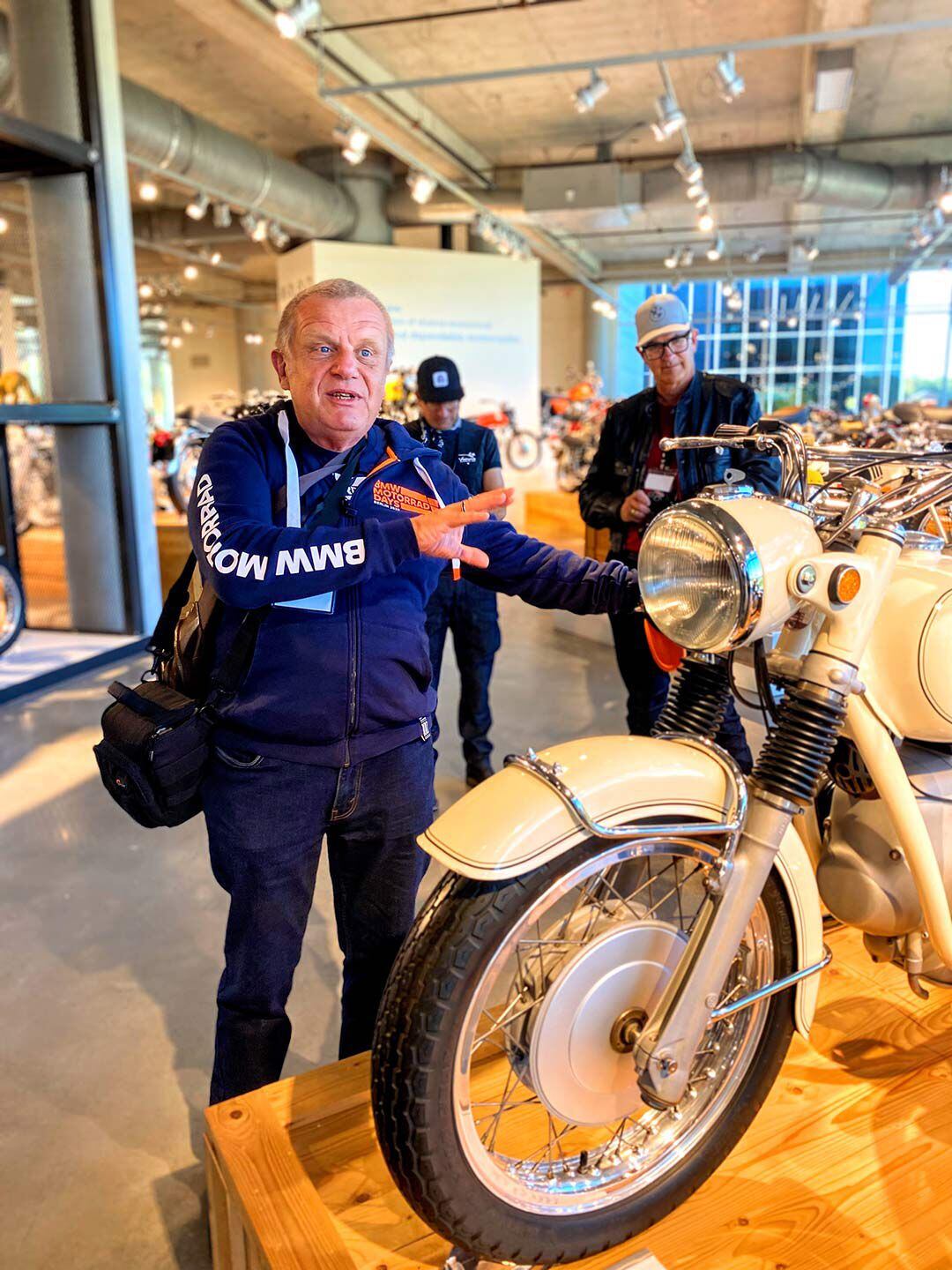
BMW in-house historian and archivist Fred Jacobs gives a tour of Barber Motorsports Museum. (Nicole Everhart/)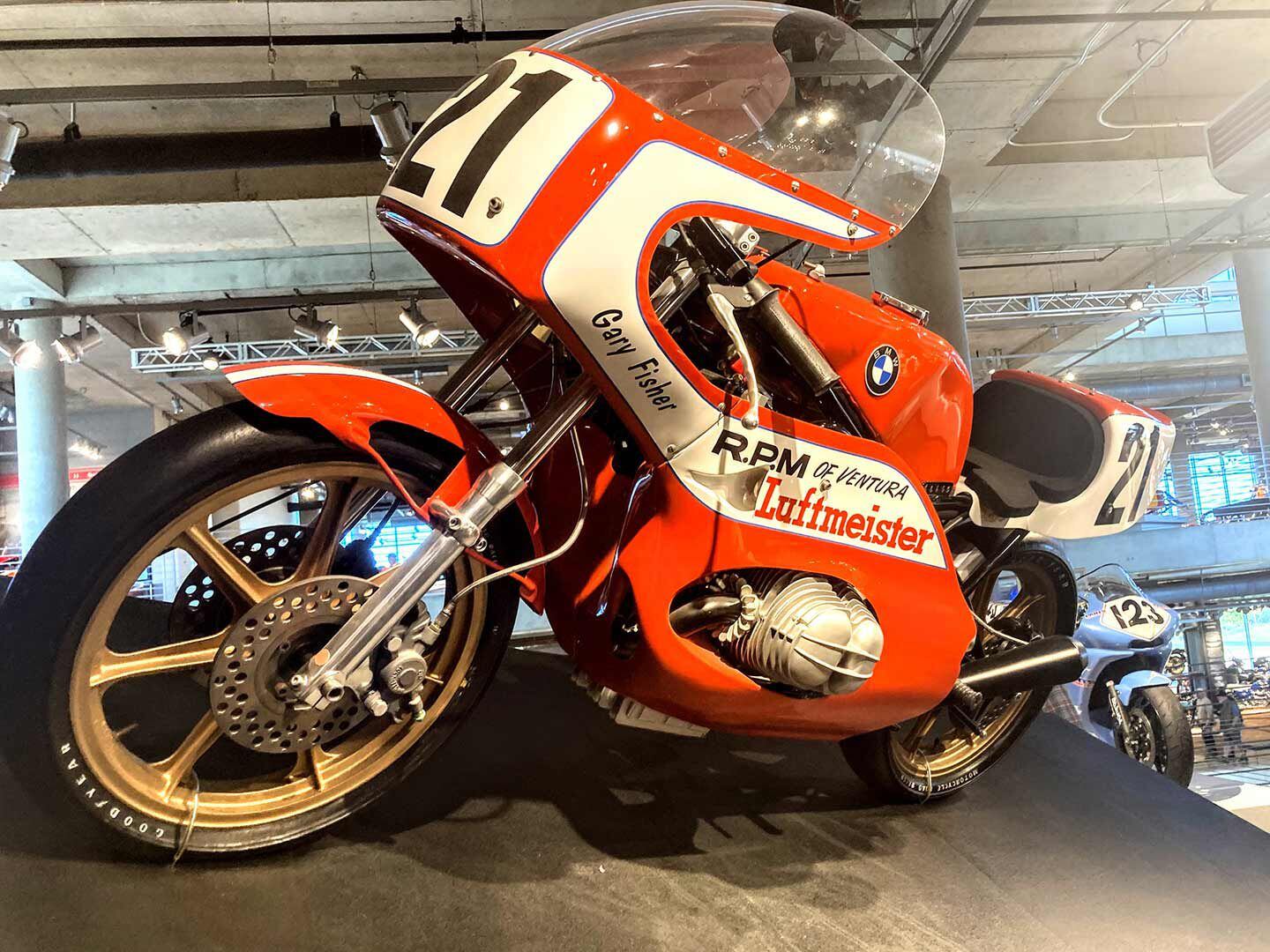
1974 BMW F-1 AMA racebike designed by famed builder Rob North. Fun fact, it’s one of two in existence and features a single rear shock. (Anders T. Carlson/)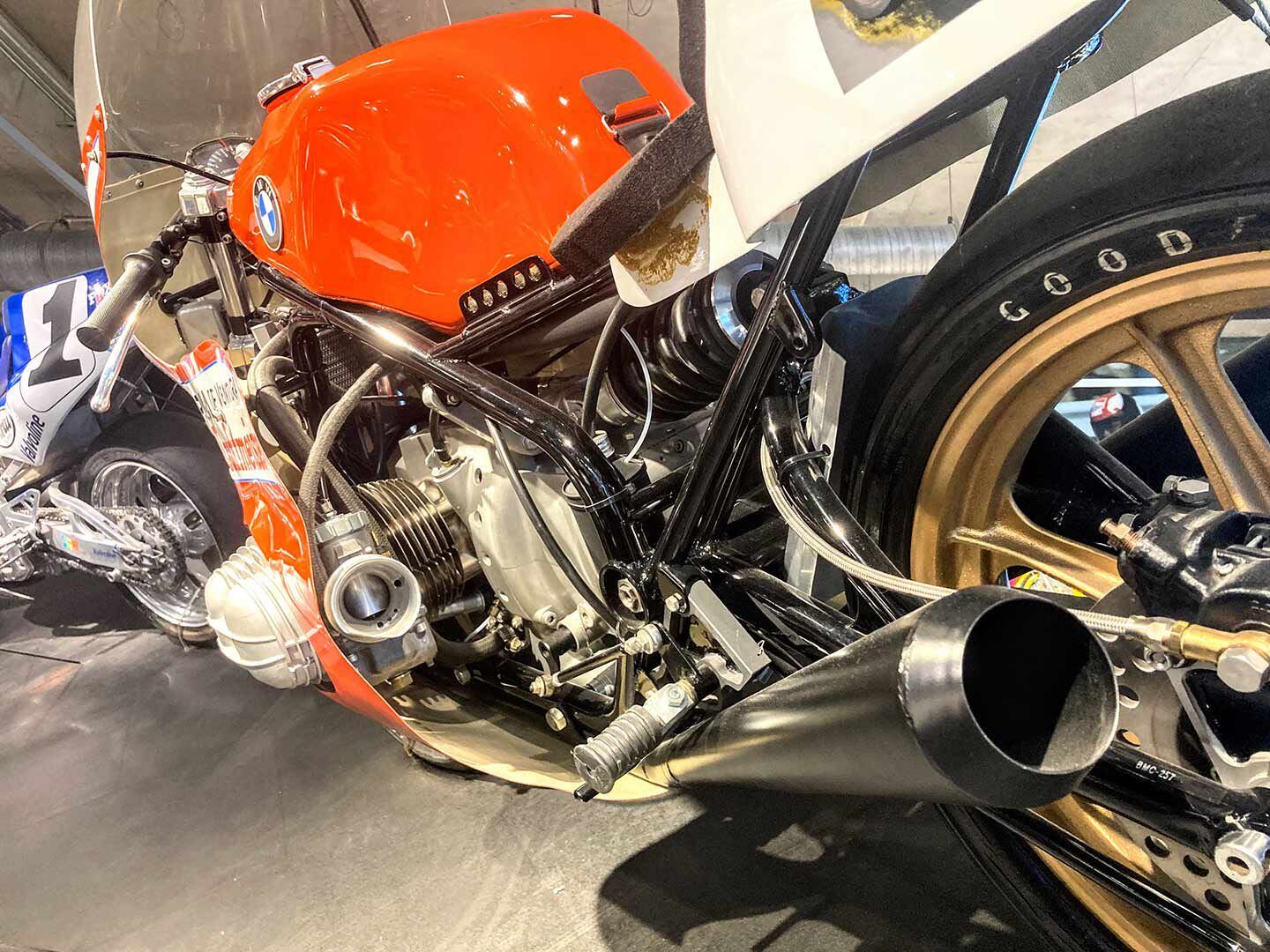
Just 25 inches separate hellacious amounts of air getting sucked in from howling exhaust. 1974 BMW F-1 AMA racebike designed by famed builder Rob North. (Anders T. Carlson/)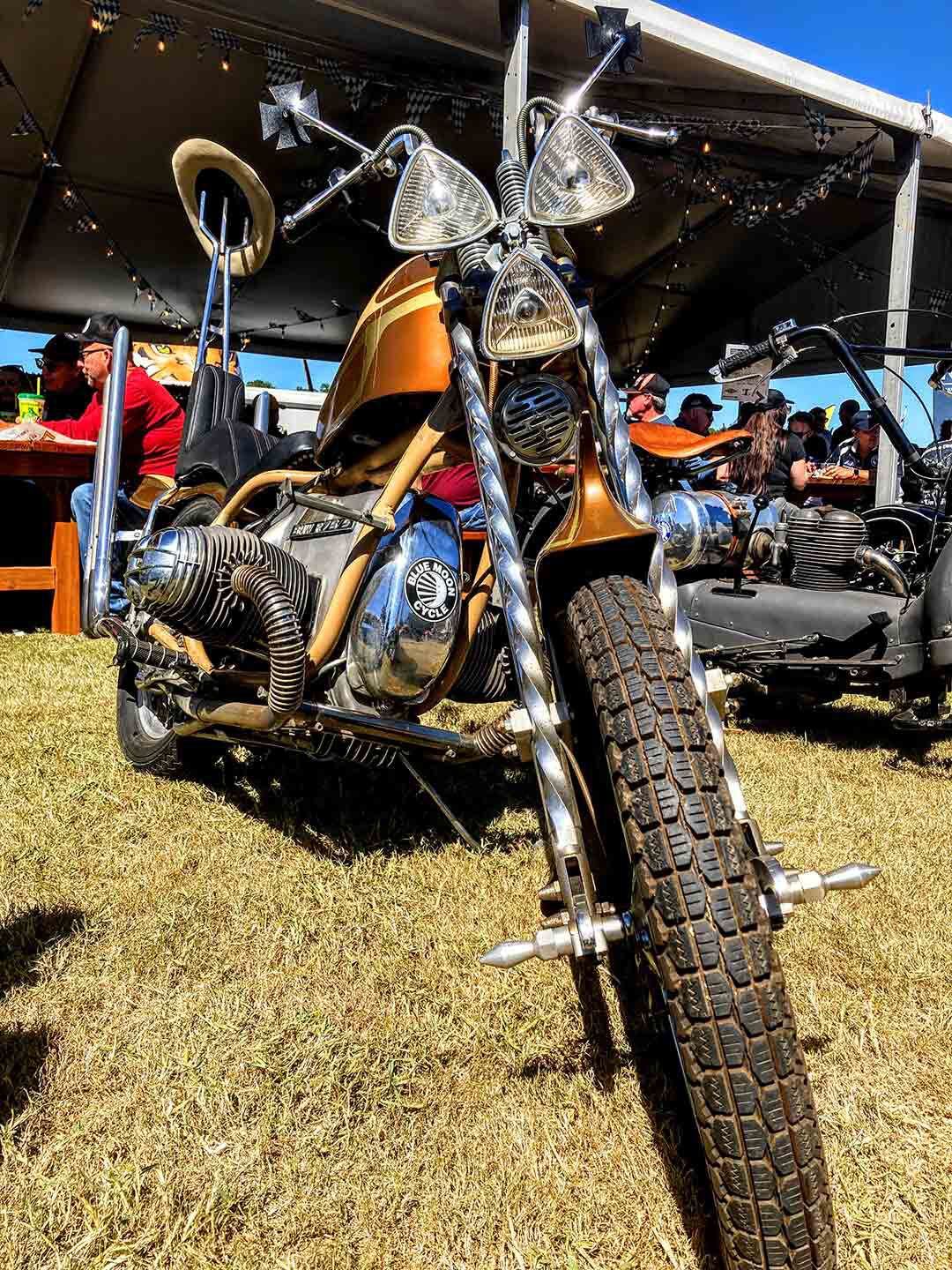
Early inspo for the R 18? Likely not. R 75/5 chopper takes center stage at the BMW Motorrad Days Fun Zone bike show. (Anders T. Carlson/)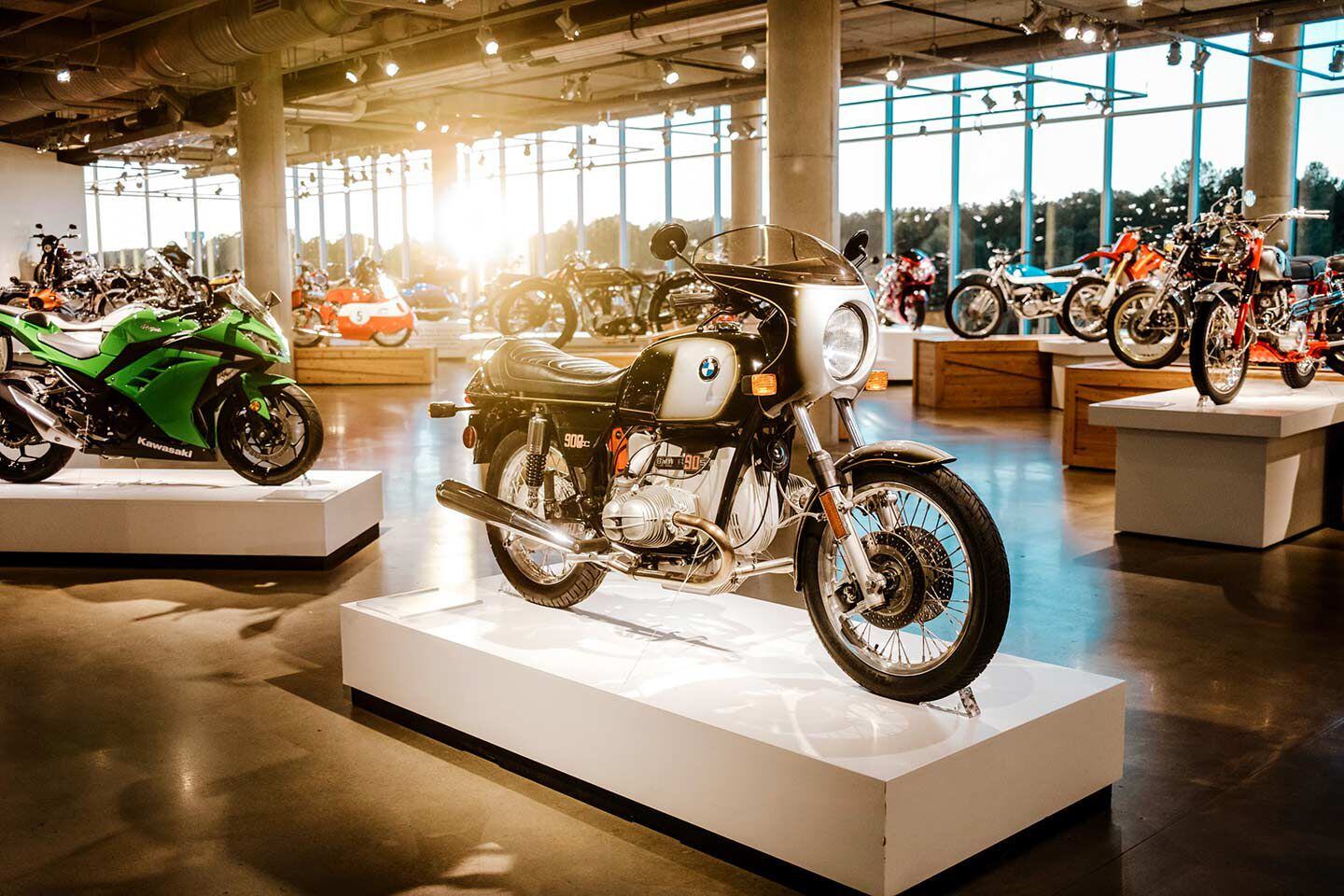
A BMW R90S gets an afternoon glamor shot in the Barber Motorsports Museum. (BMW/)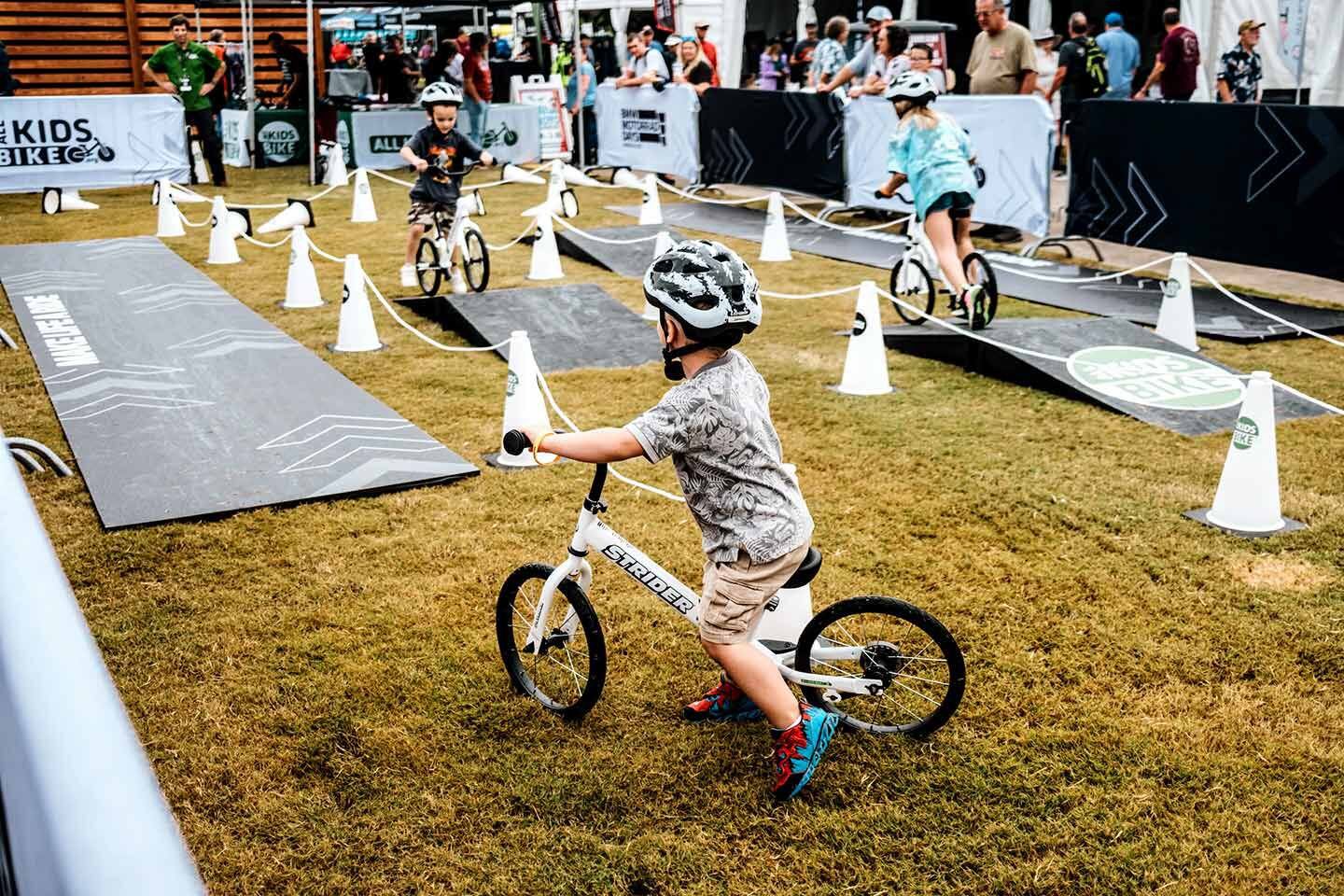
Little ones grow up to be big ones. BMW makes sure kids get in on the fun with e-bikes and cones. (BMW/) -
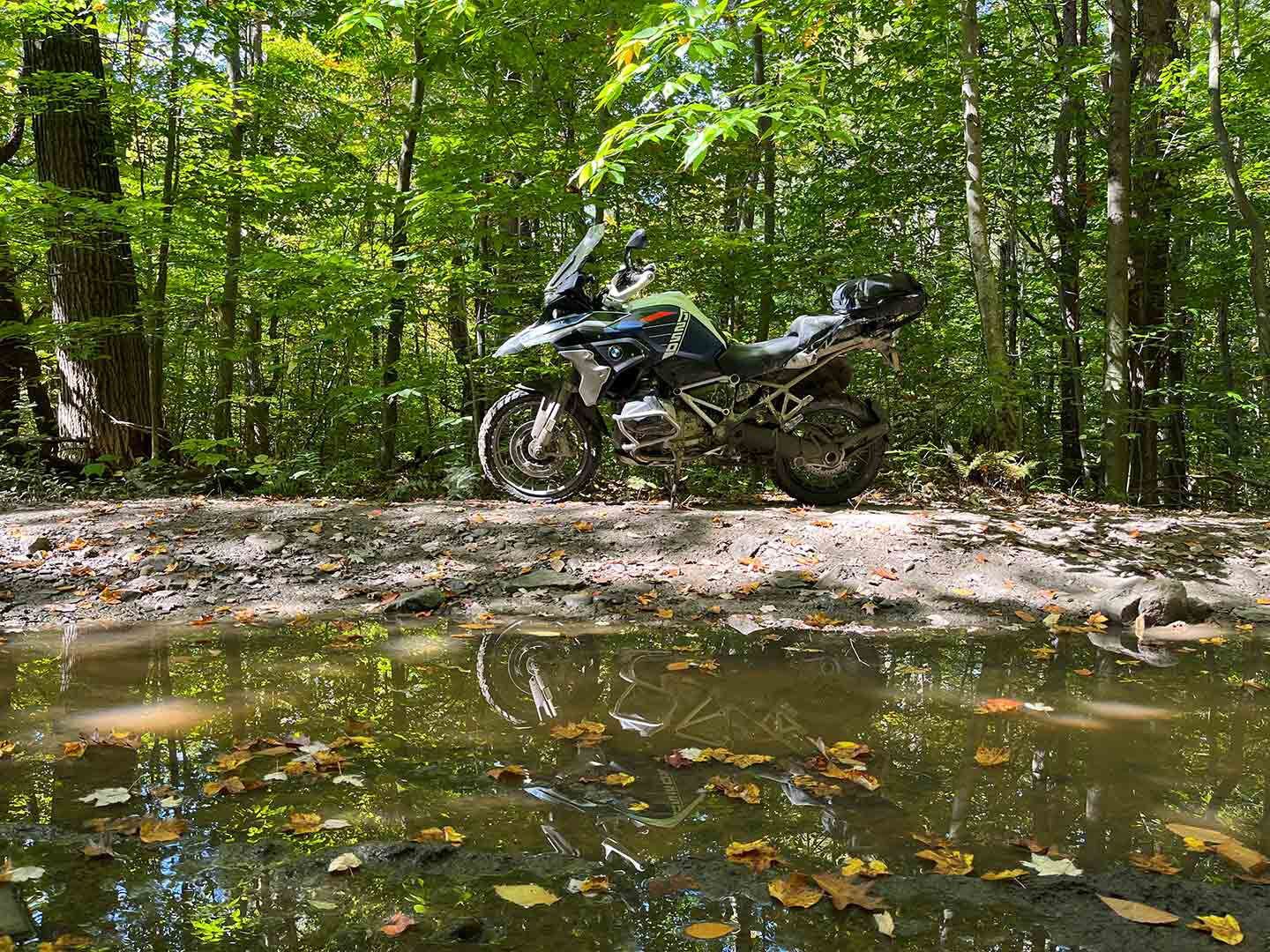
The 2023 BMW R 1250 GS. (Seth Richards/)As we complete our first ride of the R 1300 GS, we reflect on some of the qualities that make the current R 1250 GS—and the entire lineage of GSs—a surprising gateway into adventure riding.
The GS’ dual nature is right in its name: Gelände and Strasse, “Terrain” and “Road.” Its capability as a roadbike is legendary. It’s user-friendly, refined yet engaging, effortless to push hard in the twisties, and comfortable for pilot and passenger on long stretches of highway. While there are a million reasons why 1 million boxer-powered GSs have sold since the R 80 G/S’ debut in 1980, its prowess as a streetbike just may be at the top of the list.
Related: Gelande/Strasse
Yet, if the GS was only ever meant to go on the street, it would be an RT. Somewhat paradoxically, the very traits that make it a great everyday streetbike also go a long way toward giving it a distinct identity off-road. The magic of ride modes, each with its own traction control setting, throttle map, and suspension damping (not to mention self-leveling preload) is certainly beneficial here, but there’s more to it than that.
While proper riding techniques transcend model type, the GS’ design facilitates a very particular mode of engaging with it. For riders who are new to the adventure bike game, or for GS owners who’ve never ventured off-highway, it’s an amazingly approachable entry-point—keeping in mind it’s still heavy, expensive, and not a Yamaha TW200. Sure, there are more approachable and capable adventure bikes for riding high-speed rally-style, but in slow-speed technical terrain, the GS is at home. With respect to the limits of physics, here are five ways the GS will encourage you to hone your skills and explore some gelände.
The Shape of a Boxer
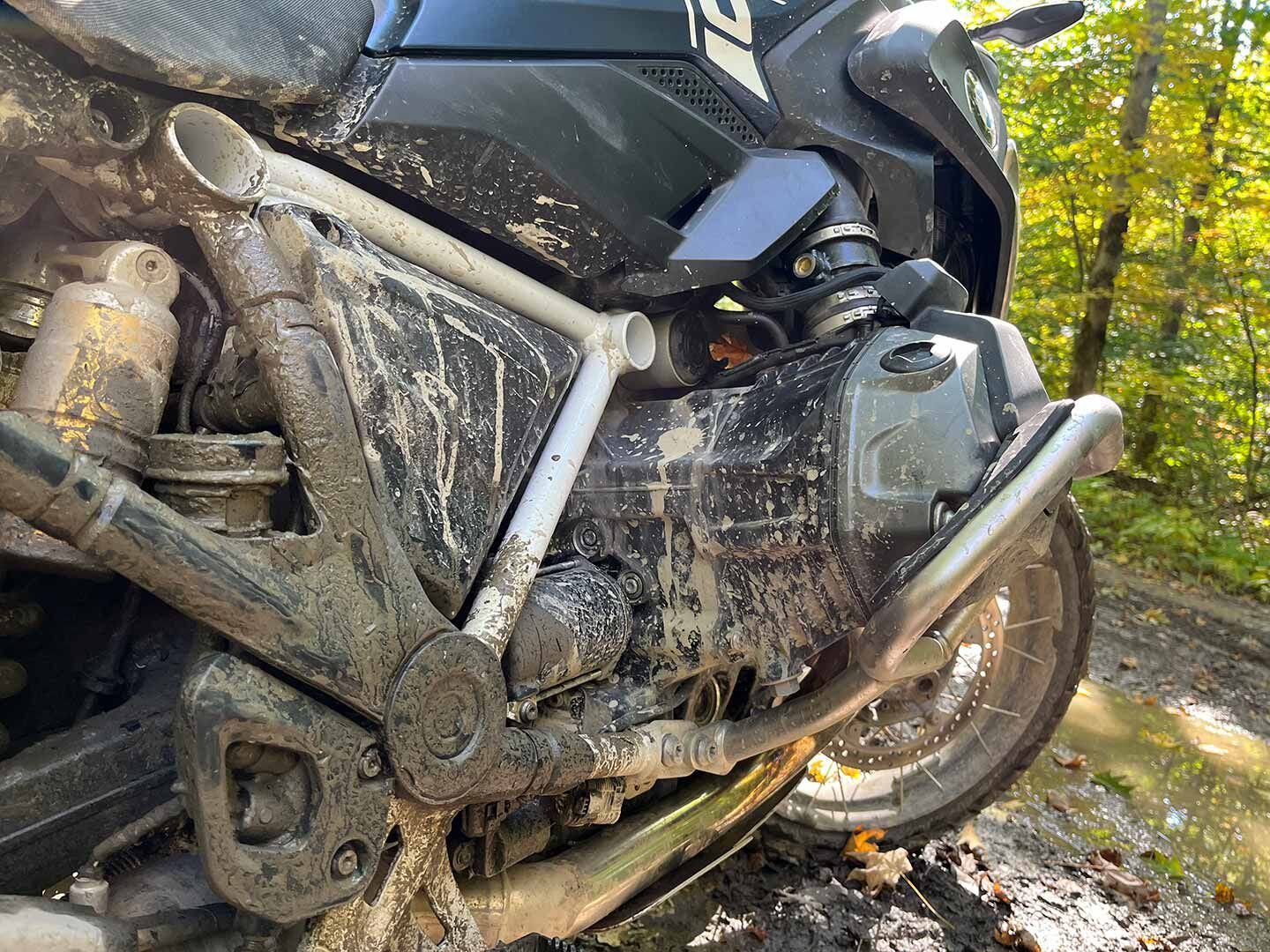
The GS’ cylinder with a coating of mud. All is right with the world. (Seth Richards/)As Kevin Cameron points out, one of the main benefits of an opposed twin is balance. Because its two crankpins are spaced 180 degrees apart, the shaking forces of piston motion cancel each other out. For off-road riding, where slow-speed maneuverability is paramount, another huge benefit of the layout is that the cylinders sit next to the crankcase instead of on top of it, creating a very low center of gravity.
Due to having long-travel suspension and large fuel tanks that sit high up—especially above an inline- or V-configured engine—some ADV-tourers can feel particularly vulnerable to changes in rotational motion; getting them off-center at low speeds can be dicey. In comparison, a boxer-powered GS feels far less cumbersome. The GS’ outriggerlike cylinder heads give tremendous stability—for the same reason a trapeze artist holds a long pole on the wire.
Related: Trophy Life—Training for the BMW GS Trophy With Ben Phaup
For riders who are venturing off-road for the first time or touring with camping gear and several days of food stowed on board, the GS’ low CG is hugely confidence-inspiring. Despite its big-bike stature, the GS is stealthily accommodating to riders of varying skill levels. As Executive Editor Justin Dawes points out in the 2021 open-class adventure bike shootout, “When the going is slow and technical, the GS shines. It seems to balance all by itself even at walking speeds, allowing riders to pick a line and and then pick it apart.”
Still, like all heavyweight adventure-tourers, riders must use their own bodyweight to their advantage. On a lightweight single-cylinder dual sport, riders can get away with a lot, but on a 600-pound ADV bike, gravity can become their enemy quickly. Here, the GS’ flat engine is once again an asset. In low-speed maneuvers, it affords riders a platform on which they can drop their outside knee to assist in counterbalancing the bike, preventing it from tipping over. Its built-in knee “rest” takes thinking about body position out of the equation to a large degree, making it automatic and repeatable. In this way, the GS’ design accommodates its proper usage. Its own shape dictates the shape the rider’s body makes and frees up mental space. As a bonus, when the bike does fall over, it only falls over halfway. It takes far less effort to lift it off its cylinder head than lifting a lighter bike that’s buried its handlebar in the dirt.
Low-Down Torque
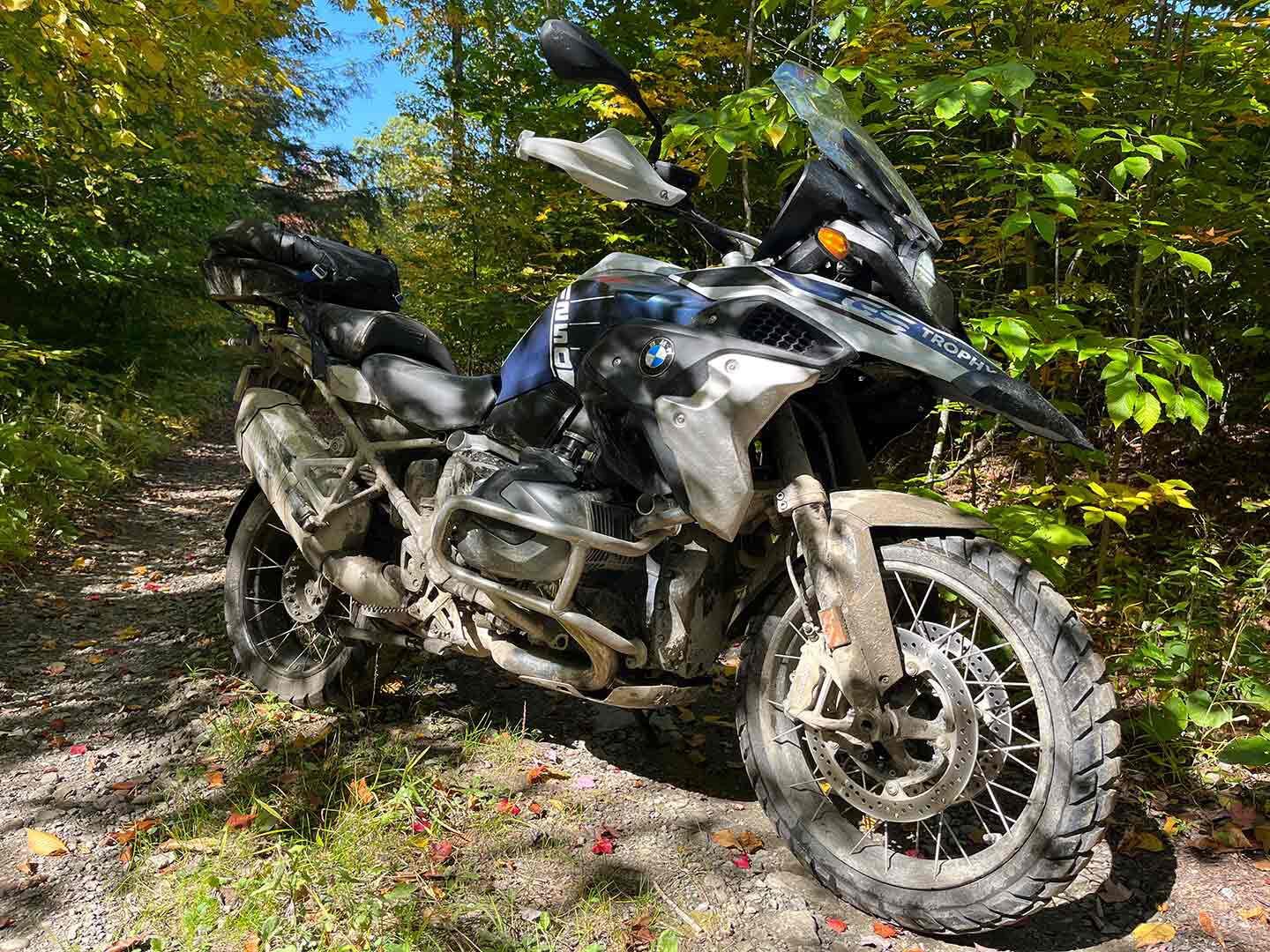
The more time one spends on the GS off-road, the more it feels like that’s where it really belongs. (Seth Richards/)The last time Cycle World put an R 1250 GS on the dyno it recorded 91.48 lb.-ft. of torque at 6,510 rpm. Impressively, nearly 80 lb.-ft. were available at only 2,000 rpm. In other words, the engine can chug along at idle all day, as the speedo registers 6 mph or so. At the same speed or rpm, plenty of other engines would require slipping the clutch. Such tractability gives riders the ability to run in a taller gear in rough terrain, which can help them make smoother throttle applications. Charging up hills with little run-up, breaking the rear wheel loose to make a corner, lofting the front wheel with just a blip of throttle: the benefits are practically endless. For inexperienced riders, that low-down torque can be a safety net.
Smooth Throttle Response and Linear Power Delivery
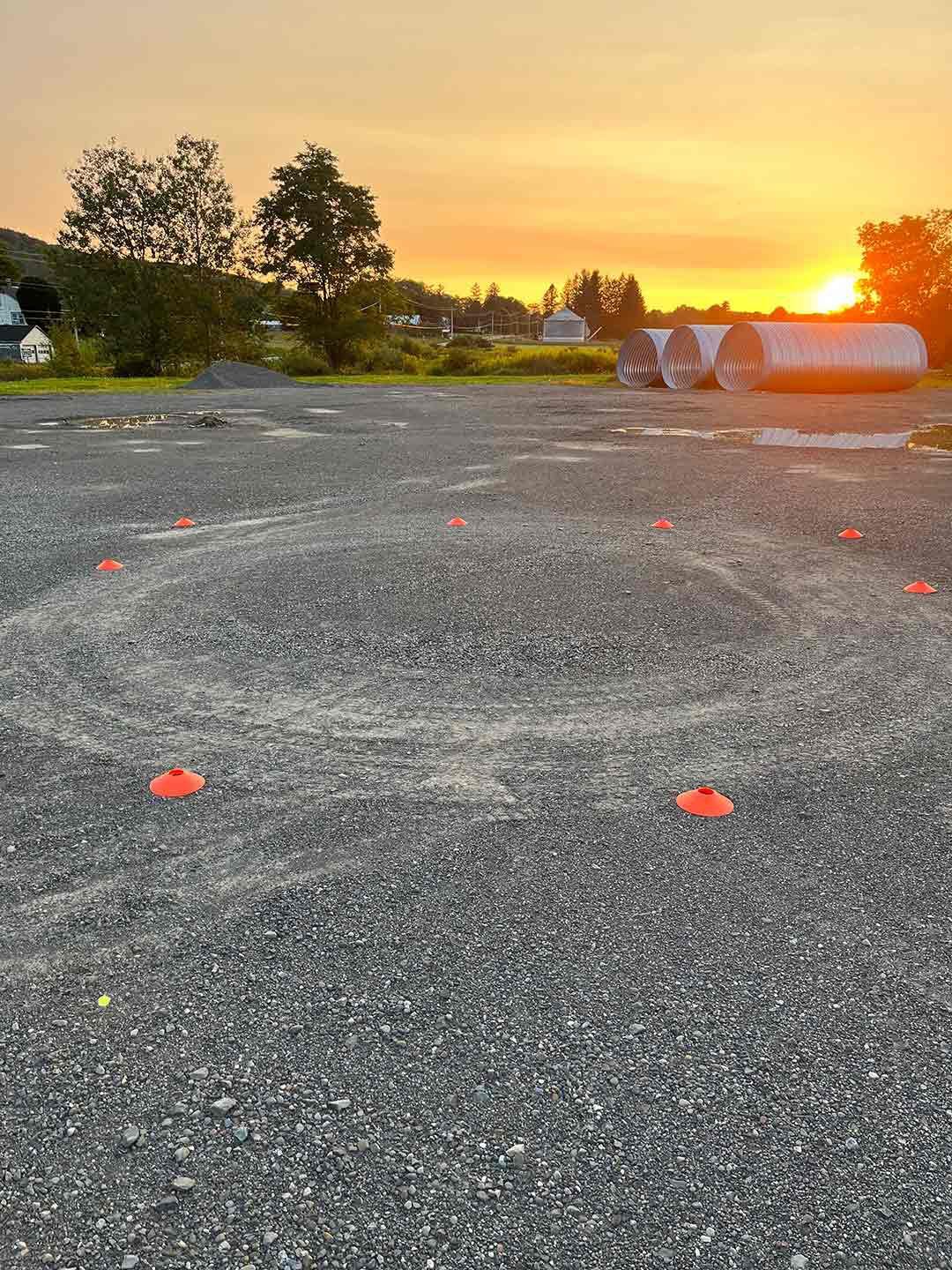
Cones set up at the local highway department for practicing 16-foot box turns. The GS excels at slow-speed maneuvers. (Seth Richards/)The GS’ on-off throttle response is about as close to perfect as you’ll find this side of internal combustion. While power delivery is altered in its various ride modes, even at its most direct (in Dynamic modes), it’s buttery smooth from the moment the throttle butterflies open. Such clean throttle response helps riders give smooth inputs at the throttle, which in turn keeps the chassis settled.
On top of that, a glance at the dyno confirms the GS’ linear power delivery. While critics complain that the boxer engine isn’t as exciting as one that paints the dyno chart with peaks and valleys, when it comes to rideability, that’s for the best. Those peaks and valleys may make for an exhilarating ride, but come at the cost of traction. While modern rider aids can intervene to smooth a killer powerband, a naturally linear one that doesn’t break traction in the first place is still a better way to drive forward. When traction is at a premium off-road, the GS’ linear power delivery and smooth throttle response give the rear tire a fighting chance to get a grip.
Progressive Clutch Feel
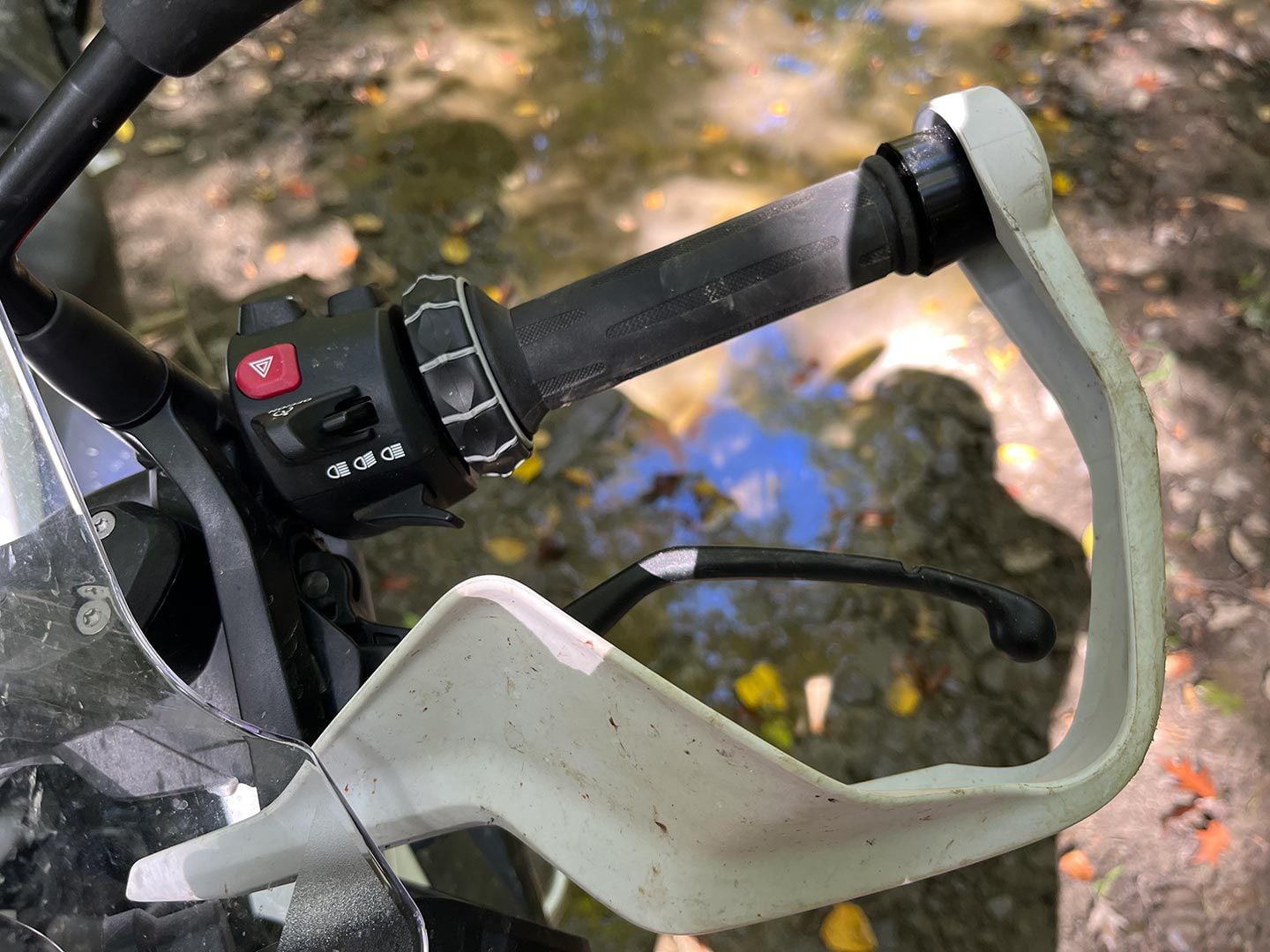
A rider’s best friend. (Seth Richards/)The slowest-speed maneuvers don’t require using the throttle, but to keep momentum, riders need to rely on the clutch for drive. To live happily in the clutch’s friction zone requires progressive clutch engagement and good feedback at the lever. The GS excels in both regards. Some hydraulically actuated clutches are notorious for having small engagement zones, which is mostly fine on the street, but when doing U-turns or riding off-road, requiring feathering the clutch, it can be difficult to effectively work the friction zone. The GS’ clutch has a broad, linear engagement zone that gives riders one less thing to think about as they weave through tight single-track at single-digit speeds. For riders new to going off-road, once again, the less there is to think about, the better.
Generous Steering Lock
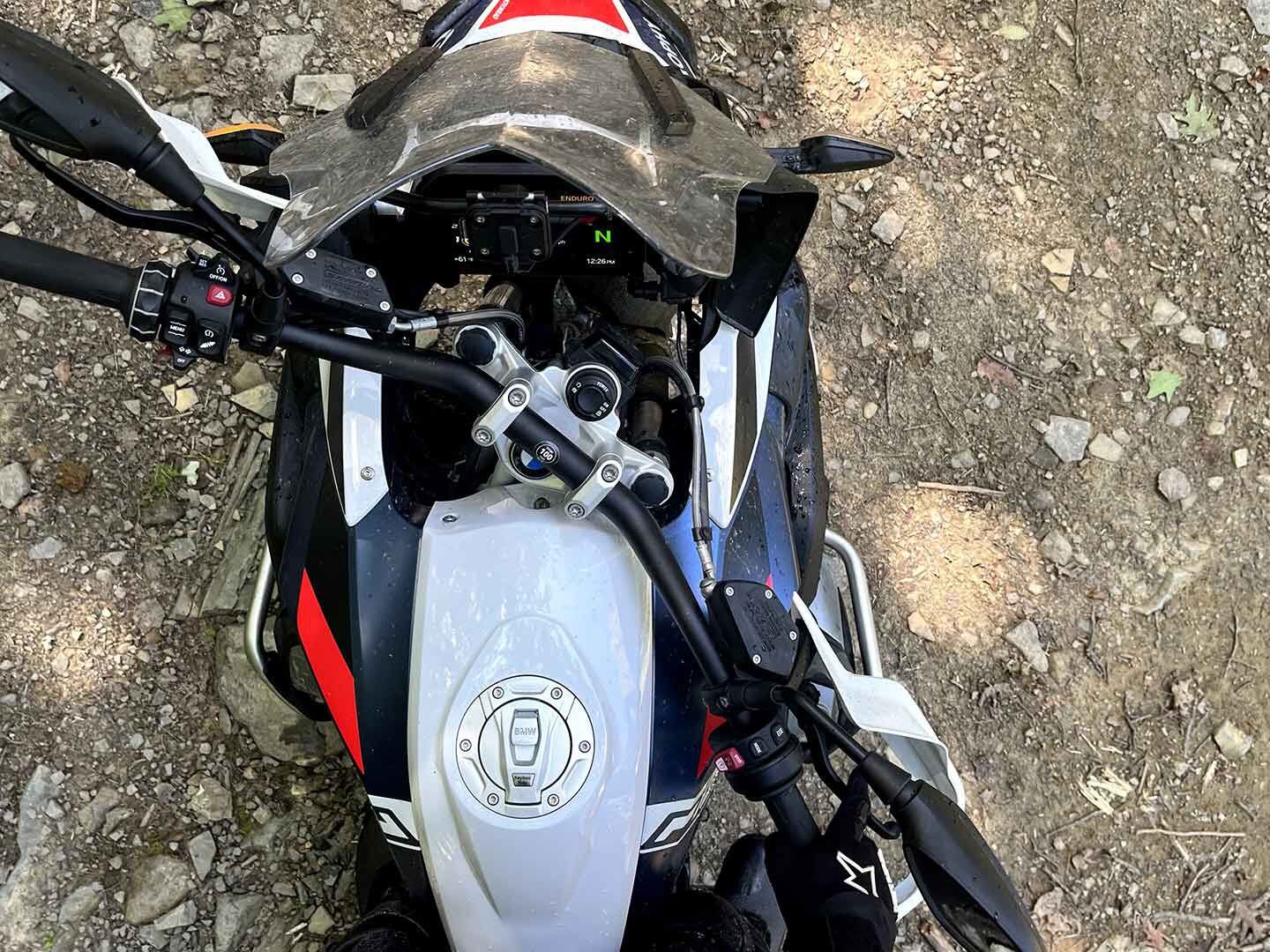
Another GS strength is just how far those bars turn. (Seth Richards/)Sweep the GS’ bars from lock to lock, and revel in how far they swing. There aren’t many motorcycles as adept at doing tight maneuvers as the GS simply because they don’t have the same degree of steering lock. For first-time GS riders, it can even take some adjusting to realize just how far the bars turn. Off-road, a tighter turning radius comes in handy no matter how good you are. When the trail is blocked or you just have to wave the white flag and turn around, that tight turning radius can help you conserve a whole lot of energy.
-
I attended Eicma 2023 which is held in Milan, Italy in Fiera Milano or “The Milan Motorcycle Show” as it’s sometimes known. It is one of the largest events in the motorcycle industry with over 500,000 annual visitors and where a lot of manufacturers use this show to launch new bikes and products.

I have not been here before so I was really excited to see what all the fuss was about. For those of you who have never been before, the show is huge and I mean huge! It is held over several halls and you should be prepared for lots of walking!!
I would say this is more of a trade show and exhibition that is open to members of the public to attend, you may be able to purchase the odd t-shirt or hoodie but generally manufacturers are there to showcase their new products, they are not available to purchase at the show.
I thought I’d share with you my top ten picks of bikes from the show. There was an incredible amount of bikes to choose from, so some of you may disagree with my choice, let’s see……
Number 10: Kawasaki 2024 Ninja 7 Hybrid – Price tbc
I like this because it is innovative in that it is both fuel and battery powered. Kawasaki refers to this as a strong hybrid system which ‘combines an internal combustion engine (ICE) with an electric motor for powerful riding, and because of their large battery capacity they are able to run on electricity alone’.

The Ninja 7 Hybrid has a liquid-cooled, 4-stroke parallel twin 451 cc engine and a Lithium-ion battery pack giving you the instant acceleration of a 1,000 cc class bike from a standing start (with e-boost).
There are 3 riding modes to choose from – Sport-hybrid; Eco-hybrid and low-speed short-distance EV.
The Ninja 7 Hybrid has a walk mode with reverse to help when moving the bike – opening the throttle moves the bike forward at walking speed and closing the throttle past the zero point moves the bike in reverse.
This is an excellent mode in my opinion as maneuvering an electric bike can be quite difficult as of course you have no clutch lever in which you can ‘slip the clutch’.
The bike weighs 227 kg (the battery itself weighs 13 kg) and will have a seat height of 795 mm.
I would be interested to see what this bike is like to ride and if you have ‘range anxiety’ which I have experienced with other fully electric bikes.
Oh, and the Ninja 7 Hybrid does look incredibly cool

Number 9: Ducati Hypermotard 698 Mono – Price tbc
The Hypermotard 698 Mono is Ducati’s first single-cylinder road-going Supermotard.
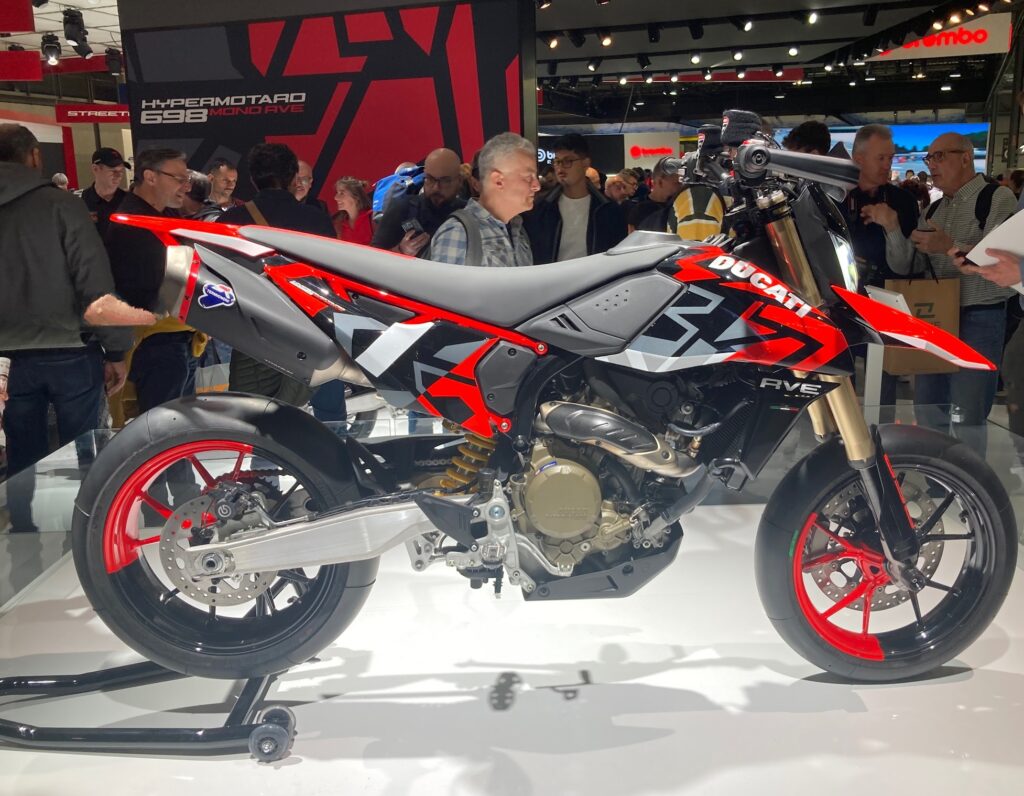
The 659 cc Superquadro Mono engine with desmodromic timing, Ducati say, is their most sophisticated and high-performance single-cylinder road engine ever built and is able to achieve the highest engine speed in its category.
The Hypermotard 698 Mono has a straight double-sided swingarm with a high fender with the rear fairings wrapping around the exhaust. I love the look of the twin silencers which are mounted high up on either side of the tail.
Now this is not a bike for those of us with a shorter disposition – the standard seat height is 904 mm with a low seat option of 889 mm available. At 5’6” I would need the use of a step to get on this bike!
Interestingly, the RVE livery option of this bike was voted ‘Most Beautiful Bike of Eicma 2023’ by the public. I’m not sure I would agree with this.
Number 8: Royal Enfield Himalayan – price tbc
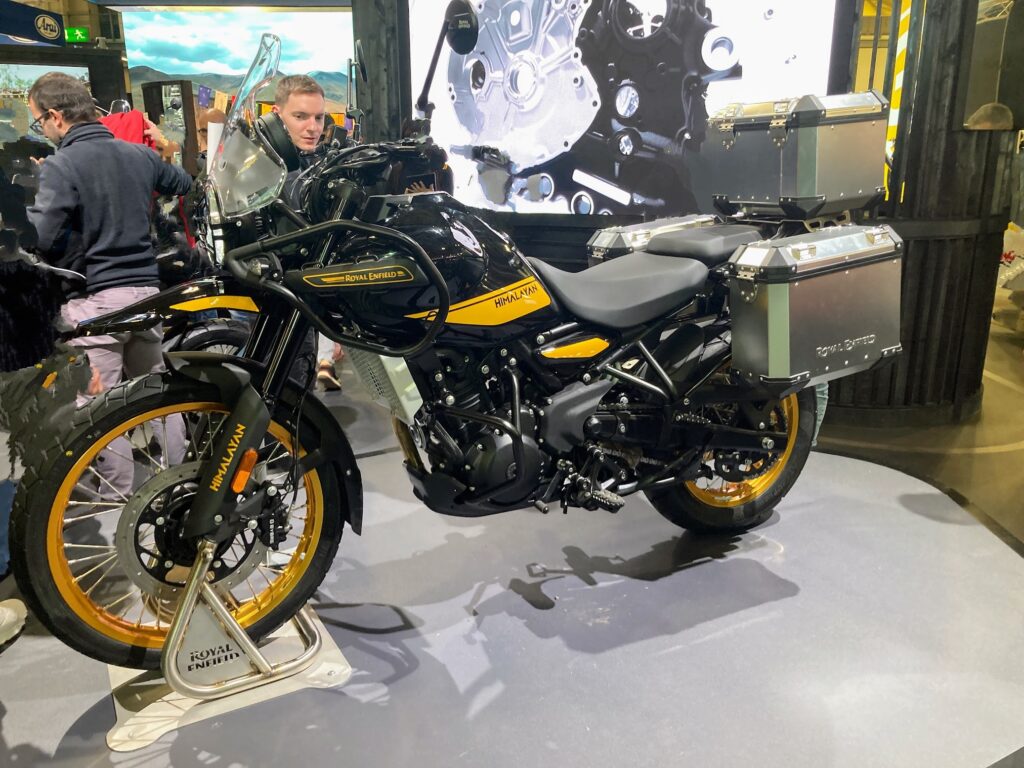
The new Himalayan has Royal Enfield’s first liquid cooled engine, a Sherpa 450 and is their lightest and most technologically advanced vehicle integrated powertrain.
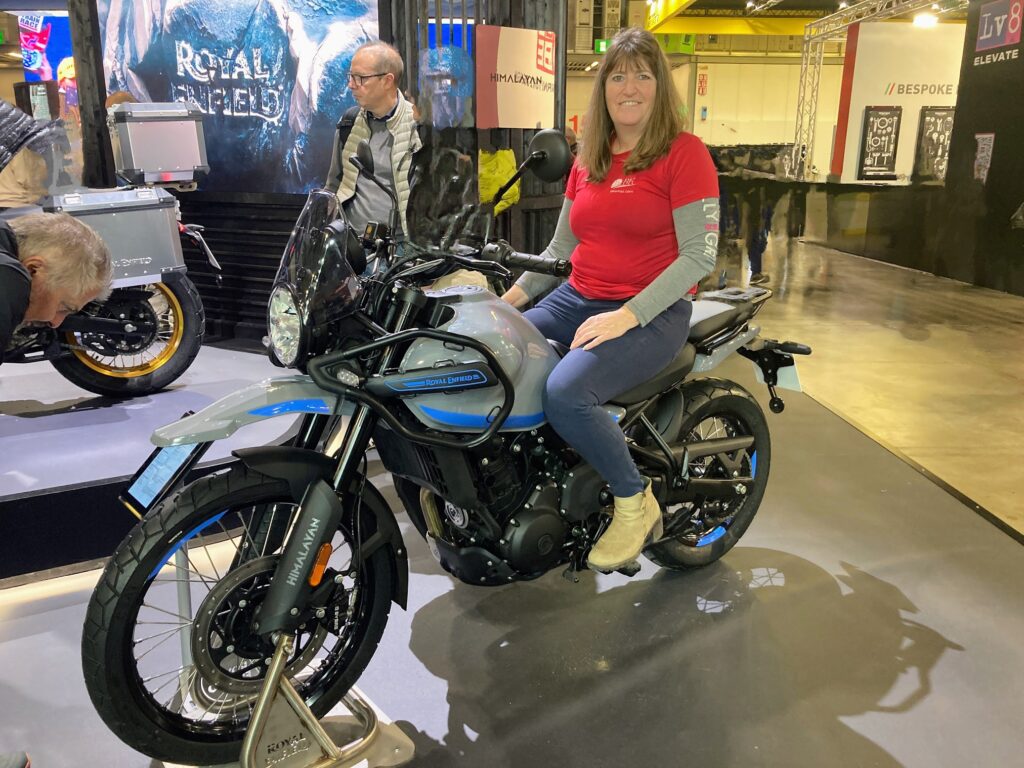
With upside down front forks, ride-by-wire throttle and TripperDash full map navigation tft display, this bike is ready for adventure.
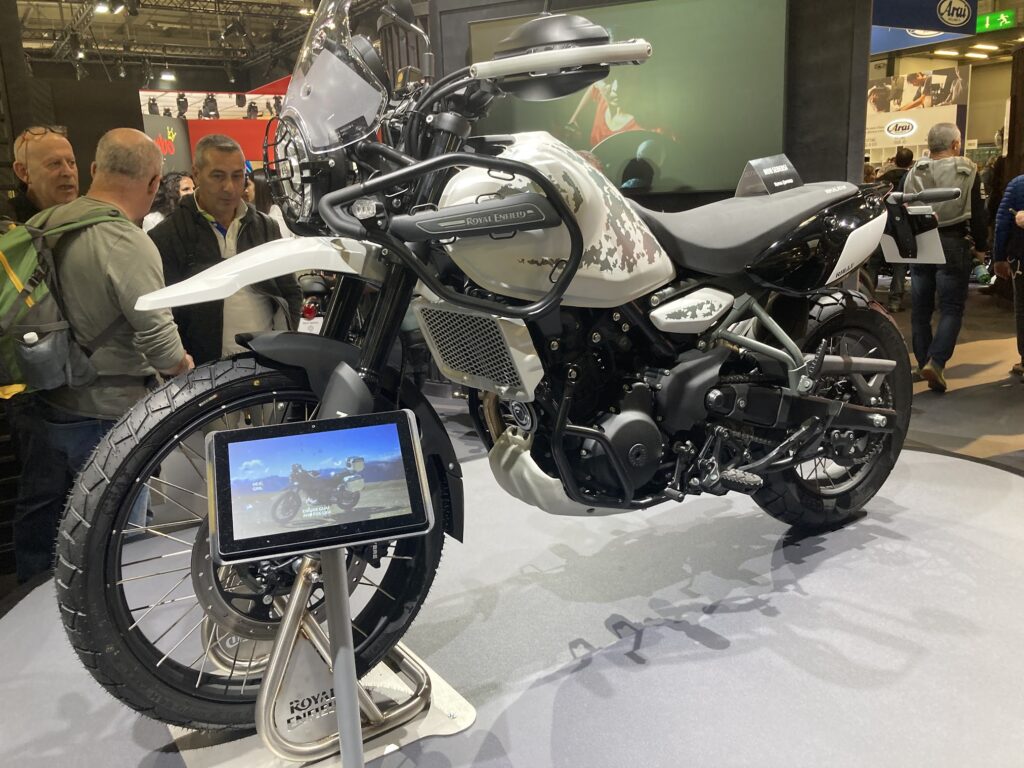
The original Himalayan bike was inspired by the 60 year old tradition of exploring the Himalayas on a motorcycle and was born in the Himalayas. How good would it be to see this for yourself – an adventure on an Himalayan in the Himalayas.
Some great colour options available too and with a comfortable riding position. This bike garnered a lot of attention at the show.
Number 7: Aprilia RS 457 – price tbc

The Aprilia RS 457 is powered by a liquid-cooled twin-cylinder engine with dual camshaft timing and four valves per cylinder capable of 35 KW of power which of course is the maximum for those riding on an A2 licence.
With 47 hp and weighing 159 kg (dry weight), the RS 457 has great power-to-weight ratio.
With full LED lights with integrated turn signals (I absolutely wish these came as standard on all bikes!), a 5” tft colour screen and the handlebar controls being backlit.
This is a seriously cool looking bike and does not look like it is only a 47 hp bike.
Number 6: Suzuki GSX-8S – price from £8,199
You can choose the faired (8R) or unfaired (8S) options here. Personally I would go for the unfaired but I know this will probably divide opinions!
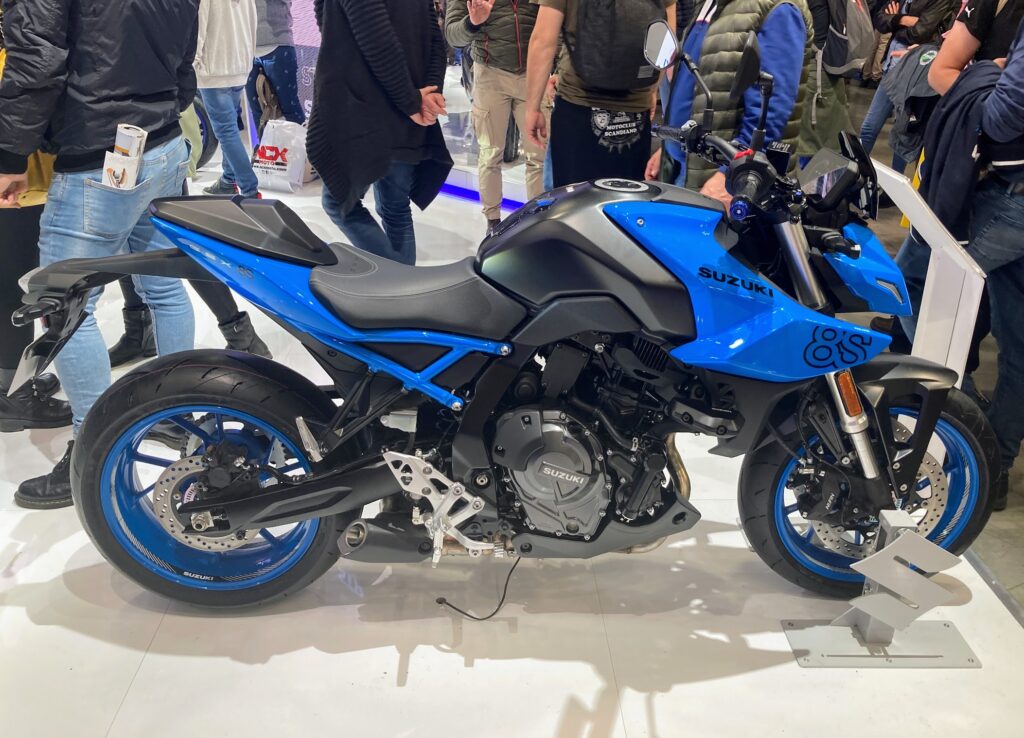
With 83 bhp and 78 Nm of torque, the 8S has an all-new 776 cc DOHC two cylinder liquid cooled 4 stroke parallel twin engine. The 8S has a seat height of 810 mm and a kerb weight of 202 kg.
With Suzuki Intelligent Ride System (SIRS) (a collection of advanced electronic rider assist systems) and a 5” colour tft display, the tachometer doubles up as a programmable rpm indicator light that blinks when the engine reaches a pre-set speed and a function that lets you display large pop-up alerts and reminders.
There are three colour options available – Pearl Cosmic Blue, Pearl Tech White or Metallic Matte Black. Personally, the blue is by far my favourite.
The 8R – price tbc, also has the new 776 cc engine with 83 bhp and 78 Nm or torque so really it is a question of personal preference.
Number 5: Moto Guzzi Stelvio – price tbc
The Stelvio garnered a lot of interest on the Moto Guzzi stand and I can see why. I do like the look of this bike.
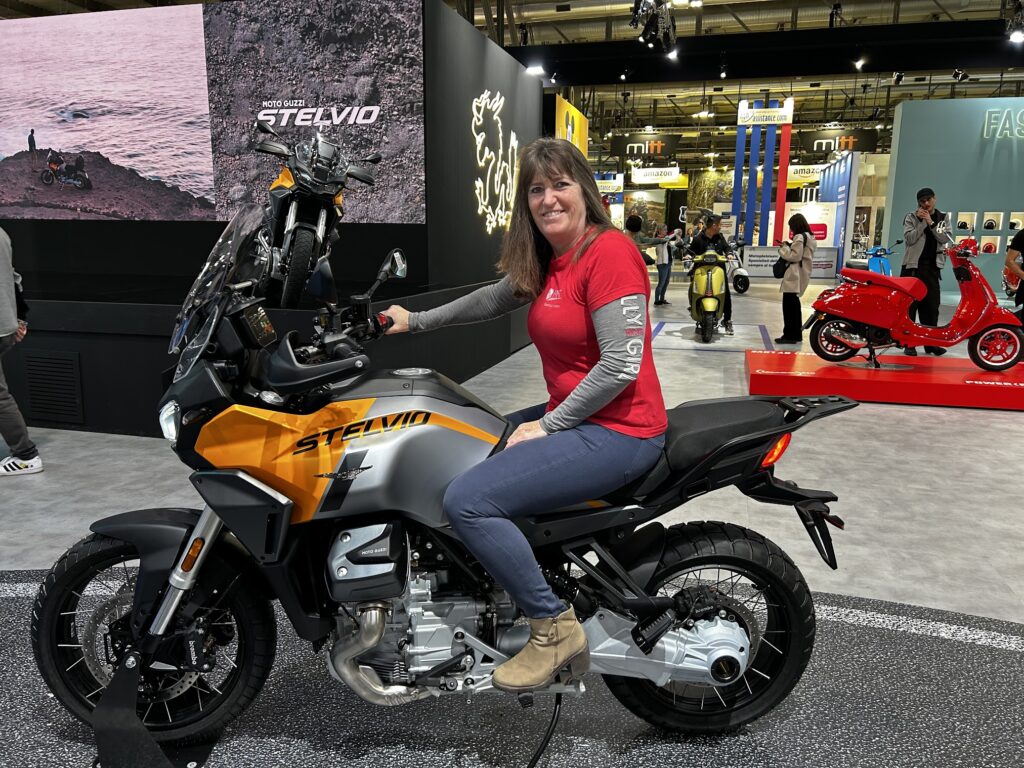
The Stelvio has the Moto Guzzi V-Twin “Compact Block” Euro5+ engine with shaft drive transmission. Its 1,042 cc engine delivers a maximum power of 115 HP at 8,700 rpm and a peak torque of 105 Nm at 6,750 rpm.
Features on the Stelvio include cornering ABS and traction control, cruise control and 5 customizable riding modes – Tourism, Rain, Street, Sport, and Off-Road.
Also on this bike is PFF Rider Assistance Solution using 4D radar imaging technology to provide an exceptionally wide field of vision comprising four different functions: FCW – Forward Collision Warning; FCC – Following Cruise Control; BLIS – Blind Spot Information System; and LCA – Lane Change Assist.
I’d be interested to get out for a ride on the Stelvio, not just to check out all the features but also to check out if the Stelvio’s ‘V’ twin sounds and behaves as previous Guzzi’s

Number 4: Honda CB650R – price tbc
This stylish looking bike comes in two fabulous colours and I can’t decide which actually looks the coolest – matte gunpowder black metallic or grand prix red – I think I’m leaning towards the red

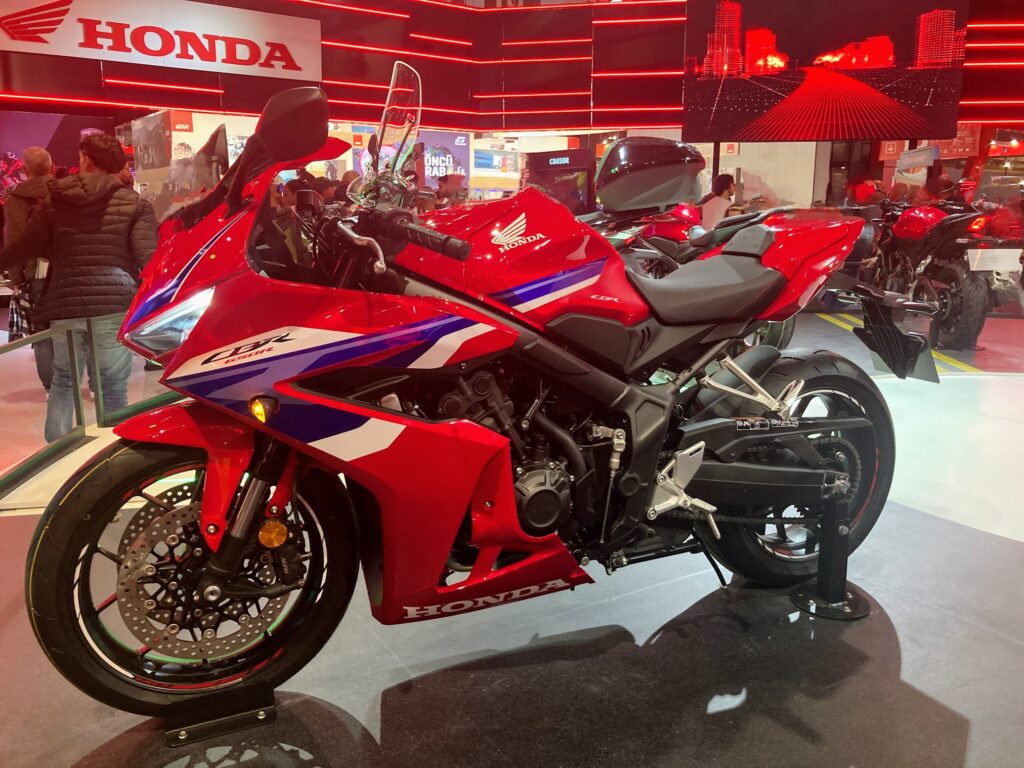
The inline four, DOHC 16 valve engine produces 70kW / 94 hp @ peak – up to a 12,000 rpm redline – with 63 Nm of torque. For A2 licence holders, there is a 35kW conversion available.
Rather interestingly, and unique to Honda, is an E-Clutch option. You have the normal option of manual clutch control or you can choose via the tft screen the E-Clutch option meaning you leave the clutch lever alone. When setting off from standstill, shifting up/down, and coming to a stop, all you need to do is operate the gear lever, E-Clutch does the rest.
I would like to try this, it sounds interesting and I would really like to experience this.
Number 3 (there are 3 bikes in this one as I couldn’t decide between the 3
 ):
):Ninja ZX-10R 40th Anniversary Edition 2024 – price £17,749
Ninja ZX-6R 40th Anniversary Edition 2024 – price £10,849
Ninja ZX-4RR 40th Anniversary Edition 2024 – price £8,899

To celebrate four decades of performance machines, Kawasaki are releasing for 2024, 40th Anniversary models of the Ninja ZX-4RR; Ninja ZX-6R and the Ninja ZX-10R.
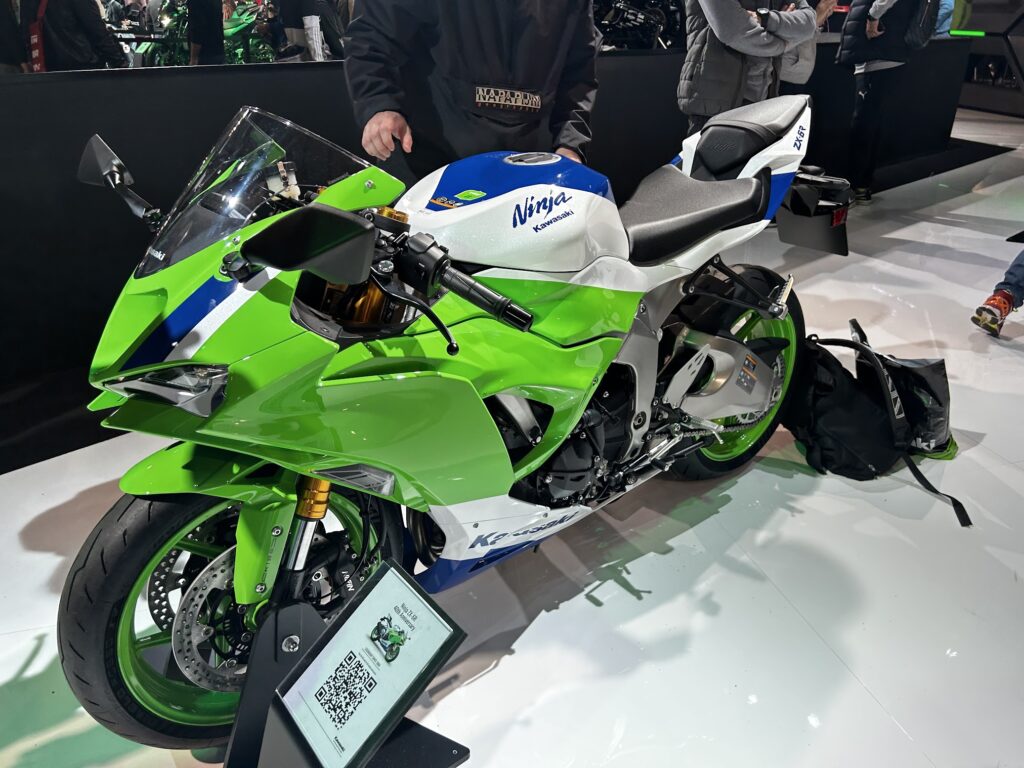
I saw these in the media before I went to Eicma and was excited to see them up close as I was really taken with their liveries.
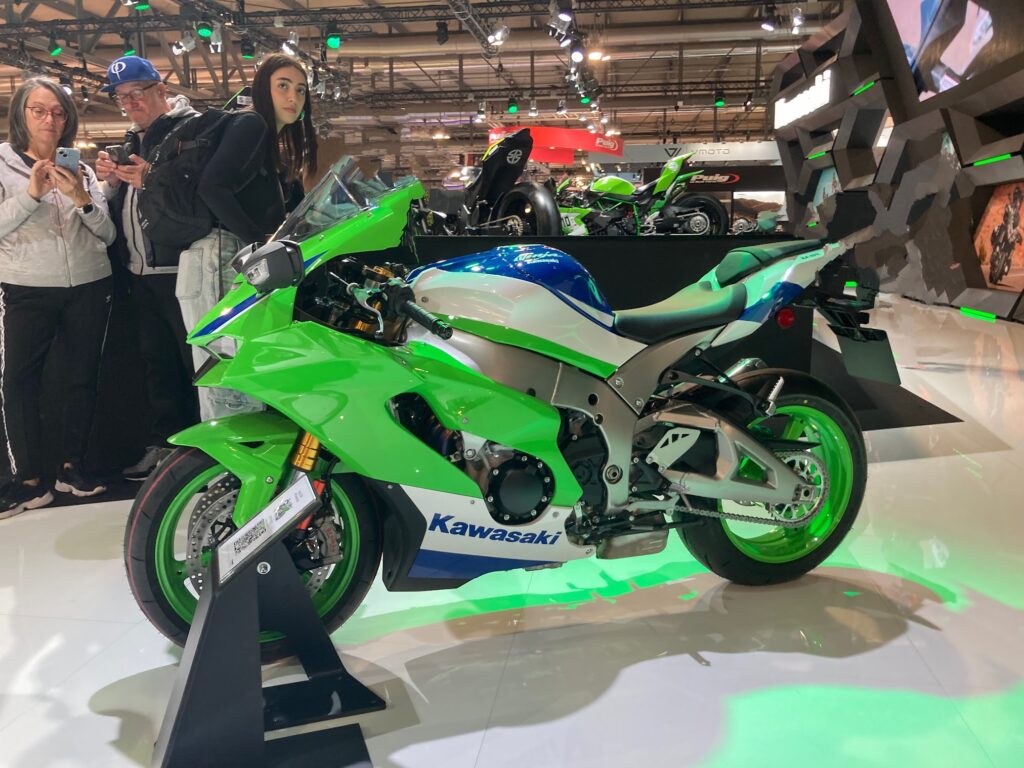
Each of the three models will be available in the early 90’s Kawasaki World Endurance livery of green, blue and white reminiscent of the three-times championship winning bikes of the time.
A few stats for each of the bikes:
Ninja ZX-4RR :
399 cc liquid-cooled, 4-stroke in-line four engine
Max Power : 57 kW {77 PS} / 14,500 rpm
Max Torque : 39 N•m {4 kgf•m} / 13,000 rpm
Curb Mass : 189 kg
Seat Height : 800 mm
Ninja ZX-6R :
636 cc Liquid-cooled, 4-stroke in-line four engine
Max Power : 91 kW {124 PS} / 13,000 rpm
Max Torque : 69 N•m {7 kgf•m} / 10,800 rpm
Curb Mass : 198 kg
Seat Height : 830 mm
Ninja ZX-10R :
998 cc Liquid-cooled, 4-stroke in-line four engine
Max Power : 149.3 kW {203 PS} / 13,200 rpm
Max Torque : 114.9 N•m {11.7 kgf•m} / 11,400 rpm
Curb Mass : 207 kg
Seat Height : 835 mm
These 40th Anniversary models did not disappoint up close, they were sooo much better than the pictures I had seen beforehand. The colours look so good together and the bikes are stunning.
Number 2: Yamaha XSR 900 GP – price tbc
This was very nearly my number 1. I absolutely love the styling and colours of this 900 GP – the legend red. There is a power grey option available but for me, it would be the red.
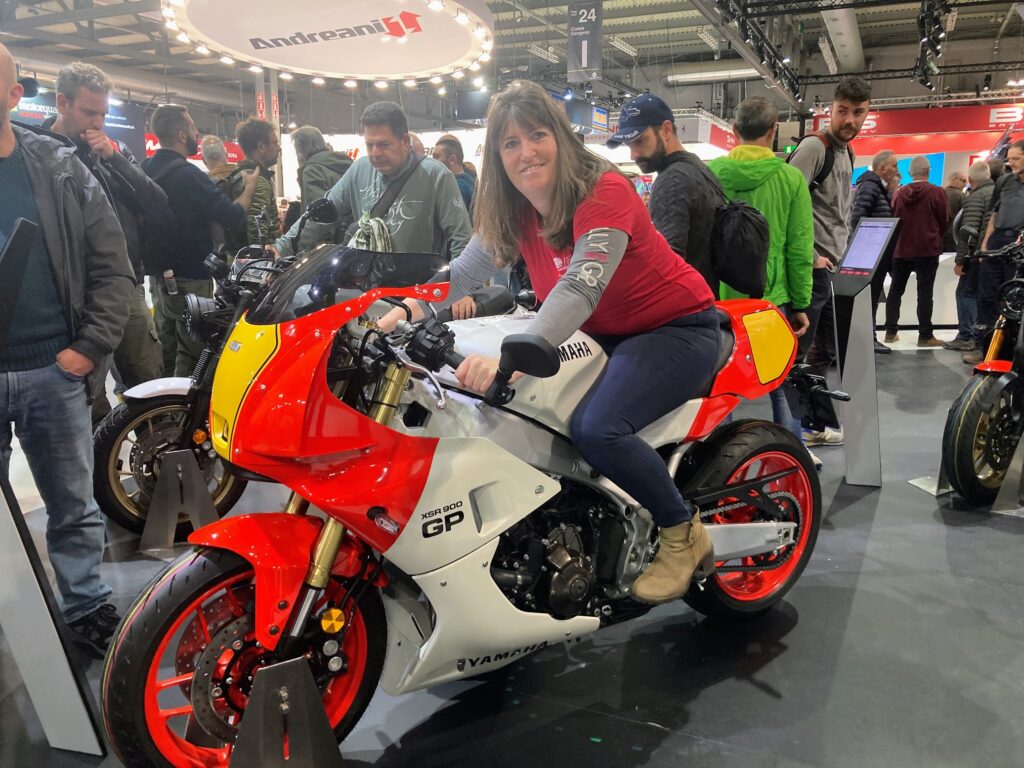
The 900 GP is inspired by the YZR500 racers of the 80’s and 90’s with the front fairing and seat hump iconic of the golden era of Grand Prix racing.
Underneath the fairings of course is Yamaha’s cutting-edge technology with the latest braking and suspension, riding modes and an array of electronics.
The 4-stroke, liquid-cooled, DOHC 3-cylinder 890cc engine has a max power of 87.5 kW (119 PS) @ 10,000 rpm with a max torque 93 Nm (9.5 kg-m) @ 7,000 rpm.
With a seat height of 835 mm this looks like it offers a sporty bike position to ride and with a weight of 200 kg, I think the 900 GP could be huge fun to ride. I definitely need to test ride one of these to find out

Number 1: Bimota KB4 – price £29,995
Okay, I know this is way up there on the price scale but when I saw the KB4 I knew this was my number 1 bike of Eicma 2023.
It is absolutely beautiful



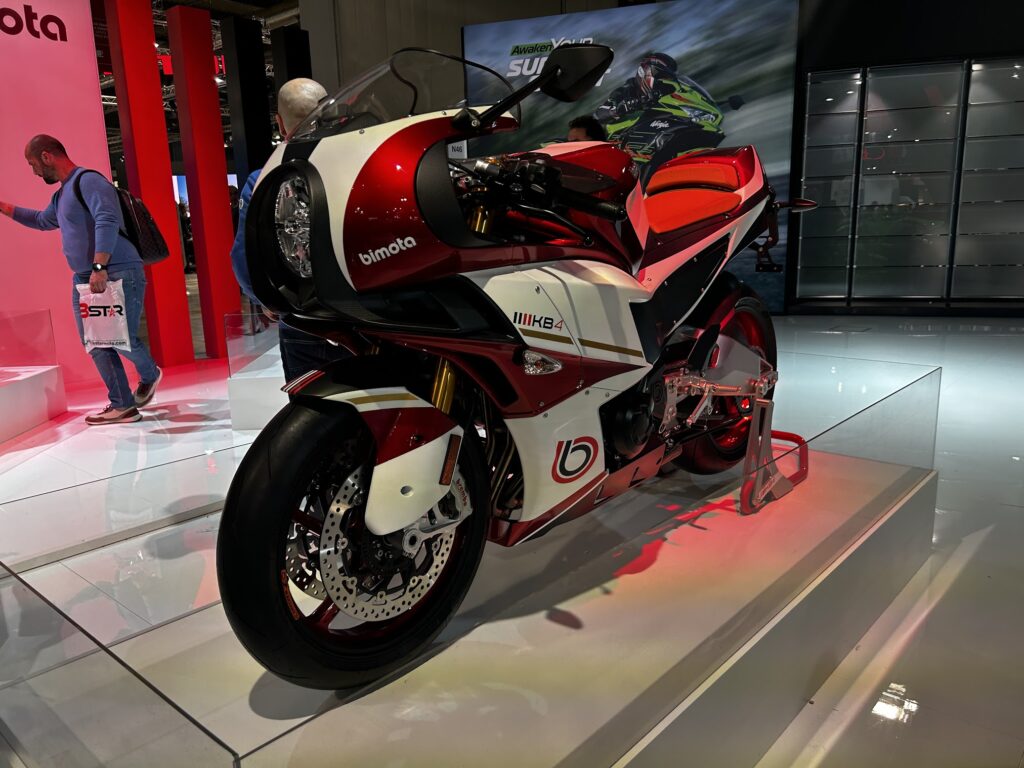
Bimota, who are partly owned by Kawasaki, have an interesting selection of bikes on offer with some lovely engineering.
The KB4 combines the classic design of the Bimota bikes of the 70’s with modern technology and is described by Bimota as a ‘street legal track bike’ with an innovative high pressure cooling system – the one-piece radiator is neatly placed diagonally under the seat unit.
The 4 stroke, 4-cylinder, DOHC 1043 cc engine pushes out 142 bhp with max power of 104,5kW (142HP) / 10,000 rpm and max torque of 111 Nm (11.3kgfm) / 8,000rpm.
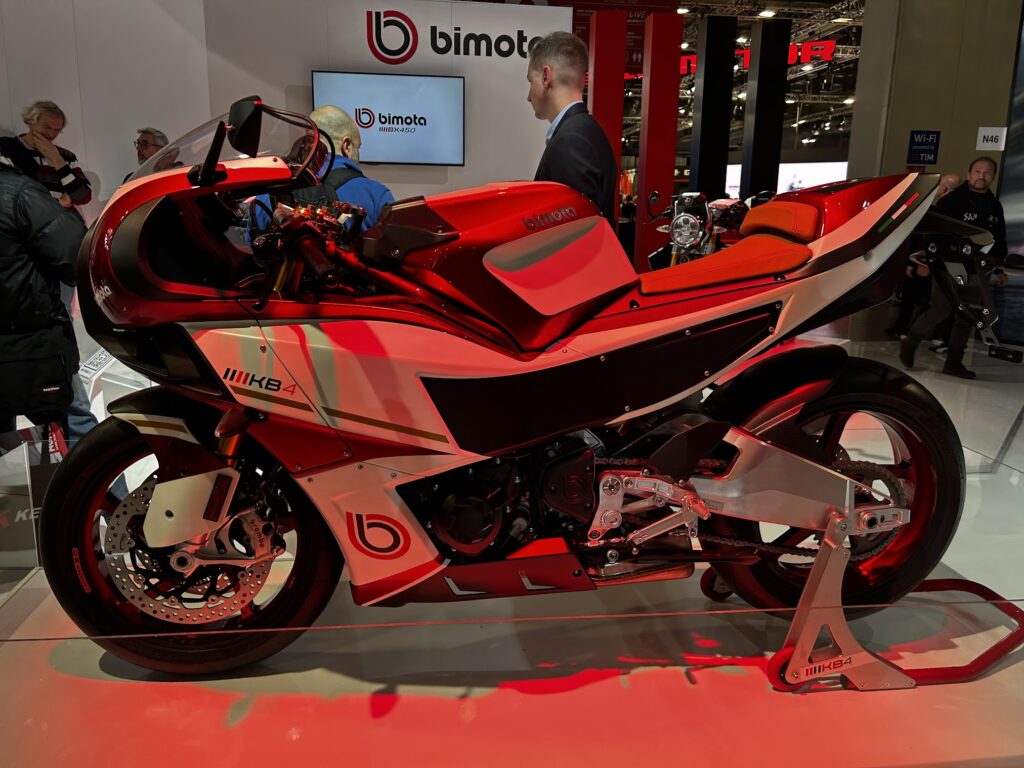
The 810 mm seat height is adjustable plus or minus 8 mm and the KB4 weighs in at just 194 kg.
With Ohlins suspension front and rear, with the rear sporting an aluminium alloy billet swingarm, the KB4 is the perfect modern bike.
I absolutely need to test ride one of these to see if it lives up to my expectations

Well that’s it, that’s my top 10 bikes from Eicma 2023. The hardest part of this top 10 was that there were many, many bikes on my list but I had to be brutal and I know some of you will disagree with my choices.
As for Eicma, I had an absolute blast, loved every minute of the show, there was sooooo much to see, the food stalls were delicious and the coffee was perfect.
I will be back

BK
The post My Top Ten Bikes from Eicma 2023 appeared first on BikerKaz.
-
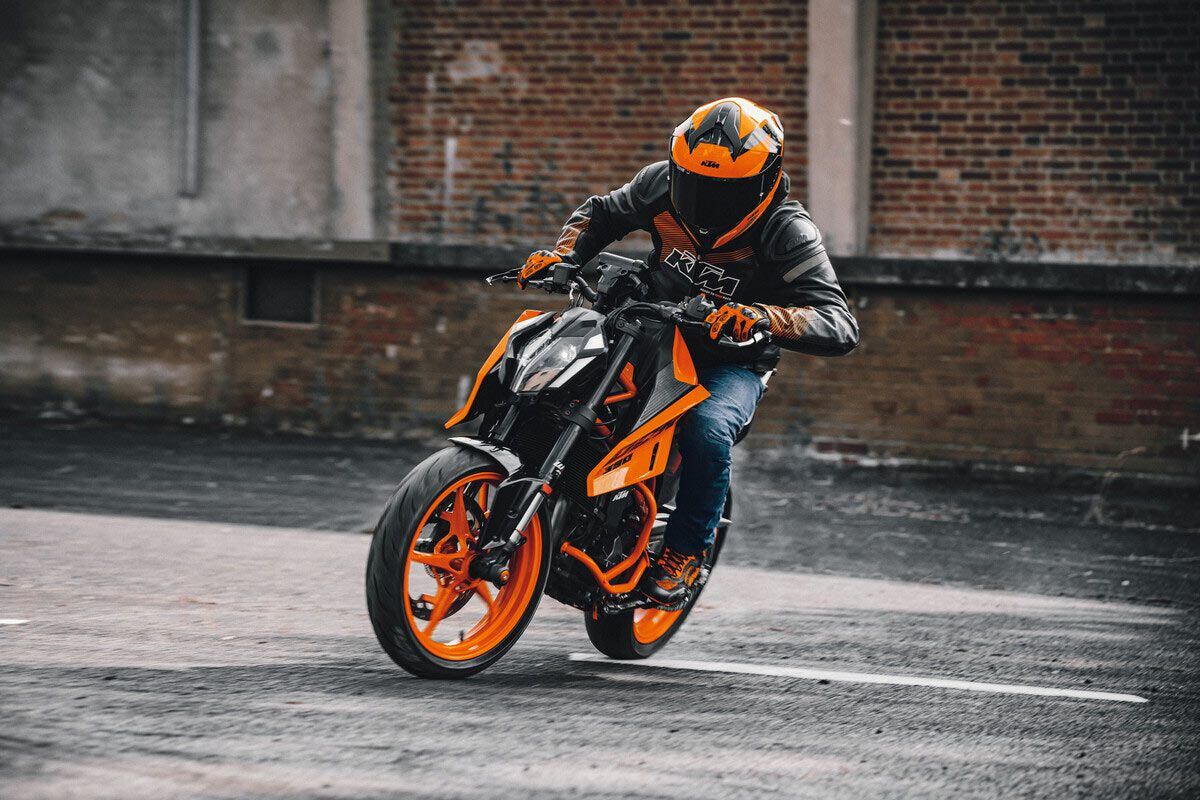
The 2024 KTM 390 Duke. (KTM/) For 2024, KTM is pulling out all the stops with its single-cylinder Duke lineup, bringing what it calls the biggest change to the model range since the 390 Duke’s introduction. Accordingly, both the 390 Duke and 250 Duke receive new engines, debut new chassis concepts, and move the entry-level game forward with revamped styling and electronics.
KTM says the single-cylinder LC4c platform has been redesigned. Details are scant, but the Austrian company says that both engines have “newly optimized cylinder heads and gearboxes.” The Duke 390′s engine uses a longer 64mm stroke to bring displacement up to 399cc (up from 373cc). KTM claims it produces 44 hp and 28.8 lb.-ft. of torque. The 250 Duke’s LC4c moves from DOHC to SOHC, reducing the components count and improving the power-to-weight ratio. Both engines use PASC slipper clutches, ride-by-wire throttles, and can be spec’d with quickshifters.
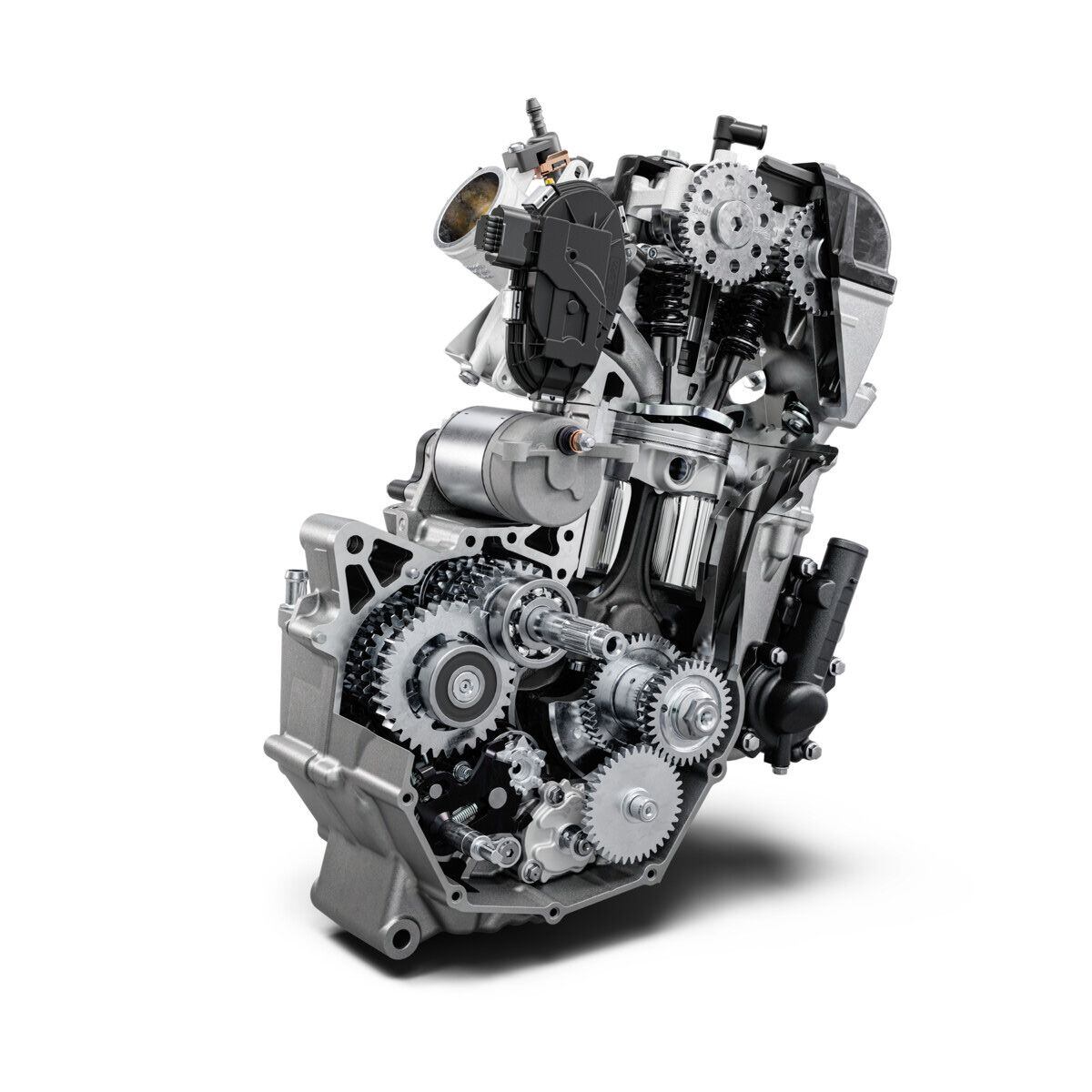
The 2024 KTM 390 Duke’s LC4c single has an updated gearbox and top end. (KTM/) KTM’s chassis engineers have been busy, as the Duke singles sport an all-new chassis concept. The main frame is still a steel trellis design, but is completely revised for improved torsional rigidity and barely resembles the familiar skeleton of its predecessor. Gone is the trellis subframe; in its place is a shapely pressure die-cast aluminum subframe left fully exposed—no rear bodywork necessary. The new swingarm accommodates an off-center linkageless rear shock that gives more space for both the muffler and airbox and also helps reduce seat height. For good measure, there’s even a new triple clamp. To reduce unsprung mass, both models feature new five-spoke wheels with an open-hub design.
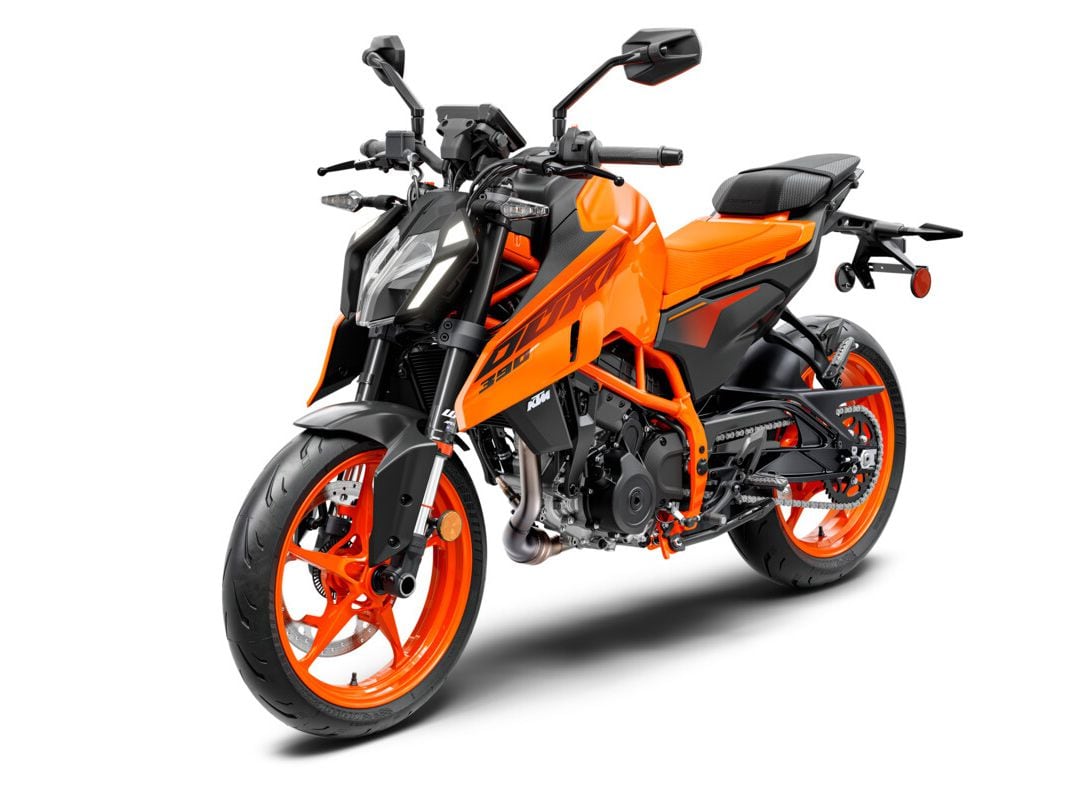
The 390 Duke is available in signature Electronic Orange and Atlantic Blue colors. Note the updated headlight’s sleek position lights. (KTM/) The 390 Duke uses a WP Apex 43mm open-cartridge fork, adjustable for compression and rebound, and a WP Apex Separate Piston rear shock, adjustable for preload and rebound. The 250 Duke uses a nonadjustable 43mm WP Apex big piston fork and a WP Apex Emulsion shock absorber, adjustable for preload.
Both models in the range use ByBre braking components: a single 320mm disc and four-piston caliper up front, and a 240mm disc in the rear that uses a new twin-piston caliper.
KTM claims the 390 Duke and 250 Duke each weigh 364 pounds fully fueled.
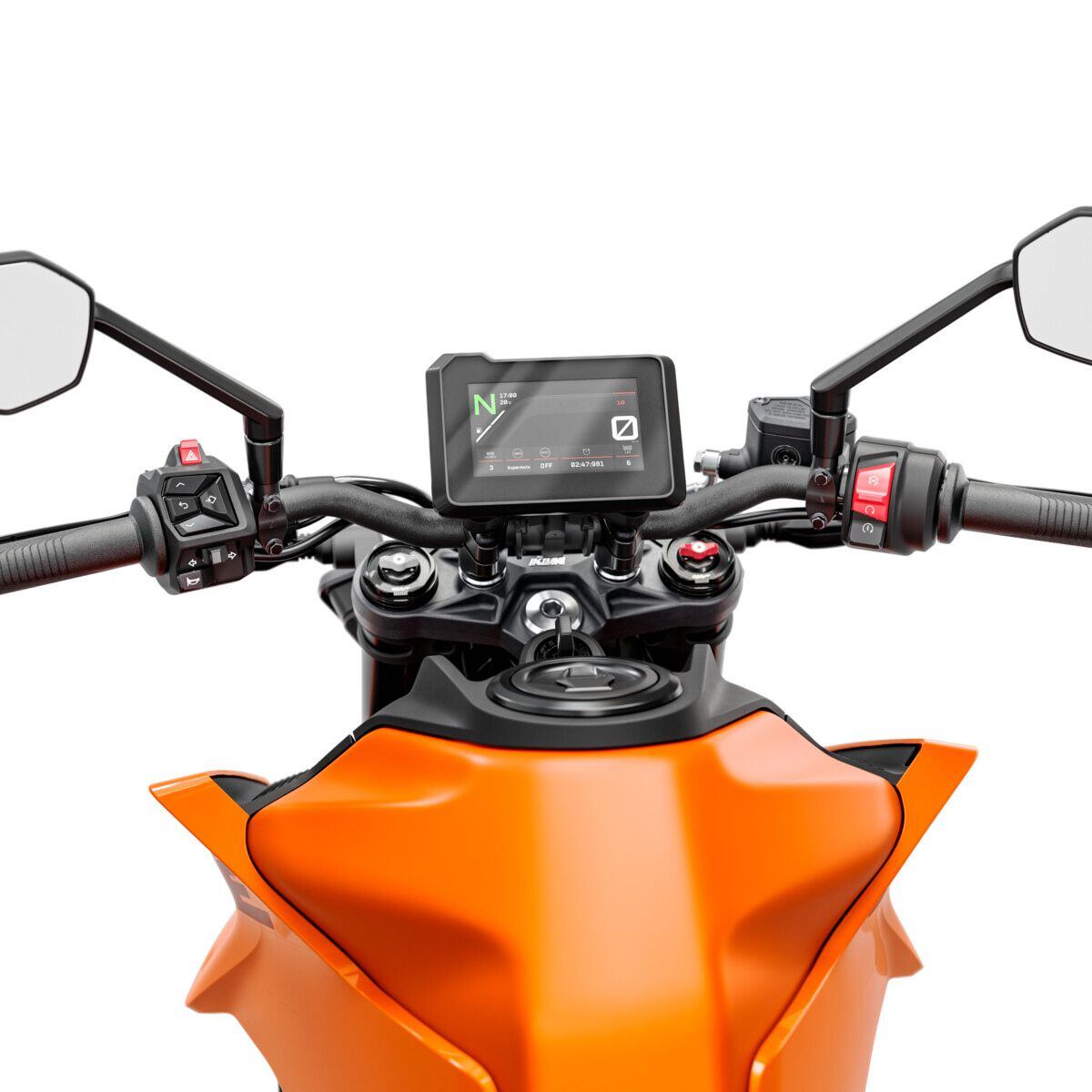
The 390 has an updated 5-inch TFT dash lifted from other models in the KTM lineup. The 250 makes do with an identical looking unit, except its display is LCD. (KTM/) In terms of electronics, KTM adds big bike value to these diminutive nakeds by using ride-by-wire throttles, LED lighting (headlight-only on the 250), 5-inch dashes (a TFT on the 390 and an LCD on the 250), and smartphone connectivity. Both models use KTM’s latest Supermoto ABS, which allows riders to switch off ABS in the rear.
For the first time, the 390 Duke gets ride modes and cornering MTC, which uses the input from the 3D sensor to adapt traction control during cornering. Two ride modes (Street and Rain) change throttle response and TC intervention to best suit the conditions. Additionally, the dash can be set to a “Track” layout. Not to be confused with a ride mode, “Track” merely adjusts the display, enlarging the tachometer while reducing the size of the speedometer. It also shows a lap timer, gear indicator, and MTC and ABS settings. For even more shenanigans, the 390 is equipped with launch control.
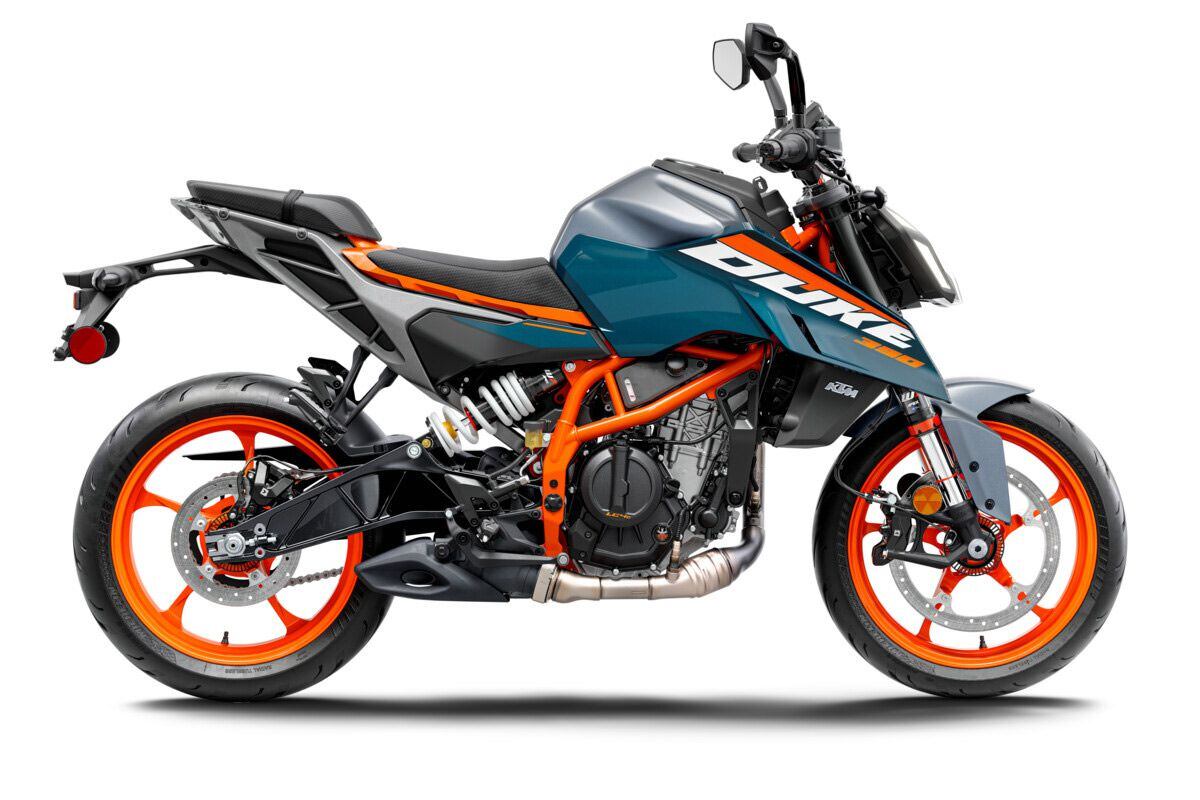
The depth of changes are most obvious when looking at the new swingarm, subframe, and main frame. (KTM/) Updated styling is consistent with the Duke brand as we’ve known it; minimalistic bodywork and aggressive lines underscores the relationship with the LC8 and LC8c-powered twins. To distinguish the pair, the 250 uses more simplified tank covers/radiator shrouds and forgoes the 390′s headlight position lights (though they’re available as an option) for painted units.
Despite tremendous changes to the engines and chassis, KTM doesn’t suggest that weight and peak performance figures are drastically different from the outgoing models, which goes to show how much manufacturers invest to keep on top of stringent regulations. Still, there’s a lot to be excited about, as all the changes point to making safer, more modern motorcycles. It was only a couple of years ago that ride modes were being introduced to middleweight streetbikes, and now, in the 390 Duke we get an entry-level model that makes use of them. And you’ve got to give credit to KTM for having fun at all costs. The folks at Mattighofen must have been thinking: “If legislation requires ABS, we might as well make it Supermoto ABS to keep big brother happy and put a smile on riders’ faces.” Plus, launch control on an entry-level streetbike? Cool.
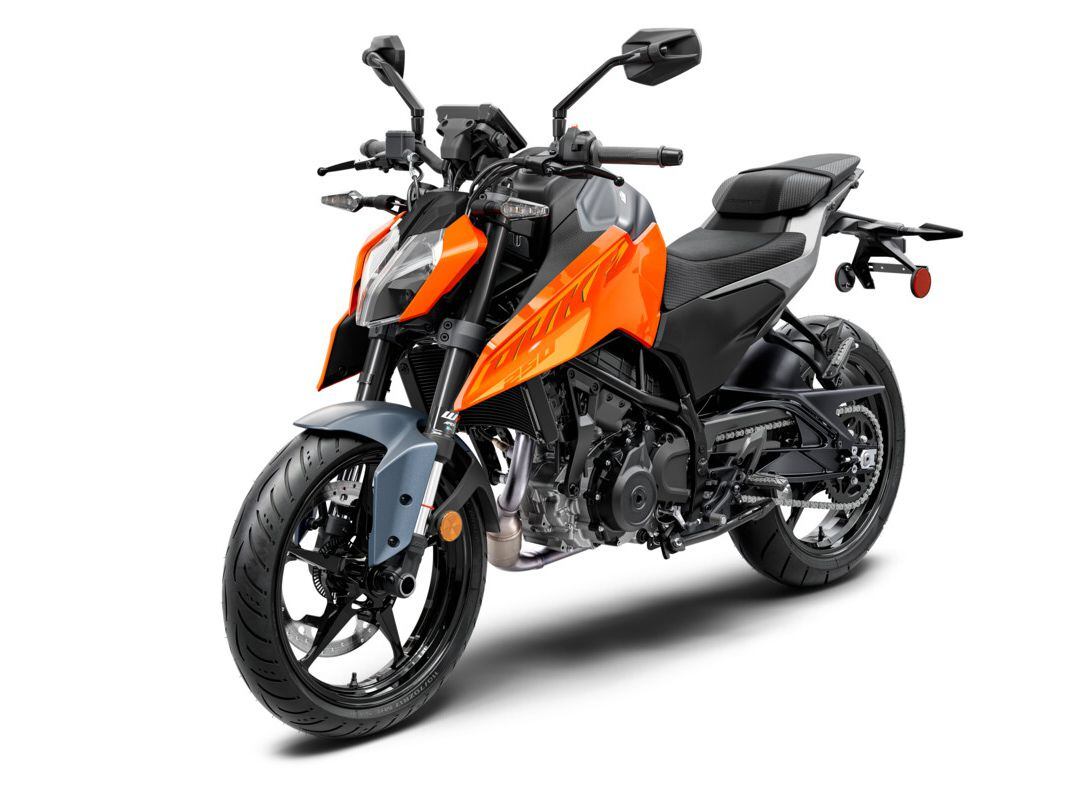
The 250 Duke is available in Electronic Orange (pictured) and Ceramic White colors. (KTM/) Look for the 390 Duke at your local KTM dealership beginning in December and the 250 Duke in early 2024. There’s no word yet on pricing.
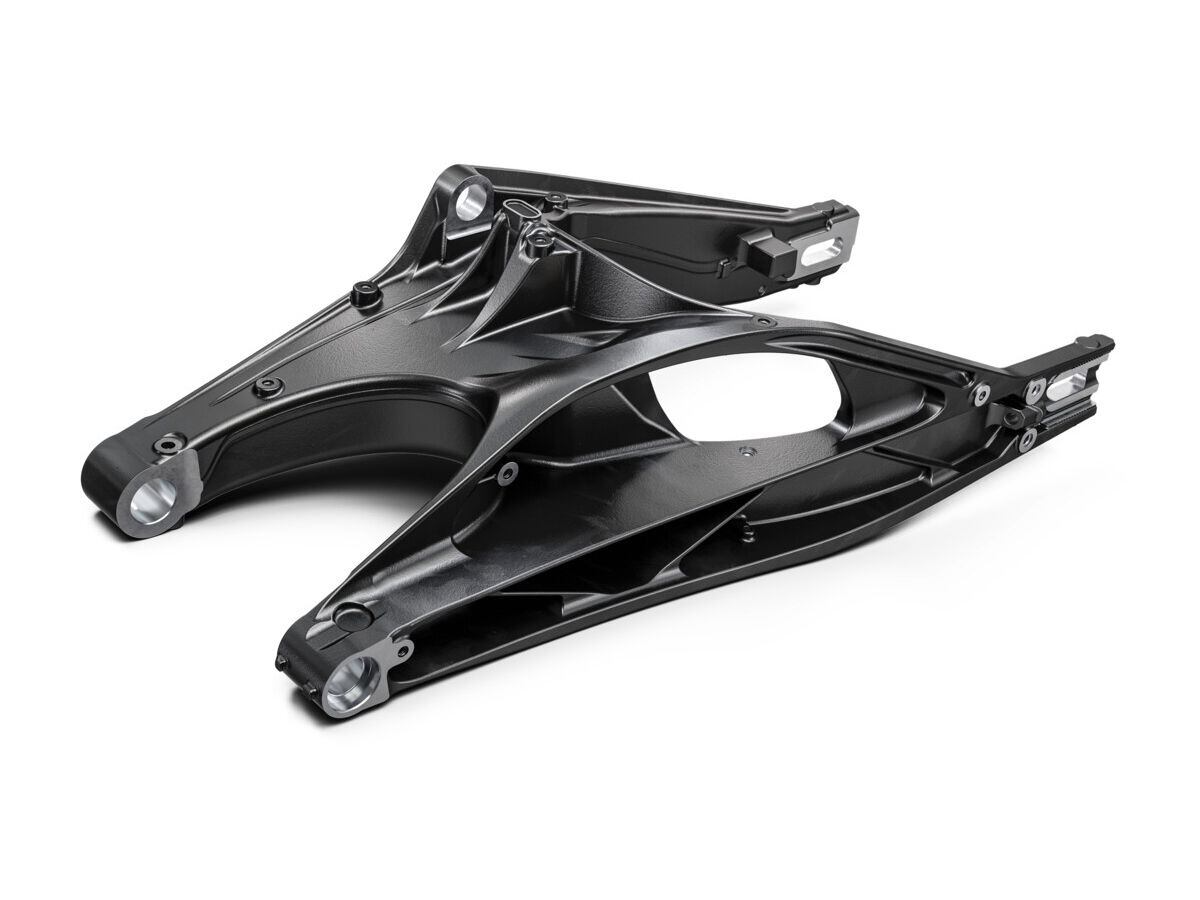
The KTM’s new swingarm sure is a far cry from the extruded swingers of yesteryear’s entry-level motorcycles. (KTM/) 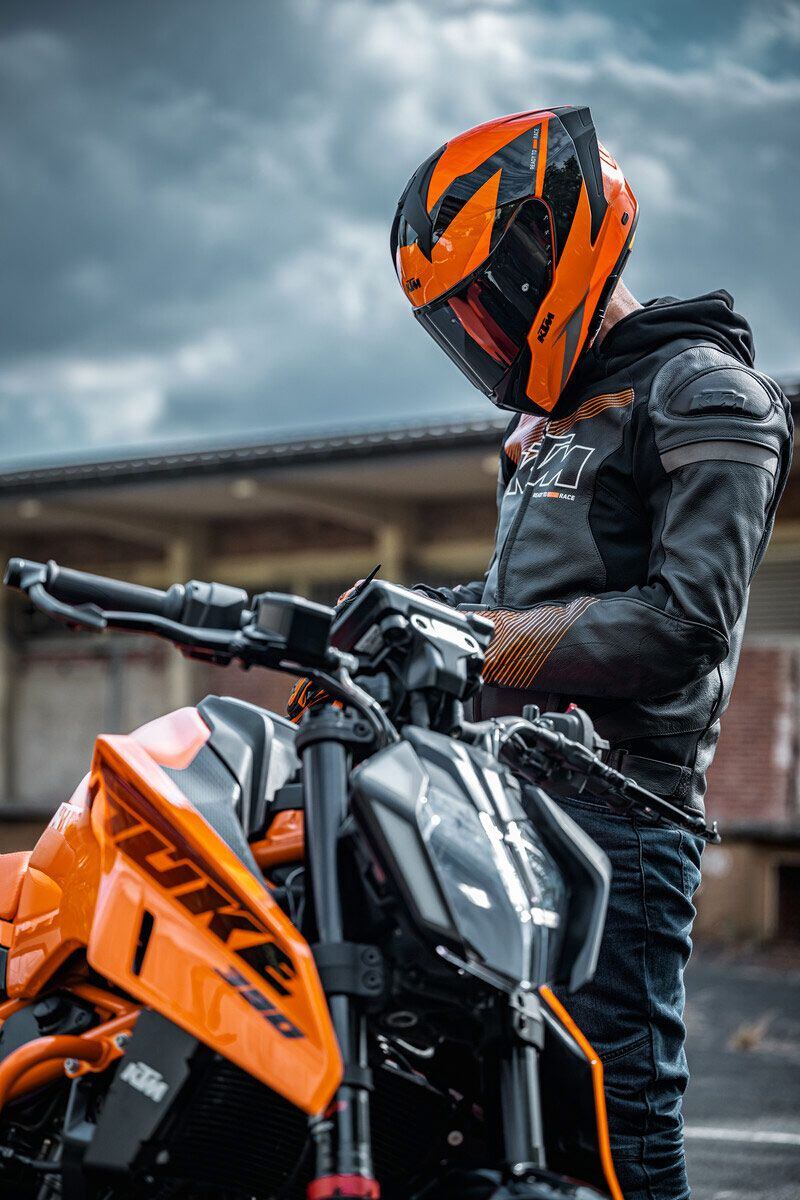
The smaller Dukes’ looks continue to share a strong family resemblance with its middleweight and open-class naked bikes. (KTM/) 2024 KTM 390 Duke Specs
MSRP: N/A Engine: DOHC, liquid-cooled, four-stroke single-cylinder Displacement: 399cc Bore x Stroke: 89.0 x 64.0mm Compression Ratio: N/A Transmission/Final Drive: 6-speed/chain Claimed Horsepower: 44.3 hp Claimed Torque: 28.8 lb.-ft. Fuel System: Bosch EMS w/ ride-by-wire Clutch: PASC slipper clutch; mechanically operated Frame: Steel trellis w/ bolt-on cast-aluminum subframe Front Suspension: 43mm WP Apex, compression and rebound damping adjustable; 5.9 in. travel Rear Suspension: WP Apex monoshock, spring preload and rebound damping adjustable; 5.9 in. travel Front Brake: Radial-mount 4-piston caliper, 320mm disc w/ cornering ABS Rear Brake: 2-piston floating caliper, 240mm disc w/ cornering ABS Seat Height: 32.3 in./31.5 in. Fuel Capacity: 3.9 gal. Claimed Wet Weight: 364 lb. Contact: ktm.com 2024 KTM 250 Duke Specs
MSRP: N/A Engine: SOHC, liquid-cooled, four-stroke single-cylinder Displacement: 249cc Bore x Stroke: 72.0 x 61.2mm Compression Ratio: N/A Transmission/Final Drive: 6-speed/chain Claimed Horsepower: 30.8 hp Claimed Torque: 18.4 lb.-ft. Fuel System: Bosch EMS w/ ride-by-wire Clutch: PASC slipper clutch; mechanically operated Frame: Steel trellis w/ bolt-on cast-aluminum subframe Front Suspension: 43mm WP Apex; 5.9 in. travel Rear Suspension: WP Apex monoshock, preload adjustable; 5.9 in. travel Front Brake: Radial-mount 4-piston caliper, 320mm disc w/ cornering ABS Rear Brake: 2-piston floating caliper, 240mm disc w/ cornering ABS Seat Height: 31.5 in. Fuel Capacity: 3.9 gal. Claimed Wet Weight: 364 lb. -
A limited run of 50 units is expected to be made available to the public
-

Kevin Cameron has been writing about motorcycles for nearly 50 years, first for <em>Cycle magazine</em> and, since 1992, for <em>Cycle World</em>. (Robert Martin/)In 1940 Oldsmobile introduced “the first fully automatic transmission to be mass-produced in the US” (page 129, Changing Gears by Philip G. Gott). Simplifying the operation of cars attracted many potential buyers who had found driving while synchronizing the operation of clutch, throttle, and gearshift lever dauntingly difficult.
Manual-shift gear transmissions used to be referred to as “standard” and automatics were dismissed as “slushboxes,” but today more than 98 percent of autos made in the US are equipped with automatic transmission.
There have been many attempts to accomplish a similar revolution on two wheels, but to date no comprehensive revolution has occurred. Despite that, new technical means of automating shifting continue to emerge.
Paralleling the automotive case, one motivation for offering automatics is that with the majority of auto drivers choosing automatic transmissions, there must be sales resistance to clutch-and-foot-shift bikes. If so, the right kind of automatic should attract new buyers. This was probably the driving force behind Honda’s 1973–88 “Hondamatic,” which combined a twist-and-go hydraulic torque converter with a two-speed foot shift.
There have been two streams of automatic drive development:
- To automate in various degrees the normal clutch and multispeed gear transmission. An early attempt in this direction was Chevrolet’s “Vacuum Shift” of 1941–1948, in which a vacuum cylinder assisted the motions of the column-mounted shift lever, notionally making shifting a two-finger operation. Motorcycle manufacturers continue to offer drivelines of this basic type.
- A completely different driveline, lacking clutch and shift lever. In this category are belt Continuously Variable Transmissions (such as <a href="https://www.cycleworld.com/2009/05/05/riding-impression-2008-aprilia-mana-850/">Aprilia’s Mana 850</a> with electronically controlled CVT), hydrostatic drives based on variable-stroke hydraulic pumps, and automotive-style automatics consisting of a ratio-changing hydraulic torque converter coupled to an automated epicyclic gear train providing two or more ratios to further broaden range. Examples of this are the Fuji “Superflow” scooter of the early 1960s and “Hondamatic.”
Opposing such experiments is a lingering tradition—a belief that motorcyclists regard mastery of clutch, throttle, and shifting as a “social gateway” through which beginners must pass in order to become “real motorcyclists.” The persistence of manual shifting in racing used to be cited as supporting this, but with such developments as “paddle shifting” in F1, this is outdated nonsense.
More recently, the rising popularity of electric bicycles and electric or automatic scooters has generated a population of riders who are two-wheel savvy but accustomed to twist-and-go operation. It’s reasonable to assume that a twist-and-go motorcycle could be an attractive next step for these riders.
Honda’s hydrostatic drive automatic DN-01, during its 2009–2010 importation to the US, was touted as an ideal beginner’s bike because its continuously variable hydrostatic drive provided three “human-friendly” modes of basic twist-and-go riding. The modes were Drive, Sport, and Manual. “Drive” provided basic automatic functionality, “Sport” could on demand hold engine rpm constant at peak power to maximize acceleration, and “Manual” restored foot-shifting through a computer-simulated six speeds, causing engine note to rise and fall in traditional fashion.
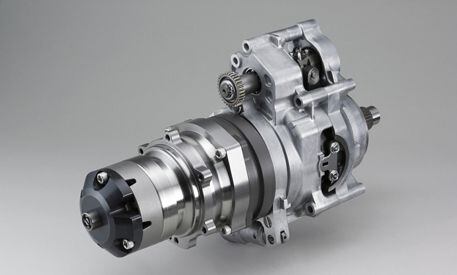
Honda’s DN-01 used a continuously variable hydrostatic drive. <i>Honda</i>Unfortunately, the high $14,599 price, rising to $15,499 in its second year, strained beginner budgets—especially in the down economy of those years. If that wasn’t enough, DN-01 was, well, odd-looking.
More recent and more successful is the Dual-Clutch Transmission (originally invented for Citroen in 1939) adopted by Honda on some models—most notably optional on Gold Wing tourers, where it has been adopted by a majority of riders, as follows:
August 2020 release from Honda: “[…in the past 12 months] 57 percent of Gold Wings and 38 percent of Africa Twins sold in the US had DCT transmissions.”
DCT allows “seamless operation,” meaning that torque flow to the rear wheel is uninterrupted as its automated shifting and clutching take place. This has advantages in touring as control software removes the need for downshifting on hills or during passing or on-ramp acceleration. Off-road, it allows the rider to focus on riding while the transmission attends to itself. A DCT can operate either automatically or in a manual mode.
Honda’s latest effort in this direction is called “E-Clutch.” First of all, it is switchable: If the rider prefers to clutch and shift conventionally, E-Clutch can be switched off. But if E-Clutch is on, all the rider has to do is operate the shift lever and throttle, even when accelerating from rest or coming to a stop. This is accomplished by automating the operation of a conventional clutch. With the engine running, click the shift pedal into first. E-Clutch makes this possible by first disengaging the clutch, then engaging first gear. Turn the throttle and E-Clutch makes a smooth, no-stall engagement and away you go. Time for second gear? Click the lever to second and again, E-Clutch allows this by disengaging, shifting to second, and reengaging the clutch with all the skill of a seasoned rider. Same with downshifts.
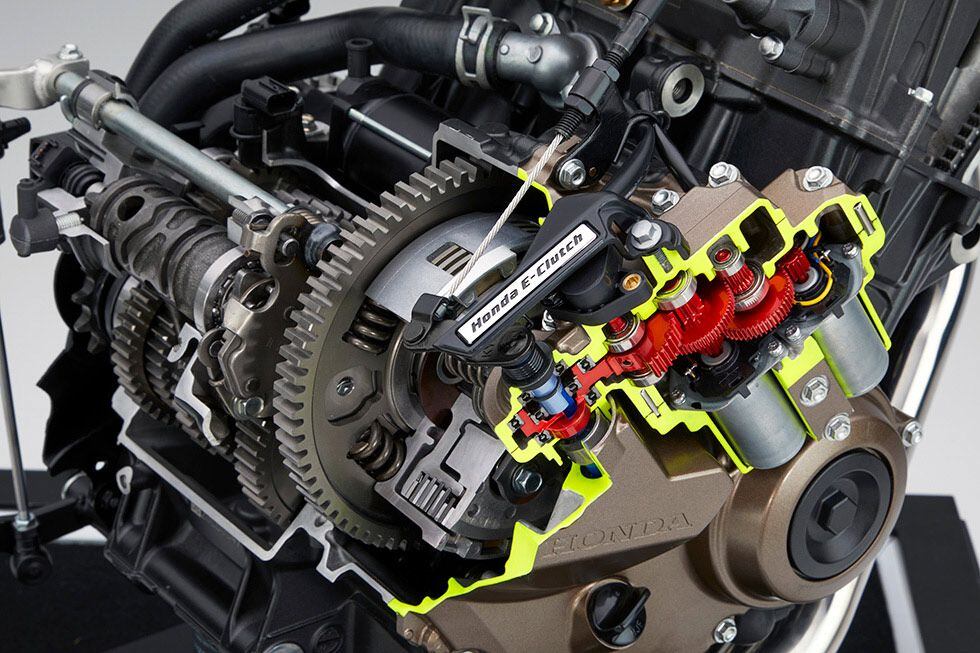
Honda’s E-Clutch automates the operation of the clutch. The rider can change the function from automatic to manual with a press of a button. (Honda/)This allows the rider to continue to control “the music”—the dynamic rise and fall in engine note as the rider shifts up and down through the gears, but without having to manage the clutch.
To quote from Honda’s European Media Newsroom, “The Honda E-Clutch manages clutch engagement and disengagement based on its reading of parameters including vehicle speed, throttle opening angle, engine rpm, pressure on the shift pedal, clutch motor reduction gear angle, engine countershaft speed, and gear position. The clutch is operated through an actuator unit with two motors situated inside the right-hand engine cover. As the clutch is engaged or disengaged, the engine’s ignition timing and fuel injection are also controlled, resulting in smooth, shock-free shifting in any situation.”
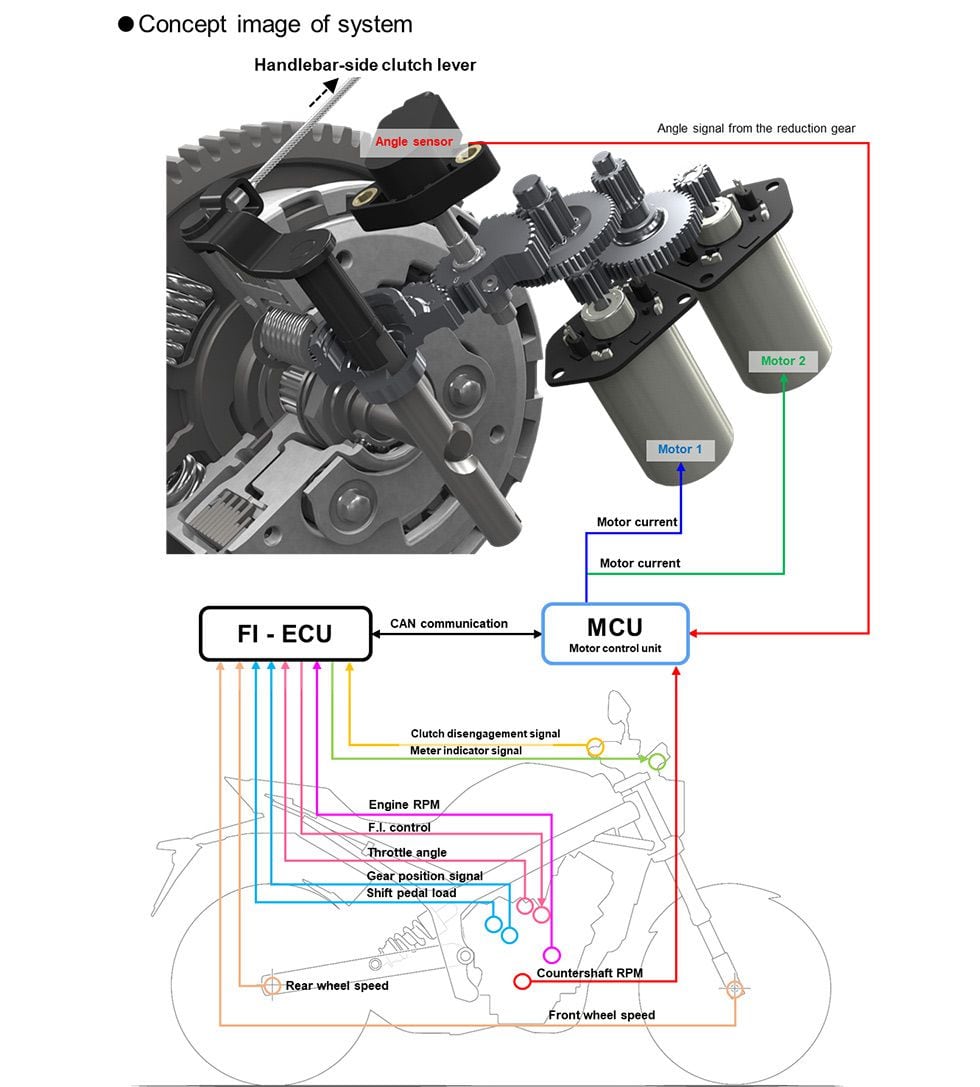
Using data from multiple parameters, Honda’s E-Clutch automatically manages the engagement and disengagement of a traditional wet, multiplate clutch. (Honda/)Aside from its computer logic and control software, E-Clutch consists of two small electric motors driving a gear train that rotates a sector gear controlling clutch engagement. Total weight is cited as 4 pounds, 6 ounces.
As noted above, E-Clutch can be switched off, leaving driveline control entirely up to the rider, in a 100 percent traditional style.
As with the coming of fuel injection, electronic ignition, and electronic rider aids, some will object that such systems add complexity and cannot be owner-serviced in the field. Just remember that automotive automatics, each one containing as many as 800 unique parts, quickly became (and remain) solidly reliable.
-
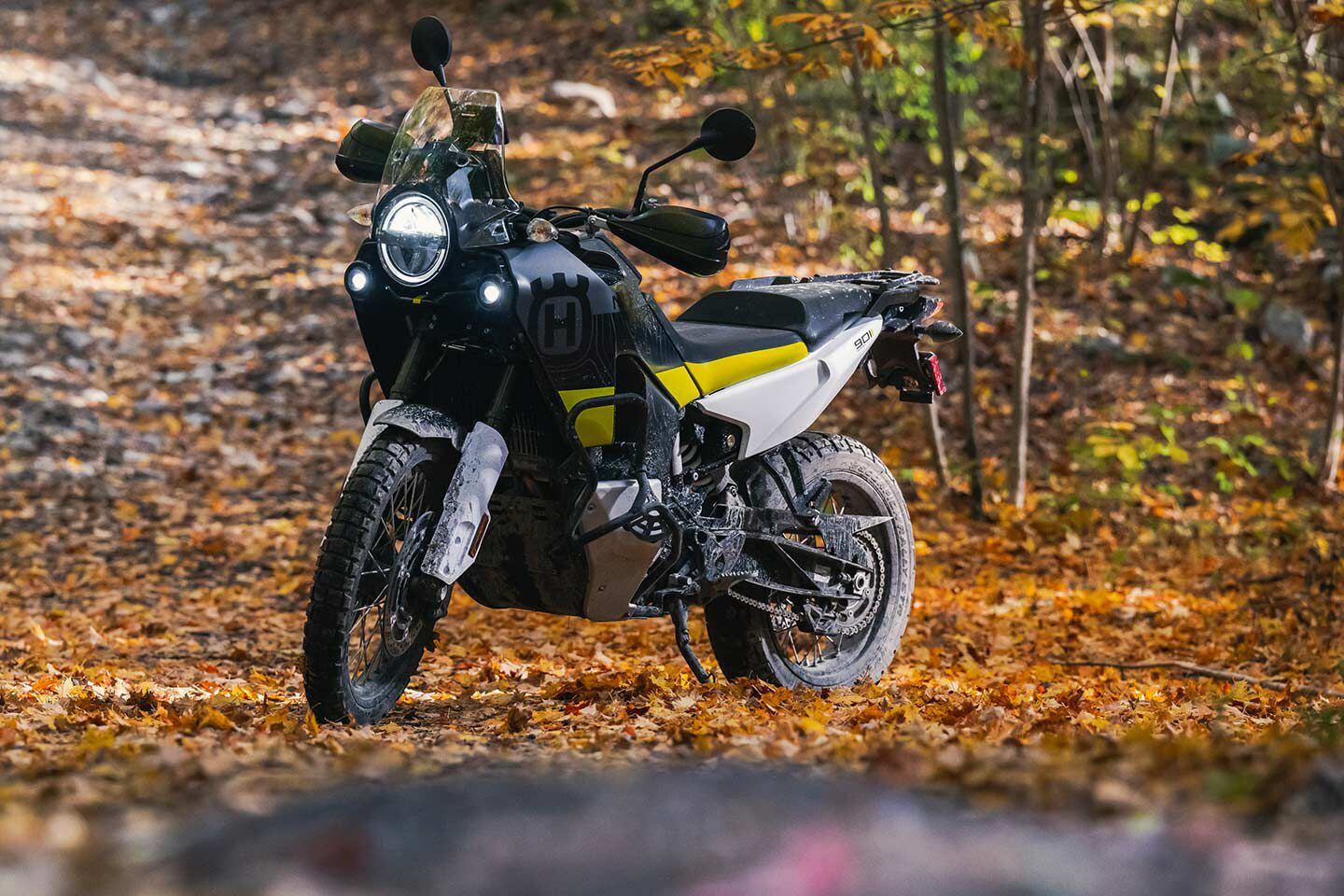
The Husqvarna Norden 901 is a capable motorcycle straight from the factory, but we add some key parts to make it all the more ready for the unknowns of adventure travel. (DW Burnett/)Unlike some motorcycles that never venture off the beaten path, adventure bikes need to carry their riders to roads and trails less traveled, and stand up to a potential beating once there.
Yet, when you buy a new adventure bike, even one as off-road-worthy as the Husqvarna Norden 901, it may need a few aftermarket modifications to prepare it for its calling. Navigation, protection, and illumination are cornerstones of adventure bike modifications. For the past year, we’ve tested crashbars from Outback Motortek, a Garmin Zūmo XT GPS unit, a MotoPumps Zūmo XT Security Lock, Clearwater Darla lights, and Barkbusters Storm Handguards.
Money can’t buy you talent, but it can buy you peace of mind. Peace of mind, in turn, builds its own kind of confidence. At the end of the day, confidence in yourself and in your machine goes a long way in helping you get out there and tackle whatever’s in your path. After all, if you’re not afraid of dropping your bike or of getting irretrievably lost in the woods, there’s a good chance you’ll ride confidently and be more open to pushing yourself.
Outback Motortek Ultimate Protection Combo
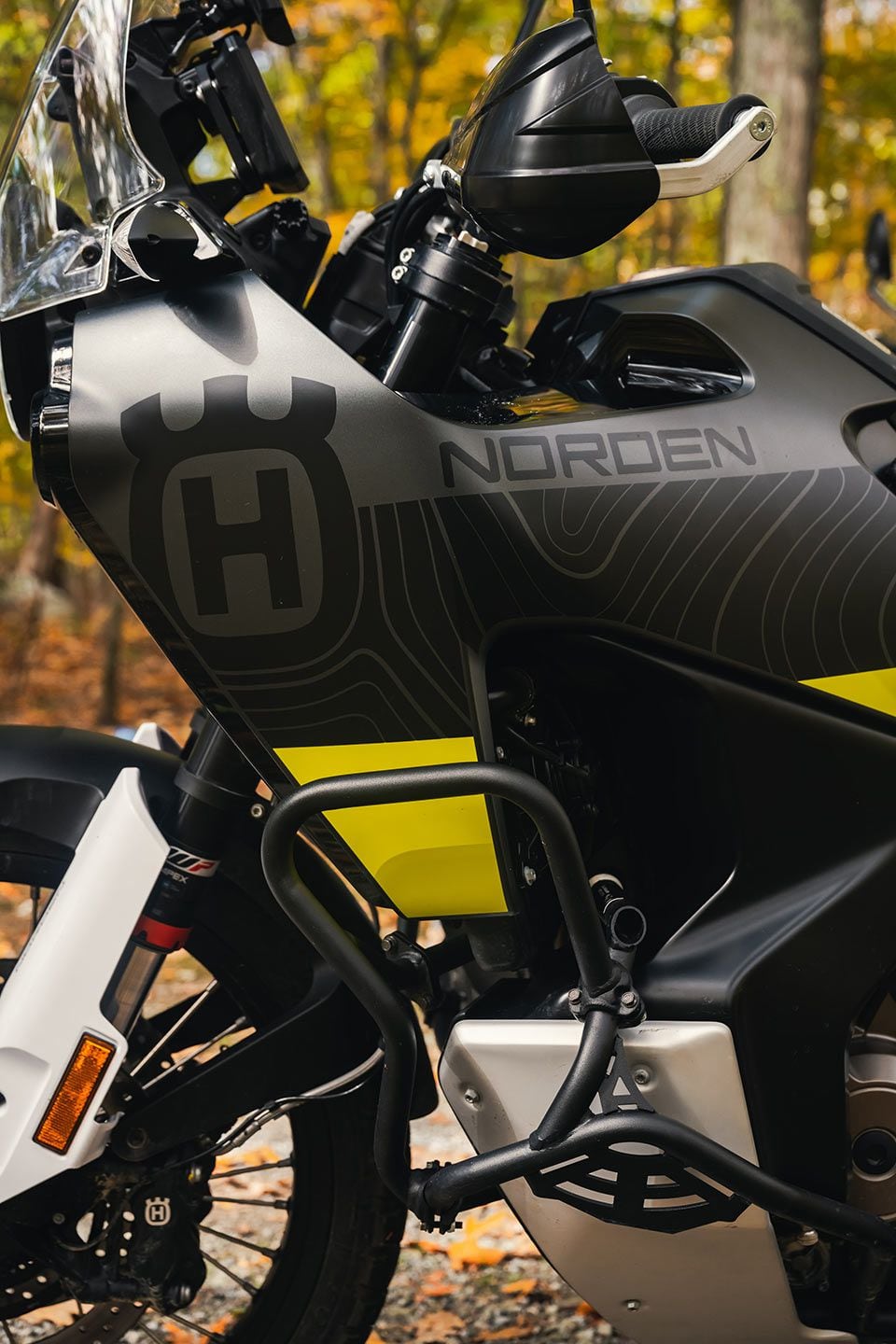
The Outback Motortek Ultimate Protection Combo. (DW Burnett/)While the Norden’s low-slung fuel tank hugs many vulnerable bits, dropping the bike off-road can make it look second-hand awfully quickly. After dumping it several times on a gnarly rocky descent, crushing its aluminum side pods and scratching the fairing, it was clear that the Norden needed some proper crash protection if it was going to make it to its first service in one piece. Enter Outback Motortek.
The Outback Motortek Ultimate Protection Combo ($695) comprises upper and lower crashbars and a skid plate, providing full-coverage protection. Built from 22mm-diameter, 2mm-thick powdercoated stainless steel, the lower crashbars mount to the frame at three points per side for ultimate rigidity. The upper crashbars mount to the lowers in two places per side and then connect to each other with a center brace that passes along the front of the radiator. Mounting points are super solid and frame-mounting means impacts aren’t transmitted to the engine.
Critically, the crashbars provide mounting points for the skid plate. Rather than connecting to the engine, like the stock skid plate—a flimsy aluminum affair, just like the KTM 790/890 Adventures—the skid plate’s crashbar-mounted design isolates and protects the engine by transmitting energy from an impact to the crashbars. The skid plate is built from 4mm-thick stainless steel and comprises two pieces, the upper part providing protection for the exhaust headers. It’s compatible with Outback’s centerstand, though not the factory accessory centerstand.
Installation is straightforward, but it helps to have a second person’s assistance. For oil services, the skid plate needs to be removed, which entails removing four screws. It should be noted that the crashbars run close to the drain plugs, so it takes just a bit of fiddling to remove them.
Near-daily rides through rocky terrain have put the skid plate, in particular, to the test. It’s taken some hits and is none the worse for wear. There’s little doubt the Outback Ultimate Protection Combo will be serviceable throughout the life of the motorcycle.
Check out Outback’s website at outbackmotortek.us for some cringeworthy videos of crashbar testing, in which new motorcycles are dragged behind a pickup truck across various surfaces.
Garmin Zūmo XT
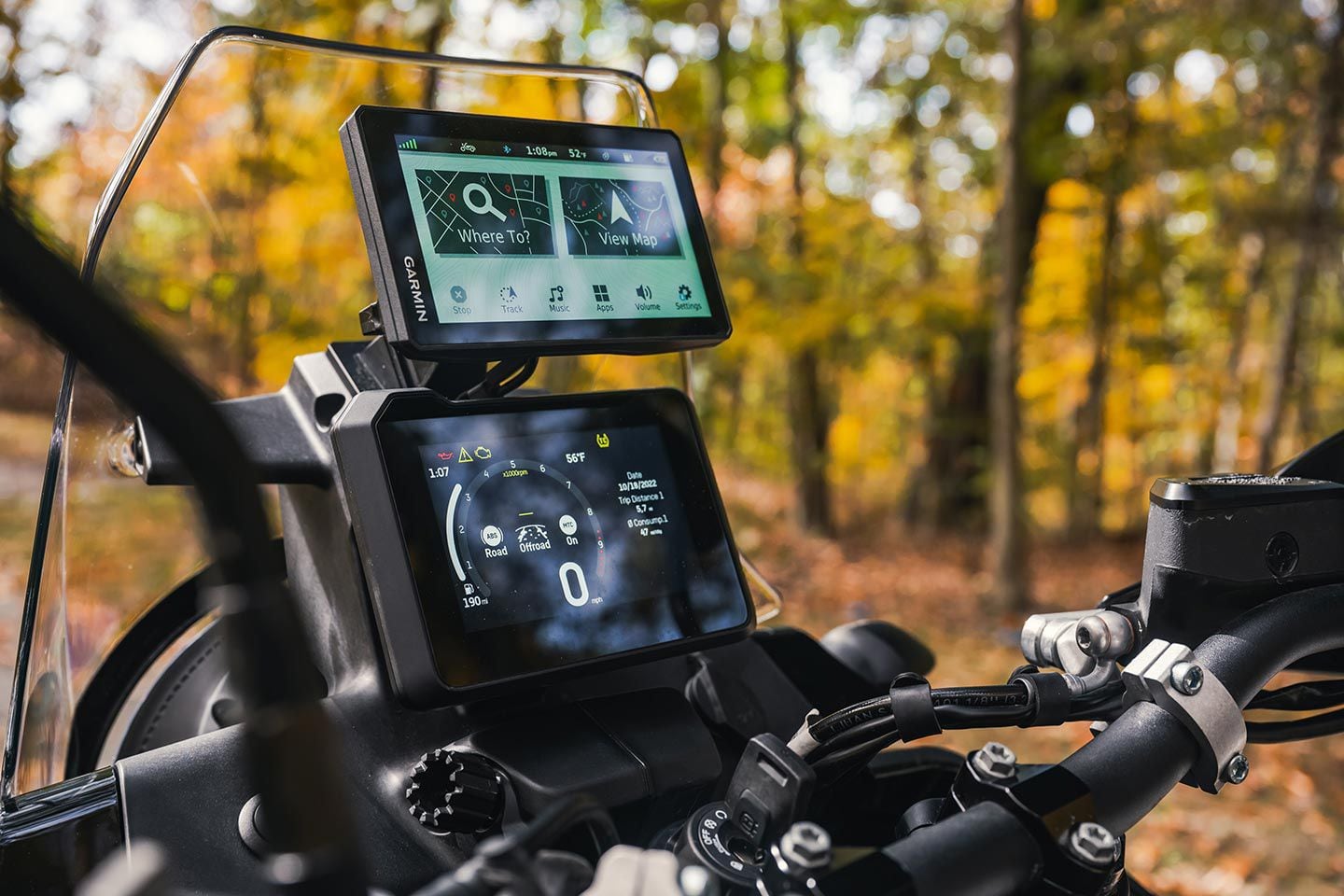
The Garmin Zūmo XT. (DW Burnett/)When it comes to navigation, there’s a contingency of riders who swear by using smartphones or tablets to download offline-viewable maps rather than pony up for a GPS. For others, those solutions feel more like a work-around than the right tool for the job.
For riders who want a purpose-built GPS for motorcycle navigation, the Garmin Zūmo XT ($499.99) is more than the right tool; it’s practically the whole toolbox. Aside from the obvious advantages (it’s weatherproof and requires no cellular service), the Garmin Zūmo XT justifies itself with a number of key features.
Compared to older-generation Garmin devices, the XT benefits from a more intuitive user interface, a beautiful 5.5-inch display, and easier options for downloading GPX files and other data. Users can download files directly from their smartphones through the Garmin Drive app or drag and drop files from their computers as if the XT were just a standard external hard drive. No more using Basecamp as an intermediary.
The integration with the Drive app adds another layer of convenience by assisting in troubleshooting, for example, a connection with a Bluetooth headset. Additionally, users can also send an address copy-and-pasted from the web to the XT via the app, saving the step of manually typing it in on the XT.
Just like the map apps we use on a regular basis, plugging a destination into the GPS, selecting one of the route options and hitting “go” is super easy. While that’s great to use as a North Star, so to speak, touring motorcyclists want the freedom to create their own routes. Zūmo users can set avoidances (like highways or toll roads) or allow it to create its own Adventurous Routing from point A to point B. Ultimately, there are motorcyclists who like even more control. In the real world, using a map in conjunction with the Zūmo to create your own precise route is ideal. With the Trip Planner function, users can plug in start location, destination, and locations between to create a trip complete with turn-by-turn directions (unlike a GPX track). The procedure is simple to do at camp under the light of a headlamp while sipping bourbon as your buddy struggles to light a fire. If your riding partner also has an XT, you can simply share your created trip via Bluetooth or the Garmin Drive app.
While the Trip Planner works well, from a usability standpoint, it would still be simpler if the technology allowed users to create a route by entering roads instead of points the route passes through. For example: “Lewisburg, WV, to Davis, WV, via Route 219.”
Motorcycle touring is invariably filled with variables. It’s pouring rain, you’ve got a puncture, your campsite is still 100 miles away, and there’s no cell service. What do you do? In these cases, the Zūmo proves indispensable. Finding fuel, motorcycle dealerships, lodging, and campsites are a button press away. The XT includes apps such as Tripadvisor, iOverlander (a user-generated resource that even features spots for primitive camping), and Foursquare.
When navigating, alongside the map and turn-by-turn directions, the XT can display, among other things, a music player; smart notifications from your phone; a live radar; elevation; and useful services on the route, like gas stations, restaurants, and rest areas.
Ultimately, the Zūmo XT is a feature-packed device that gives touring motorcyclists more freedom to navigate on the fly and the security to explore the world on a whim. Getting lost has never felt so rewarding.
Garmin Zūmo XT and XT2 Security Lock by MotoPumps
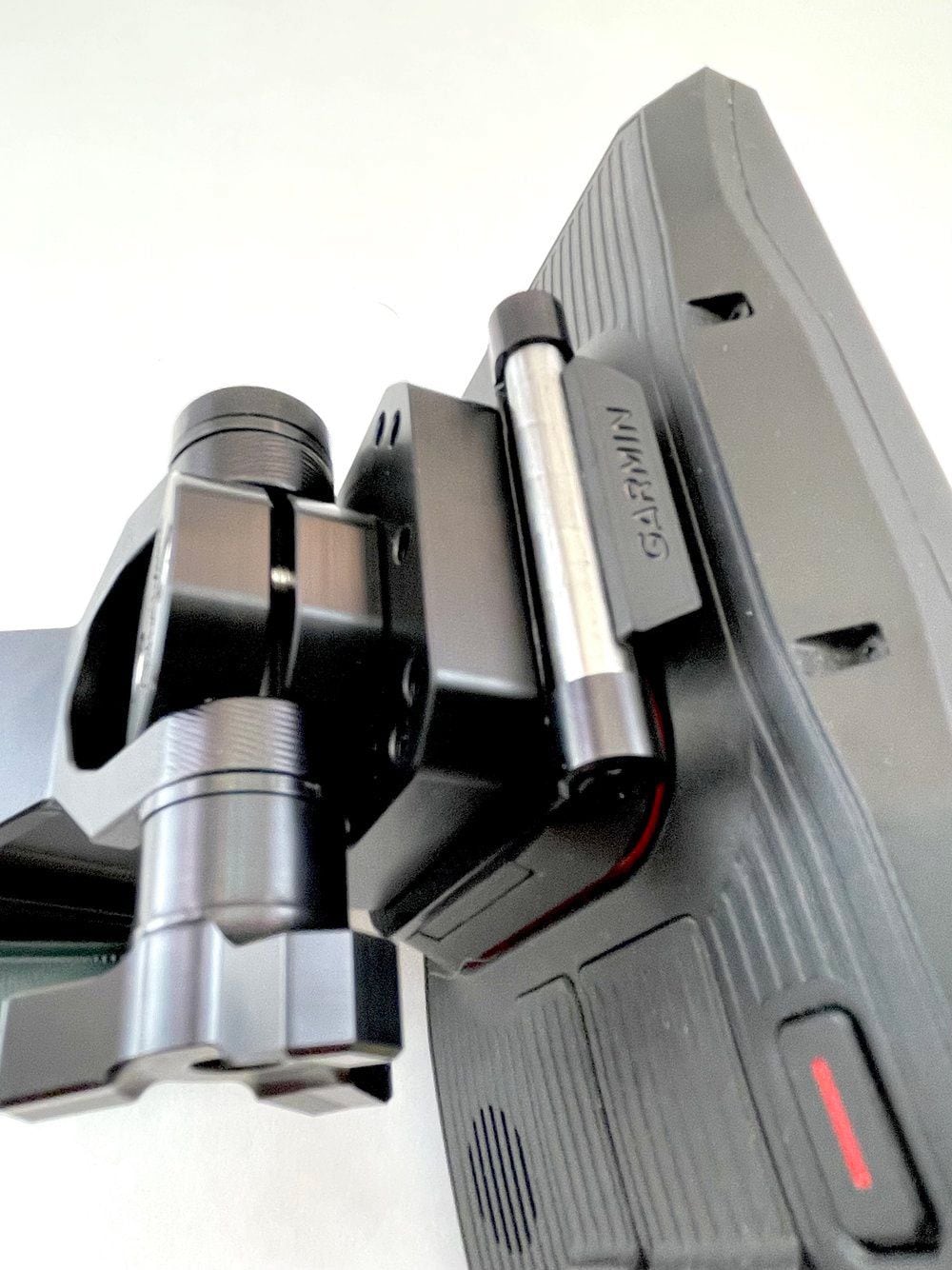
The MotoPumps Security Lock. (MotoPumps/)Ingeniously simple, the Security Lock by MotoPumps installs between the Garmin-powered cradle and whatever GPS mount is already on your motorcycle. Once installed, simply screwing the stainless steel security pin into place prevents the cradle’s release button from being depressed to remove the unit. For tinker-proof security, the pin has a proprietary head design. Unscrewing it requires using the included key.
The MotoPumps Security Lock’s billet aluminum design is unobtrusive, lightweight, and simple to install. Everything from its anodized finish to the security pin’s rubber washer that protects the threads from corrosion justifies its $70 price tag.
Practically invisible when installed, the Security Lock is a “why didn’t I think of that” kind of product. At the time of development, the only available security locks were large, complicated, and expensive. MotoPumps, a small, enthusiast-run operation based in Upstate New York, saw the gap in the market and produced a product that fit the niche perfectly.
MotoPumps also offers its AMPS Pattern GPS mount with an integrated Security Lock for an all-in-one solution.
Barkbusters Storm Handguards
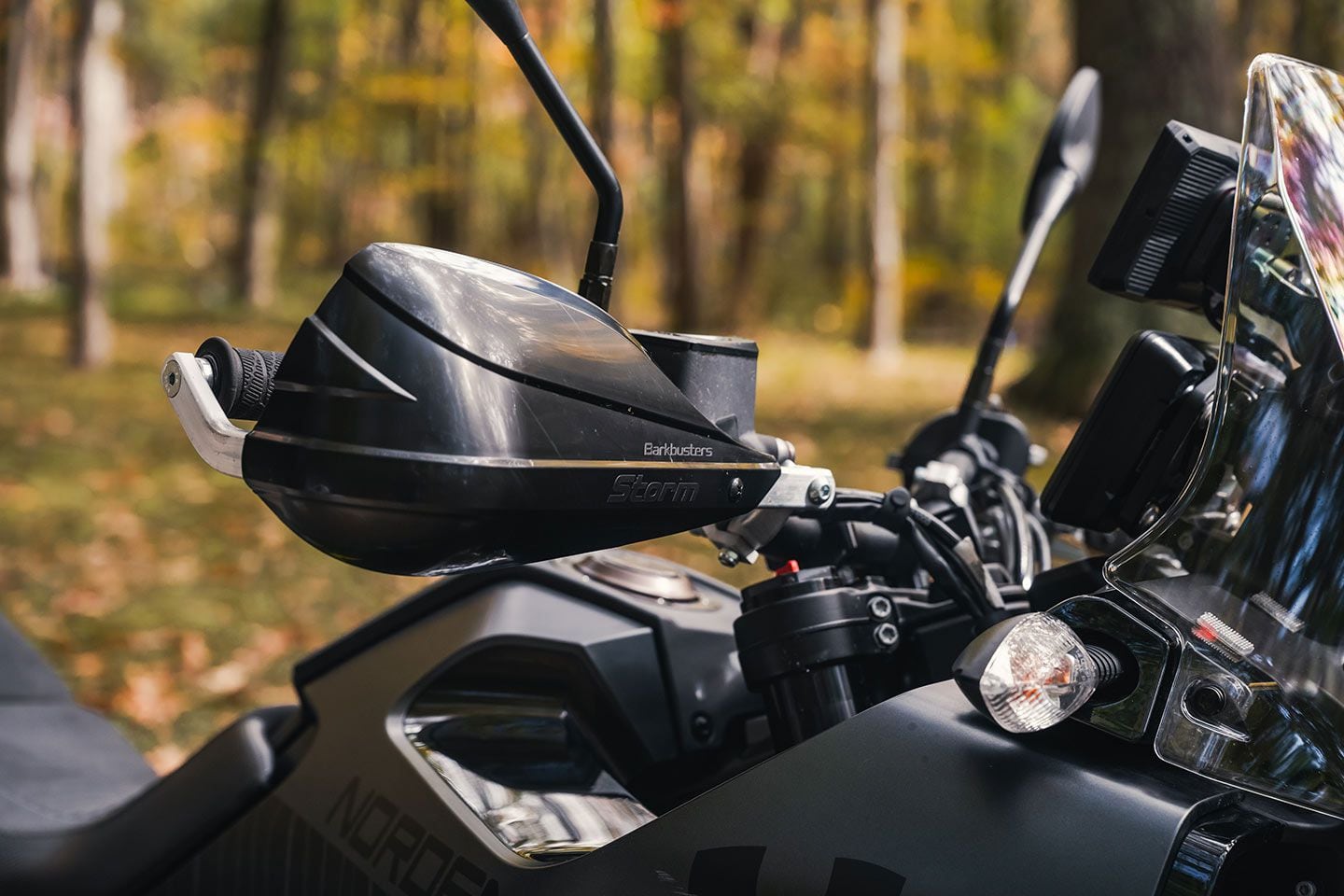
Barkbusters Storm Handguards. (DW Burnett/)Like Kleenex is to tissues, Barkbusters are pretty much a proprietary eponym for motorcycle hand guards. The Storm hand guard features a large plastic guard that surrounds Barkbusters’ universal-mounting aluminum backbone. The backbone protects levers and hands in case of a get-off, and is solid-mounted below the brake master cylinder and inside the bar ends. If you sell your motorcycle, the universal mounting hardware makes it simple to remove to install to another bike.
Many OE hand guards are flimsy affairs that are fine as brush guards, but Barkbusters go the extra mile in terms of protection. The Storm’s large guards offer good weather protection and are veritable boxing gloves for swiping brush and small branches. More than that, like other ADV customizations, Barkbusters are an insurance policy, greatly reducing the possibility of a broken lever mid-trail. No wonder they’re many rider’s first customization. For the Norden, the entire setup, including the universal taper bar hardware kit ($104.95), Storm plastic guards ($44.95), and spacer (for model-specific application, $4.95) costs $154.85.
Clearwater Darla Lights
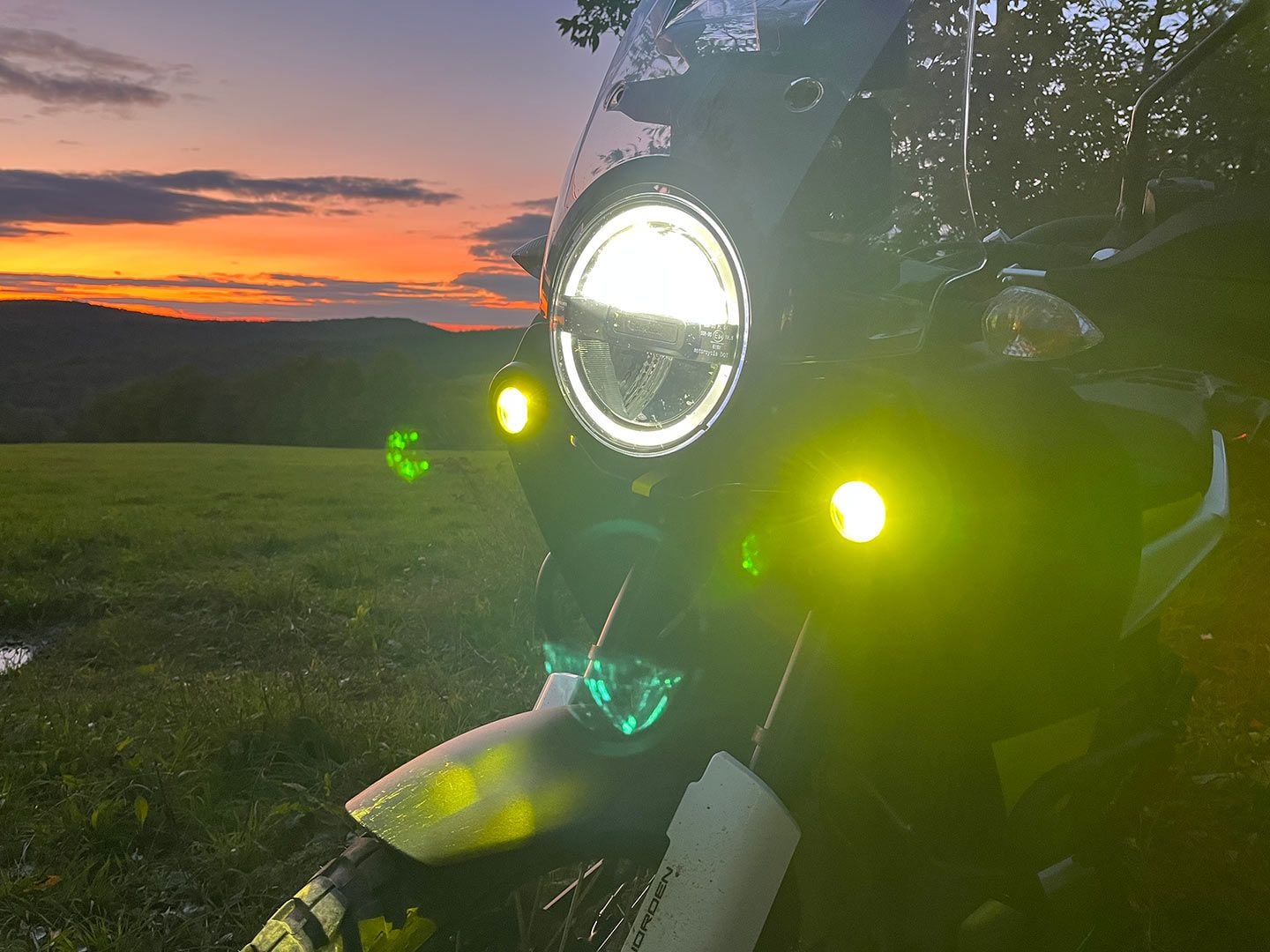
Clearwater Darla Lights. (Seth Richards/)We love that the Norden comes from the factory with auxiliary lights, but Clearwater takes illumination to the next level. For those who ride at night, they’re a game-changer.
The Darlas pierce the darkness so much further than ordinary lights that using high beams becomes unnecessary. In addition to greater sight distance, the lights also vastly improve peripheral illumination. Most stock lights leave the sides of the road in darkness, which makes moving through the night feel like an act of blind faith. If there are deer lingering in the hedges, one has little hope of seeing them until they leap directly in front of you—which is exactly what you don’t want to see. The Clearwaters bring the invisible enemy into view. In that light, they’re no mere luxury but a required safety feature.
Using the included yellow lens covers makes the Norden look even more like the prototype so many of us fell in love with. More importantly, for daytime riding, those bright yellow beams make the motorcycle more noticeable to other motorists. They’re hi-vis for your motorcycle.
The lights are also multifunctional. On many bikes, the Darlas can be linked to the high beams, but on the Norden the lights are full-on all the time, unless the included bar-mounted rheostat is installed, which gives users the ability to control the level of brightness.
Installation is fairly straightforward, and the kit includes everything one needs for plug-and-play operation. Still, some may have some trepidation about using posi-tap wire connectors for some of the connections. While they’re easy to use, and all the connections are buried inside the bodywork, one wonders about their ultimate water-tightness and how they’ll fare under being subjected to the punishing abuse of regular off-roading.
At $579, Clearwater’s Darlas are not an insignificant investment, but if venturing further means pushing through enveloping darkness, the Darlas’ truly impressive performance makes them a worthy addition.
-
The BKX adventure platform will also come in 125cc and 250cc flavors in certain markets.
-
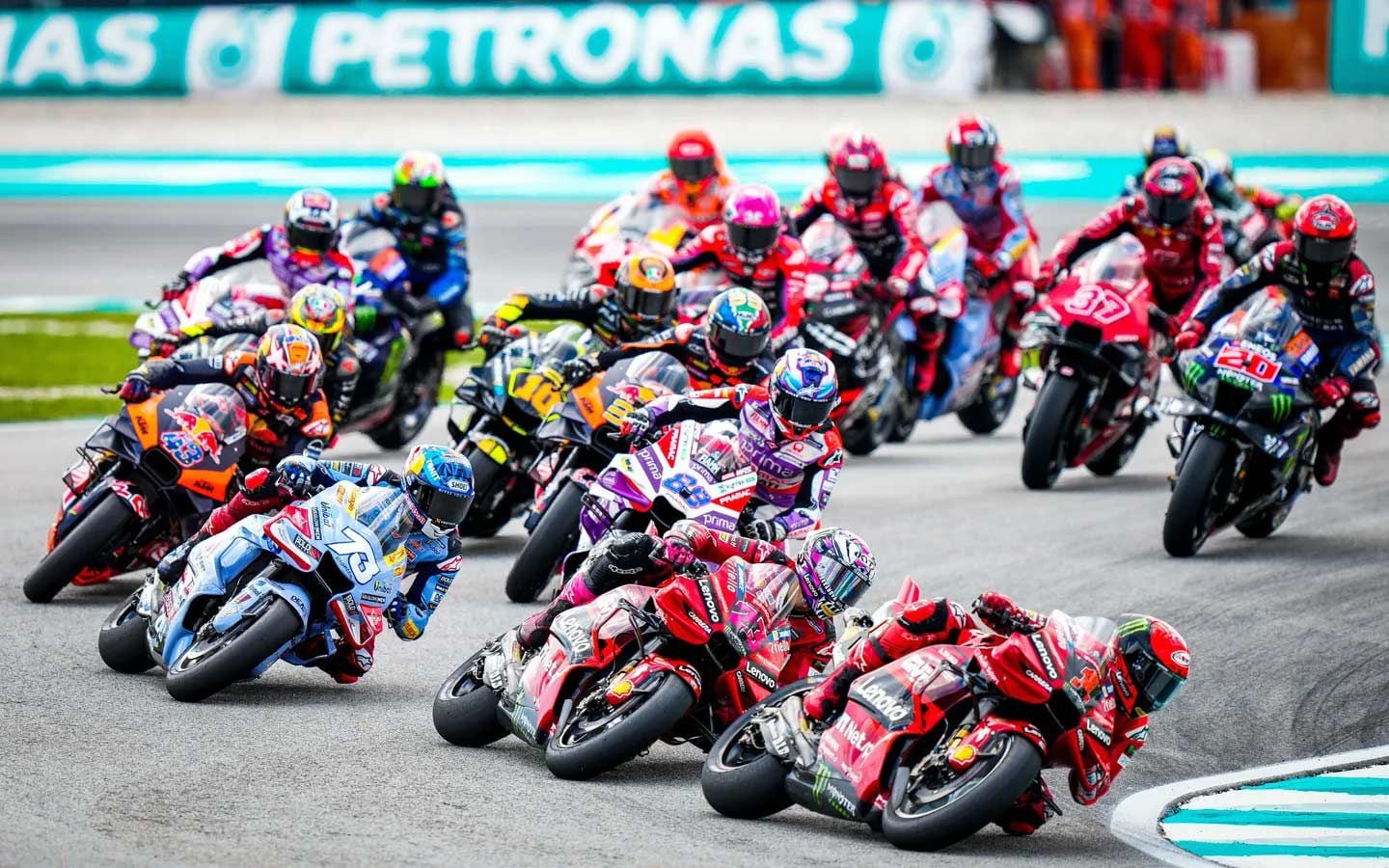
The racing at Sepang in Malaysia was nowhere near as tight as the previous round in Thailand. Lap 1 is as tight as it got with the two factory Ducatis of Francesco Bagnaia (1) and Enea Bastianini (23) leading the way. (MotoGP/)Strangeness! The rivals for the 2023 title, Francesco Bagnaia and Jorge Martín, finished Sunday’s race in third and fourth respectively, while the surprise winner (where did he come from?) was recovered-from-injury Enea Bastianini followed by suddenly fast Álex Márquez. All four rode Ducatis.
Although the two title rivals would have been up front had they been able, they indulged in no risky foolishness like “jist goin’ fer it.” To finish first, you must first finish.
Want another surprise? In fifth was Fabio Quartararo on “The Little Engine that Couldn’t”—the factory Yamaha that has been chronically deficient in power and passing ability until now.
The two title rivals left Malaysia nearly as they arrived—with 14 points advantage to Bagnaia.
Bastianini, fourth in Saturday’s sprint race, just behind Bagnaia, said, “…I made the decision not to overtake Pecco because I’m not fighting for the world championship.”

Bastianini’s injury-plagued season finally got turned around with two races remaining. (MotoGP/)After winning on Sunday he said, “…without the injury [at Portimão] my season could have been much better.
“Compared to the other races we have changed the engine-brak[ing].
“My main problem this year has always been the braking phase. Now I’m using the rear brake for the first time [with the thumb lever].
“…I am not continually making mistakes when braking, which until recently happened every lap. I’ve always said that when you get back to having fun you also go a lot faster.”
Álex Márquez had said on Friday, “Sometimes…things come to you naturally. Today was one of those days.”
After winning the sprint he said, “…everything happened in a very natural way from the first lap to the last…”
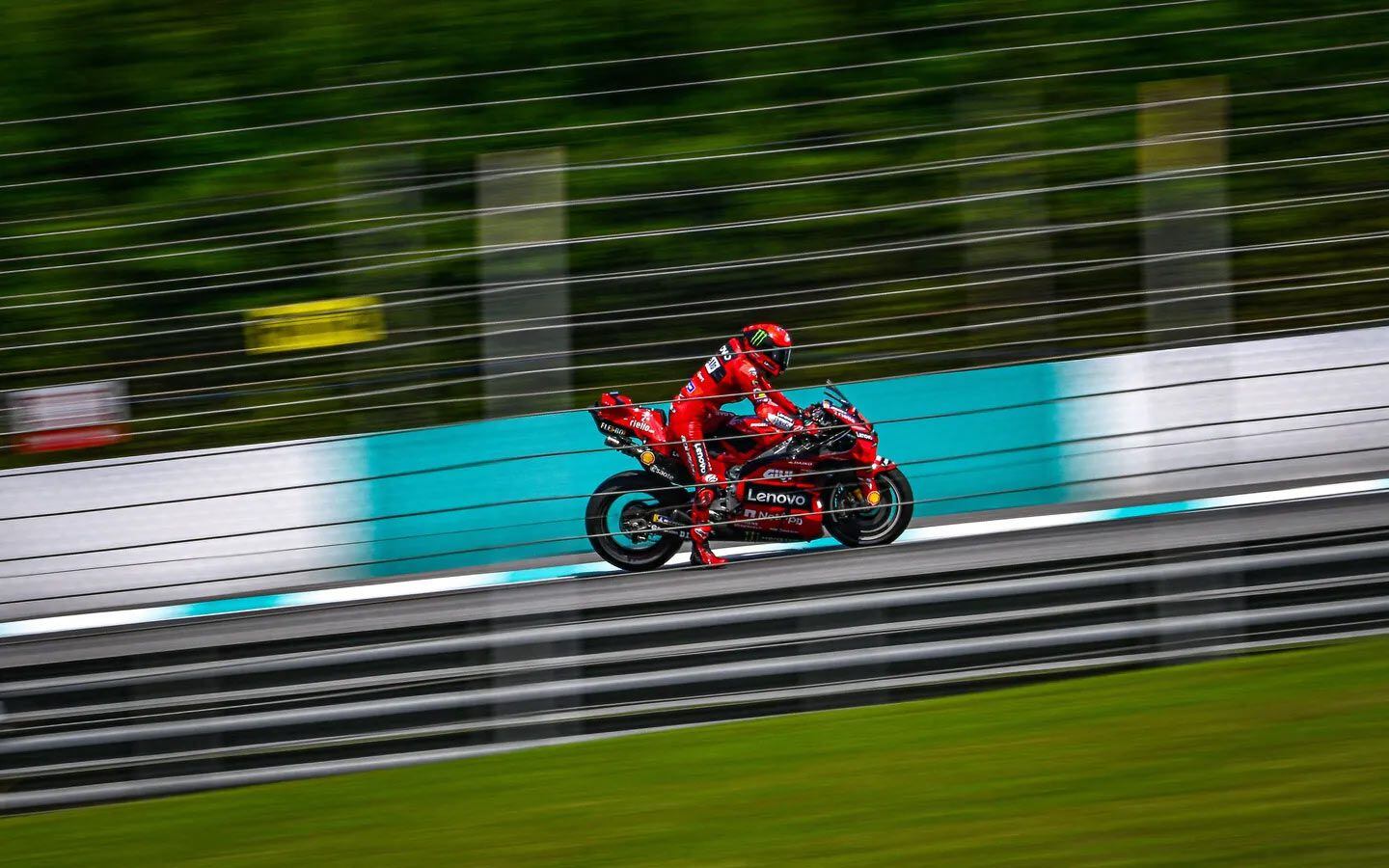
Bagnaia appeared cautiously fast all weekend, with a pair of podiums in the sprint and Sunday GP. (MotoGP/)Bagnaia said, “It was one of the best Fridays in a long time—the first time that I didn’t ask anything [from] my team for Saturday.”
In the recent past he has suffered from low starting positions as a result of lukewarm qualifying.
Martín, enjoying a recent rush of success—often winning both sprint and GP—was confident on Friday. After Sunday’s race he said, “I set off with a higher tire pressure than I wanted.
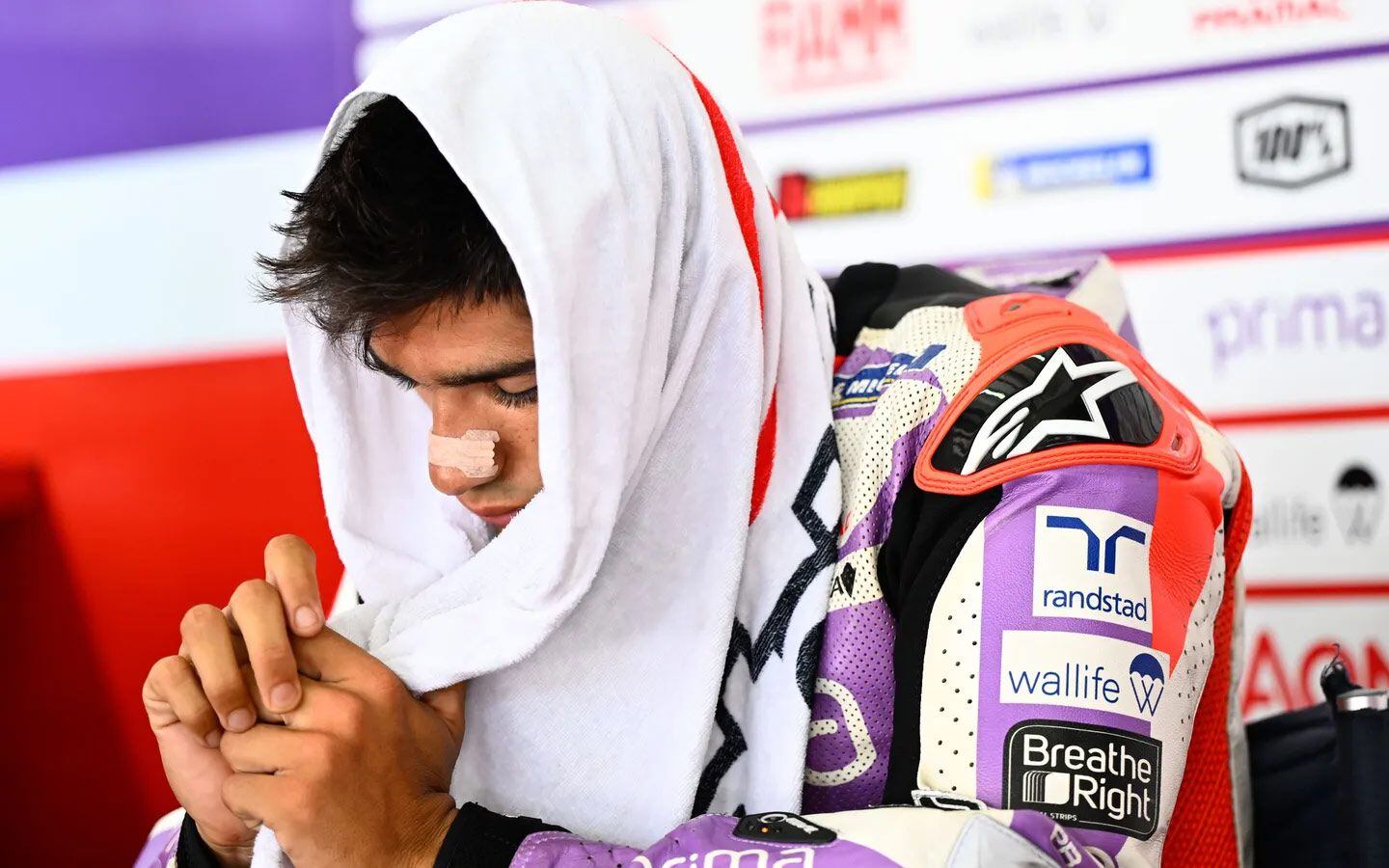
Jorge Martín’s recent success wasn’t duplicated at Sepang, but he minimized the damage and still very much remains in title contention. (MotoGP/)“After six laps I almost crashed in every corner. That was frustrating because I was never able to push in the race.
“Behind Pecco my front tire heated up enormously. Even later, the temperature and the high tire pressure didn’t drop.”
Another question: how did Quartararo finish fifth? The four Ducatis were seconds ahead of him, reducing his problem to that of holding position:
“…fifth place was the best possible result for me in the end.
“…we can’t take advantage of the fresh rear tire as the opponents can ride with much more power. We have to make up ground on the brakes. As soon as our opponents’ tires degrade we are much closer. That’s also the reason why we can then overtake.”
Most important change from last year is that the 2023 race was 15 seconds faster. It’s my view that much of this 0.75 second-per-lap improvement has come from riders being able to use more power on corner exits because aero downforce rather than anti-wheelie power cuts is keeping front tires on the pavement. Possible additional gains are owed to a partial repaving of the course, though some riders spoke of needing to “understand” the new surface (that is, to be able to predict its effect on front tire pressure).
Michelin’s capable traveling salesman Piero Taramasso reminded us that “…five riders beating the previous all-time circuit lap record during qualifying…confirmed that the developments of the Grand Prix motorcycles and our tires complement each other perfectly.”
Michelin is the source of the controversial rule requiring tire pressure (most notably the front tire pressure, because it rises when drafting another machine) to remain always above a set point that is very close to the onset of footprint shrinkage leading to brake locking and then to folding or closing the front.
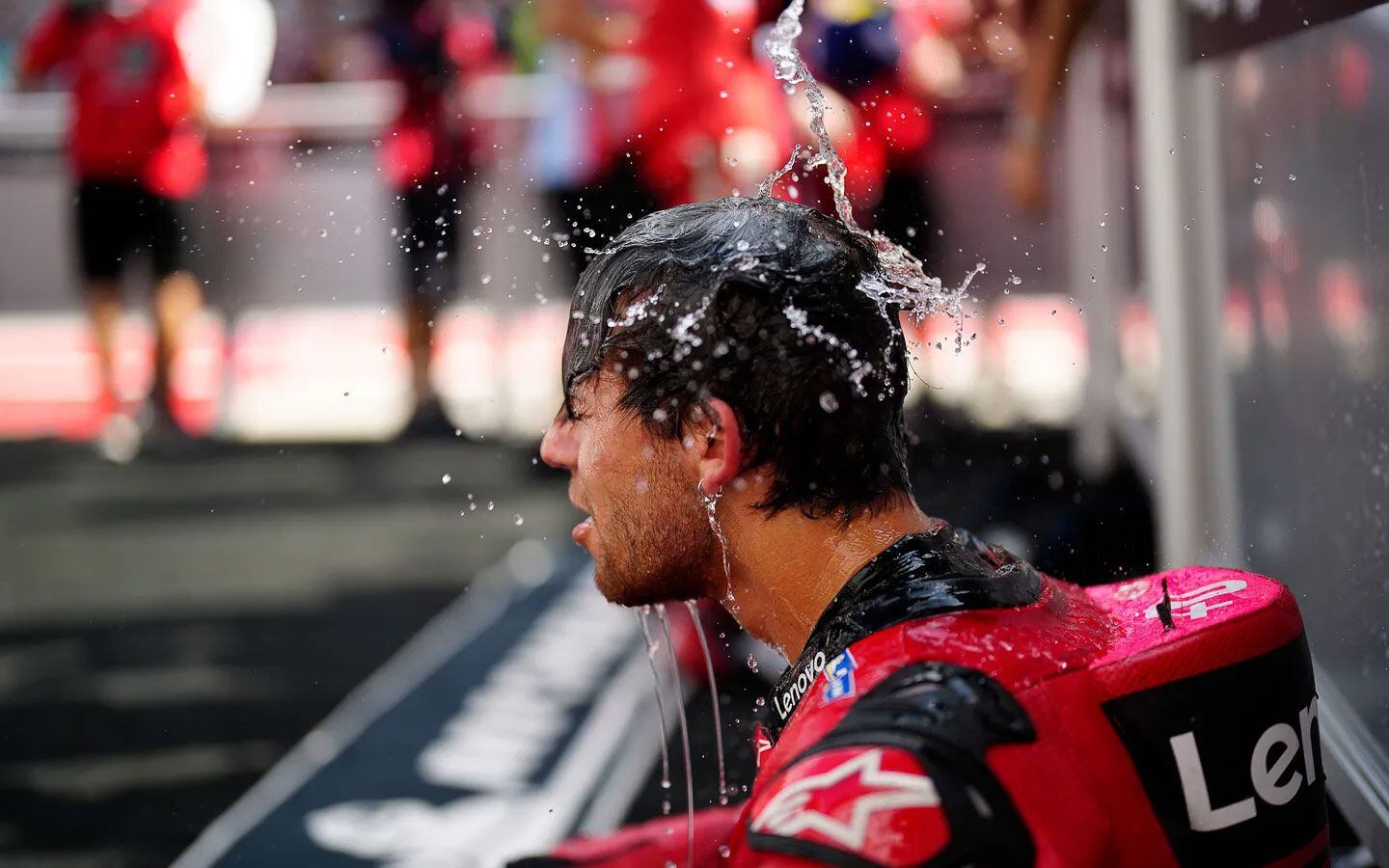
Malaysia’s heat and humidity take a toll on the riders. Bastianini, like most, was all but destroyed at the end of Sunday’s race. (MotoGP/)MotoGP bikes carry tire pressure senders whose data is displayed on the rider’s display and is also recorded for official scrutiny. Completing more than 50 percent of a race with a tire pressure below the set minimum earns a warning. Next year it will be more severely punished.
On the other hand, operating safely above the minimum causes the footprint to shrink enough to cause front wheel brake locking and/or folding or closing of the front end in corners.
The fact that several strong riders are usually relegated to uncompetitive positions in recent races by tire grip problems suggests that even highly experienced crews are frequently getting this wrong. The riders, able to see their front tire pressure climbing toward grip loss, are resorting to falling back in slipstreaming situations, in hope that hot air from the bike ahead will be diluted enough by cooler surrounding air that tire pressure will stop climbing. Clearly this is no way to race, and is at the same time a self-condemnation by Michelin.
I had initially thought Michelin’s reason for needing to set so high a minimum pressure was fear of the usual heat problems—blistering or chunking of the tire tread. Now a chance remark by Brad Binder confuses the issue: Binder said, “I understand the fear that the tire will jump over the rim if the pressure is too low. However, I’ve never seen that happen…
“I’m not alone. I’m sure every rider would welcome it if the minimum pressure was lowered a bit; 0.1 bar (1.5 psi) less would make the races better and all of us on the bikes safer.”
Safer, that is, from brake locking and losing front grip in corners. Did someone tell Binder that the danger of a bit lower pressure was that the tire would come off the rim? Are other users of Michelin tires told this? Or does the suggestion that underinflated tires may come off the rim come from a source other than Michelin?
Martín was understandably angry over this issue: “I think that the tire pressure rule is destroying real racing. This year there are only warnings, but from next season you will be disqualified because of it.
“We must urge those responsible to drop this rule or find a solution that makes the teams’ work easier.”
Easier, that is, than seeking an ideal tire pressure that may not exist between being disqualified or dealing with hazards like brake locking or losing the front end.
Surely the highly experienced Michelin—the origin of so many pneumatic tire innovations—can produce a front tire that is raceable without having to be inflated to a pressure that MotoGP riders associate with risks they are now experiencing. Perhaps the French company should consult its own marketing staff to estimate the value of the negative advertising this controversy is bringing it.
Only Qatar on the 19th of November and Valencia on the 26th remain, and the 2023 championship is still to be decided.
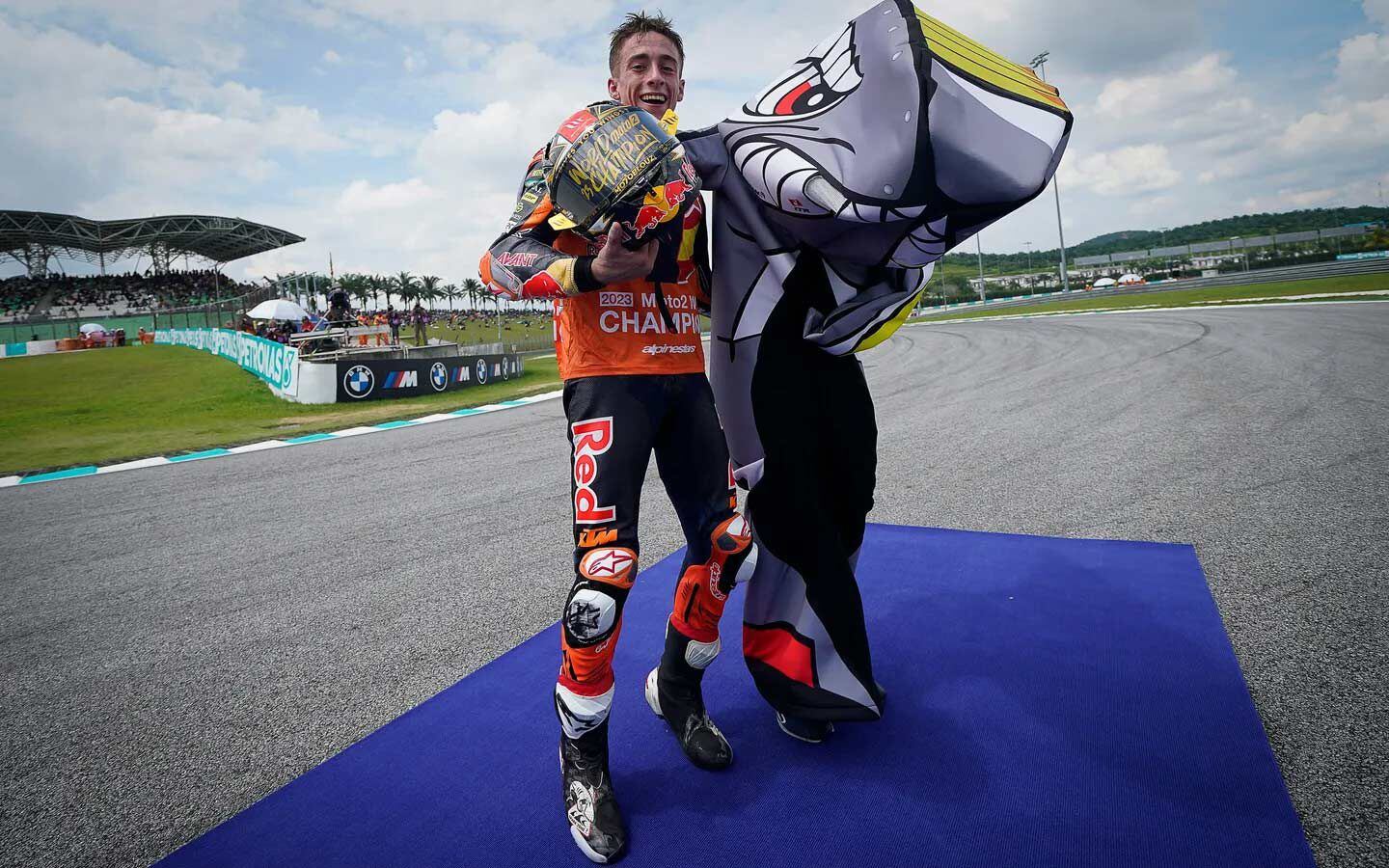
To no one’s surprise, KTM’s Pedro Acosta wrapped up the Moto2 title two rounds early. Next year he’ll join the MotoGP grid on a GasGas. (MotoGP/) -
Designed specifically for adventure-enduro machines, Givi’s new luggage options are ready to take a hit.
-
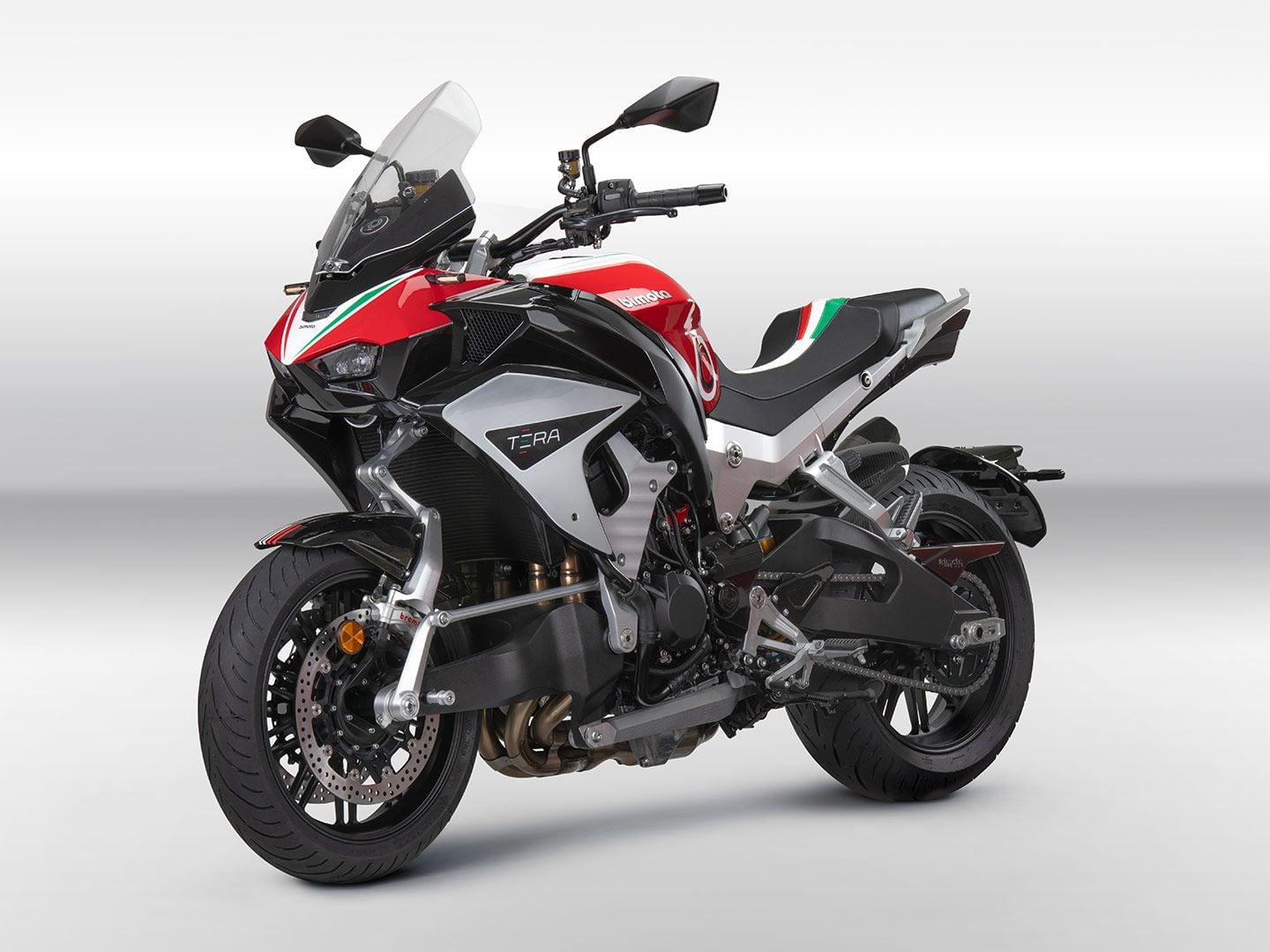
Bimota’s brand-new Tera was quietly revealed at the EICMA show on display in parent company Kawasaki’s booth. (Bimota/)Back in 2019, Kawasaki acquired full control of Bimota, and for the small but prestigious Rimini-based brand that meant the end of many years of hand-to-mouth management. Under the wing of Kawasaki, Bimota has found financial stability and a solid platform on which to build its future.
At EICMA 2023, Bimota’s offerings were hosted in Kawasaki’s display area and its visibility was limited. Yet there, Bimota officially unveiled the Tera concept (TEsi con Regolazione di Altezza, Tesi with adjustable height) in its final, production-ready form. Tera has been in the works for about three years and its unique and patented front end was presented independently a year ago. It is the latest evolution of the hub-steer front end according to Bimota CEO Pierluigi Marconi, the man who created the famed Tesi chassis.
Bimota’s Tera steering system was conceived to overcome range-of-motion limits that make the original Tesi design less than capable during tight turning maneuvers—since the steering is locked inside the front wheel hub. The Tera design has increased the side-to-side steering range to 35 degrees, 16 more than on the Tesi H2.
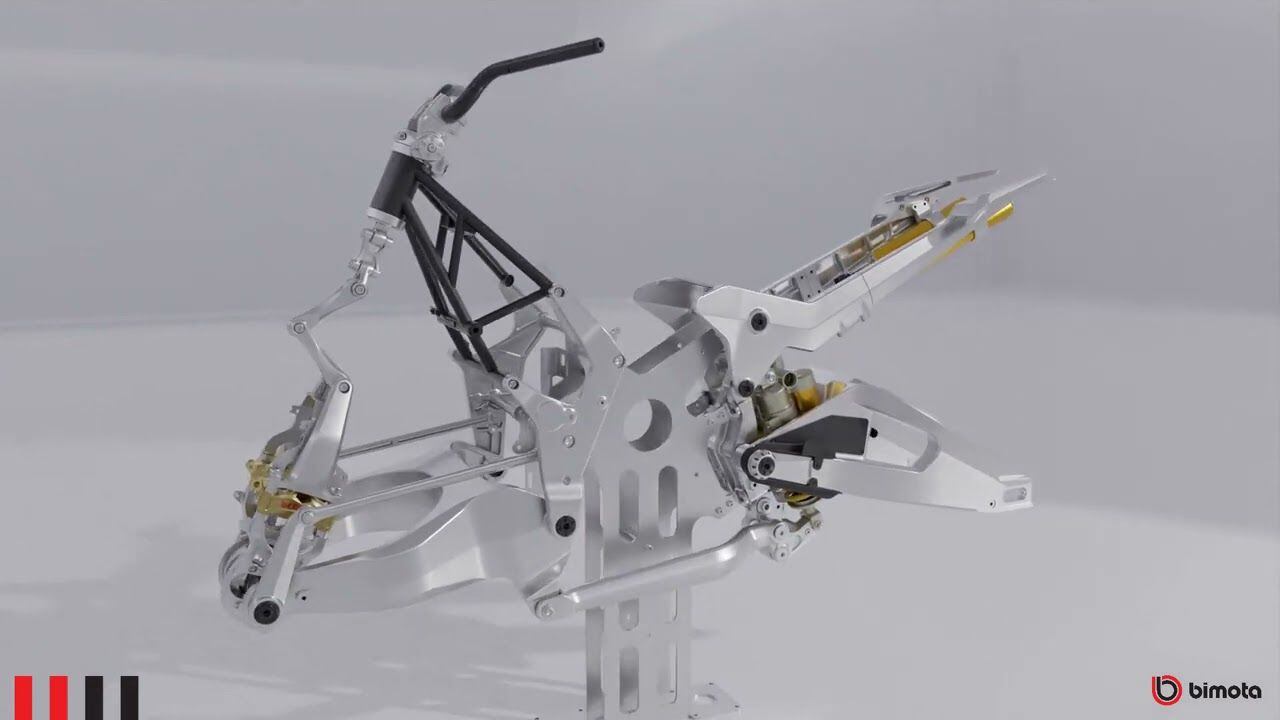
A closer look at the chassis layout. (Bimota/)The new front suspension-steering system—patented by Bimota—retains the main virtues of the original Tesi system, i.e., an anti-dive effect while also greatly reducing unsprung masses. The steering itself is represented by a knee-type link that actuates the shock absorber located inside the steering head. A set of aluminum arms with reaction rods provide precise vertical movement and are connected to the front wheel via a pair of machined billet plates that also carry the calipers of the front braking system.
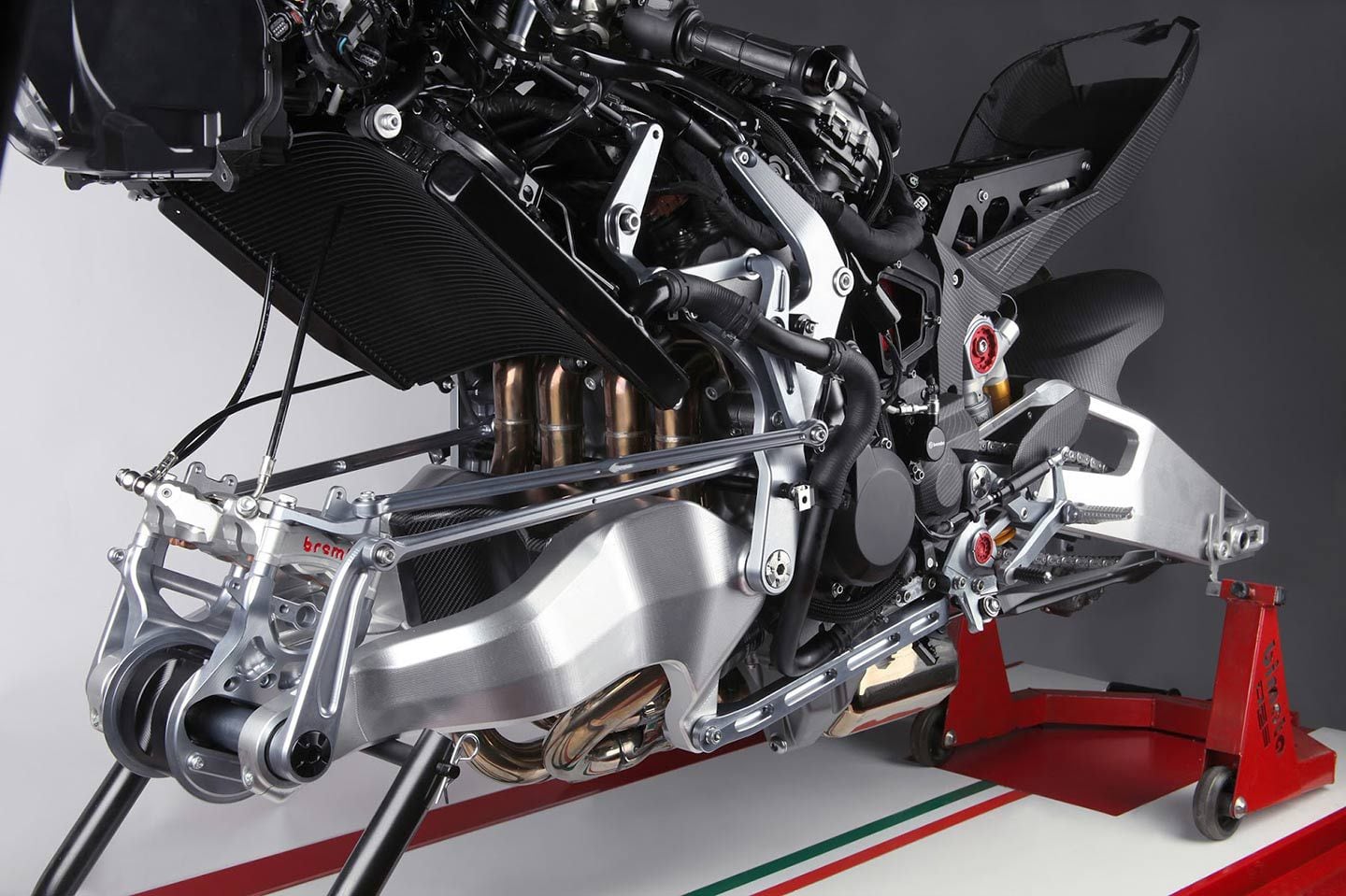
A look at the front suspension design without the knee-type link. (Bimota/)A pair of bearings ensure freedom of side-to-side movement of the wheel, while solidly connecting it to the axle that is fixed to the suspension arms. This new evolution of Marconi’s Tesi concept also offers the possibility of adjusting the height of the center of gravity by 30mm.
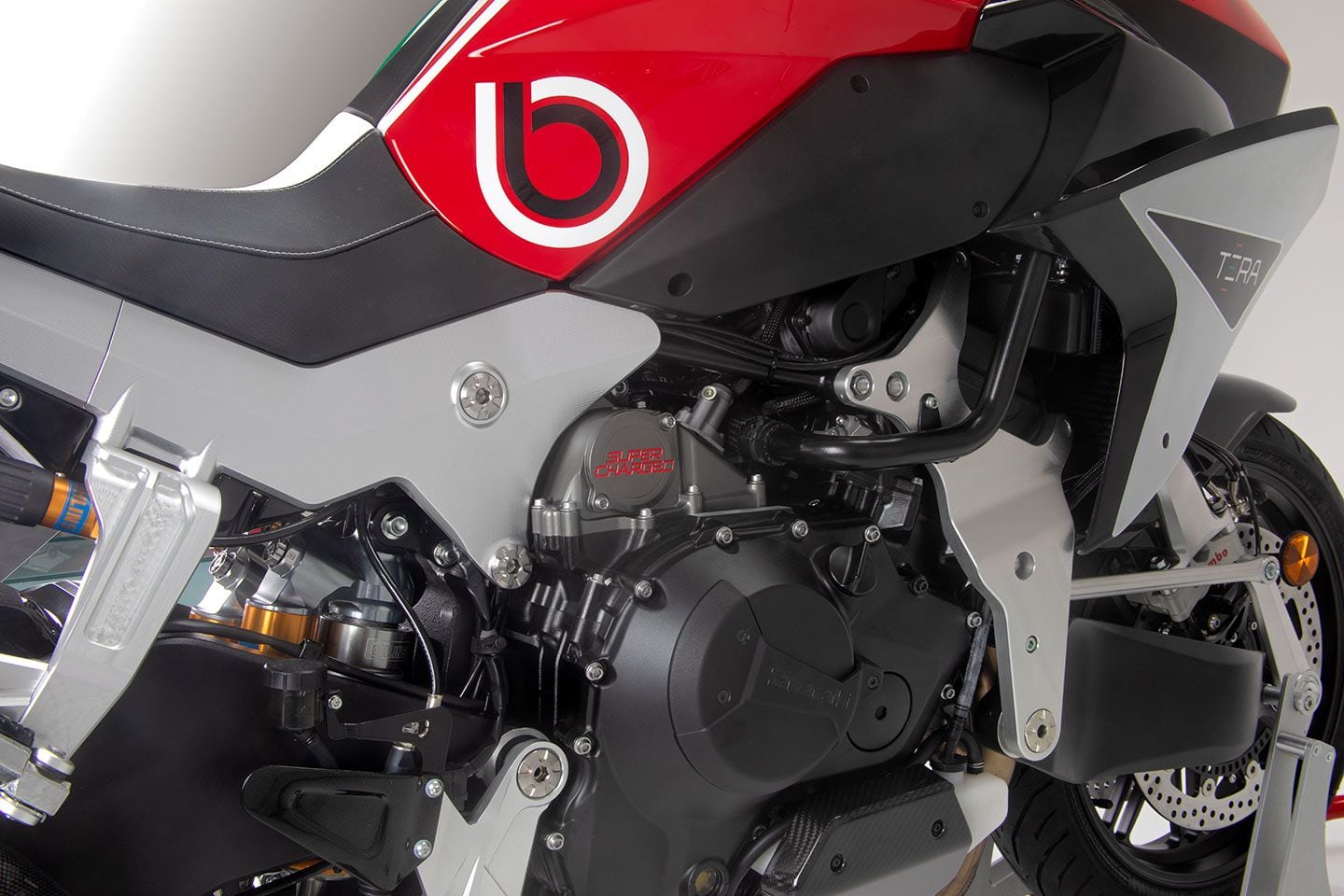
The front frame and rear frame both bolt the engine, which is used as a stressed member and forms the center of the bike’s chassis. (Bimota/)The main front section of the chassis on the Tera uses a frame based on two machined billet-aluminum plates, and a short steel-tubing trellis structure that houses the steering head. The engine acts as the center of the chassis (as a stressed member), while the only thing connecting the front and rear is an arm that joins the front frame to the rear swingarm/shock’s pivot point on the left side, and the engine.
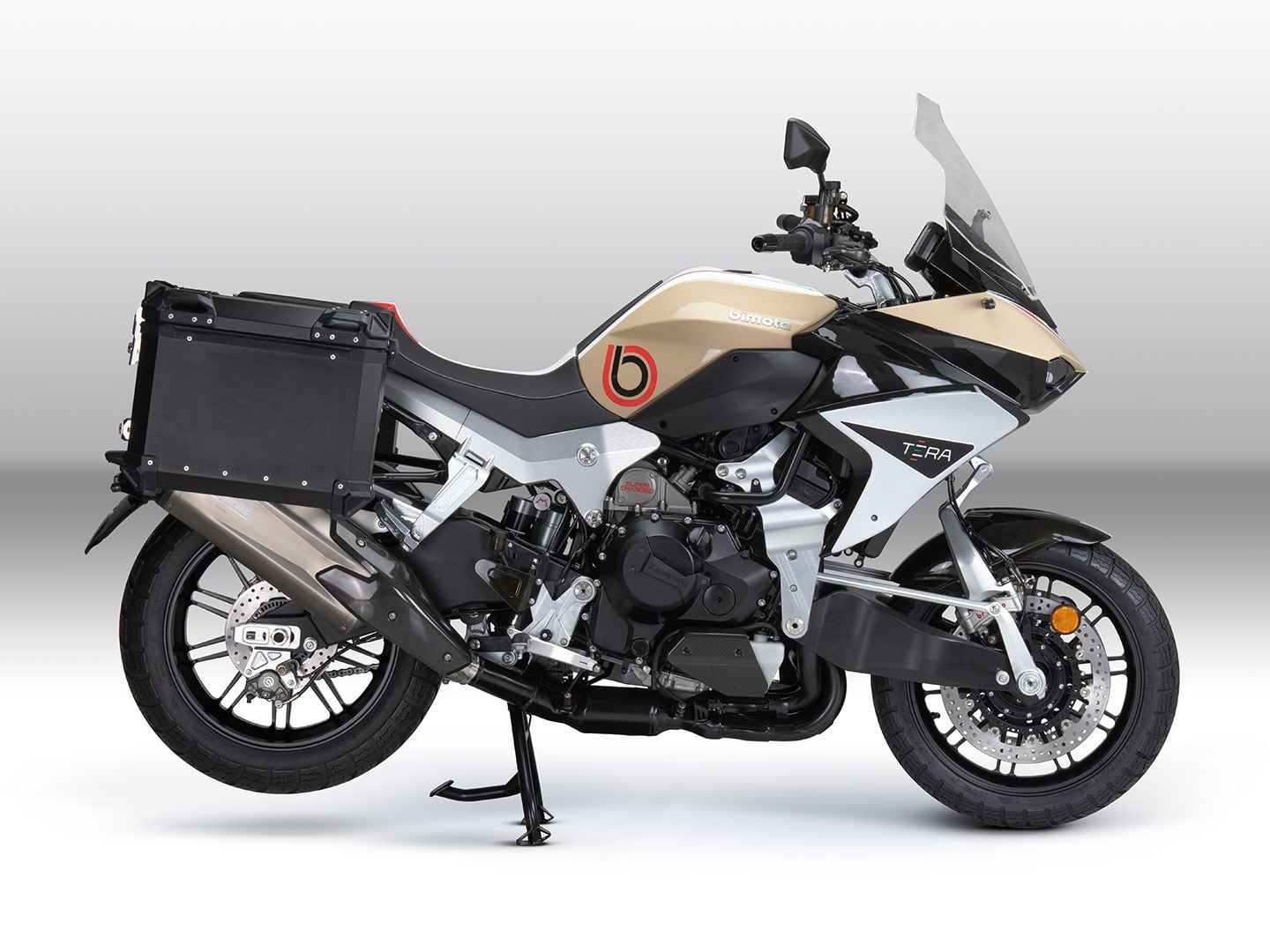
The Bimota Tera with aluminum side cases. (Bimota/)The combined structure is light weight and yet rigid enough to harness the supercharged inline-four Kawasaki H2 engine that is rated at a claimed 200 hp at 11,000 rpm, with 101 lb.-ft. of peak torque delivered at 8,500 rpm.
While Bimota hasn’t released front-end geometry numbers, the wheelbase is a compact 56.9 inches, which is identical to Aprilia’s Tuono V4 Factory and much shorter than other street-biased adventure bikes like Ducati’s new Multistrada V4 RS that stretches out to 62.7 inches.
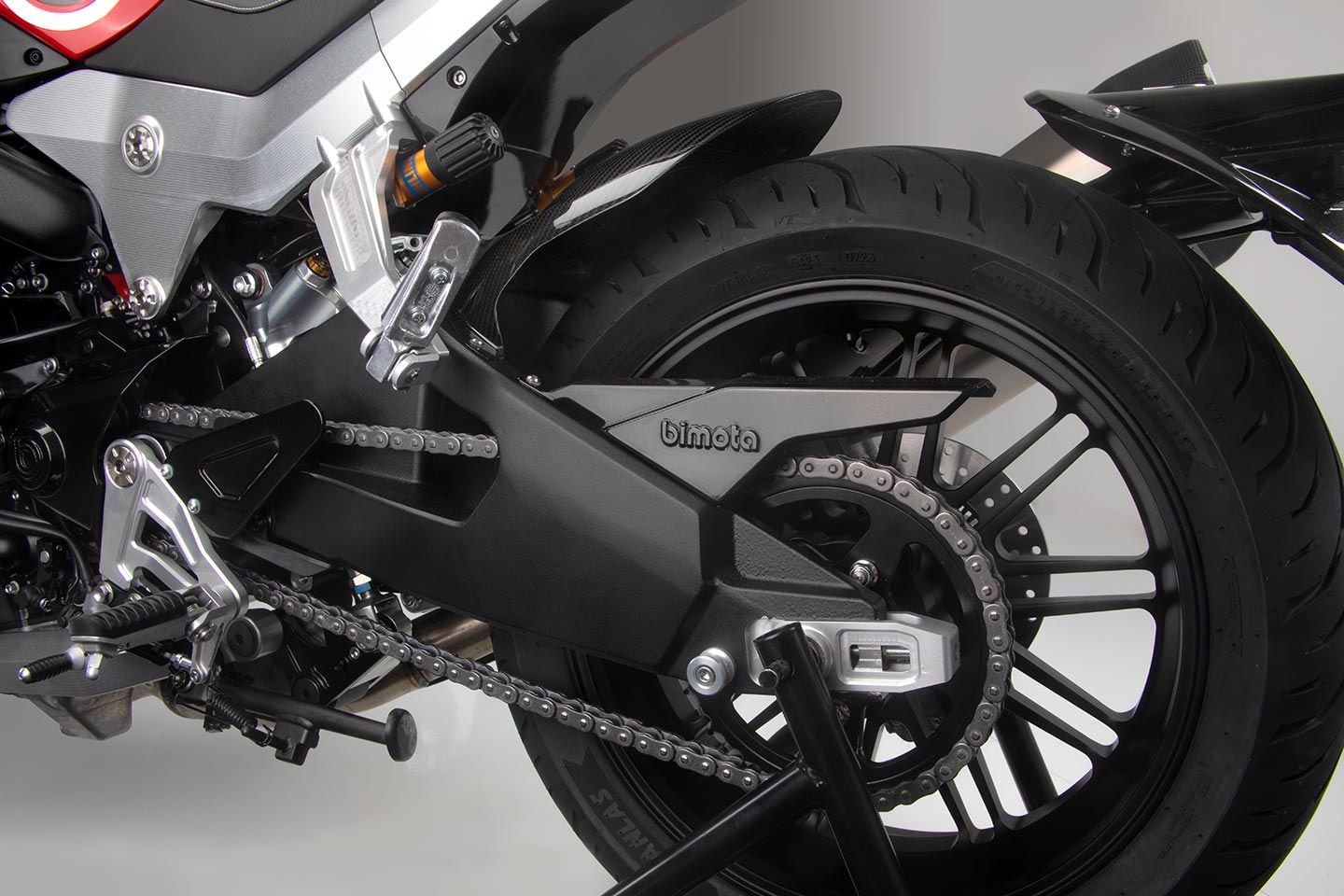
Close-up of the forged magnesium wheels and rear suspension. (Bimota/)Rolling gear includes the 10-spoke forged magnesium wheels in 17 x 3.5 and 17 x 5.5 sizes, mounted with 120/70-17 and 190/55-17 tires. A pair of Brembo four-piston Stylema calipers and 330mm discs are used in the front, and a twin-piston caliper and 220mm rotor is used in the rear. Kawasaki’s KIBS ABS system is utilized.
Kawasaki also provides the electronics suite that includes cornering ABS and traction control, four ride modes, and cruise control. A full-color TFT display is the hub to view and change all settings, while also providing all of the bike’s basic display information.
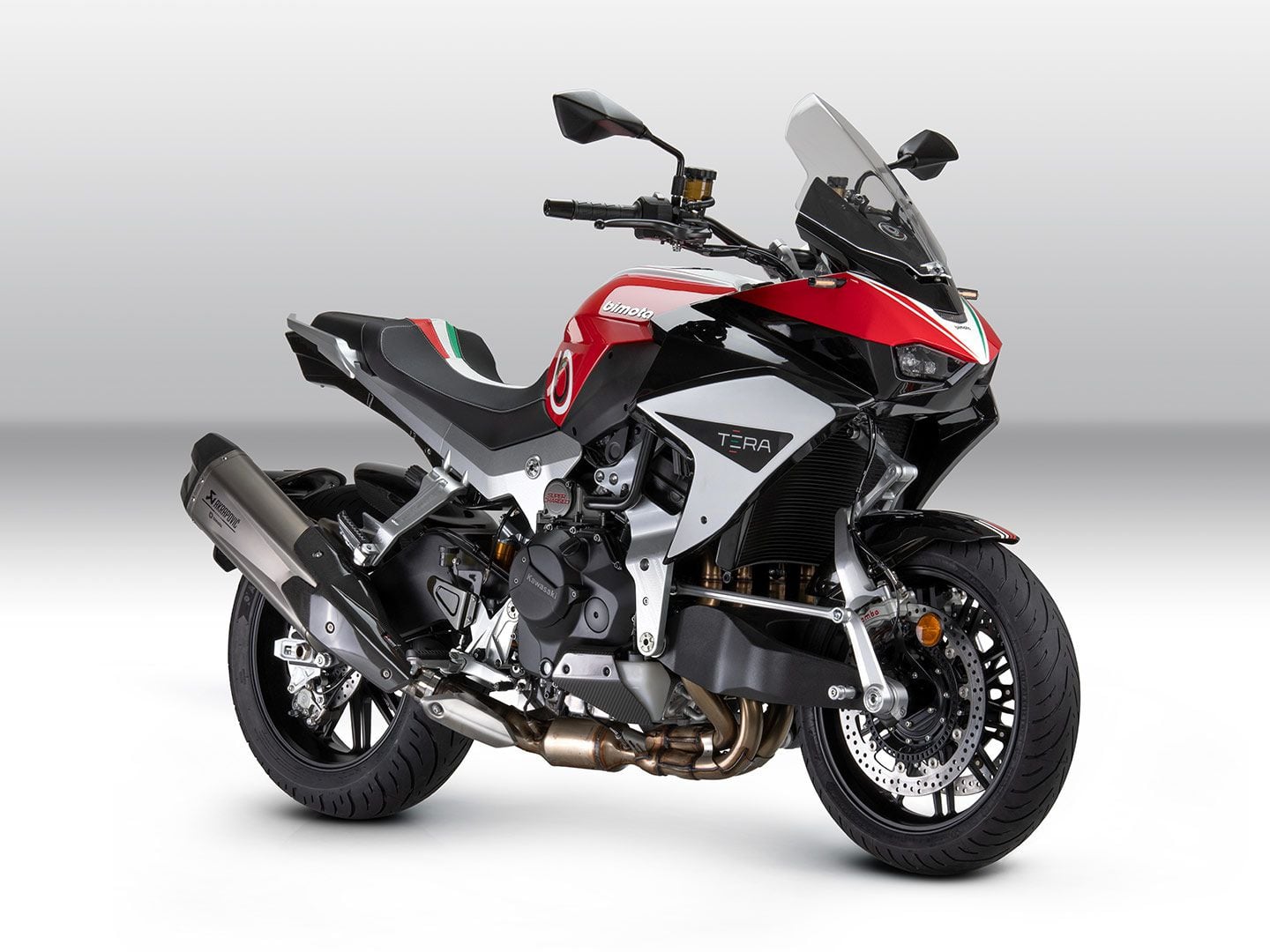
Pipe-side view of the Bimota Tera. (Bimota/)Much like a variety of new street-oriented adventure models, the Tera can be categorized as a “crossover,” with superbike-like performance from the engine, but an upright and comfortable riding position. With its novel chassis construction and use of lightweight materials, Bimota has managed to keep the curb weight at an impressively low 440 pounds.
When Bimota releases more detailed information about when it will go on sale and for how much, we’ll provide an update.
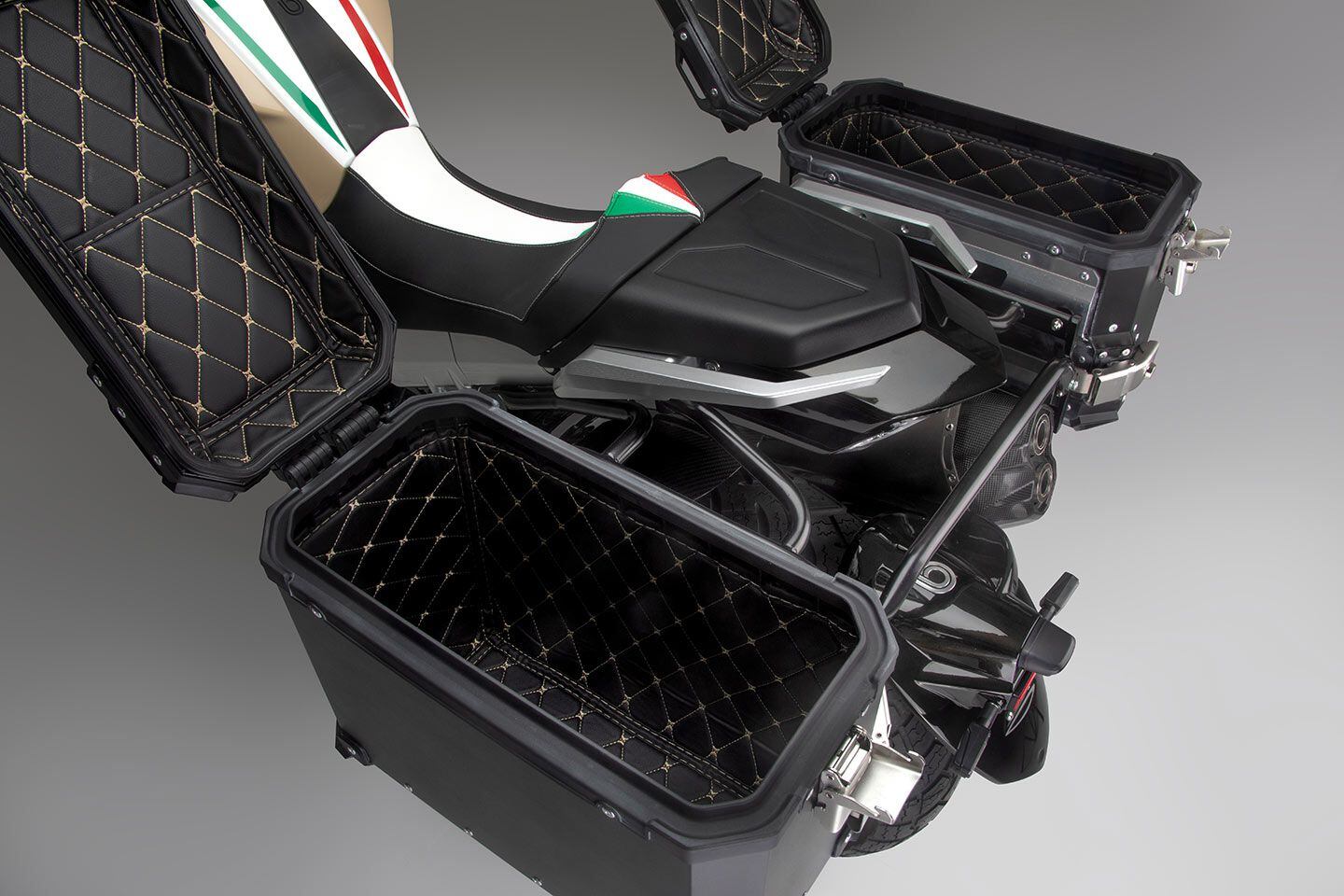
A look inside the aluminum side cases. (Bimota/)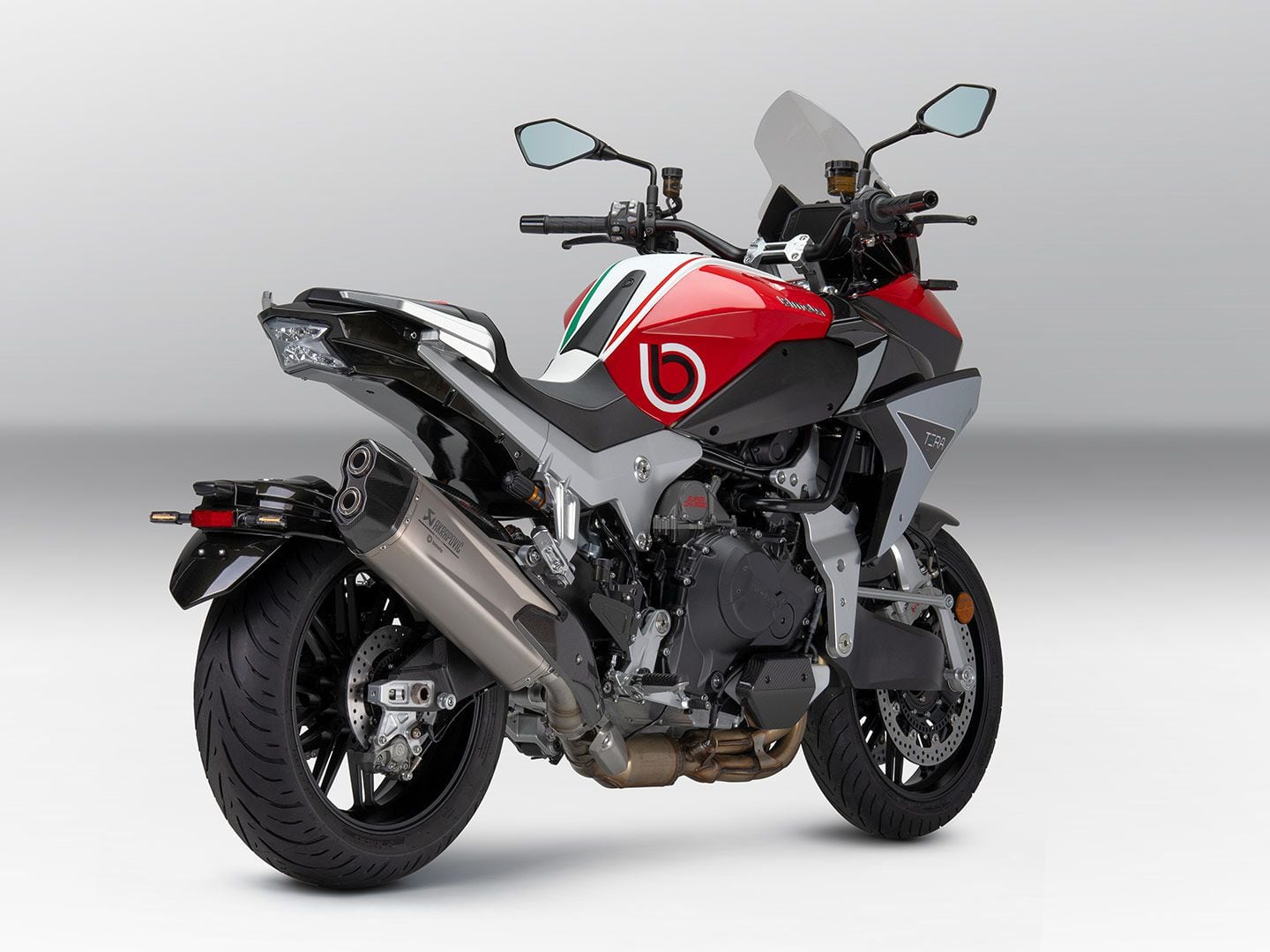
Rear view of Bimota Tera and the titanium Akrapovič exhaust with a carbon fiber end-cap. (Bimota/)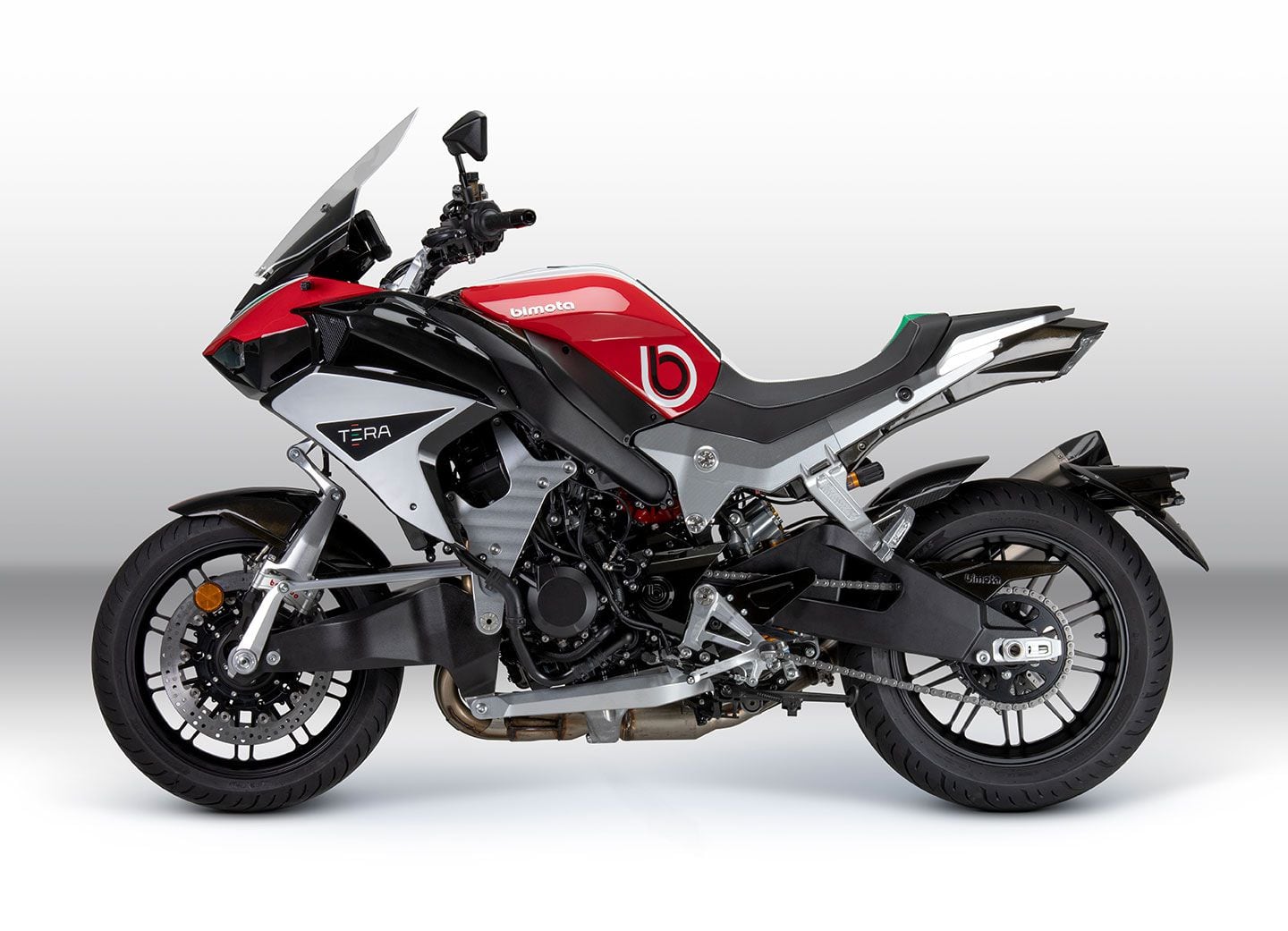
Left-side view of Bimota Tera. (Bimota/) -
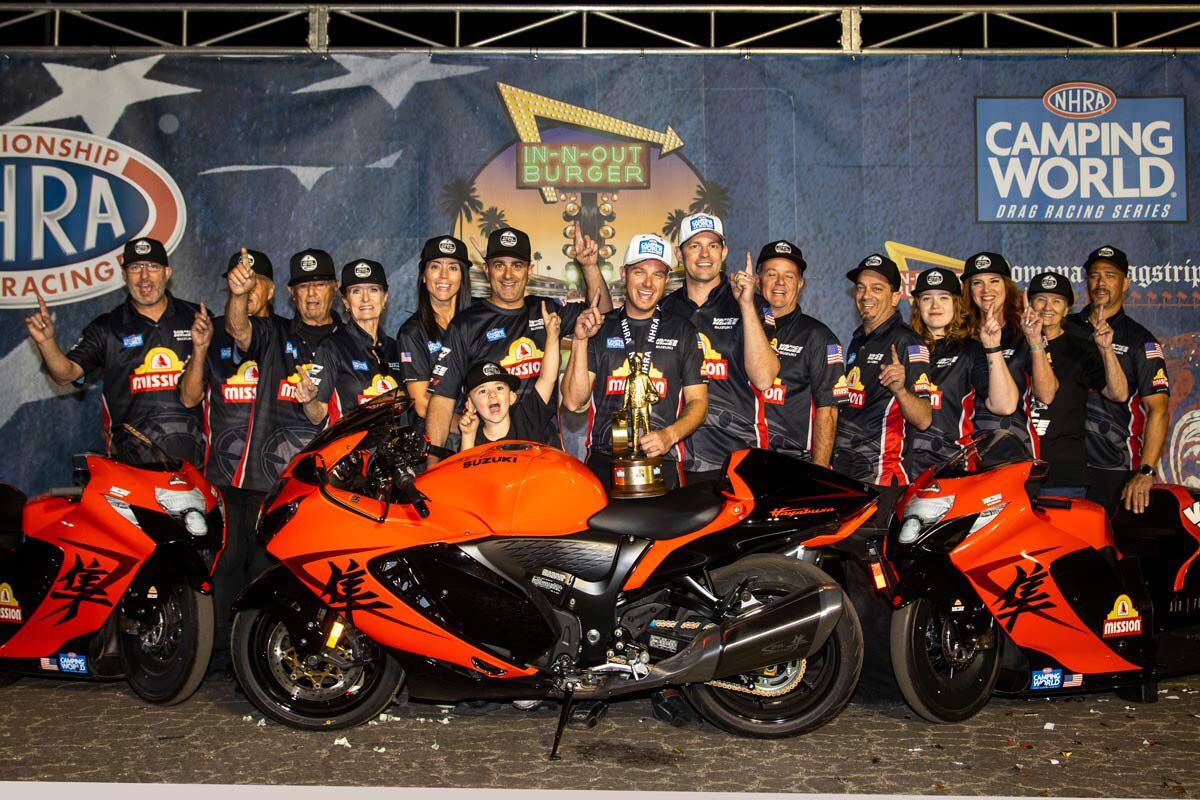
Vance & Hines/Mission Suzuki Storm to Pro Stock Motorcycle World Championship (Suzuki/)Suzuki Press Release:
Gaige Herrera won his first NHRA Pro Stock Motorcycle World Championship and 11th race of the season as he faced off against his Vance & Hines/Mission Suzuki teammate Eddie Krawiec for a fourth-straight race at the In-N-Out Burger NHRA Finals at the In-N-Out Burger Pomona Dragstrip in Pomona, CA, on Sunday.Race Highlights
- Gaige Herrera qualified No. 1 for the 14th time and won his 11th race of the season, both class records, and clinched his first career Pro Stock Motorcycle World Championship.
- Eddie Krawiec qualified third, advanced to a fourth-straight all-Vance & Hines/Mission Suzuki team final and finished second overall in the 2023 championship standings.
Riding a Gen III Suzuki Hayabusa wearing a special livery commemorating the 25th Anniversary of the legendary Suzuki Hayabusa motorcycle and racing in front of a large crowd of Suzuki fans celebrating at the Hayabusa Homecoming, Herrera qualified his Hayabusa number one for the 14th time this season with a 6.661-second/203.80 mph run that re-set the Pomona track’s elapsed time record.
In round one, Herrera coasted to a win against Blaine Hale, who fouled on the starting line. In the second round, he defeated 2010 world champion LE Tonglet (6.839 seconds/195.14 mph) with a 6.744-second/201.76 mph run to advance to the semi-finals against veteran Steve Johnson, whom he defeated with a 6.713-second/202.33 mph run, his quickest of the day, outpacing Johnson’s 6.850-second/197.54 mph pass.
Herrera’s semi-final victory over Johnson set up an all-Vance & Hines/Mission Suzuki final-round matchup against Eddie Krawiec for the fourth race in a row. Once again, as he had done on the three prior occasions, Herrera and his Hayabusa denied his mentor a milestone 50th career win, defeating the four-time champion with a 6.721-second/201.46 mph run against Krawiec’s 6.796-second/199.52 mph pass.
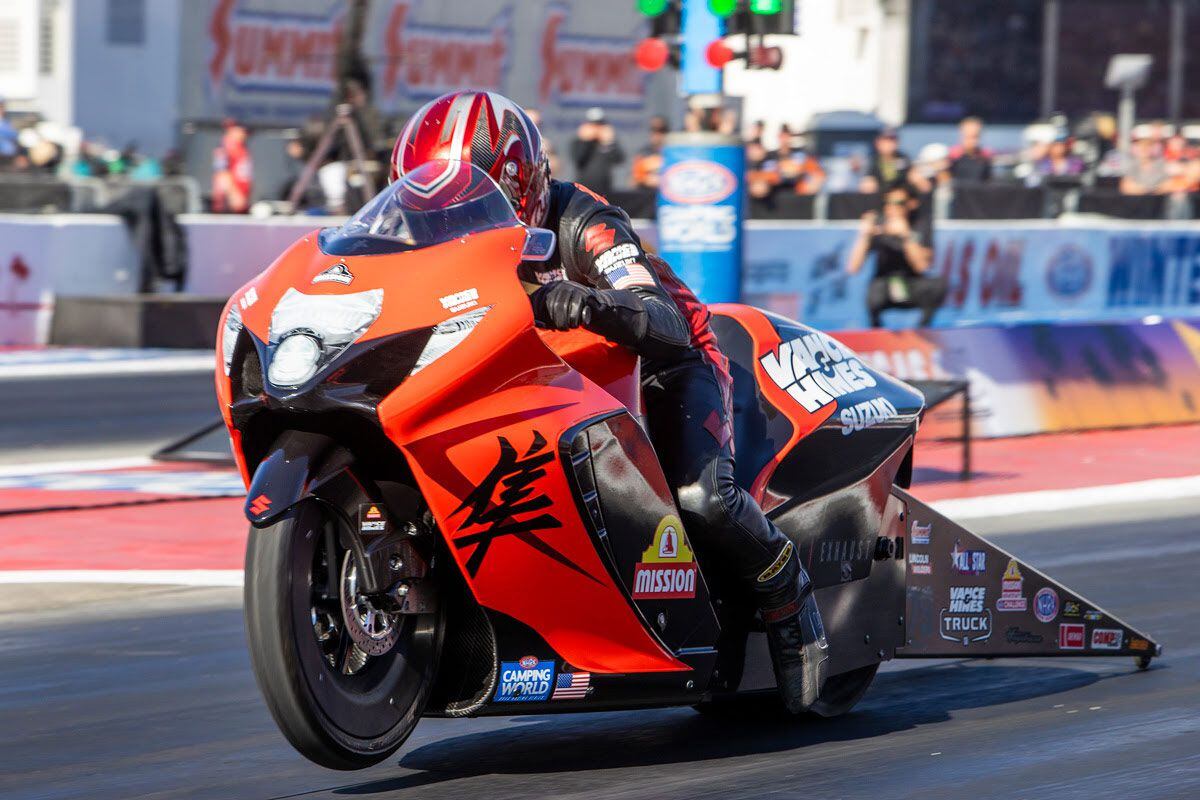
Gaige Herrera (79) caps off his record-breaking rookie season with a win in the NHRA Finals and a Pro Stock Motorcycle Championship. (Suzuki/)In a season of superlatives and achievements as dominant as any in NHRA history, Herrera was the top qualifier in 14 of 15 races and won 11 of them, both class records. Herrera also set a new national elapsed-time record of 6.627 seconds and won the Pro Stock Motorcycle world championship in his first full season as a rider. Herrera’s championship is the 14th overall for the Vance & Hines/Mission Suzuki team, which finished the season first and second in the overall class standings.
”This season has been a dream. It’s surreal and almost doesn’t feel real at all. I’ve worked very hard to get to this point in my career. It’s amazing what we’ve accomplished as a team, all the wins and records we set. Having so much confidence in the performance and preparation of my Suzuki Hayabusa really helped me focus on riding the bike and getting the most out of this iconic motorcycle. It’s not just my championship. It belongs to the whole Vance & Hines/Mission Suzuki team,” Herrera said.
Looking ahead to next season, Herrera knows the rest of the class will be gunning for him. “Next year is going to be very competitive. Many teams will be stepping up their programs and coming for me. This year most people didn’t expect us to have the performance we did, especially with it being my first season riding full-time. I think next season will be harder for me, but I’m excited about it. I’m looking forward to winning a lot more races.”
Seeking his first win of the season and 50th of his career, Krawiec qualified third with a 6.734-second/201.94 mph pass to open the Pomona finals weekend.
In round one, Krawiec defeated Chris Bostick (7.016 seconds/179.80 mph) with a 6.757-second/201.55 mph blast, then advanced to the semi-finals with a 6.958-second/199.58 mph second-round victory over Marc Ingwersen, who fouled on the starting line. In the semi-finals, Krawiec defeated Hector Arana Jr. (6.880 seconds/196.36 mph) with a 6.819-second/200.53 mph run to set up yet another final-round matchup against Herrera, who once again denied him the career milestone victory.
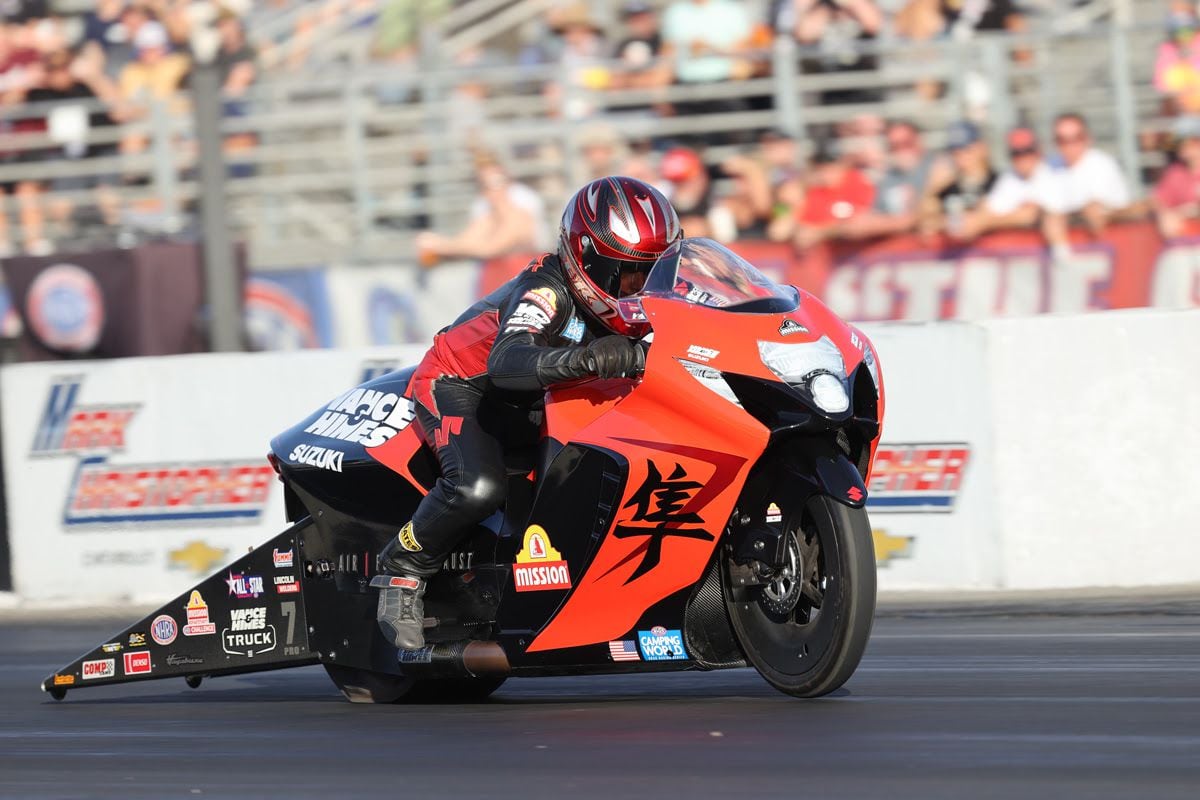
Eddie Krawiec (7) finishes his season with his head held high earning a solid second-place finish in the 2023 championship. (Suzuki/)On the strength of his strong performance over the second half of the season, Krawiec finished second in the championship, locking out the top two spots for the Vance & Hines/Mission Suzuki team.
”To finish one and two in a class that is as competitive as ours isn’t easy. We were able to get my Hayabusa into a really good position in the second half of the season. At the end of the day, I had a great race bike, but Gaige’s was just a little bit better. It was a great year. I went to four finals in the last four races and without Gaige here, I would have had another championship season,” Krawiec said. “What we saw this year from Gaige is something special. It doesn’t just happen all the time. He was machine-like pretty much all year long, made no mistakes, and was super consistent. When someone does that, it’s hard to beat.”
Vance & Hines/Mission Suzuki crew chief Andrew Hines credited the championship to a complete team effort on and off the track, Herrera’s talent as a rider, and the exceptional performance of the new Gen III Hayabusa that debuted this season.
”Never in our wildest dreams could we have expected this at the start of the season. Suzuki gave us a fast baseline with the new Gen III Hayabusa, which is bar-none the best motorcycle in the class. It’s almost effortless for our riders to make runs close to perfection on the Hayabusa. It’s a beautiful machine. Gaige was rock solid and rode like a veteran all season long. The exceptional thing is what he can do on a motorcycle in the first 10 feet of the run. As a crew chief, I can exploit that with the clutch setup and horsepower, and together it makes a potent combination. He’s next level. Eddie went to four straight finals, and in any other normal year, he would have won another championship, but his challenge was that the best motorcycle in the class was parked right next to him in the pit area,” Hines said. “As a team, we strive for greatness. Our status quo is to be the best. We sacrifice time with our families and work endless hours to make sure our motorcycles are immaculate, fast, and well-prepared. We come together under adversity like this weekend with Gaige’s bike. This championship is a testament to the guys here at the track and the support crew back at our shop who don’t get the accolades on TV. They all work so hard to make sure the motorcycles we bring to the track are the best.”
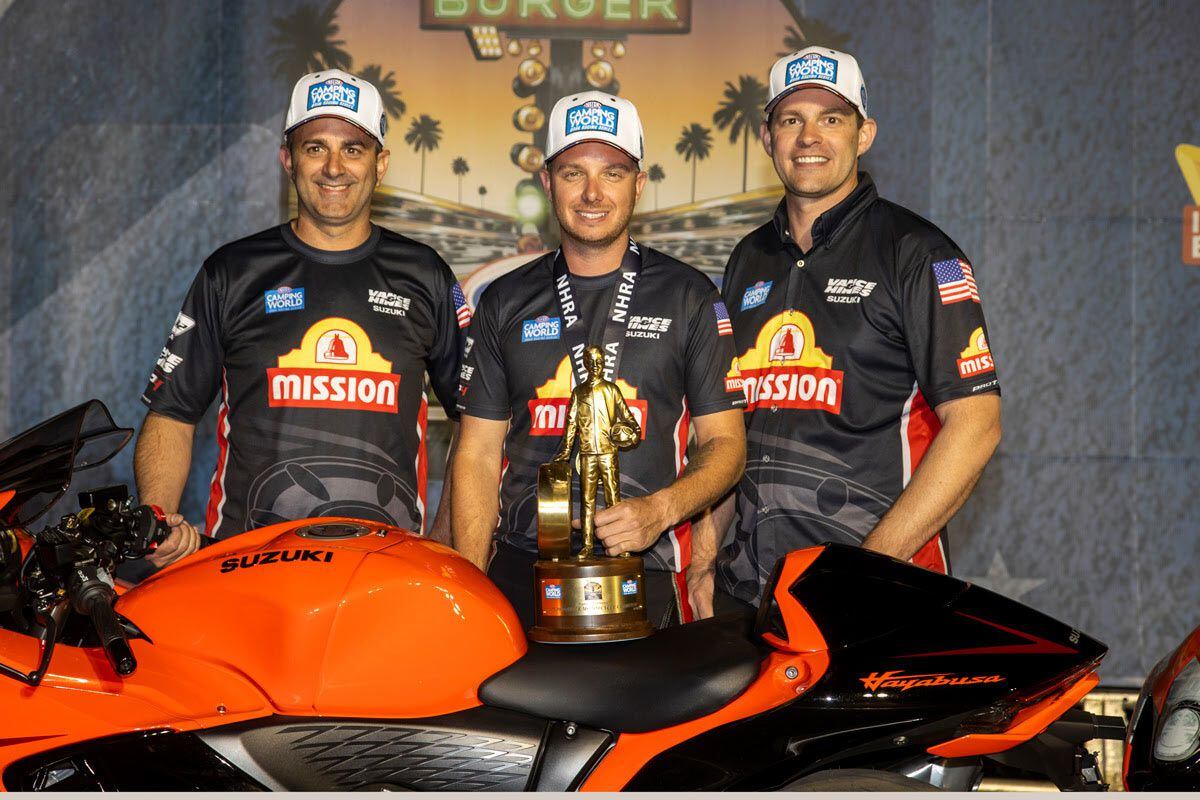
The Vance & Hines/Mission Suzuki team is looking forward to what is to come next season. (Suzuki/)After the 2023 NHRA season, Herrera and Krawiec finished first and second in the Pro Stock Motorcycle standings with 2,877 and 2,663 points, respectively.
The Vance & Hines/Mission Suzuki team will return to action for the 15-race 2024 Pro Stock Motorcycle season on March 7-10, 2024, at the season-opening NHRA Gatornationals at Gainesville Raceway in Gainesville, FL.
-
The SRT 800SX is QJ Motor’s newest entrant into the rapidly growing middleweight ADV segment.
-
The new X.27 and X.21 promise safety, comfort, and convenience.
-
The name change is meant to pay homage to the Honda NX650 Dominator from the late 1980s.
-
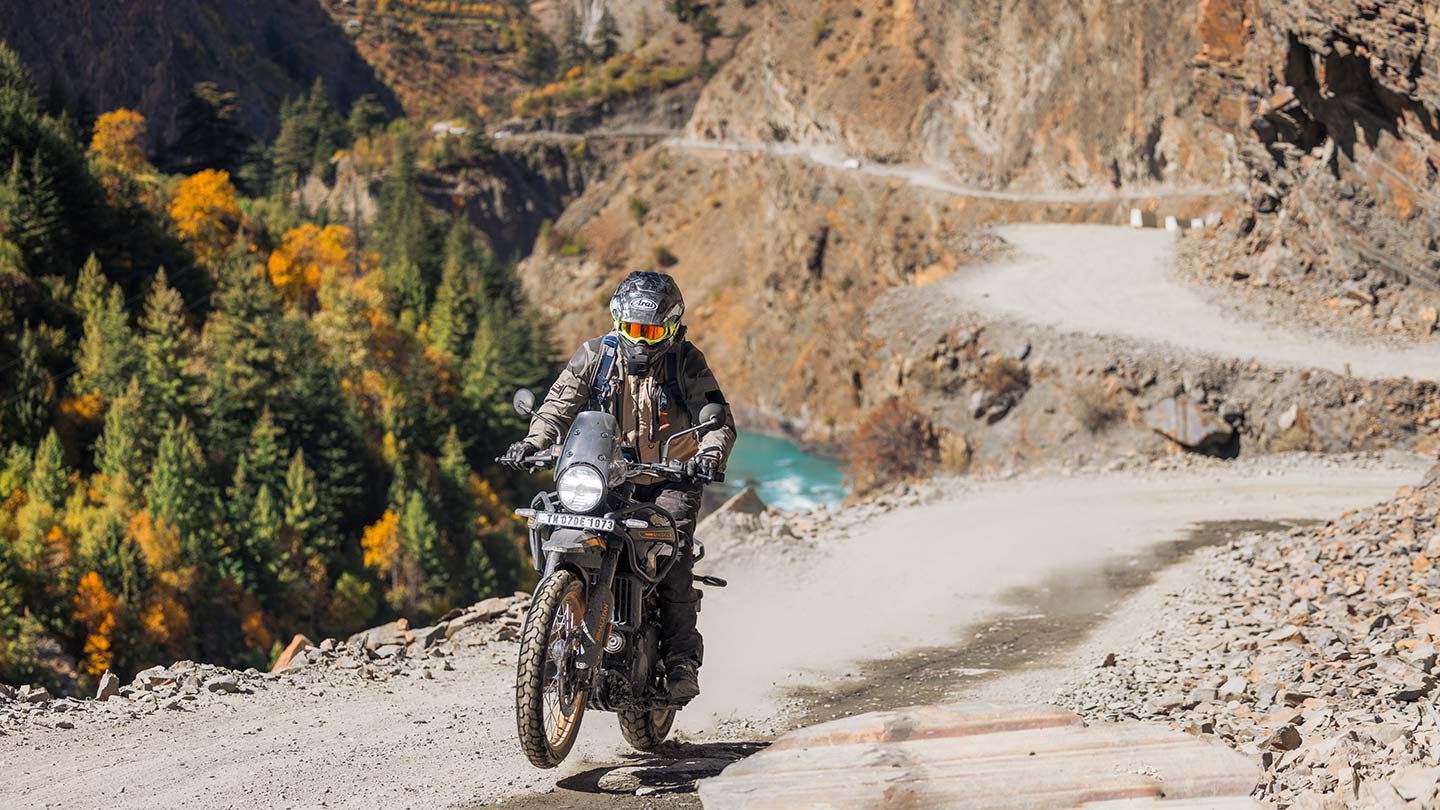
The brand-new 2024 Royal Enfield Himalayan is a fully modern and fully capable adventure motorcycle. (Royal Enfield/)Change hasn’t been the highest of priorities for Royal Enfield over its 124 years of making motorcycles. But then again, since 1956, when the company started manufacturing bikes in the Chennai plant in India, there really hasn’t been a big need for much revolution; RE’s models have served its primary Indian market well, and proved novel in Europe and the US. However, in the past few decades there has been significant growth, starting with 2008′s Unit Construction Engine (UCE) produced until 2020, then followed by the current 350cc J-platform, 411cc L-platform, and 650cc P-platform engines. Even with the massive progress in virtually every regard, these air-cooled singles and parallel twins still have more in common with their past than the future.
But the brand-new for 2024 Himalayan is the most radically different motorcycle that the company has ever made, offering a totally modern engine and electronics package mated to a chassis that is more capable than anything before it. In fact, there isn’t a single part on the new Himalayan that is common with the model that first went on sale in 2016.
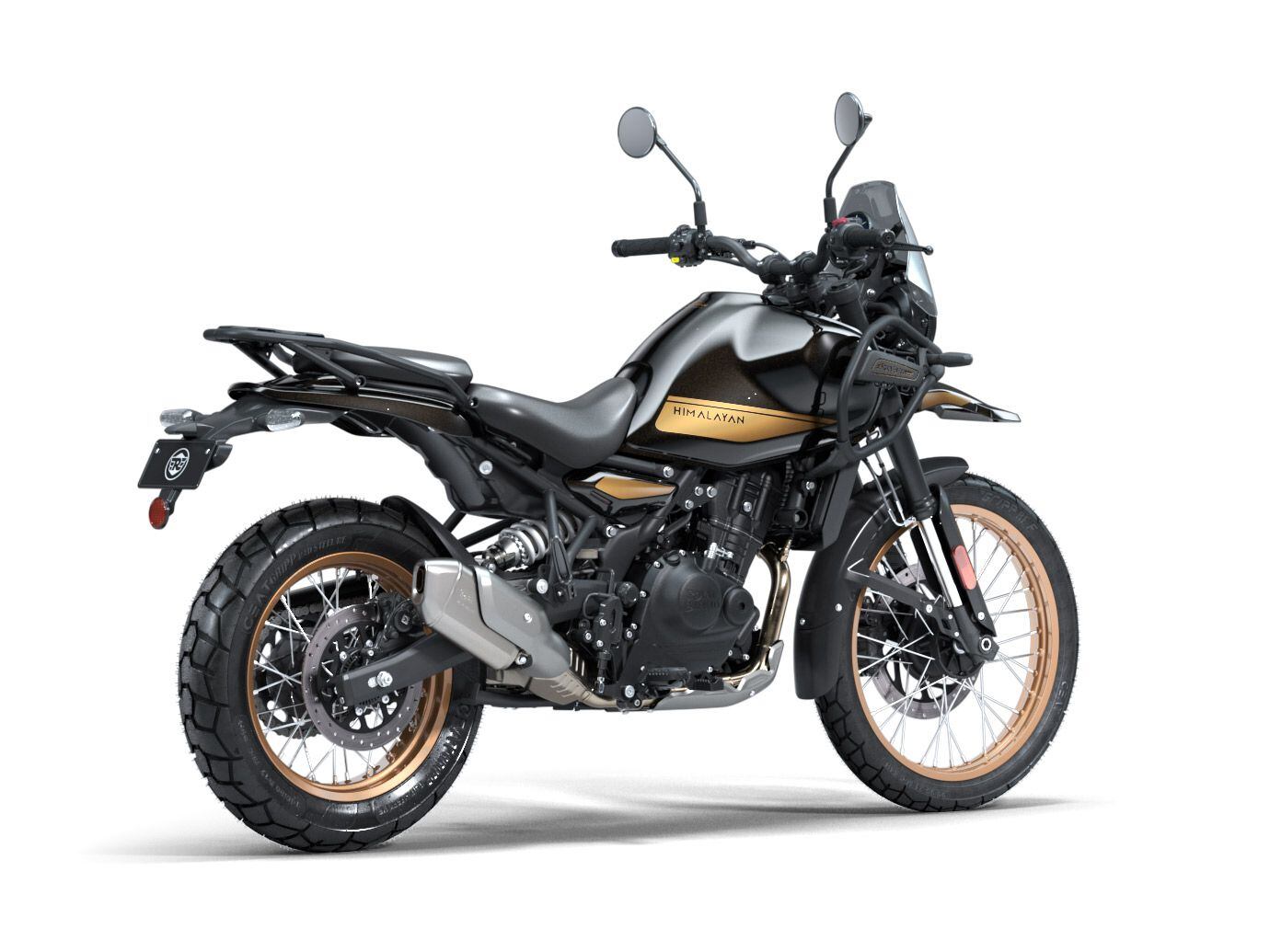
Everything new, nothing old. The 2024 Himalayan is a clean-sheet design and fully modern in every way. (Royal Himalayan/)It’s no surprise that the Himalayan is the first model to get this new engine, as this motorcycle has been a smashing success globally. And how could it not be? When first released in the US in late 2016, it cost an amazingly inexpensive $4,499, and has only crept up to $5,449 since. We can’t think of many motorcycles that look this cool and offer so much satisfaction at a price that is often half the price of even the least expensive machines in the ADV segment.
But the time was ripe for Royal Enfield to step up its game and create a fully modern motorcycle that has all the underpinnings of current design, while not abandoning the character and charm that has made its current lineup so attractive.
We recently had the opportunity to attend the global press launch for the Himalayan in Manali, India, on the doorstep of the Himalayas, and experience for ourselves this significant new model, riding in the exact territory that the bike was conceived and developed. We’d also got the opportunity to pick the brains of the entire development staff that was on hand to support the event. We set out to answer two questions: Is this the best value in adventure motorcycling? And is this actually a legitimate ADV-capable machine?
2024 Royal Enfield Himalayan Engine
There is no question that the brand-new Sherpa 450 engine in the Himalayan is the star of the show. This engine represents perhaps the single largest leap that the company has made in more than half a century. There are so many reasons to attempt such a radical jump forward, some surely tied to modern emissions standards, but others simply to better align the bike with its competition as the company continues to expand outside of the Indian market.
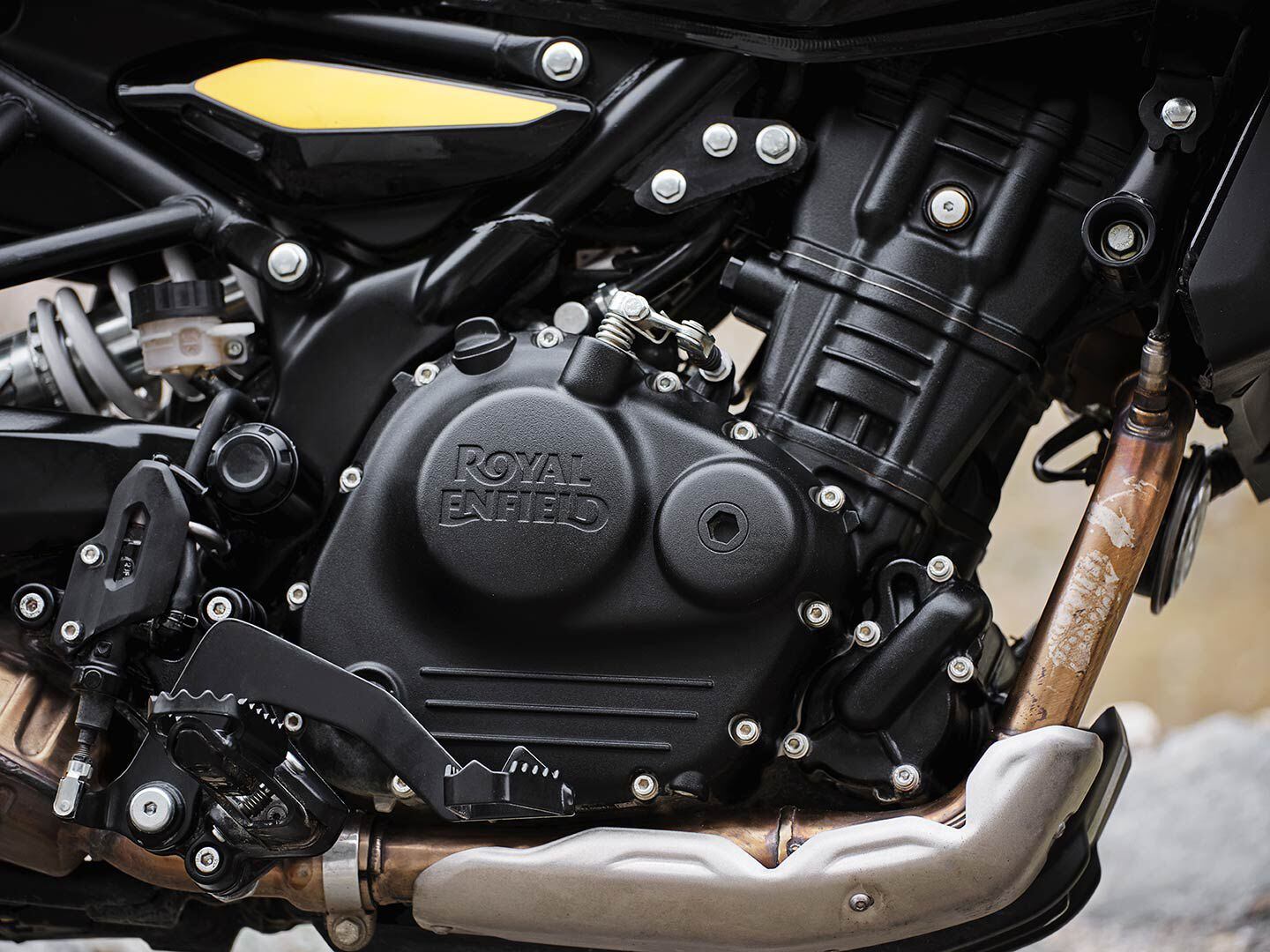
The brand-new 452cc single has four valves and a pair of overhead cams and, most importantly, liquid-cooling. (Royal Enfield/)The engine is now liquid-cooled—a first for RE—and allows it to achieve the highest possible performance for its intended application. Bore and stroke measure 84.0 x 81.5mm, giving the single 452cc of displacement. A forged piston slides in an aluminum cylinder that has a low-friction Nikasil coating, while the compression ratio is set at 11.5:1. A four-valve head features a pair of overhead cams, and efficient, steep downdraft intake tracts are used to feed the mixture to the combustion chamber. The electronic fuel-injection system utilizes a 42mm throttle body with ride-by-wire control. Lubrication is provided by a semi-dry sump design. Power is transferred through a wet, multiplate clutch with slip and assist functionality to a six-speed transmission and chain final drive.
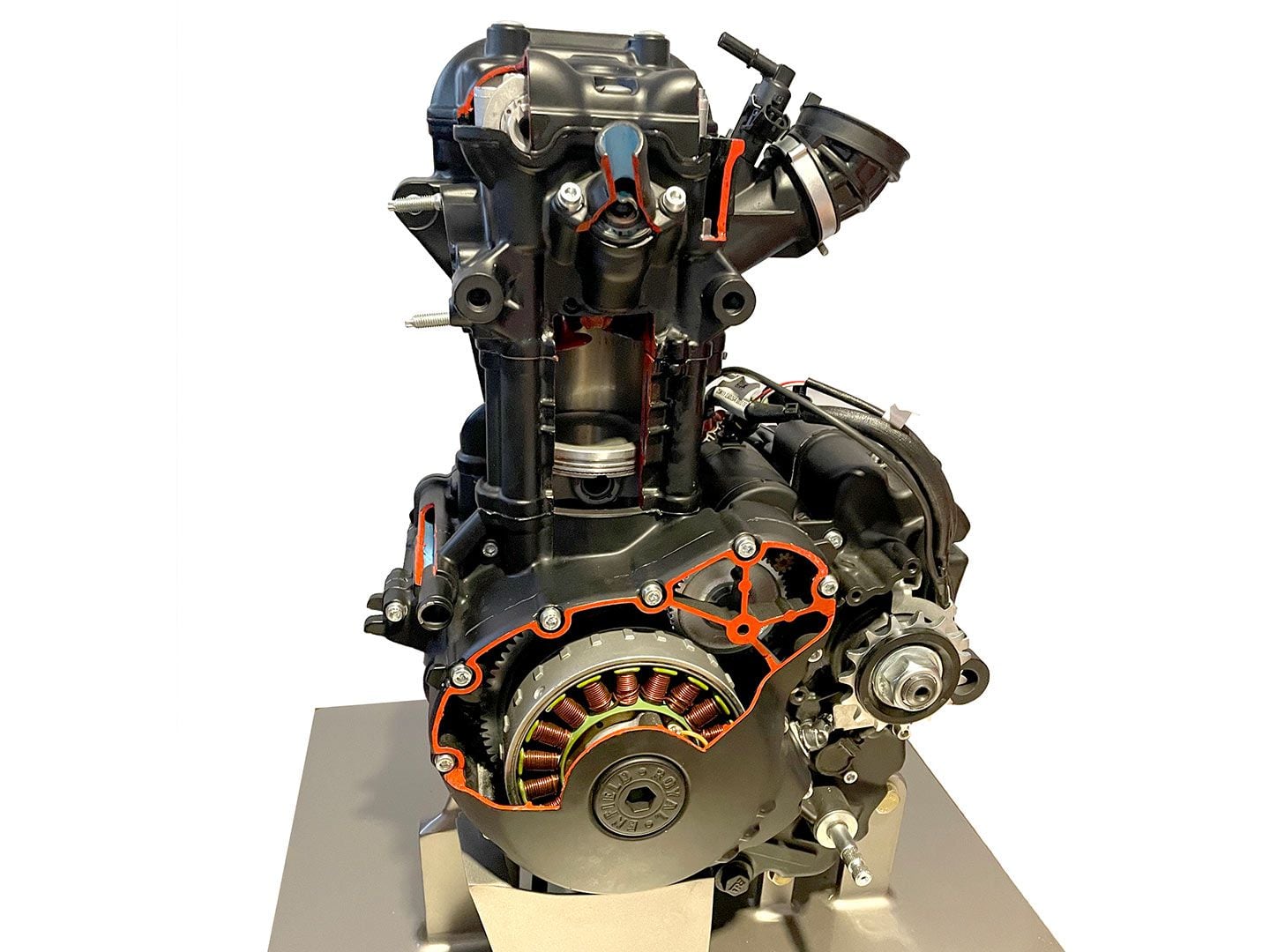
A peek inside the new Sherpa engine. (Blake Conner/)The goals were to improve the engine’s performance for highway riding and overtaking, which clearly meant that power had to be improved. Peak power has been increased by 65 percent compared to the 411cc air-cooled engine in the previous model, while torque is up 25 percent. Claimed power is now 39.6 hp at 8,000 rpm with 29.5 lb.-ft. of peak torque arriving at 5,500 rpm. Unlike a 450cc motocross engine that is designed for maximum top-end performance, the Sherpa was designed to deliver broad torque across the rev range for everyday usability on road and off. The new engine delivers a ton more power in a bike that is a full 10 pounds lighter, making for a a huge improvement in riding experience.
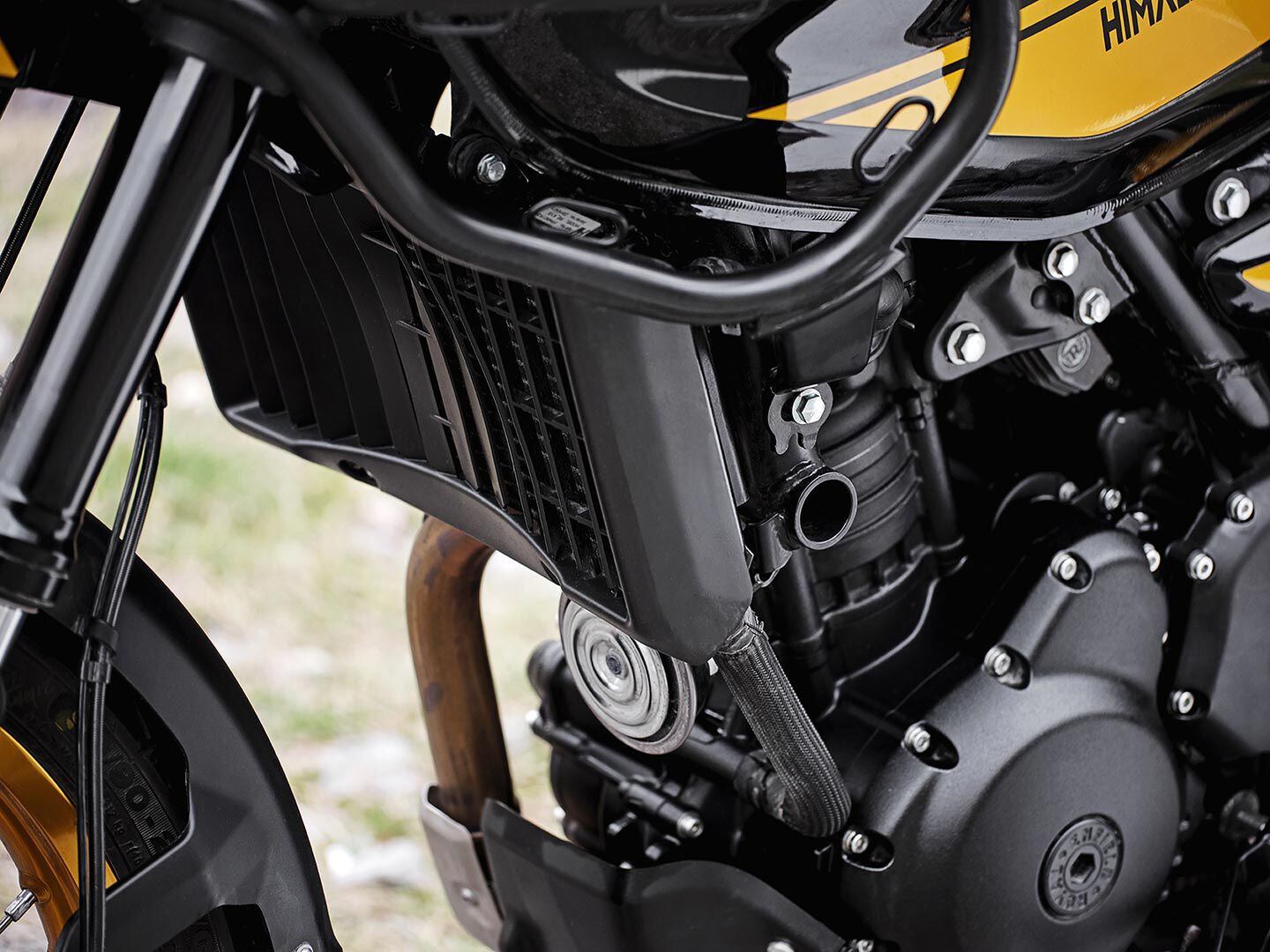
The Sherpa is Royal Enfield’s first-ever liquid-cooled engine, which allowed a 65 percent bump in horsepower compared to the 411cc air-cooled engine. (Royal Enfield/)2024 Royal Enfield Himalayan Chassis
Not only has the engine taken a big step forward, but the chassis is a real complement to the powertrain. This should come as no surprise considering that back in 2015 Royal Enfield acquired chassis specialists Harris Performance, a company that has designed and built racing machines that competed in the 500cc Grand Prix and World Superbike classes in days gone by, and was key in the development of RE’s sporty Continental GT.
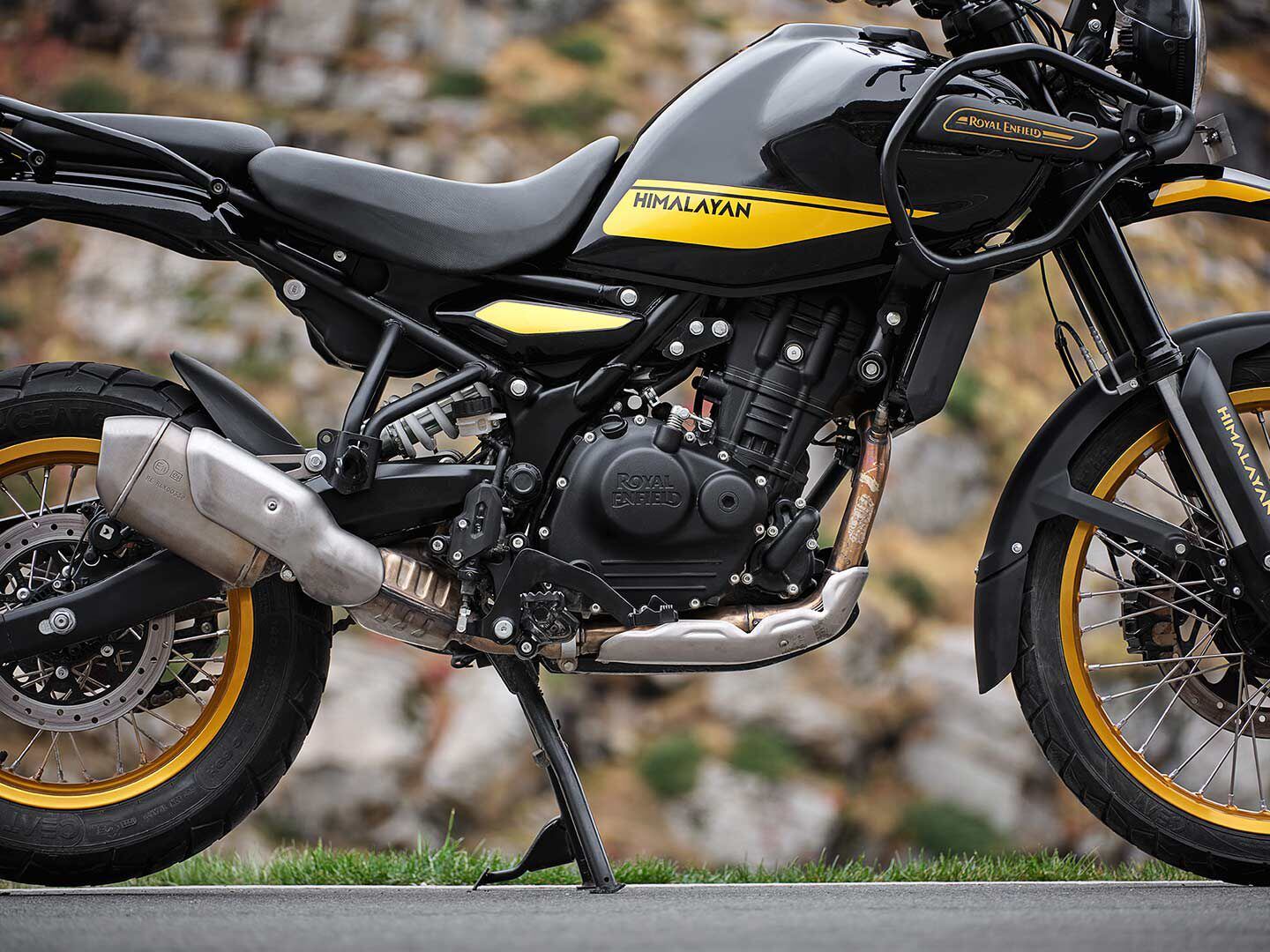
An all-new Harris Performance–designed steel frame is stiff and responsive. (Royal Enfield/)The new Himalayan uses a twin-spar, tubular-steel frame and aluminum swingarm. Up front is a 43mm inverted Showa SFF fork with 7.9 inches of travel, while the previous model used a 41mm right-side-up unit. In the back is a Showa monoshock that has preload adjustability and an identical 7.9 inches of travel, whereas the original Himlayan had about an inch less rear wheel travel at 7.1. Wheel sizes measure 21 inches front and 17 inches rear with 90/90-21 front and 140/80-17 rear tires. Our testbikes were using traditional tubed aluminum-spoked rims, but tubeless cross-spoke wheels will be available as an option. Other important dimensions are 9 inches of ground clearance (up almost 1/2 inch) and 59.4 inches for the wheelbase (a 1.4-inch increase), which is about an inch shorter than a Kawasaki KLR650 and about 2.5 inches longer than Honda’s CB500X. Front-end geometry numbers measure 26.5 degrees of rake with 5.0 inches of trail. Read: stable.
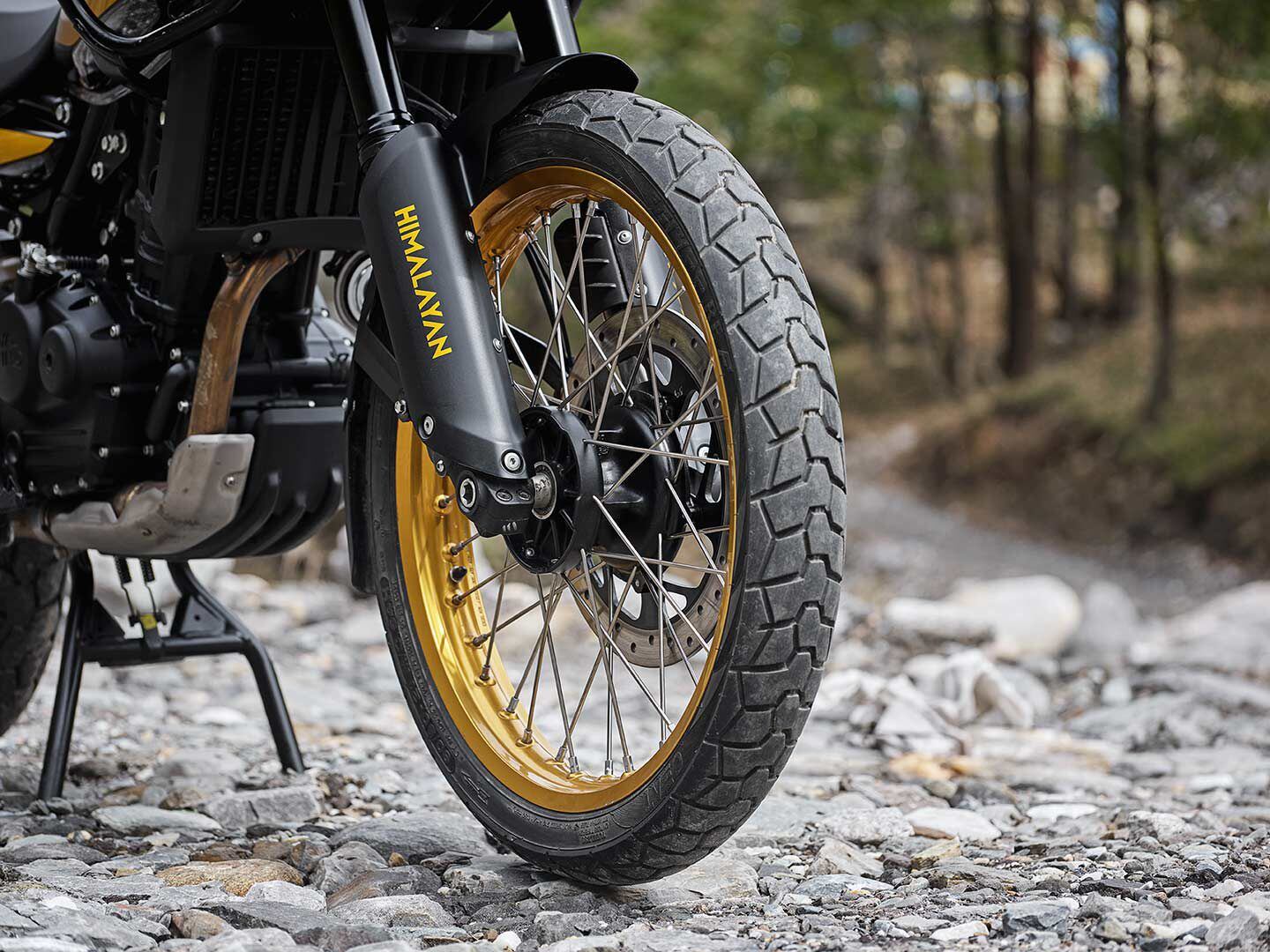
A Showa SFF fork with 7.9 inches of travel, a 21-inch front rim/tire combo, and ByBre brake caliper with 320mm rotor are front-end highlights. (Royal Enfield/)Braking is provided by ByBre (a lower-spec Indian-market brand owned by Brembo) with a 320mm disc in the front with a twin-piston traditionally mounted caliper with braided-steel lines. In the rear is a single-piston caliper and 270mm disc. The Himalayan comes with standard dual-channel ABS that can be turned off at the rear.
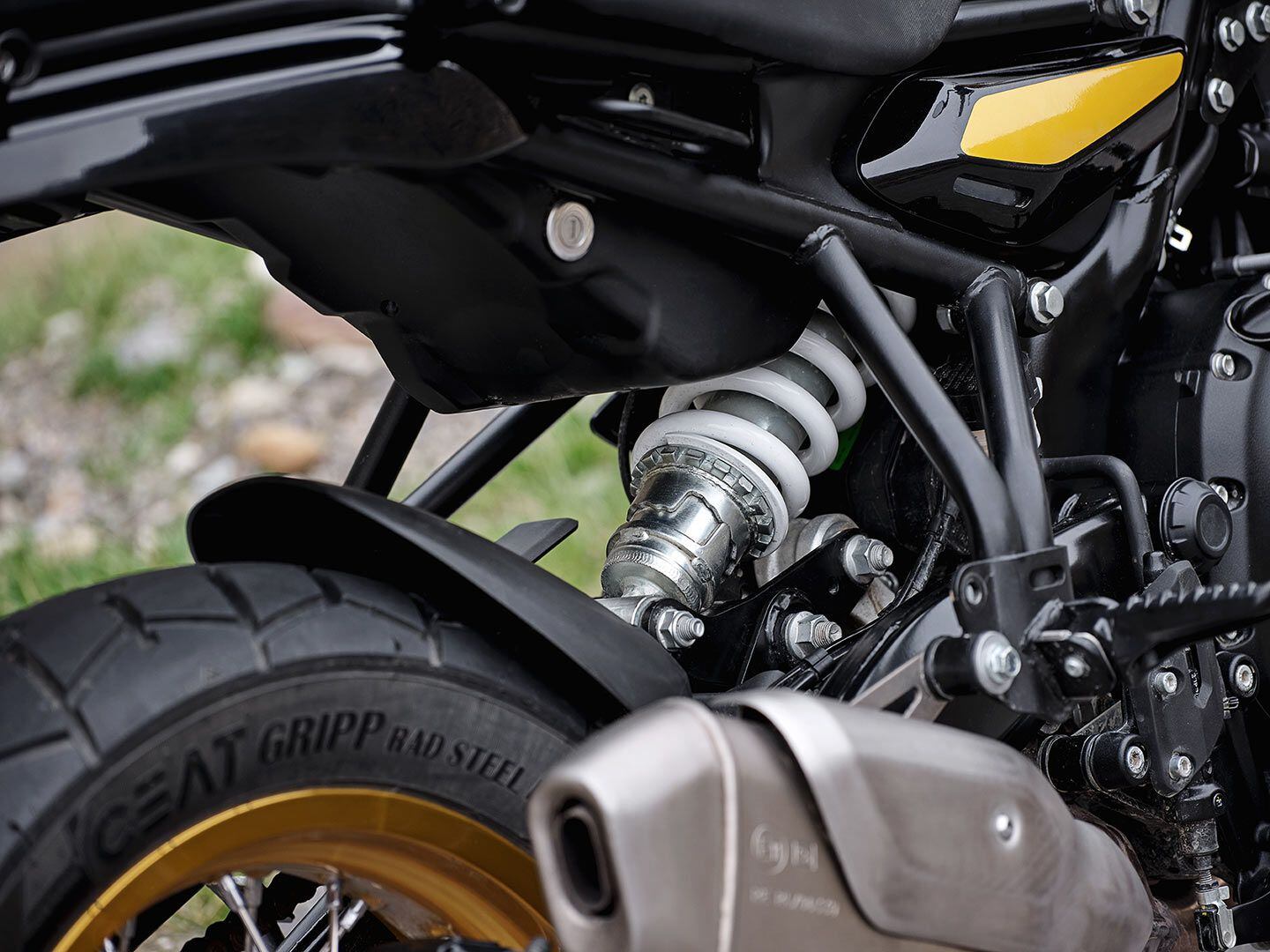
A linkage-equipped shock with provision for preload adjustability is also a Showa unit. (Royal Enfield/)Very important to prospective buyers of the Himalayan (and any adventure bike, really) is seat height. There are two available seats, including the standard and an optional low. Each seat has two easy-to-adjust height options, with the standard offering 32.5 and 33.3 inches, and low at 31.7 and 32.5 inches. The bike’s available payload capacity is 436 pounds, which should give you an idea of how much junk you can strap on the Himalayan.
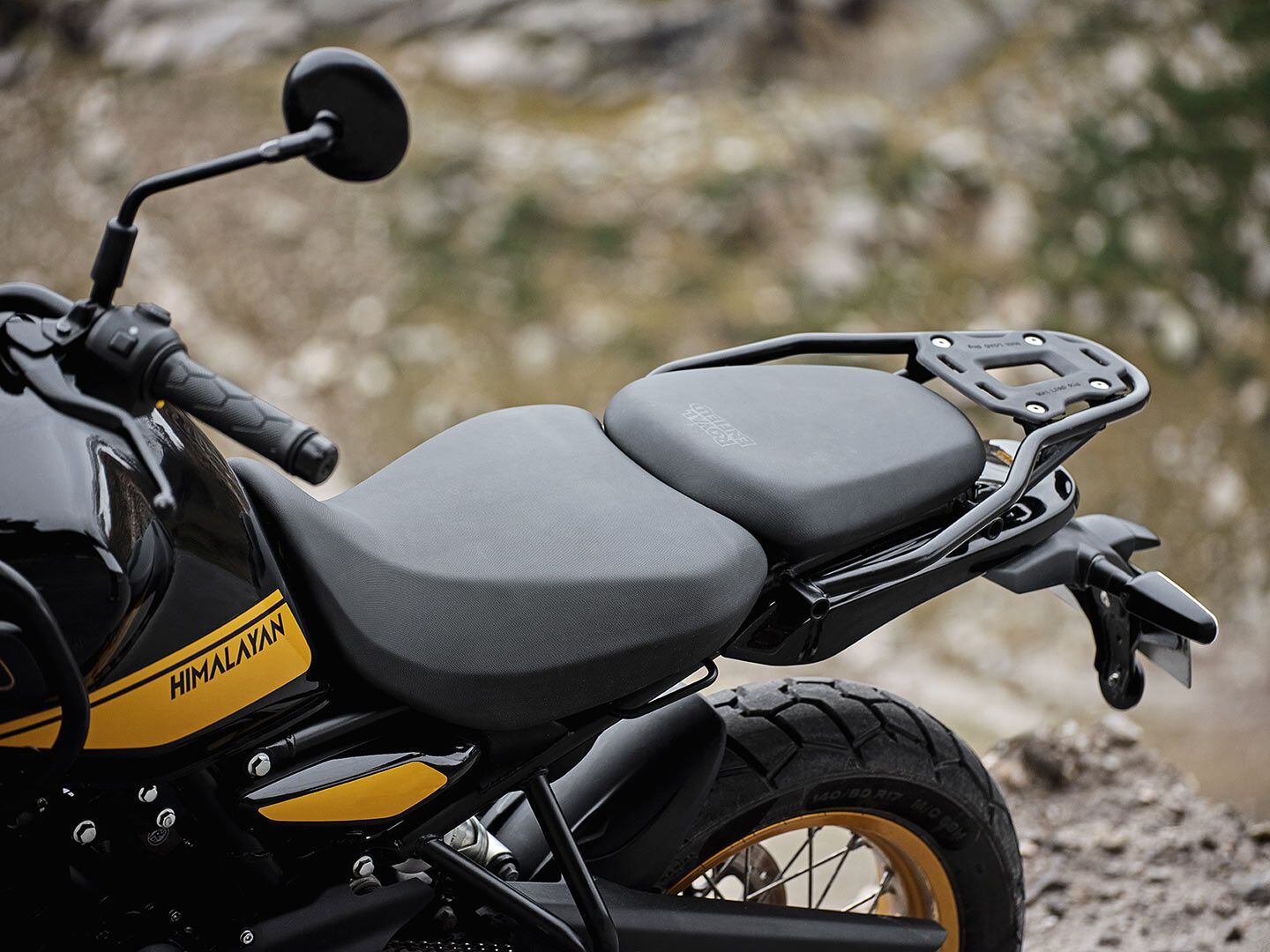
The standard seat can be adjusted to two heights, 32.5 and 33.3 inches, while a low option offers 31.7 and 32.5. The accessory Rally seat is a one-piece unit. (Royal Enfield/)2024 Royal Enfield Himalayan Electronics
Diving into the Himalayan’s electronics shows just how much more modern this bike is than its predecessor. The bike now comes with ride-by-wire throttle control, which has opened the door to multiple ride modes including four possible combinations: Performance/ABS On, Performance/ABS Off, Eco/ABS On, and Eco/ABS Off. The modes alter the power delivery not the output. The modes can’t be switched on the fly, so you’ll have to choose your option when you start the bike, and then come to a stop to change it if you are transitioning from asphalt to dirt and want the rear ABS disabled.

The Tripper TFT display offers smartphone connectivity, navigation powered by a Google Maps engine, and joystick-controlled dash navigation for modes and settings. (Royal Enfield/)The portal to access the modes and all of the bike’s other electronic gizmos is through the brand-new Tripper dash, which is a round 4-inch, full-color TFT display that offers smartphone connectivity, media controls, and full-map navigation with a Google-based navigation engine. The dash gives the rider the option for multiple views, allowing the most important info to be displayed as desired. The navigation also allows you to choose between a full-map view or simple directional arrows. Additionally, there is a USB-C charging point, and full LED lighting, including turn indicators—the rear of which serve double duty as the brake lights.
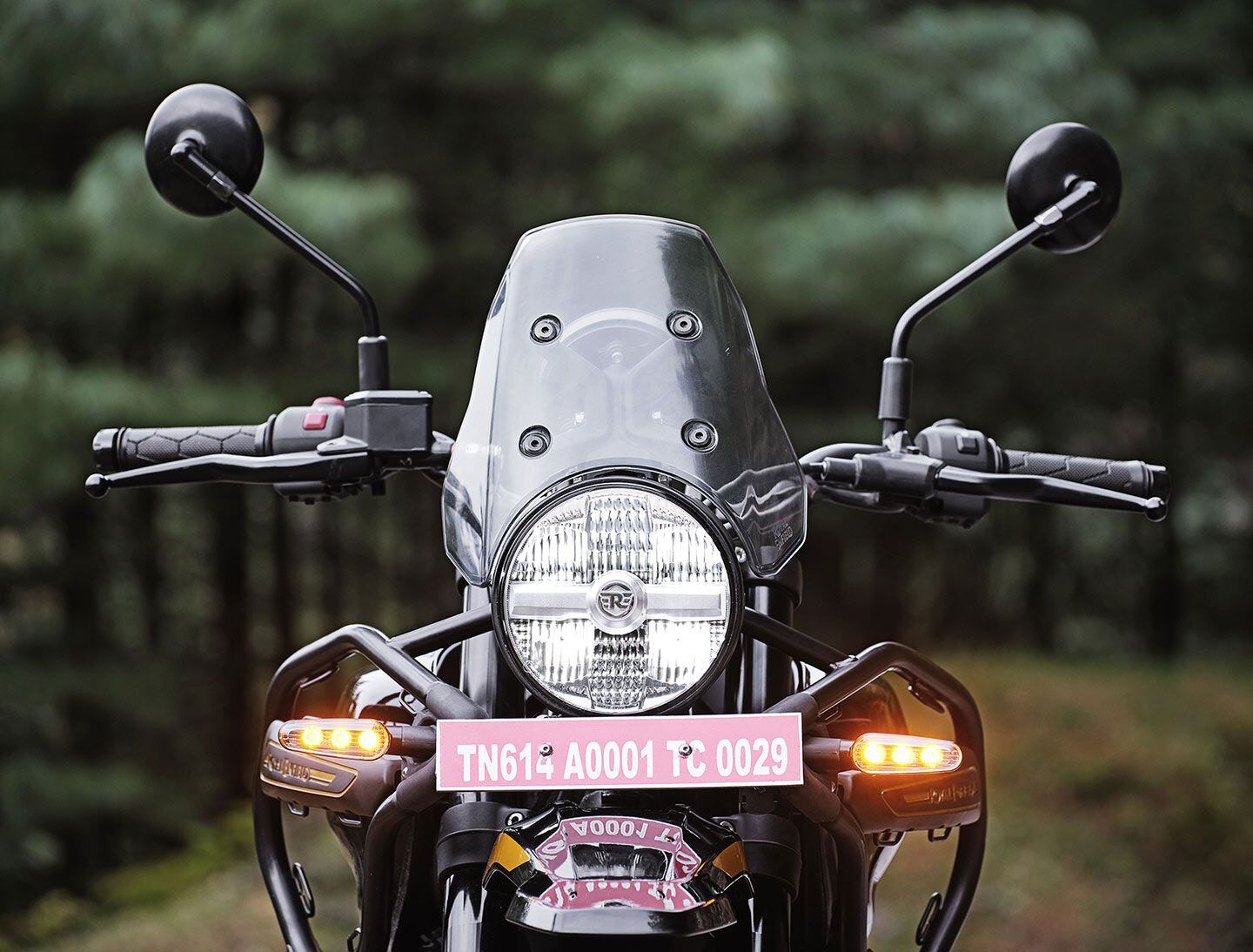
Full LED lighting includes the headlight, turn indicators, and rear brake lights that are integrated with the rear turn signals. (Royal Enfield/)Riding Impression
India is about as far away from Colorado as anywhere in the world, but the Himalayas in the Himachal Pradesh region of northern India are so similar to this author’s home state that it felt very familiar. OK, take away the complete and total on-road anarchy of tuk-tuks, trucks, cows, horses, goats, dogs, and what seems like zero rules of the road, and it was sort of familiar. Prior to our pair of days riding the new Himalayan, we were able to get acquainted with the bike through a series of workshops at an amazing site that RE set up adjacent to our hotel in Manali. To say that it went all out to introduce the Himalayan to journalists is an understatement. We can confidently state that if a person worked on any aspect of the bike, they were on site to answer our questions. Engineers, designers, accessory specialists, test riders, you name it they were there.
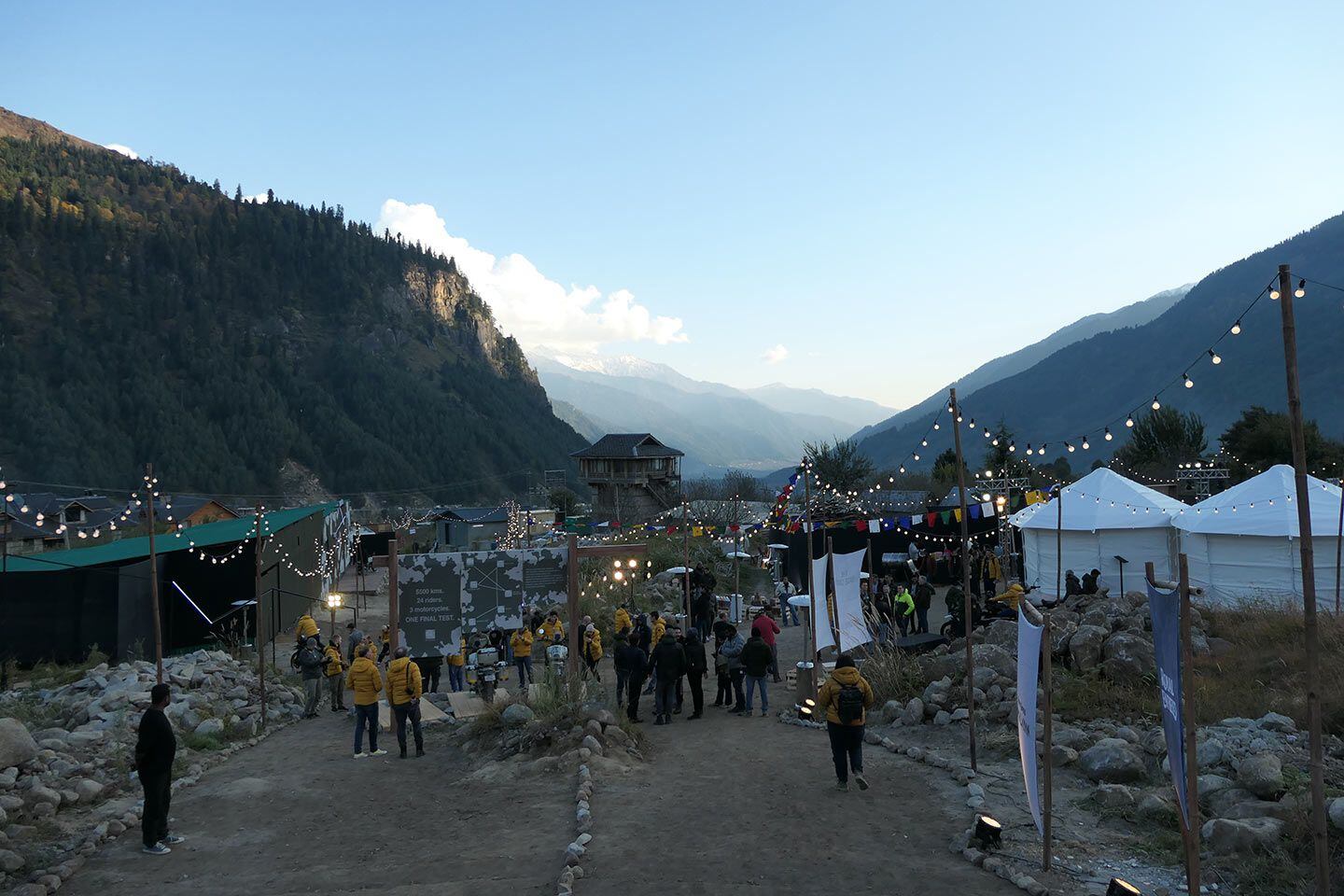
Royal Enfield built a small village related to all things Himalayan at our hotel in Manali, India. (Blake Conner/)One thing that is abundantly clear is that Royal Enfield is passionate about its motorcycles. And it is particularly proud of this new model. And it should be; this bike represents the biggest leap forward the company has ever made. Everything about this bike is new, with nothing shared with anything it’s done in the past. For some, who can’t get over the nostalgia of Royal Enfield’s air-cooled models, this may come as a shock, but RE has done a great job of stepping into the future without abandoning the charm of its past.
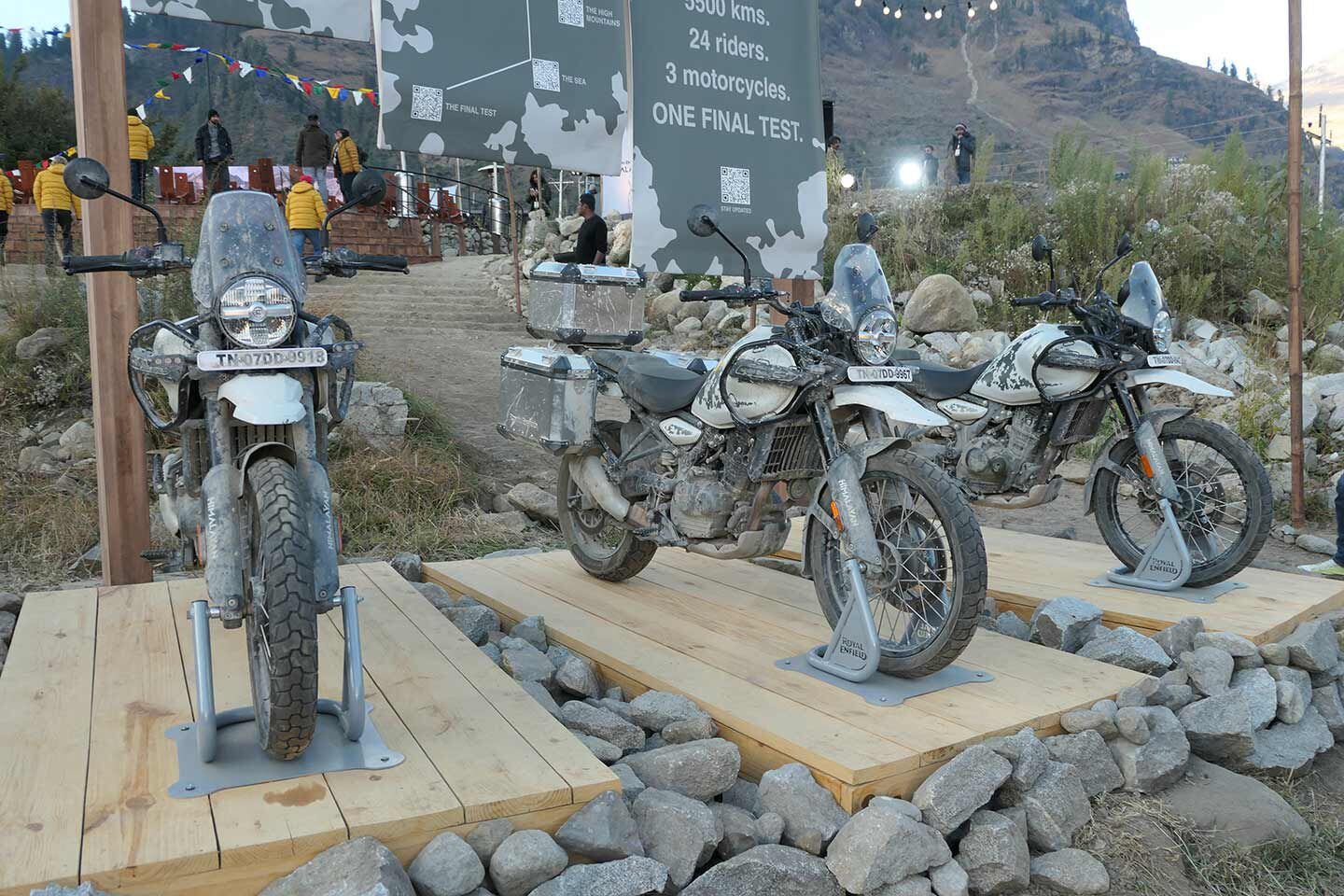
The three Himalayans that were the final test mules proved to Royal Enfield that the project was ready to be greenlighted. (Blake Conner/)Like so many owners of the current-gen Himalayan will tell you, the bike isn’t about the high-performance and high-tech bling that comes with high price tags. This bike is more about functionality. And while the new 2024 model is actually full of modern technology and refinement, the purpose remains the same, to offer simplicity and function in the same way Kawasaki’s KLR650 or Honda’s XR650L have for decades. Although the Himalayan trumps those bikes in many ways.
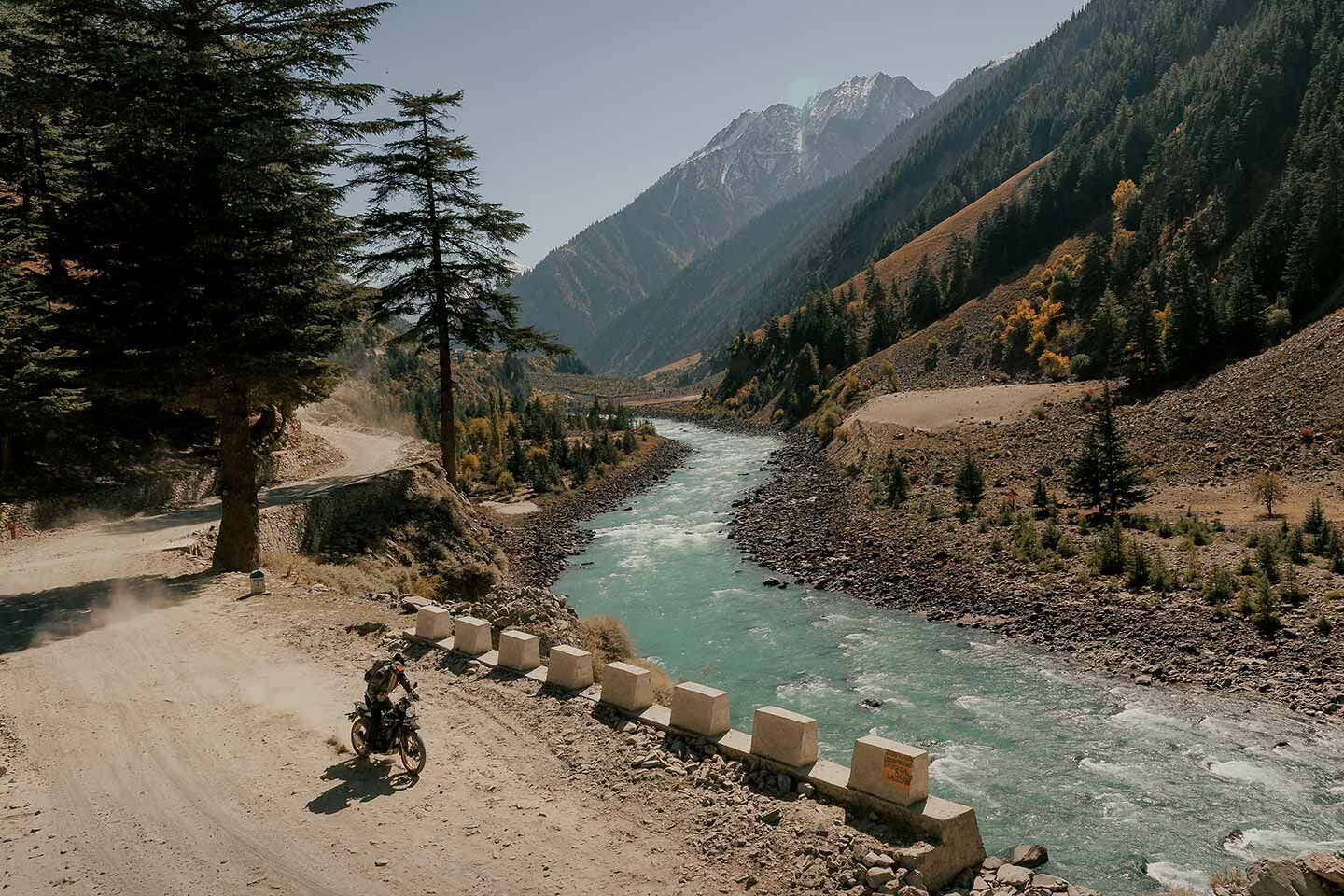
This is where this bike was born. Not a bad place to be conceived. (Royal Enfield/)Saddled up for a 150-mile day of mixed riding on both asphalt and dirt, the Himalayan feels fully modern as the 452cc engine sparks to life without a nanosecond of hesitation. Even on our 40ish-degree morning, the bike instantly settles into a smooth idle. In the meantime, while it warms up, we tether our smartphone to the latest-generation Tripper dash and load the day’s route into the system via Bluetooth. According to American Matt Cardenas, product strategy head of advanced concepts, who is in charge of the Tripper system, RE is the first motorcycle company to use Google Maps as its native navigation engine. Chalk that up as another leap for the company.
Our route would start off with a really fun climb up a series switchbacks toward the 9-kilometer-long Atal Tunnel, which is the highest single-tube tunnel in the world at 10,171 feet of elevation. Right away—at least at elevations exceeding 10,000 feet—you learn that the engine needs revs and some dancing on the shift lever if a spirited pace is desired. Of course that isn’t necessarily the Himalayan’s jam, but it is something it doesn’t mind at all. The engine is flexible and offers a broad spread of power, and we have to cut it some slack during our day that topped out at more than 11,000 feet of horsepower-draining elevation.
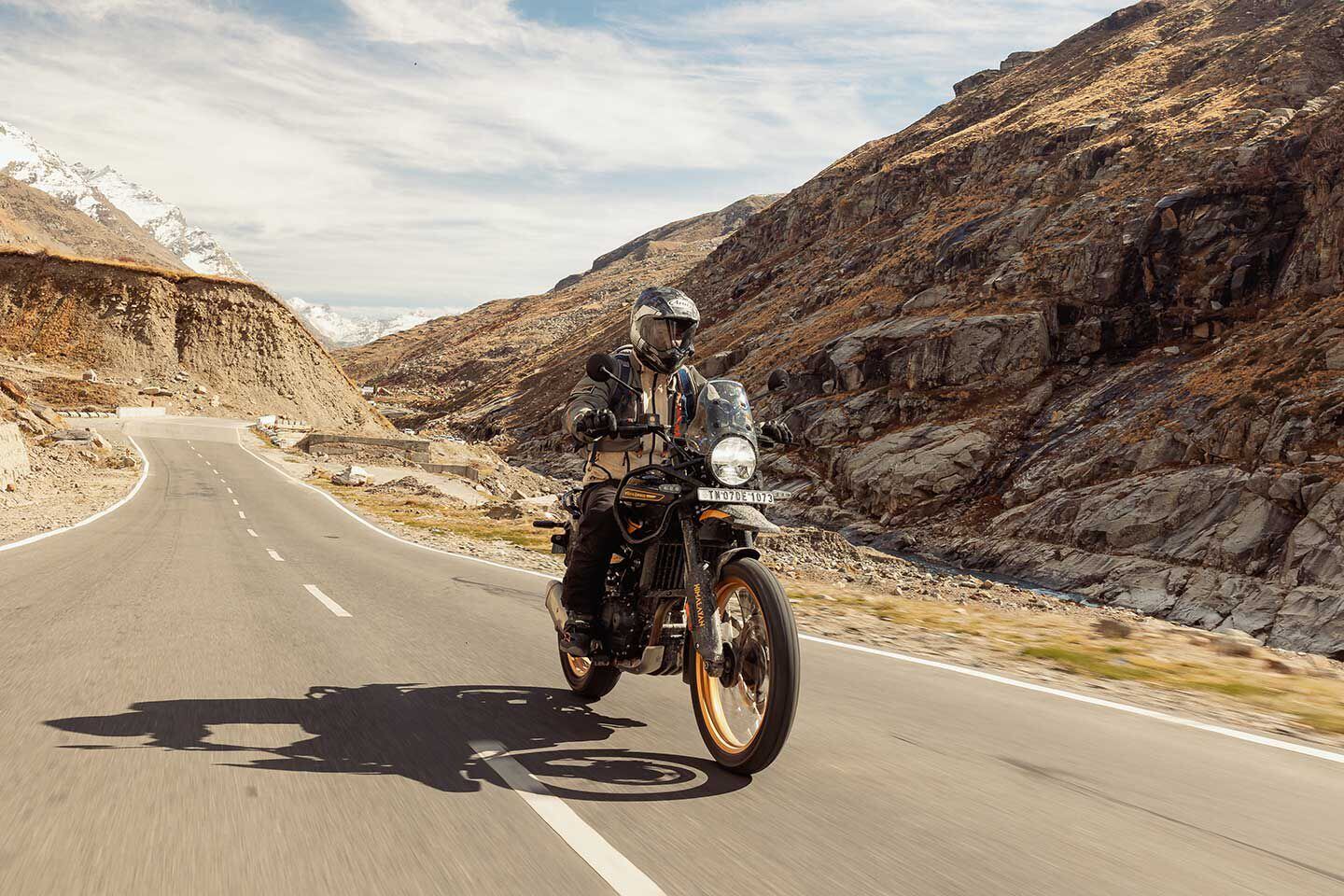
As a streetbike the Himalayan will never keep up with the open-class crowd, but that wasn’t the intention. (Royal Enfield/)While attacking Passo del Stelvio–like hairpins requires shifting all the way down to first at times, and working the gearbox like a tap dancer clacks the stage, the gearbox performs very well. The slip and assist cable-actuated clutch provides light pull, smooth engagement, and accurate gear changes, while the transmission ratios offer a range capable of everything from slow off-road crawling to highway cruising speeds. Later in the morning when the roads opened up into big sweepers along the Chenab River, the Himalayan proved happy clipping along between second and fourth gears, with fifth and sixth rarely engaged.
A really pleasant surprise on the asphalt is the competence of the chassis. The frame is rigid and the front-end geometry provides good stability, while still allowing the bike to easily be flicked into those hairpins without a ton of effort at the bars. We weren’t sure how the Indian-made Ceat tires would perform on the road, but they provided good grip, with the 90/90-21 front surely giving the bike some agility flicking from side to side.
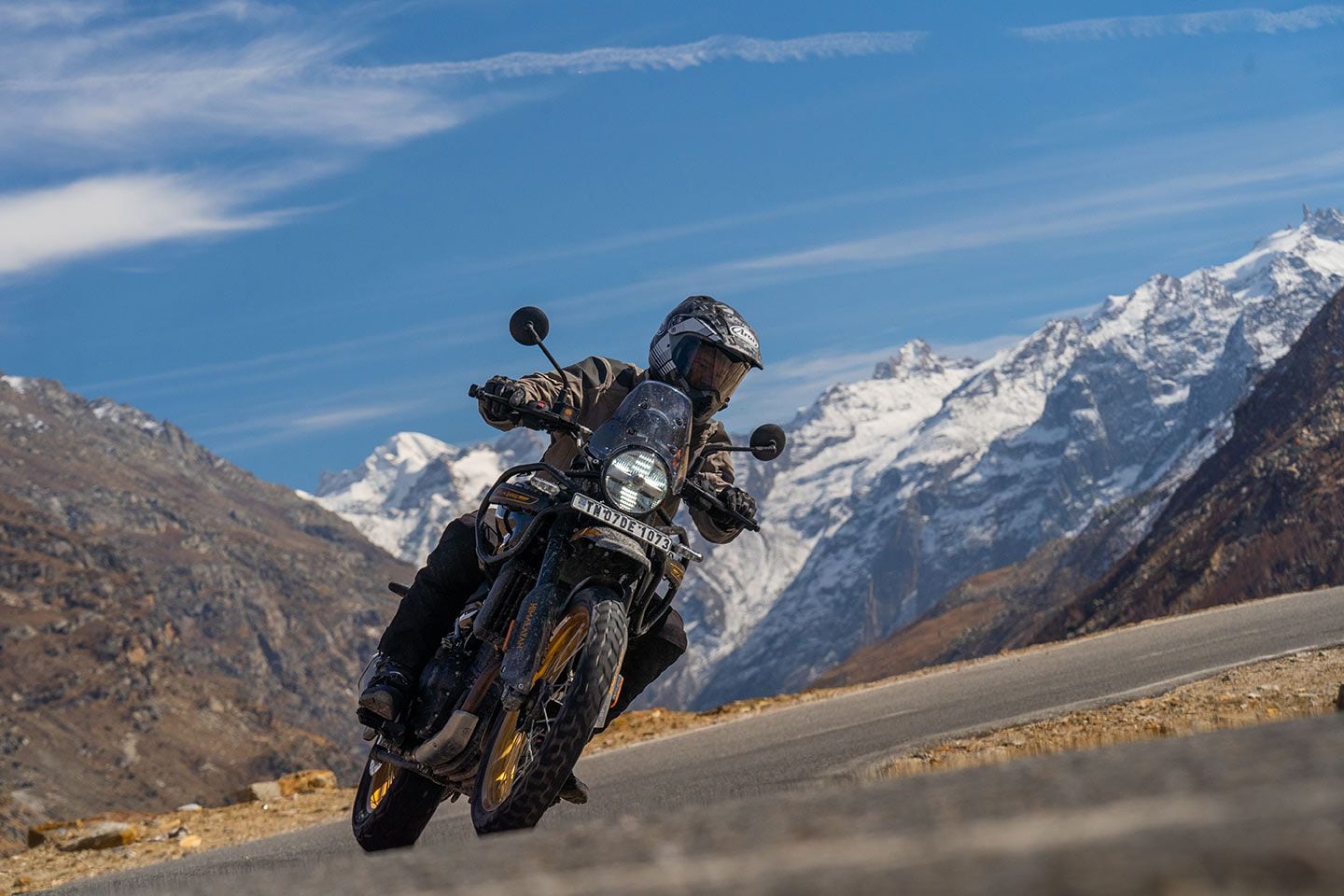
The Himalayan’s on-road performance exceeded expectation with a really good chassis. (Royal Enfield/)Another really welcome improvement is the Showa suspension. The fork in particular is very well damped considering it has zero provisions for adjustment. The shock doesn’t live up to the same level of the fork, but is still good considering the price point this bike will likely carry. The shock does have preload adjustability, which we took advantage of, dialing in a bit more to keep the bike from wallowing on the rear suspension. If we had one thing we would ask for from the chassis, it would be some rebound damping to keep the bike from pogoing after a harsh G-out or sharp bump.
On road, the bike allows a lot more lean angle than we anticipated, and even when riding like a fool at a pace not necessarily in the Himalayan’s design parameters, it rarely drags the footpegs or runs out of cornering clearance.
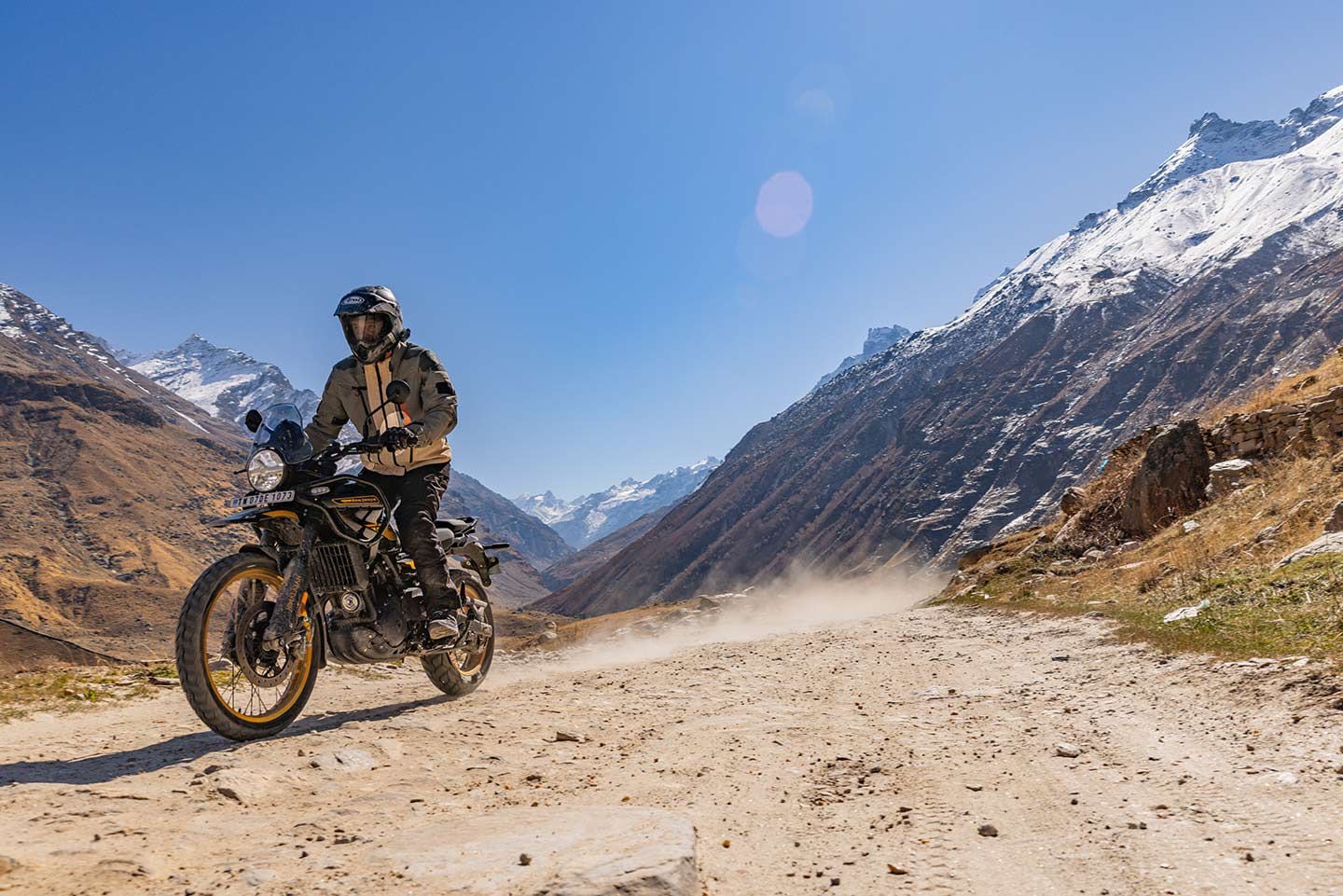
The Himalayan is most happy on gravel roads and off the highway. (Royal Enfield/)But let’s be honest here, a 452cc, single-powered adventure bike is a bit out of its element on the highway. That’s not to say this new version isn’t capable, but this is not its happy place. It will cruise at highway speeds without issue thanks to the new six-speed gearbox, but if you need to make a quick pass, a shift or two are usually in order to do it with authority. And don’t expect KTM 1290–like acceleration. Gravel roads, double-track, and rougher terrain are where it feels at home. Luckily, over the course of the two days riding we got to spend quite a bit of time in that environment. For those skeptical about a sub-500cc ADV machine in harsh environments, it’s here that the Himalayan raises its hand and says “I’ve got this.”
Despite the very-much not knobby tires fitted to the Himalayan, once the route turns to gravel embedded with rocks, crossed with washouts, and water crossings, the chassis proves to provide really good stability and traction. There are a few things going on here: The Showa fork really helps provide a lot of confidence in the front end, while the bike carries its weight very well, never feeling top-heavy, especially when standing on the pegs. The front never wants to knife in and tuck—it is supported and predictable. Even when sand is encountered, the front end is easy to manage, so we can only imagine how nice it will track once you throw on some good knobbies.
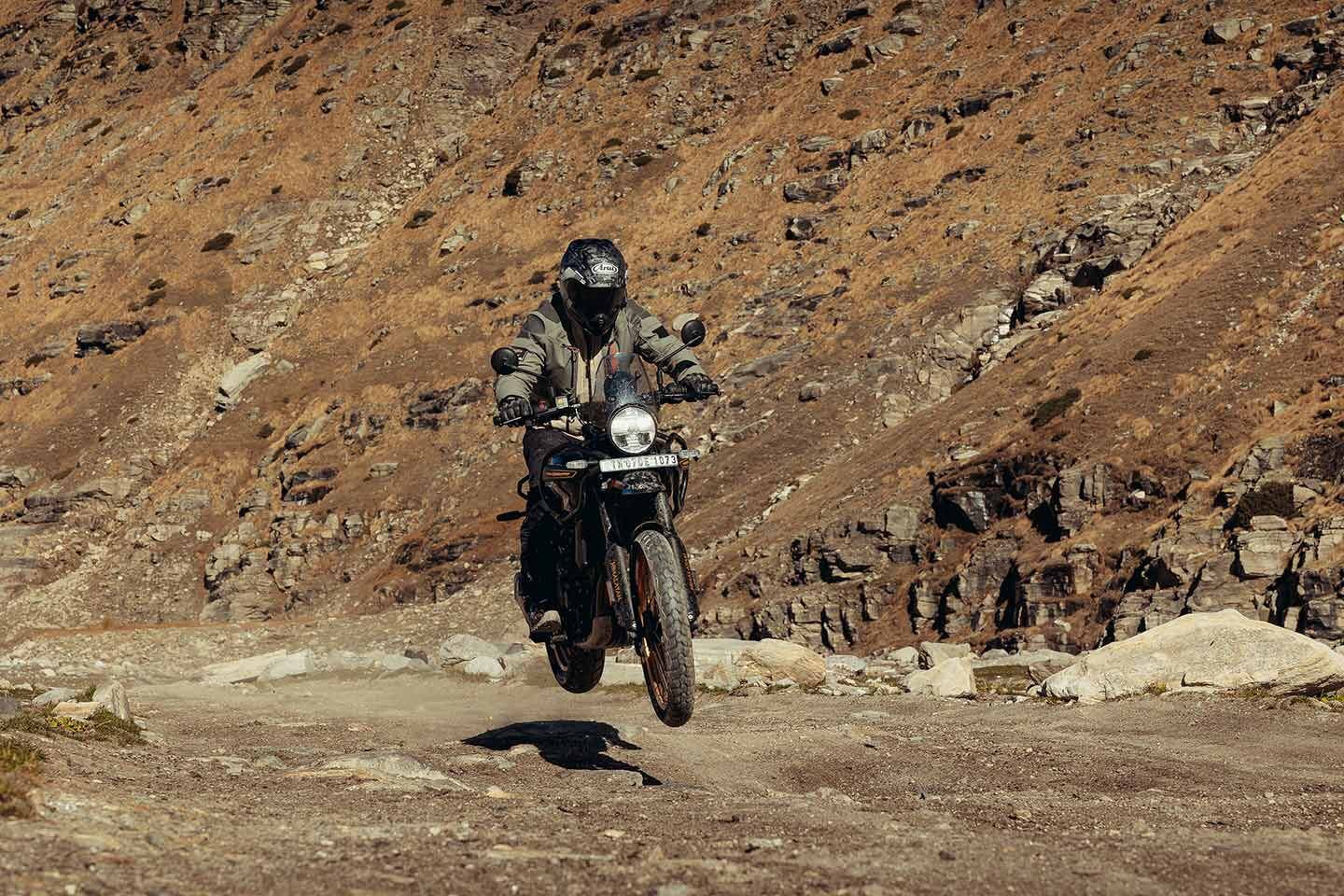
Make no mistake, the new Himalayan is ADV worthy, with a really competent chassis and good suspension. (Royal Enfield/)The suspension that performs quite well on road, continues to excel off of it too. The only complaint is once again a lack of rebound damping from the shock. We were able to get the rear end into an acceptable zone in terms of how it reacted compressing, but harsh hits to the rear definitely make the rear end kick back when pushing the pace off-road. The reality here is that you can’t expect this bike to handle nasty off-road sections like a pure enduro machine; it performs beyond expectation and is quite predictable and capable.
Whereas the engine feels taxed on the highway, in the dirt it’s another story. Considering the elevation we were testing at, we left the bike’s mode in the Performance setting. Traction is easy to manage despite no TC to intervene, with the tractable nature of the engine and excellent throttle response from the ride-by-wire throttle making it very predictable.
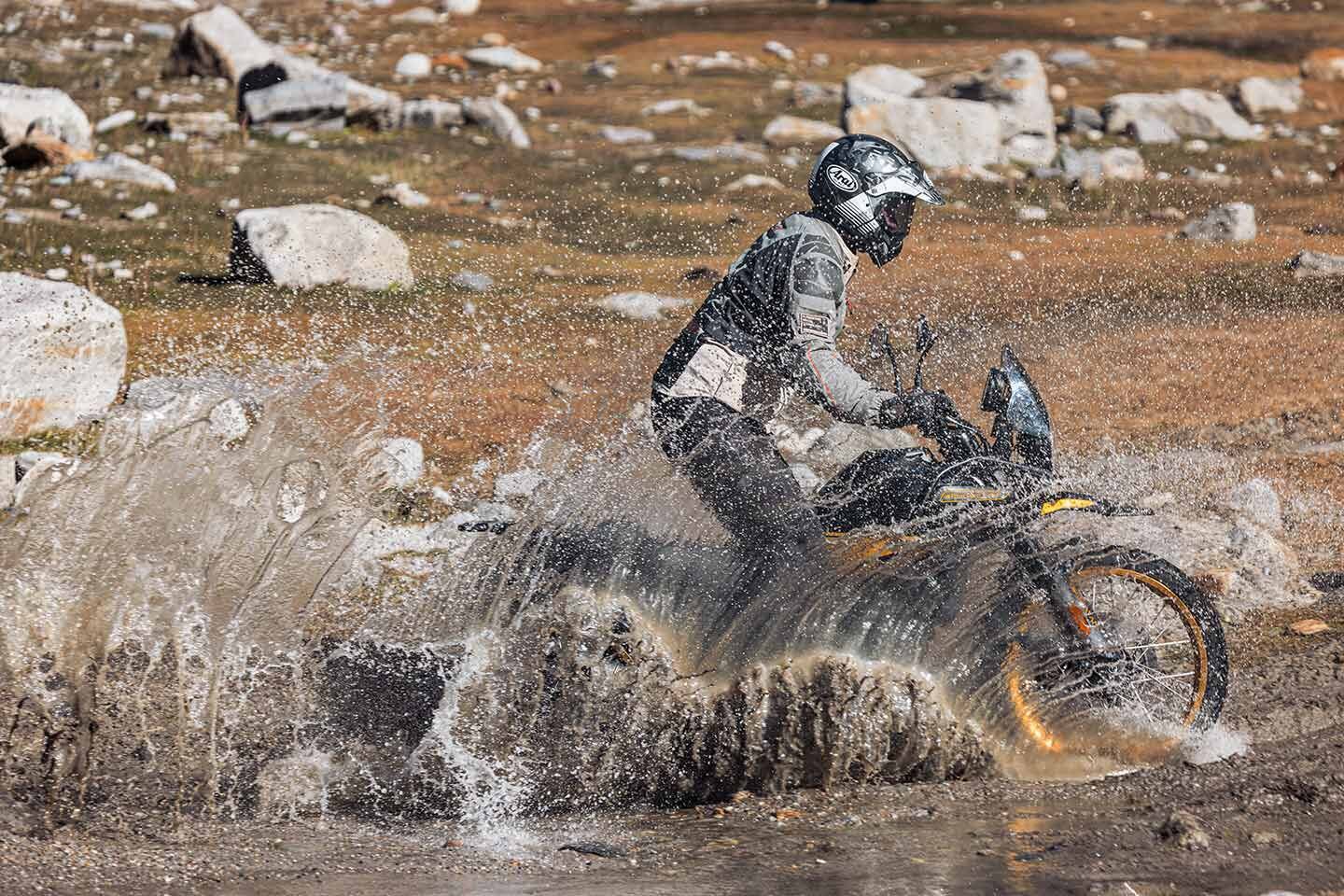
We rode over and around rocks, through ruts, streams, sand, and washouts, and nothing seemed to bother the Himalayan. (Royal Enfield/)Although the brakes ultimately do the job, they are nothing to write home about. Off highway, the combination makes much more sense, never feeling grabby at the front, but the rear (with the ABS turned off) locks quite easily. On the road, it took quite a bit of effort at the lever to get the performance we wanted; we wish they had a bit more bite and power.
A very important aspect of the Himalayan is how easily it caters to a wide variety of rider heights and inseams. The standard seat (32.5 to 33.3 inches), allows me at 5-foot-11 and a 30-inch inseam, firm footing at stops, but more importantly when making U-turns or when stopped on uneven surfaces off-road. The bike is very narrow between the legs which further helps control when chugging along at slow speeds off-road or when you have to dab. The seating position itself is very comfortable with a gentle bend at the knee and an easy reach to the handlebar. When standing off-road, the layout allows an easy reach down to the bar. We’d ditch the rubber footpeg inserts right away if this was our bike as they instantly become slick as ice when wet, but otherwise we really like the bike’s ergos.
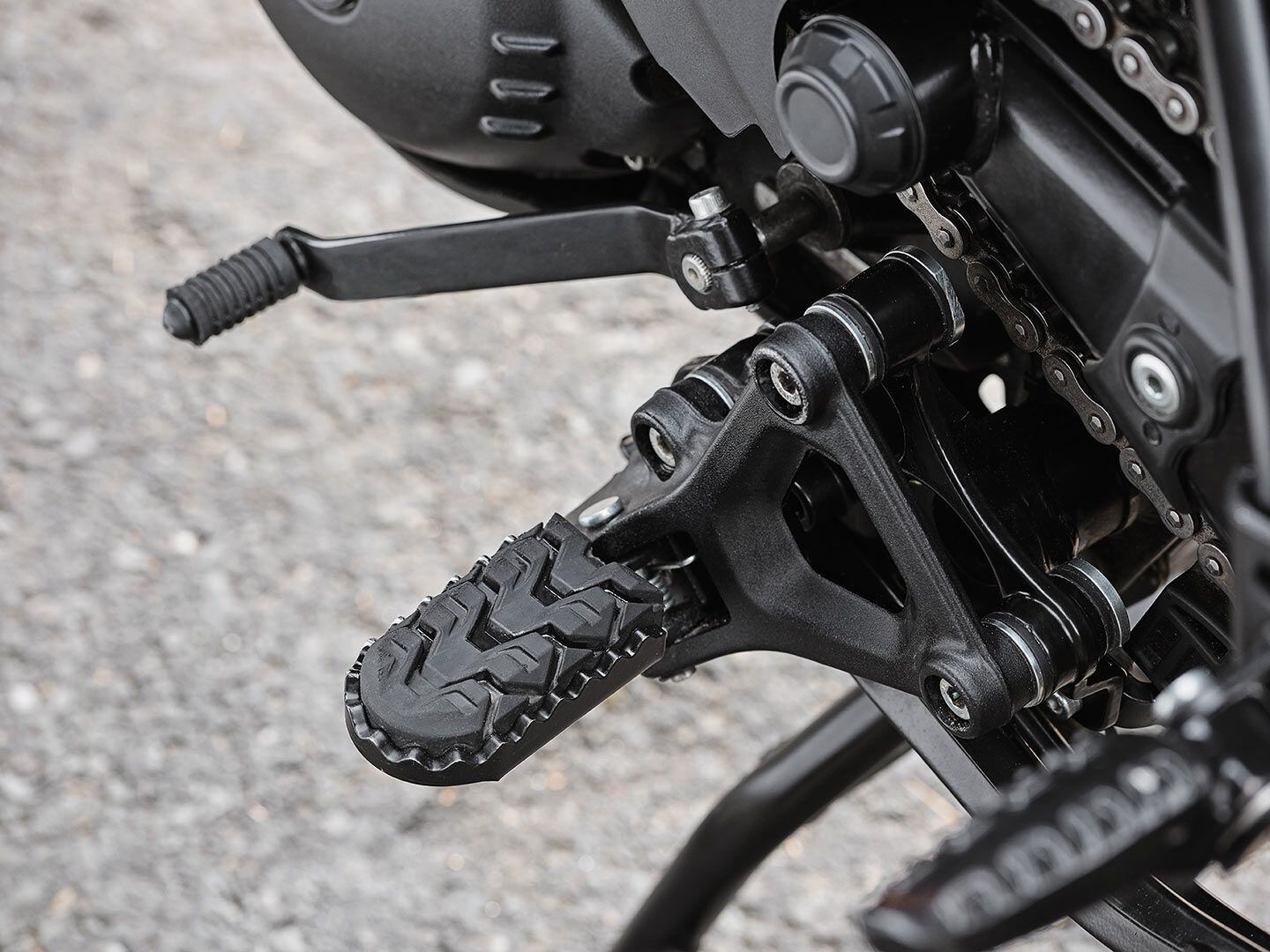
We’d remove the rubber footpeg inserts right away, as they turn to ice when wet. (Royal Enfield/)Conclusion
There are a few ways to wrap up what this bike is all about and who it’s for. And unfortunately as we go to press there is one big unanswered question that greatly influences those points: price. Of course Royal Enfield has a long reputation for offering its models at ridiculously low prices, but will that remain the case with this all-new, fully modern machine? For now, we’re going to assume that RE is going to target low cost in a manner consistent with its past.
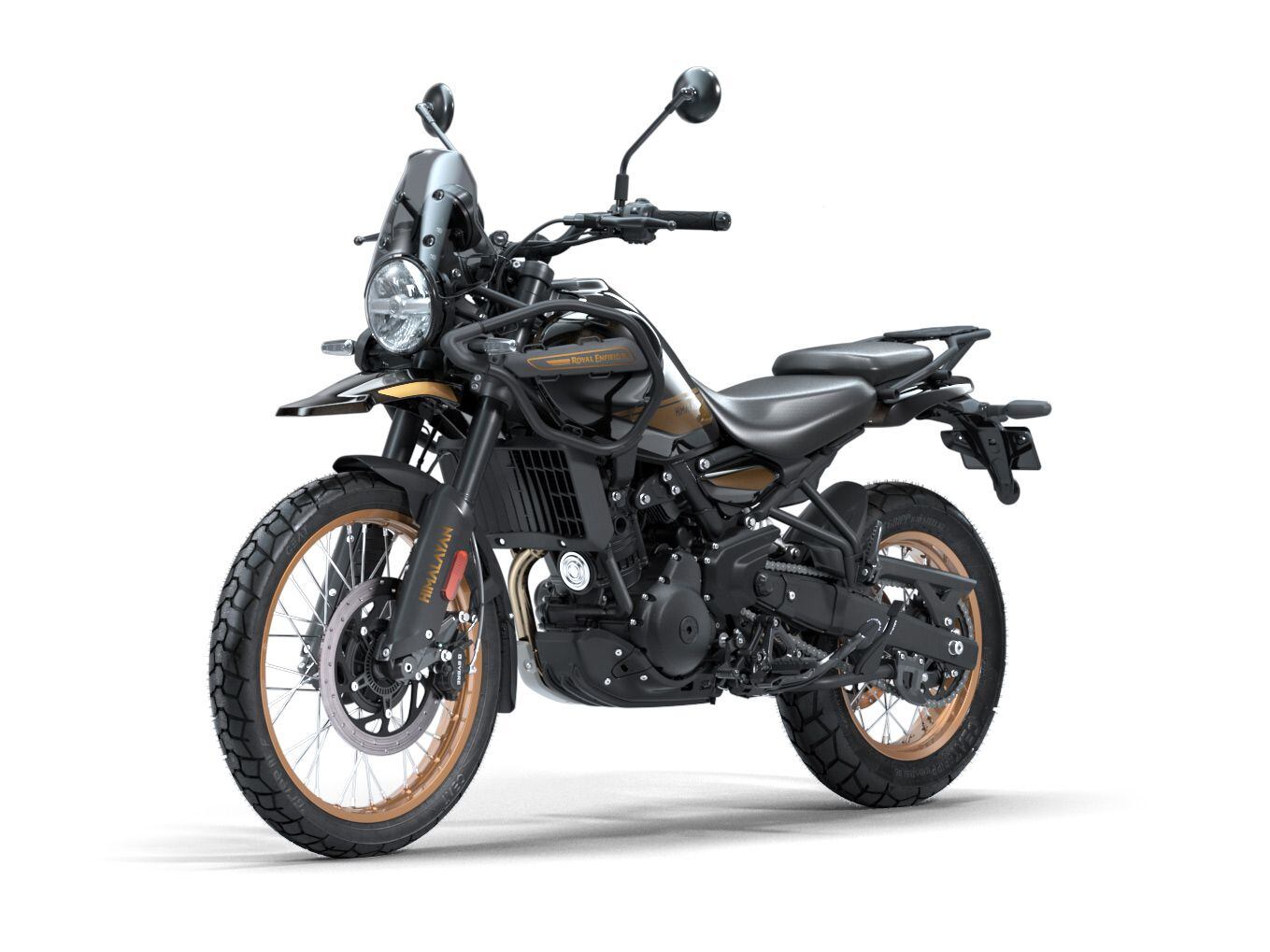
We love the Hanle Black and gold version. (Royal Enfield/)When looking at it through those glasses, the Himalayan could be one of the best values in all of adventure motorcycling. What you get is a fully modern engine, with up-to-date features and performance, a predictable and good performing chassis with high-quality suspension, navigation that is class leading, and a list of accessories that should make the bike appeal to a wide range of buyers. And the bike welcomes riders of all shapes, sizes, and skill levels.
Make no mistake, this is a legitimate ADV bike. It may be scaled down and relatively simple compared to the bulk of the market’s offerings, but that in and of itself gives it a foot up in certain situations, especially off-road, where low weight and good agility count a lot more than raw power.
Royal Enfield’s Himalayan is truly dual-purpose; though not stunning in either of the dirt or street categories, it proves pleasingly competent just about everywhere. So while we give the new Himalayan a big thumbs-up, price will ultimately dictate if this bike is truly the best value in adventure motorcycling.
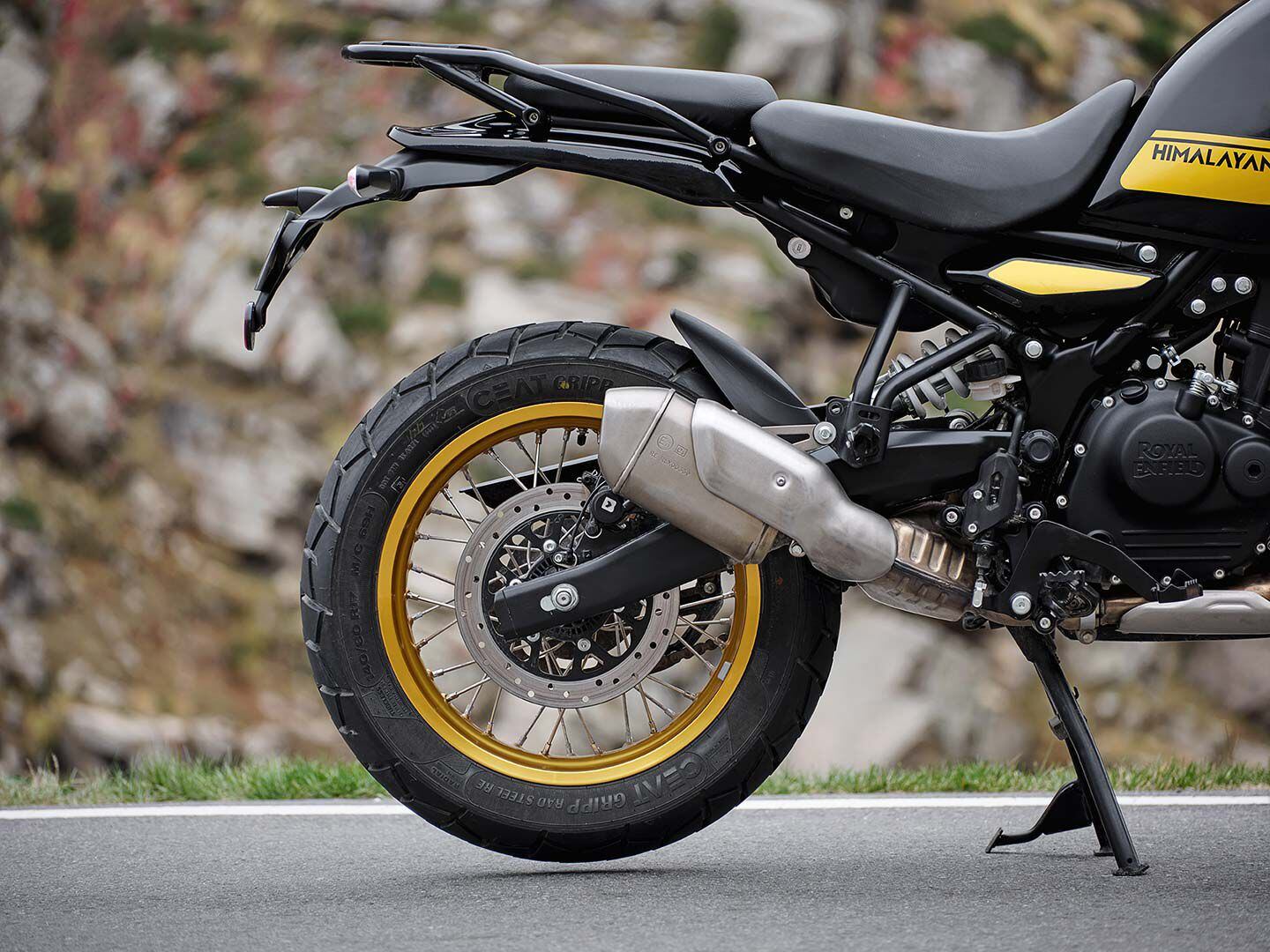
A slim, catalyst-equipped exhaust tucks in nicely and is never in the way. (Royal Enfield/)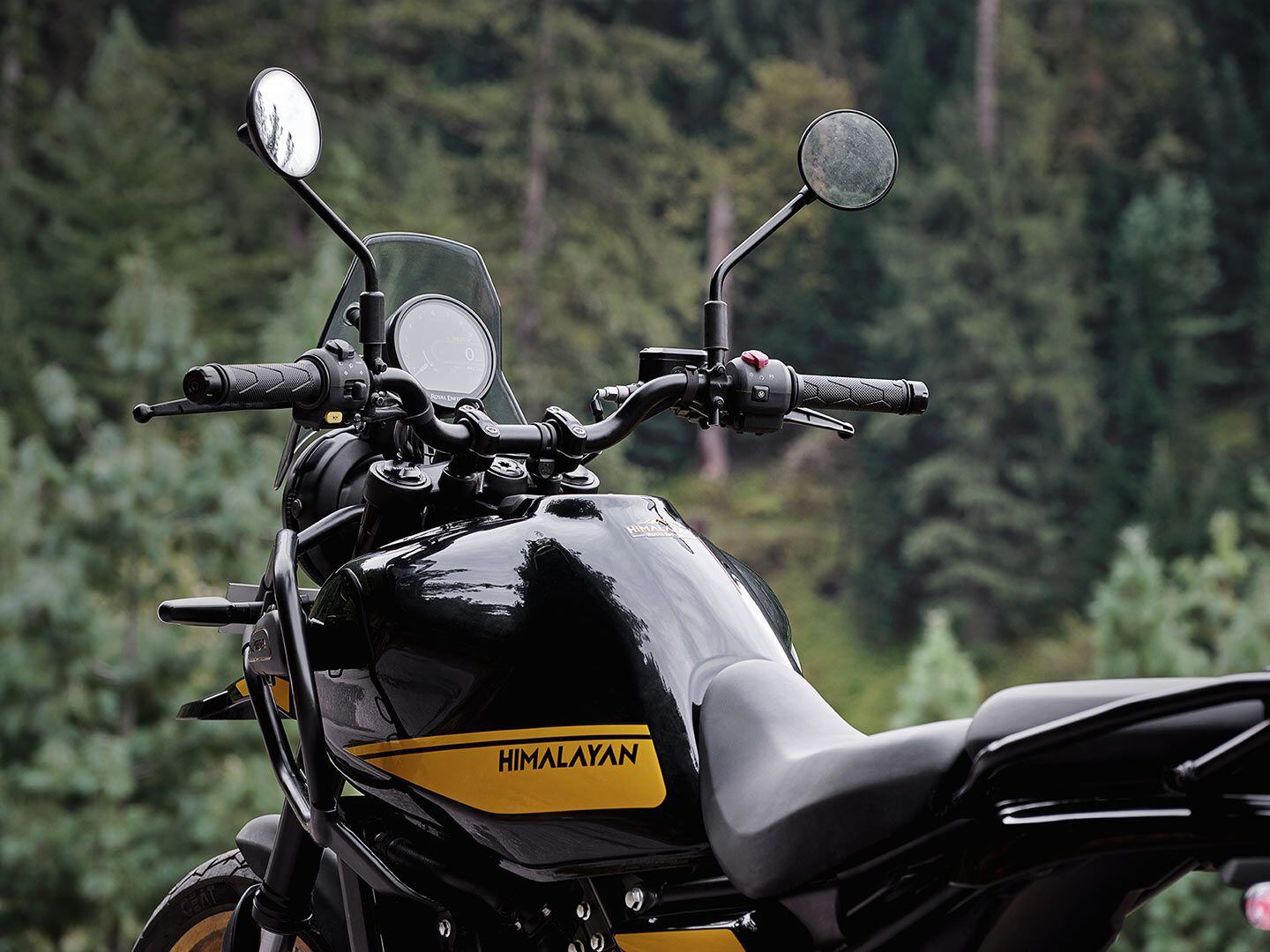
A view of the cockpit. (Royal Enfield/)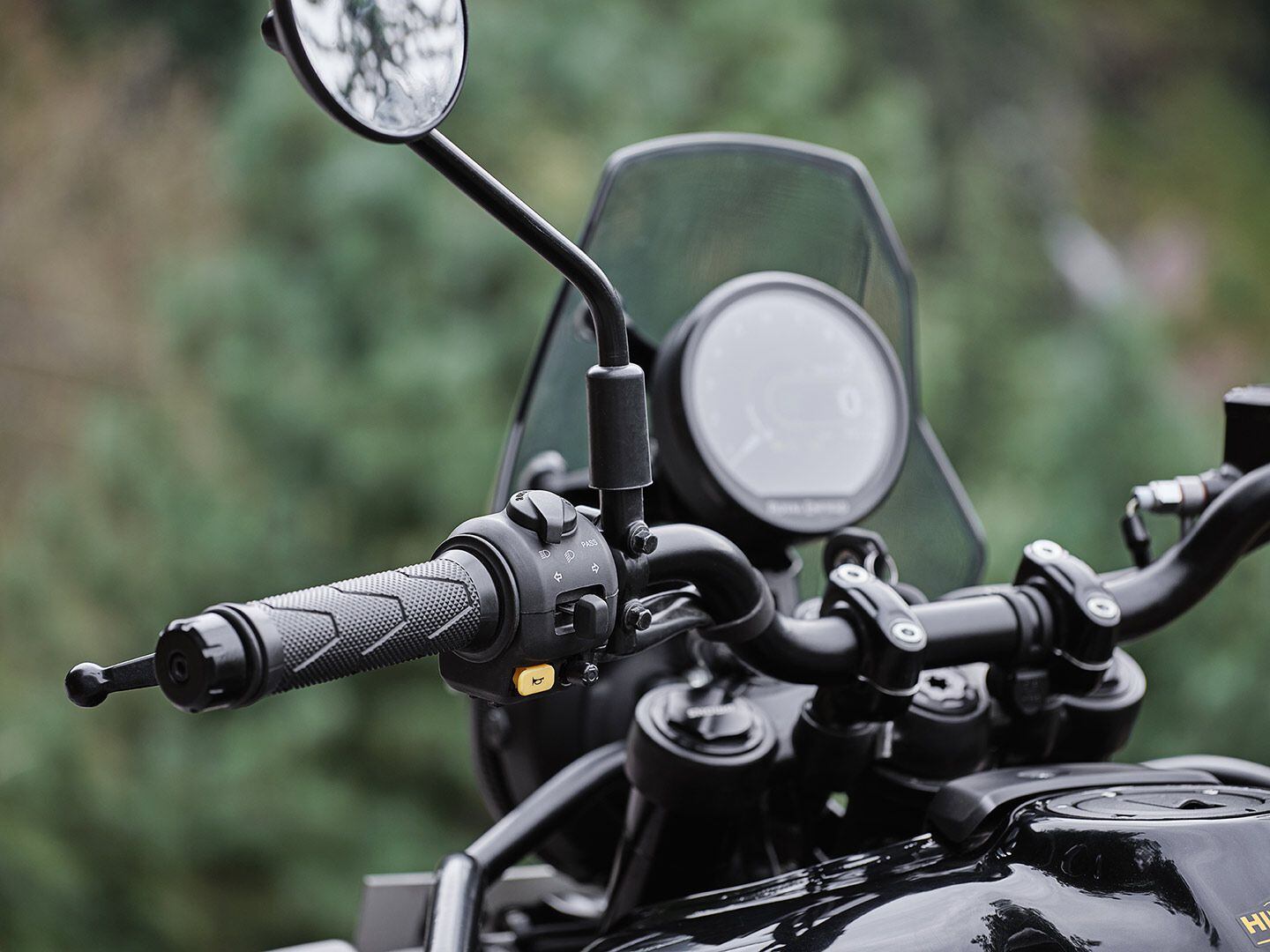
The left handlebar pod provides a joystick to navigate the navigation-equipped Tripper dash. (Royal Enfield/)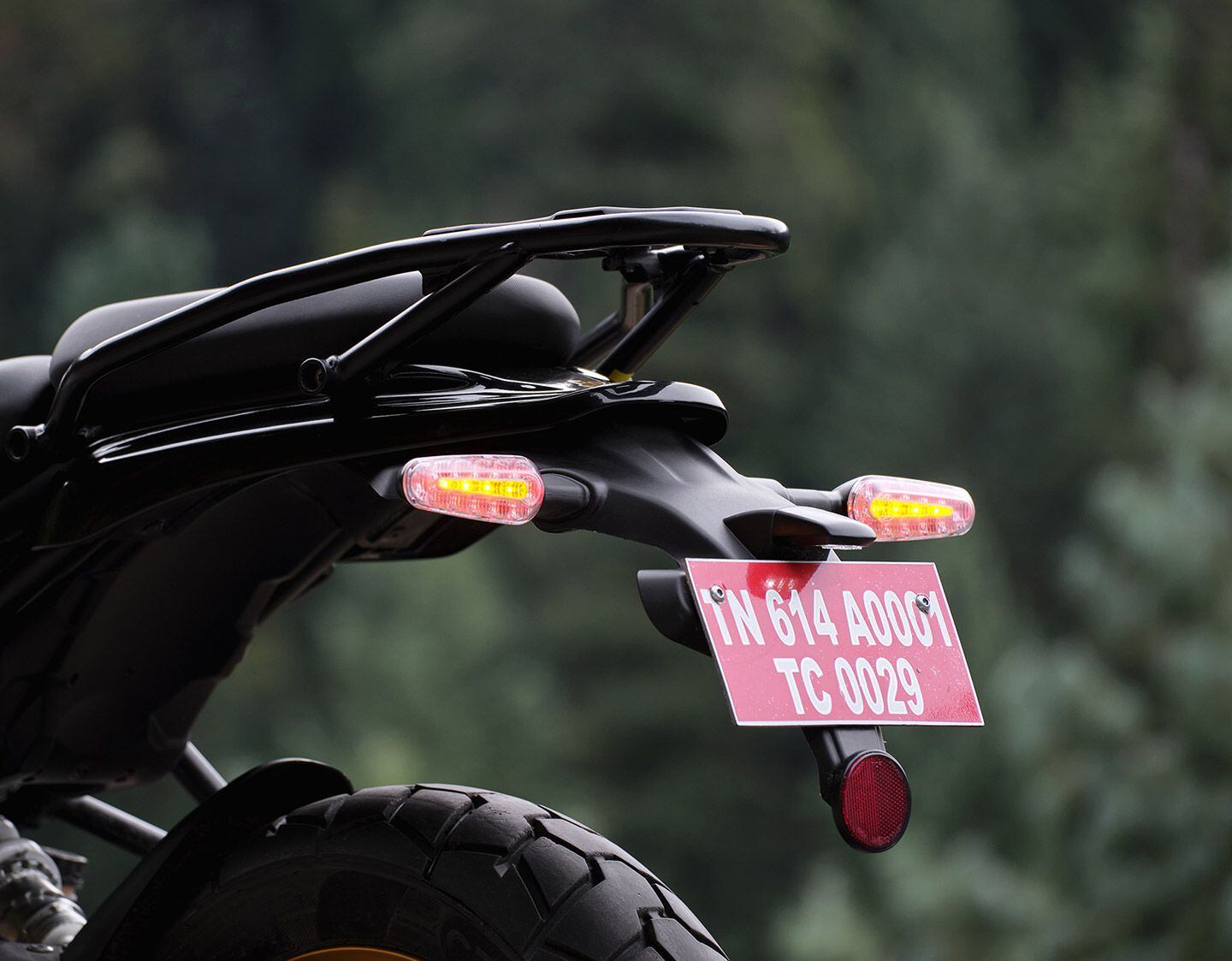
A standard rear rack is included while a variety of luggage options will be available. The rear turn indicators serve double duty as brake lights. (Royal Enfield/)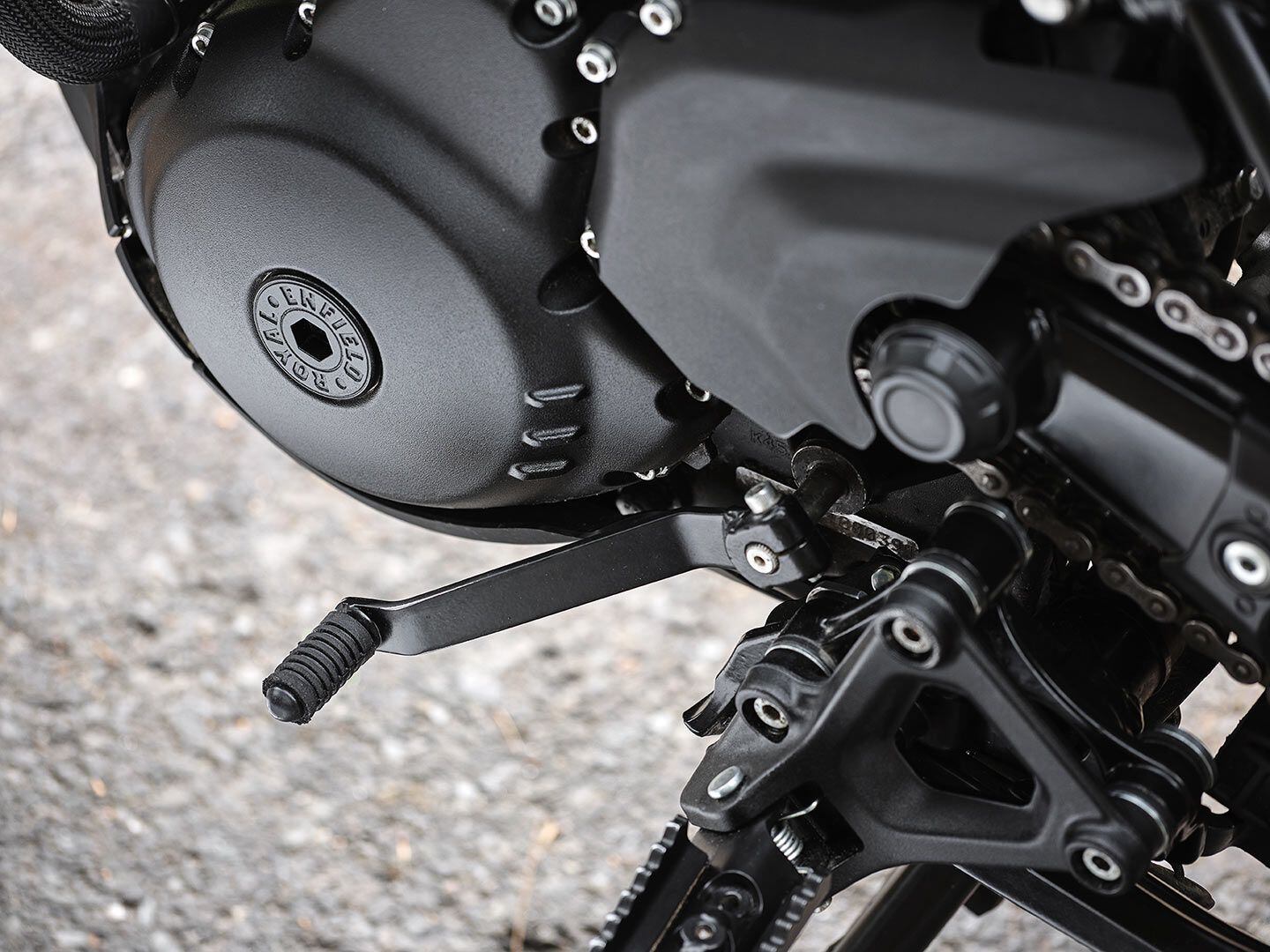
No quickshift here. But the six-speed transmission proved to be slick shifting, aided by a slip and assist clutch. (Royal Enfield/)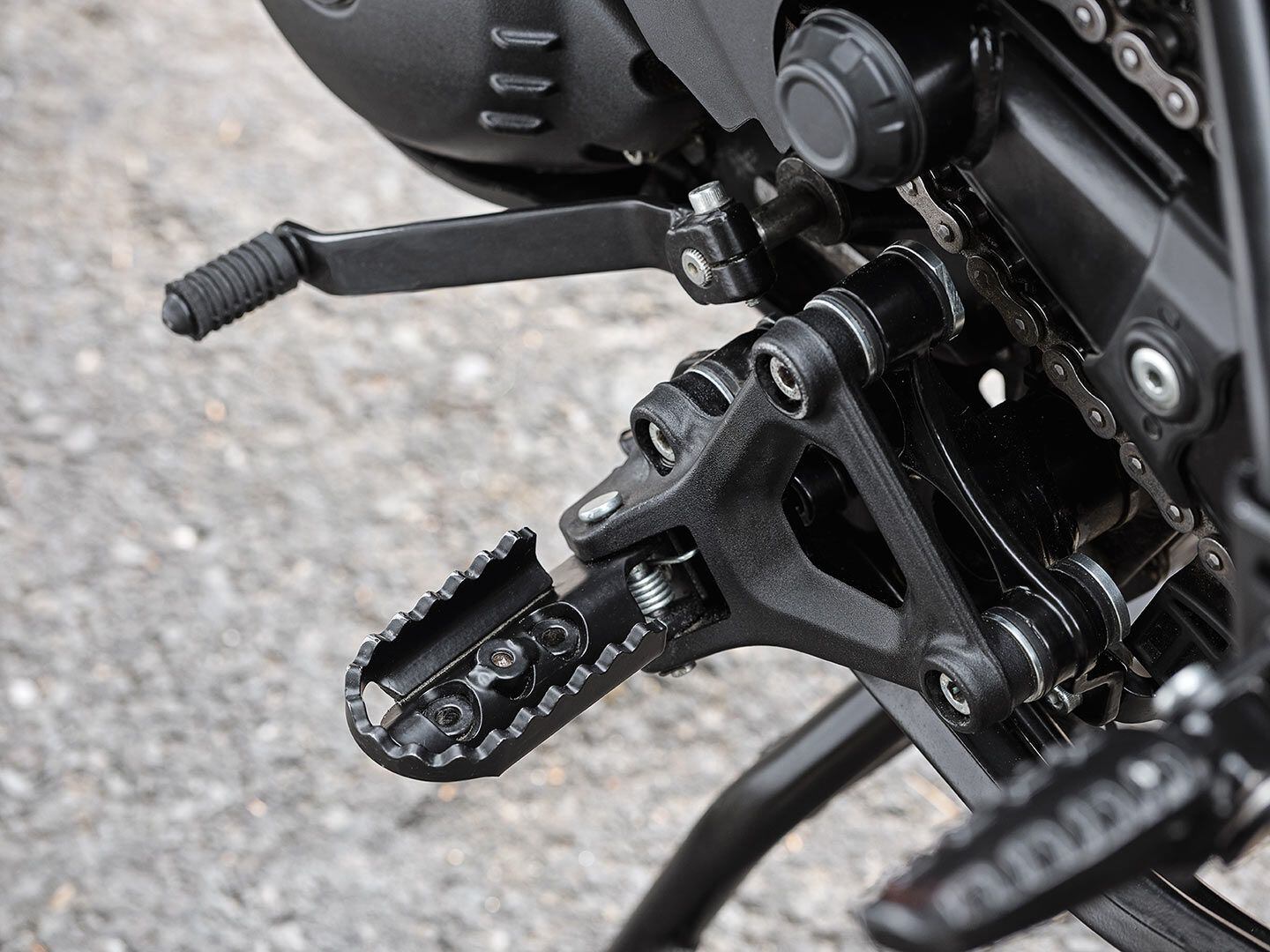
Two bolts allow the rubber footpeg inserts to be removed. (Royal Enfield/)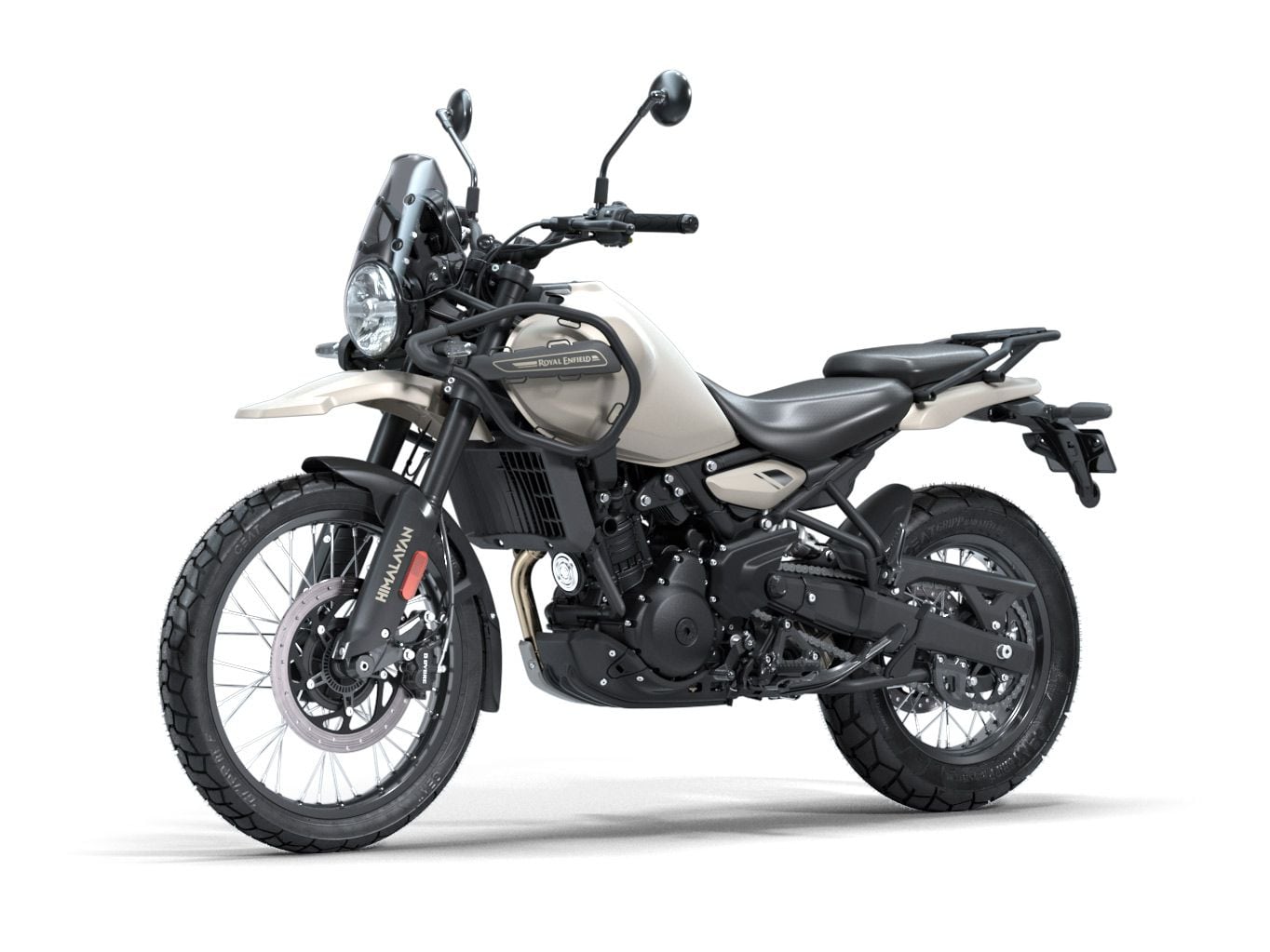
The 2024 Himalayan in Kaza Brown. (Royal Enfield/)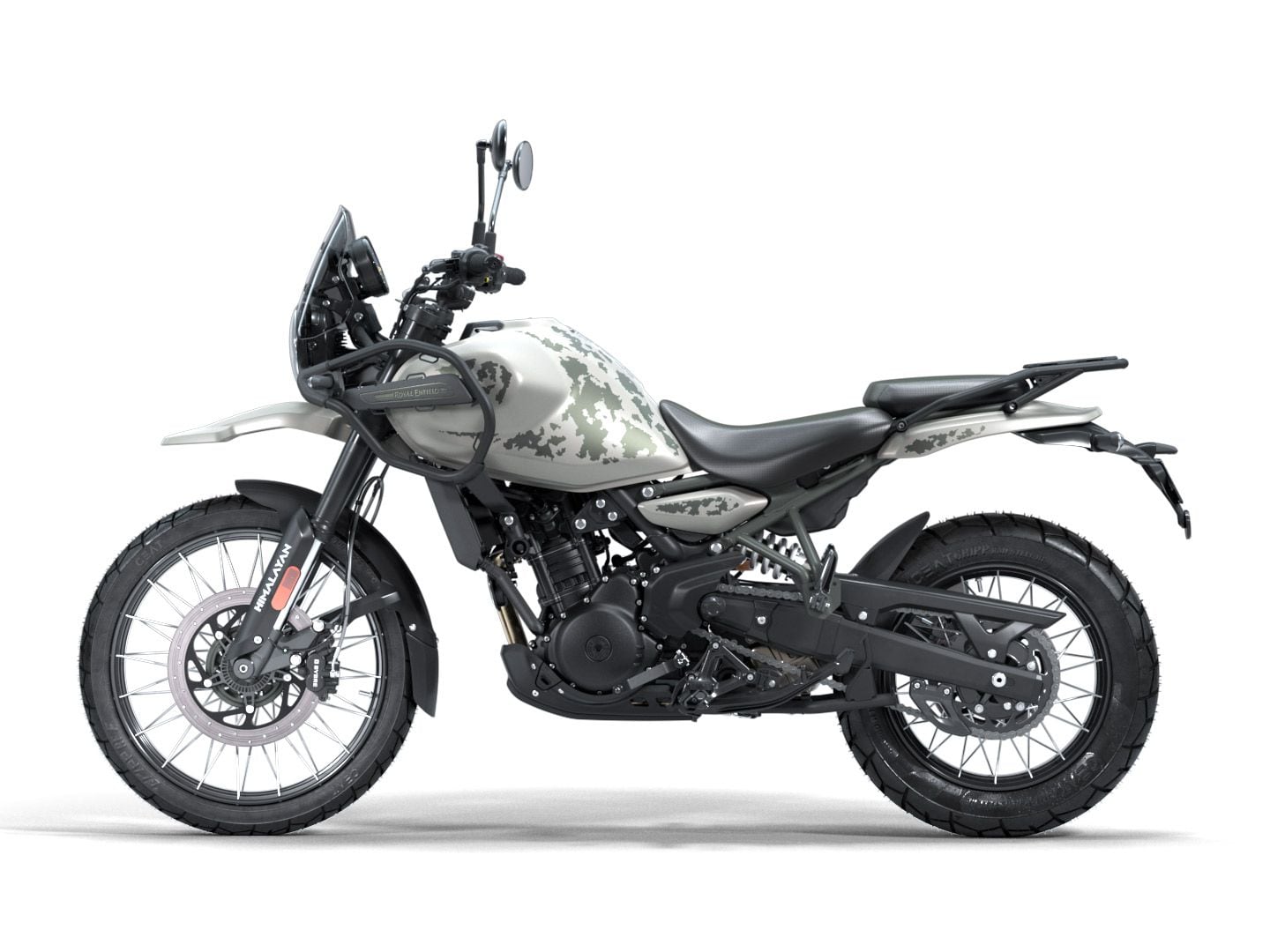
The 2024 Himalayan in Kamet White. (Royal Enfield/)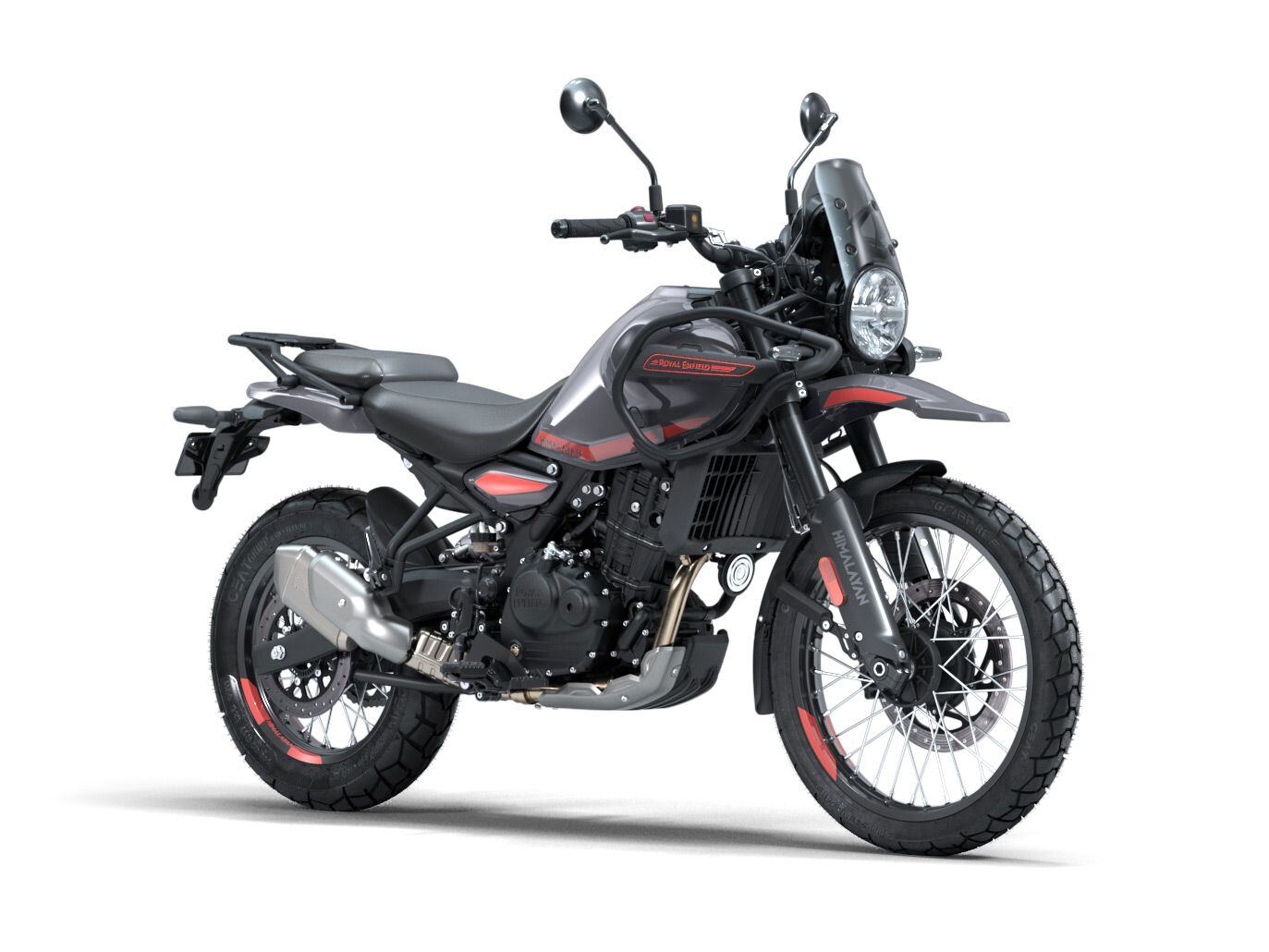
The 2024 Himalayan in Slate Himalayan Salt. (Royal Enfield/)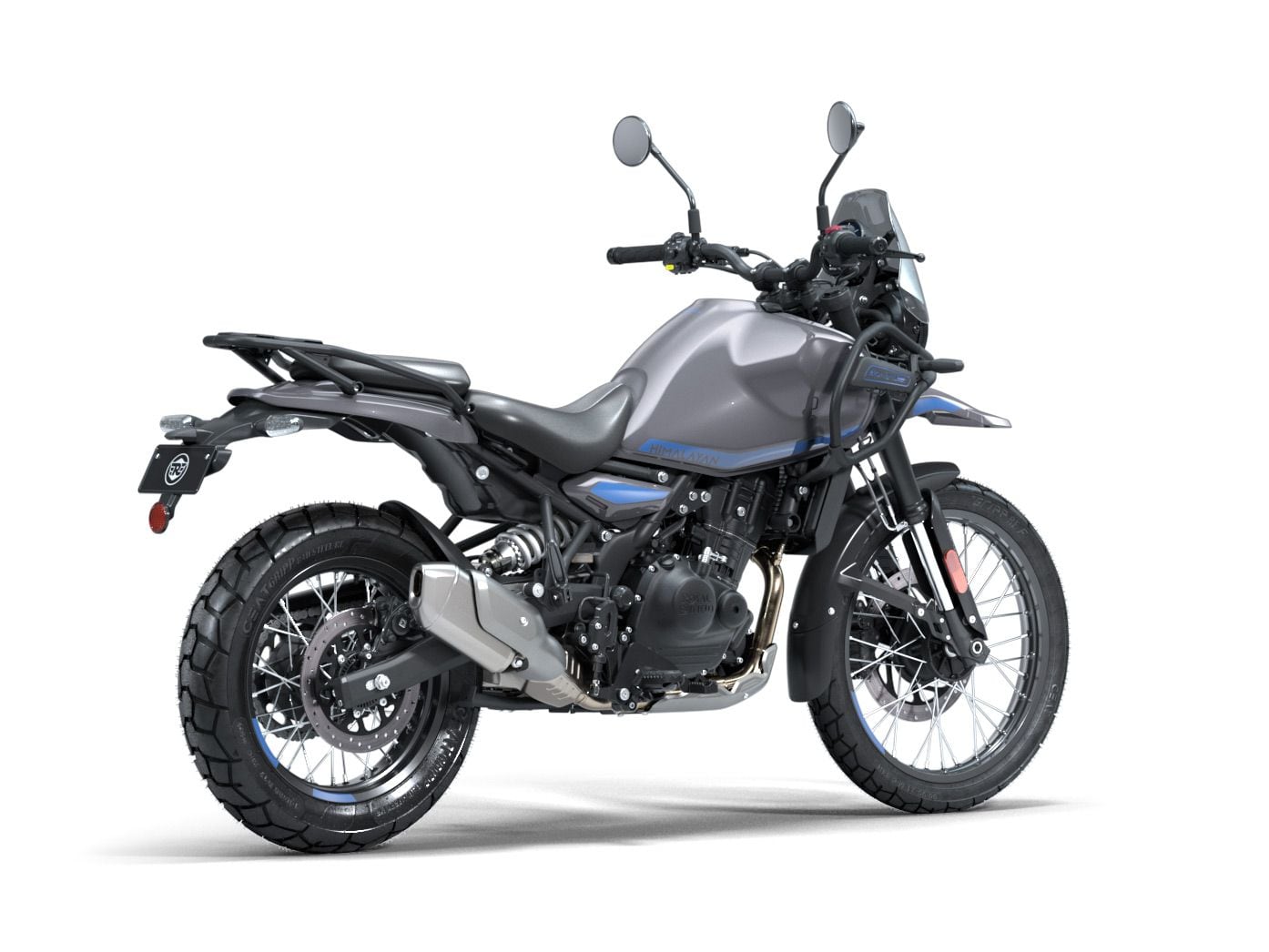
The 2024 Himalayan in Slate Poppy Blue. (Royal Enfield/)2024 Royal Enfield Himalayan Specs
MSRP: TBA Engine: DOHC, liquid-cooled, four-stroke single; 4 valves Displacement: 452cc Bore x Stroke: 84.0 x 81.5mm Compression Ratio: 11.5:1 Transmission/Final Drive: 6-speed/chain Claimed Horsepower: 40 hp @ 8,000 rpm Claimed Torque: 29.5 lb.-ft. @ 5,500 rpm Fuel System: Fuel injection w/ 42mm throttle body Clutch: Wet, multiplate slipper/assist Engine Management/Ignition: Ride-by-wire/electronic Frame: Steel twin-spar tubular Front Suspension: 43mm Showa SFF inverted fork; 7.9 in. travel Rear Suspension: Showa monoshock, preload adjustable; 7.9 in. travel Front Brake: ByBre 2-piston caliper, 320mm disc w/ switchable ABS Rear Brake: ByBre 1-piston caliper, 270mm disc w/ switchable ABS Wheels, Front/Rear: 21 in./17 in. Tires, Front/Rear: 90/90-21 / 140/80-17 Rake/Trail: 26.5°/5.0 in. Wheelbase: 59.4 in. Ground Clearance: 9.0 in. Seat Height: 32.5 to 33.3 in. Fuel Capacity: 4.5 gal. Claimed Wet Weight: 432 lb. Contact: royalenfield.com

Insta360 Ace Pro Action Camera Review
in Motorbike news
Posted
The Ace Pro is Insta360’s new action camera which they describe as the “best motorcycle action camera”.
I have the X3 360 degree camera which I have been using for the last nine months now which I use for my videos when riding my motorbike.
I was asked by Insta360 if I would try out and review the new Ace Pro. Bearing in mind how easy and the X3 is to use and the quality of the images, I didn’t hesitate to say yes as I was keen to see what this new camera is like.
The Ace Pro is a powerful wide-angle action camera co-engineered with Leica. Leica Camera AG is an international manufacturer of cameras and sports optics with a long tradition of quality, craftsmanship and industrial design.
The Ace Pro has an industry-leading 1/1.3″ sensor that delivers amazing image quality and has a 2.4″ flip screen and robust camera body. The various shooting features and AI editing have been designed to make capturing the action smarter and easier.
At a glance the highlighted features of the Ace Pro are:
Pricing: Approx. £360 / $449.99 USD
Features
1/1.3’’ Sensor
The Ace Pro features the larger 1/1.3” sensor meaning the sensor captures more light with an increased dynamic range giving you more accurate colors even when the images are taken underwater.
PureVideo Mode
When videoing in low light, this mode is powered by a 5nm AI Chip (AI denoising) and 1/1.3″ sensor and uses innovative noise reduction, enhanced brightness with an improved dynamic range.
This is a video taken at night using the Ace Pro – you can see how clear and crisp the images and colours are!
4K 120fps Video
Now, I am not someone who is very technologically minded but when taking images in this mode, even I was amazed at the quality of the details you could see and how clear the picture is at 4K 120fps.
Active HDR Video
When shooting in video mode at 4K 30fps or lower resolution/lower frame this mode will be automatically turned on. This keeps your video stabilized in active or action shots, keeping details in the highlights and shadows for more vibrant footage.
48MP Photo
Equalling smartphone-quality images, the Ace Pro delivers quality images at 48MP resolution with in-camera AI processing.
Clarity Zoom
Without compromising the quality of the image, you can double tap on the camera’s touchscreen to instantly zoom in x2.
2.4’’ Flip Screen
The Ace Pro has a large versatile 2.4” flip screen which is:
AI Highlights Assistant
With this feature turned on, the AI Highlights Assistant will find the best moment from your video and show you on the camera the highlights to review. You decide what you want to keep or delete, saving you time and space on the SD card.
When connected to the app, you can automatically receive a video that is ready for you to share edited by AI.
For me, personally, this is a fantastic feature as I find the editing of videos very time consuming and if the camera/app will do it for me, then that’s amazing.
App Background Downloading
Whilst downloading footage from the camera, the Insta360 app runs quietly in the background which means you can use your phone for other tasks.
Pause Recording
A great feature if you get interrupted whilst recording, is the Pause Recording – you can resume recording in the same file for one smooth clip, keeping your shots together thus saving you time searching through several short clips.
To use this feature, simply go to the album and click the red dot to begin a new recording that starts at the end of the current clip.
Gesture Control
You can use a hand signal (no, not that kind of hand signal … ) to start/stop recording or take a photo. This requires both the hand and head to be visible in the frame and works even if you’re wearing a helmet or gloves.
) to start/stop recording or take a photo. This requires both the hand and head to be visible in the frame and works even if you’re wearing a helmet or gloves.
Voice Control 2.0
When the Ace Pro is mounted out of reach, you can control the camera via your voice.
To turn on either Gesture Control or Voice Control, simply use the drop-down menu on the touchscreen.
Both of these features are invaluable especially when you’re wearing your bike gear, you haven’t got to take your gear off to start/stop recording which can be a pain when capturing film for a while!
FlowState Stabilization + Horizon Lock
The Ace Pro has 360° Horizon Lock which is invaluable for those videos when riding a motorcycle both on and off the road when the terrain is somewhat uneven!
IPX8 Waterproof to 10m (33ft)
The Ace Pro is waterproof to 33ft (10m) which, hopefully, you shouldn’t need this depth when riding a motorcycle! It’s good to know that you can still ride your motorcycle and take footage in the rain without having to worry about a waterproof case.
If you were to take your adventures underwater this would be ideal and there is a Dive Case available if you wanted to venture further down to 197ft (60m).
Fast Charge Battery
You can capture footage for up to 100 Minutes with the Ace Pro in 4K30 Active HDR (with the AI Highlights Assistant off). Fast-charging powers the battery to 80% in 22 minutes and fully charges in 46 minutes!
Next-Level Stats Dashboard with New Partners
The Insta360 Ace Pro is the first-ever action camera with a dedicated integration for your Garmin device or Apple Watch. You can grab GPS, speed and other data for inclusion in your video.
How I found the Insta360 Ace Pro Action Camera
Having previously used another make of action camera, the Insta360 AcePro is a breath of fresh air. Not only is the camera itself easy to use, but editing the footage is incredibly easy and I would say the Ace Pro is, in my opinion, the best motorcycle action camera out there.
I am not a techy person at all but I find navigating my way around the camera, selecting the various different options and setting up the camera to my needs, fairly straightforward. I can simply attach the camera to the handlebars on my motorbike using the mount, press play and ride. Simple.
The Ace Pro has a built-in microphone so creating content whilst riding is easy. There is also a plug in microphone adapter available so you can plug your microphone into this which I then put in my helmet so I can chat whilst riding and recording making my content even more interesting (or not as some would say )
)
Editing the footage is easy too. You can edit the footage directly on the camera or use the Insta360 app.
The Insta360 app is straightforward to use and, depending on how techy you are, you can either edit the footage yourself or let the app do it for you.
Obviously letting the app do the editing for you is easy and quick and it will produce a video that you can then publish directly from the app itself or save to your device and publish from there.
Editing the video yourself on the app however, although not as quick for me personally, is relatively straightforward to do. Simply choose the clips you wish to use, add music (if you want to), add effects (again, if you want to) and any text (of which there are various templates to choose from) and then the either publish the video from the app itself or download to your device and publish from there.
The camera itself is small and lightweight and easily fits into a pocket when not in use.
I am in awe at the quality of the pictures and videos the Ace Pro produces, even I can see how good they are which is saying something coming from me!
BK
Check out my YouTube video riding my bike using the Insta360 Ace Pro action camera:
Insta360 Ace Pro Specifications
For a complete spec list, visit Insta360
Sensor Size : 1/1.3”
Aperture : F2.6
35mm Equivalent Focal Length : 16mm
Video Resolution :
Video : 4K (4:3) : 4032×3024@60/50/48/30/25/24fps
4K(16:9): 3840×2160@120/100/60/50/48/30/25/24fps
2.7K (4:3): 2688×2016@60/50/48/30/25/24fps
2.7K(16:9): 2688×1520@120/100/60/50/48/30/25/24fps
1440P (4:3): 1920×1440@60/50/48/30/25/24fps
1080P(16:9): 1920×1080@240/200/120/100/60/50/48/30/25/24fps
FreeFrame : 4K (4:3) : 4032×3024@60/50/48/30/25/24fps
PureVideo : 4K(16:9): 3840×2160@30/25/24fps / 2.7K(16:9):
2688×1520@30/25/24fps / 1080P(16:9): 1920×1080@30/25/24fps
Slow Motion : 4K(16:9): 3840×2160@120/100fps / 2.7K(16:9): 2688×1520@120/100fps
/ 1080P(16:9): 1920×1080@240/200/120/100fps
Photo Resolution : 48MP (8064×6048) / 36MP (8064×4536) / 12MP (4032×3024) / 9MP
(4032×2264)
Video Format : MP4
Photo Format : JPG / DNG RAW (can be exported via app or Studio)
Video Modes : Video (with built-in Active HDR), FreeFrame Video, PureVideo, Slow
Motion, Starlapse, Timelapse, TimeShift, Pre-Recording, Loop Recording
Photo Modes : Photo, HDR Photo, Interval, Burst Photo, Starlapse
Color Profiles : Standard, Vivid, Flat
Video Coding : H.265 & H.264
Max. Video Bitrate : 170 Mbps
Exposure Value : ±4EV
ISO Range : 100-6400
Shutter Speed : Photo: 1/8000 – 120s / Video: 1/8000 – to the limit of frames per second
White Balance : Auto, 2000-10000K
Audio Modes : Wind Reduction, Stereo, Direction Focus
Audio Format : 48 kHz, 16-bit, AAC
Mics : 3
Weight : 179.8g
Dimensions : (W x H x D) 71.9mmx52.15mmx38.5mm
Color : Black
Storage : No built-in storage. Supports microSD cards up to 1 TB
Battery Capacity : 1650mAh
Charging Time : 46min: 30W fast charging adapter / 63min: 5V/3A
Run Time : 100 mins
Waterproof : Without Dive Case : 10m / With Dive Case: 60m
Bluetooth : BLE 5.2
Wi-Fi : 2.4GHz, 5GHz /802.11 a/b/g/n/ac
USB : Type-C
Gyroscope : 6-axis gyroscope
The post Insta360 Ace Pro Action Camera Review appeared first on BikerKaz.
View the full article